14.1: Introduction to Persuasive Speaking
14.1.1: Defining a Persuasive Speech
Persuasive speeches aim to convince the audience to believe a certain view.
Learning Objective
Identify the qualities of a persuasive speech
Key Points
- Persuasive speeches can come in many forms, such as sales pitches, debates, and legal proceedings.
- Persuasive speeches may utilize the three modes of persuasion: ethos, pathos and logos.
- Ethos is the most important appeal in a persuasive speech.
- Factors such as body language, the willingness of the audience, and the environment in which the speech is given, all affect the success of a persuasive speech.
- Audience Analysis is important in a persuasive speech, as the audience will be convinced for their own reasons, not for the speaker’s reasons.
Key Terms
- Audience Analysis
-
the speaker’s understanding of the audience’s knowledge, personal experience, and proximity to a topic
- pathos
-
emotional appeal to the audience
- Logos
-
logical appeal to the audience; does the speaker’s argument make sense?
- persuasion
-
the process aimed at changing a person’s (or a group’s) attitude or behavior
- ethos
-
credibility of the speaker, assigned to them by the audience
Definition
A persuasive speech is a specific type of speech in which the speaker has a goal of convincing the audience to accept his or her point of view. The speech is arranged in such a way as to hopefully cause the audience to accept all or part of the expressed view. Though the overarching goal of a persuasive speech is to convince the audience to accept a perspective, not all audiences can be convinced by a single speech and not all perspectives can persuade the audience. The success of a persuasive speech is often measured by the audience’s willingness to consider the speaker’s argument.

Persuasive Speech
President Gerald Ford and Jimmy Carter meet at the Walnut Street Theater in Philadelphia to debate domestic policy.
The Sales Pitch
An example of a persuasive speech is a sales pitch. During a sales pitch, the speaker is trying to convince the audience to buy his or her product or service. If the salesperson is successful, the audience (the person being sold to) will choose to purchase the product or service.
However, salespeople understand that just because someone does not make a purchase after the first sales pitch does not mean the pitch failed. Persuasion is often a process. People may need multiple persuasive pitches and a lot of outside information before they are ready to accept a new view.
Components of a Persuasive Speech
While ethos is an essential part of a persuasive speech, pathos and logos are usually combined to form the best possible argument.
While a speaker can attempt to establish ethos, or credibility, with an audience, it is ultimately assigned to them based on the audience’s perception. If the audience does not perceive the speaker as a credible source on the topic about which they are speaking, they will ultimately have a hard time considering the speaker’s argument.
The logos in a speech, or logical appeals, are arguments that present a set of information and show why a conclusion must rationally be true. For example, arguments heard in court are logical arguments.
Pathos, emotional appeals, are appeals that seek to make the audience feel a certain way so that they will accept a conclusion. Negative political ads, for example, often incorporate emotional appeals by juxtaposing an opponent with a negative emotion such as fear.
How to Succeed
Using an attention grabbing device is a powerful way to begin a persuasive speech. If you can make your audience laugh, think about a personal experience, or tell an anecdote that produces emotion, they are more likely to listen to the content of your argument. Additionally, keeping a speech within 6-8 minutes makes the audience less likely to let their mind wander away from what you are saying.
The effectiveness of a persuasive speech also depends on factors beyond the words of the speech. The willingness of the audience to accept a new view, the body language of the speaker, and the environment in which the speech is given all can affect the success of a persuasive speech.
A successful speaker will do their best to establish strong ethos with their audience, and combine pathos and logos to form the best possible argument. Audience analysis is an important factor when giving a persuasive speech. For example, if a speaker is trying to convince the audience not to tell their children about Santa Claus, using arguments that relate and resonate with them, such as encouraging them to remember how they felt when they discovered he wasn’t real, will be more successful than if the speaker shared a negative personal experience of their own.
14.1.2: The Goals of a Persuasive Speech: Convincing, Actuation, and Stimulation
Persuasive speeches can be designed to convince, incite action, or enhance belief by the audience.
Learning Objective
Define the three goals of a persuasive speech
Key Points
- Convincing speeches aim to get the audience to change their mind to accept the view put forth in the speech.
- Actuation speeches seek to incite a certain action in the audience.
- Stimulation speeches are designed to get an audience to believe more enthusiastically in a view.
Key Terms
- stimulation
-
An activity causing excitement or pleasure.
- actuate
-
To incite to action; to motivate.
- convince
-
To make someone believe, or feel sure about something, especially by using logic, argument or evidence.
The overall goal of a persuasive speech is for the audience to accept your viewpoint as the speaker. However, this is not a nuanced enough definition to capture the actual goals of different persuasive speeches. Persuasive speeches can be designed to convince, actuate, and/or stimulate the audience.
Convincing
A convincing speech is designed to cause the audience to internalize and believe a viewpoint that they did not previously hold. In a sense, a convincing argument changes the audience’s mind. For example, suppose you are giving a persuasive speech claiming that Coke is better than Pepsi. Your goal is not just for the audience to hear that you enjoy Coke more, but for Pepsi lovers to change their minds.
Actuation
An actuation speech has a slightly different goal. An actuation speech is designed to cause the audience to do something, to take some action. This type of speech is particularly useful if the audience already shares some or all of your view. For example, at the end of presidential campaigns, candidates begin to focus on convincing their supporters to actually vote. They are seeking to actuate the action of voting through their speeches .

Actuation
Political candidates use actuation speeches so that their supporters will cast their votes.
Stimulation
Persuasive speeches can also be used to enhance how fervently the audience believes in an idea. In this instance, the speaker understands that the audience already believes in the viewpoint, but not to the degree that he or she would like. As a result, the speaker tries to stimulate the audience, making them more enthusiastic about the view. For example, religious services often utilize stimulation. They are not trying to convince those of another religion to switch religions necessarily; there is an understanding that the congregation already accepts part or all of the religion. Instead, they are trying to enhance the degree of belief.
14.1.3: Persuasive vs. Informative Speaking
Informative and persuasive speeches differ in what they want the audience to walk away with: facts or an opinion.
Learning Objective
Differentiate between informative and persuasive speeches
Key Points
- Informative speeches (or informational speeches) seek to provide facts, statistics, or general evidence. They are primarily concerned with the transmission of knowledge to the audience.
- Persuasive speeches are designed to convince the audience that a certain viewpoint is correct. In doing so, the speaker may utilize information.
- Informative and persuasive speeches are exemplified by academic lectures and sales pitches, respectively.
Key Term
- informative
-
Providing knowledge, especially useful or interesting information.
Informative (or informational) and persuasive speaking are related, but distinct, types of speeches. The difference between the two lies in the speaker’s end goal and what the speaker wants the audience to leave with.
Informative speeches are probably the most prevalent variety of speech. The goal is always to supply information and facts to the audience. This information can come in the form of statistics, facts, or other forms of evidence. Informational speeches do not tell people what to do with the information; their goal is for the audience to have and understand the information. Academic lectures are often informational speeches, because the professor is attempting to present facts so the students can understand them.

Informative Speeches
Journalists, like Walter Cronkite, generally use informative speeches to inform their viewers about news events.
Informational speeches may have a tendency to become overdrawn and boring. Their goal is not to excite the audience members, but rather to provide them with knowledge they did not have before the speech.
Like informational speeches, persuasive speeches use information. However, persuasive speeches are designed for the audience to not only hear and understand the information, but to use it to be convinced of a viewpoint. The end goal of a persuasive speech is not for the audience to have information, but rather for them to have a certain view. Persuasive speeches may use some of the same techniques as informational speeches, but can also use emotions to convince the audience. A sales pitch is one example of a persuasive speech.
A common cry against certain persuasive speeches is that they rely too much on emotion and not enough on facts. A persuasive speech that succeeds in convincing the audience to accept a view but is based on faulty or misleading information is unethical.
14.1.4: The Psychology of Persuasion
Each individual is persuaded by different things over different time-periods, so to be effective each pitch must be customized.
Learning Objective
Explain the two psychological theories of persuasion
Key Points
- Each person is unique, so there is no single psychological key to persuasion.
- Cialdini proposed six psychological persuasive techniques: reciprocity, commitment and consistency, social proof, authority, liking, and scarcity.
- The Relationship Based Persuasion technique has four steps: survey the situation, confront the five barriers to a successful influence encounter, make the pitch, and secure the commitments.
Key Terms
- social proof
-
People tend to do things that they see others are doing.
- reciprocity
-
the responses of individuals to the actions of others
There is no single key to a successful persuasive speech. Some people take longer than others to be persuaded, and some respond to different persuasion techniques. Therefore, persuasive speakers should be cognizant of audience characteristics to customize the pitch.

Persuasion
A persuasive speech is given with the goal of influencing how the audience thinks about a certain topic.
The psychology of persuasion is best exemplified by two theories that try to explain how people are influenced.
Robert Cialdini, in his book on persuasion, defined six “weapons of influence:”
- Reciprocity: People tend to return a favor. In Cialdini’s conferences, he often uses the example of Ethiopia providing thousands of dollars in humanitarian aid to Mexico just after the 1985 earthquake, despite Ethiopia suffering from a crippling famine and civil war at the time. Ethiopia had been reciprocating for the diplomatic support Mexico provided when Italy invaded Ethiopia in 1937.
- Commitment and Consistency: Once people commit to what they think is right, they are more likely to honor that commitment even if the original motivation is subsequently removed. For example, in car sales, suddenly raising the price at the last moment works because buyers have already decided to buy.
- Social Proof: People will do things they see other people are doing. In one experiment, if one or more person looked up into the sky, bystanders would then look up to see what they could see. This experiment was aborted, as so many people looked up that they stopped traffic.
- Authority: People will tend to obey authority figures, even if they are asked to perform objectionable acts. Cialdini cites incidents like the Milgram experiments in the early 1960s and the My Lai massacre in 1968.
- Liking: People are easily persuaded by other people whom they like. Cialdini cites the marketing of Tupperware, wherein people were more likely to buy from others they liked. Some of the biases favoring more attractive people are discussed, but generally more aesthetically pleasing people tend to use this influence over others.
- Scarcity: Perceived scarcity will generate demand. For example, saying that offers are available for a “limited time only” encourages sales.
The second theory is called Relationship Based Persuasion. It was developed by Richard Shell and Mario Moussa. The overall theory is that persuasion is the art of winning over others. Their four step approach is:
- Survey your situation: This step includes an analysis of the persuader’s situation, goals and challenges.
- Confront the five barriers: Five obstacles pose the greatest risks to a successful influence encounter – relationships, credibility, communication mismatches, belief systems, and interest and needs.
- Make your pitch: People need a solid reason to justify a decision, yet at the same time many decisions are made on basis of intuition. This step also deals with presentation skills.
- Secure your commitments: In order to safeguard the longtime success of a persuasive decision, it is vital to deal with politics at both the individual and organizational level.
14.1.5: The Ethics of Persuasion
Persuasion is unethical if it is for personal gain at the expense of others, or for personal gain without the knowledge of the audience.
Learning Objective
Discuss the qualities that assure that persuasion is ethical
Key Points
- Methods such as torture, coercion, and brainwashing are always unethical.
- Ethical persuasion has three components: the exploration of the other person’s viewpoint, the explanation of your viewpoint, and the creation of resolutions.
- Tests such as the TARES test and the Fitzpatrick & Gauthier test are used to determine if a persuasion attempt is ethical.
Key Term
- coercion
-
Use of physical or moral force to compel a person to do something, or to abstain from doing something, thereby depriving that person of the exercise of free will.
Ethics of Persuasion
Not all persuasion is ethical. Persuasion is widely considered unethical if it is for the purpose of personal gain at the expense of others, or for personal gain without the knowledge of the audience. Furthermore, some methods of persuasion are wholly written off as unethical. For example, coercion, brainwashing, and torture are never considered ethical .

Understanding Ethics
Al Capone, an American gangster in the early 20th century, used coercion as a persuasive technique, which isn’t ethical.
Barring any of the persuasive methods that are easily distinguished as unethical (such as torture), the line between ethical and unethical is less clearly demarcated. Ethical persuasion has a series of common characteristics that are missing in unethical persuasion. Ethical persuasion seeks to achieve the following three goals:
- Explore the other person’s viewpoint
- Explain your viewpoint
- Create resolutions
Notably, this approach involves input from the audience and an honest explanation of your viewpoint. If you have questions about the ethics of a persuasive attempt, there are a number of tests that can be done.
TARES Test
Sherry Baker and David Martinson proposed a five-part TARES test to help guide the PR practitioner to define ethical persuasion. An ethical persuasive speech must have all of the following components:
- Truthfulness of the message
- Authenticity of the persuader
- Respect for the audience
- Equity of the persuasive appeal
Fitzpatrick & Gauthier
Fitzpatrick and Gauthier developed a series of questions that must be honestly answered to determine how ethical a pitch is:
- For what purpose is persuasion being employed?
- Toward what choices and with what consequences for individual lives is persuasion being used?
- Does the persuasion in this case contribute to or interfere with the decision-making process for its target audience?
14.2: Types of Persuasive Speeches
14.2.1: Persuasive Speeches on Questions of Fact
Speeches about question of fact (something is true, exists, or does not exist) propose that the speaker’s view is probably true.
Learning Objective
Explain how to present evidence to prove that a fact is true
Key Points
- Questions of fact contrast with questions of policy (which state that something should be) and questions of value (which state that something is good, bad, beautiful, or worthwhile).
- Three basic types of questions of fact are historical controversy, questions of current existence, and predictions.
- The speaker presents competing evidence in topical order and uses inductive reasoning to draw a conclusion from the evidence. The conclusion asserts that the speaker’s view is most likely true.
- The speaker has an ethical responsibility to provide reliable, valid evidence to the audience, and to be aware of and avoid bias in the selection of the evidence.
Key Term
- evidence
-
The available body of facts or information indicating whether a belief or proposition is true or valid.
Example
- To persuade an audience that the Loch Ness monster exists, a speech could cover unexplained sightings, factual evidence that many of the sightings cannot be explained, and collected testimony from people who have seen the Loch Ness monster and scientists who have studied the claims.
Questions of fact are one focus of persuasive speaking. They propose that something is a fact. Questions of fact (which are also called propositions of fact) basically state that something is, something exists, or something doesn’t exist. Questions of fact contrast with questions of policy, which state that something should be, and questions of value, which state that something is good, bad, beautiful, or worthwhile.
In a persuasive speech, the speaker answers a question by proposing an answer and attempting to convince the audience that the answer is true and that they can believe the speaker. In essence, the speaker wants to audience to accept the his or her view as the cold, hard facts.

Asking Questions
In a persuasive speech, the speaker will ask and answer questions with facts in order to convince the audience that the facts are true.
The following are three basic types of questions of fact:
- Historical controversy: Knowledge that an event did happen in the past or that an object actually did exist.
- Questions of current existence: Knowledge that something is happening now in the present (such as global warming).
- Predictions: Forecasting what will happen in the future. Based on past events, the speaker identifies a pattern and attempts to convince the audience that the event will happen again. For example, if someone observes that gasoline prices drop right before national elections, he or she could attempt to convince others that they will drop again before the next election.
Creating a Persuasive Speech on Questions of Fact
When creating a persuasive speech based around questions of fact, consider the following:
Thesis: When developing a persuasive speech, begin with a thesis that states that something is true, meaning that it happened or did not happen. exists or does not exist.
Organization and Evidence: In general, the evidence should be presented in topical order. It is important to consider the evidence carefully. The speaker must ask if it is possible that the observations actually occurred or could have occurred. Are the source of the evidence reliable, and were they in a position to actually observe what they reported? Is there reason to believe that a source may be biased, either personally or by the thinking prevalent at the time in history?
Reasoning: The speaker will usually be dealing with inductive reasoning, in which he or she asks the audience to agree with a conclusion after presenting all of the evidence. The speaker proves the position by presenting compelling evidence to support the thesis.
Ethics: As a speaker you have an ethical responsibility to provide reliable, valid evidence to the audience and be aware of and avoid your own bias in the selection of the evidence which you use.

Loch Ness Monster
The existence of the Loch Ness Monster is a question of fact.
14.2.2: Persuasive Speeches on Questions of Value
In persuasive speeches on questions of value, we argue something is right or wrong, moral or immoral, or better or worse than another thing.
Learning Objective
Define a persuasive speech of value
Key Points
- Persuasive speeches on questions of value imply certain actions, but they are not a call to action.
- Persuasive speeches of value depend on a judgement that something is right or wrong, moral or immoral, or better or worse than another thing.
- The speech should include an appeal, criteria for judgement, and facts that support the appeal using the judgement criteria.
Key Term
- policy
-
A principle of behavior, conduct, etc., thought to be desirable or necessary, especially as formally expressed by a government or other authoritative body.
Example
- “To persuade my audience that it is wrong to drive over the speed limit. ” “To persuade my audience that Pepsi is better than Coke. ” “To persuade my audience that it is better to live together before marriage. ” “To persuade my audience that swimming is the best form of exercise. ” “To persuade my audience that bikes are the best form of transportation to get around town. “
Introduction
There are three types of persuasive speeches:
- Persuasive speeches of fact
- Persuasive speeches of value
- Persuasive speeches of policy
In this unit, our focus will be on persuasive speeches of value. Here is where we argue something is right or wrong, moral or immoral, or better or worse than another thing. The appeals are made on value judgements .
Examples include speeches that attempt to persuade the audience that it is wrong to drive over the speed limit, that Pepsi is better than Coke, that it is better to live together before marriage, that swimming is the best form of exercise, or that bikes are the best form of transportation to get around town.
Persuasive speeches on questions of value imply certain actions, but they are not a call to action.
Questions to Ask Yourself
When analyzing any type of persuasive speech, you should ask yourself the following questions:
- What is the speaker’s goal?
- What are the main points?
- How does the structure of the speech help the speaker to make the argument?
- How does the speaker try to make you care?
- How does the speaker use evidence?
- What kinds of sources does the speaker use?
Creating a Persuasive Speech on Questions of Value
How should you go about creating such a speech?
- Introduce appeals, information, and criteria.
- Provide evidence that makes your audience arrive at your conclusion. (Your claims should agree with the current beliefs and feeling of your audience. )
- Use facts to justify your claims.
- Consider your audience’s feeling and values.

Pepsi vs. Coke
Persuading the audience that Pepsi is better than Coke is a question of value speech, as it hinges on a value judgement.
14.2.3: Persuasive Speeches on Questions of Policy
Persuasive speeches about questions of policy advocate for or against the status quo.
Learning Objective
Demonstrate how to structure a persuasive speech on a question of policy
Key Points
- There are four basic organizational patterns for question of policy: problem-solution, problem-solution with cause, comparative advantage of solutions, and Monroe’s motivated sequence.
- Problem-solution considers the need (or the problem to be solved), the plan (or the solution to the problem), and the practicality (how well the solution will work).
- Problem-solution with causes considers the nature and extent of the problem and the direct relationship between the problem and its causes, and uses the causes as criteria to evaluate potential solutions.
- Comparative advantages of solutions summarizes the problem briefly, compare different solutions to find the one that solves the most aspects of the problem, and ask the audience to accept and implement the most advantageous solution.
- Monroe’s motivated sequence is Attention, Need, Satisfaction, Visualization, and Action.
Key Terms
- Monroe’s Motivated Sequence
-
A method of persuasion developed by Alan H. Monroe, based on establishing a psychological need for action in the audience and demonstrating how to satisfy the need by taking action.
- status quo
-
The state of things; the way things are, as opposed to the way they could be.
- policy
-
A principle of behavior, conduct, etc., thought to be desirable or necessary, especially as formally expressed by a government or other authoritative body.
Questions of Policy
One focus of persuasive speaking is questions of policy, which advocates a change from the status quo, or the way things are today. There is a “should”, or at least an implied “should”, in the thesis statement. The speaker wants the plan proposed by the speech to become policy. Questions of policy contrast with questions of fact, which state than something is, exists or does not exist, and questions of value, which state that something is good, bad, beautiful, or perhaps worthwhile.

Rubik’s Cube
Organizing a persuasive speech is like solving a puzzle, all of the speaker’s points must be aligned correctly.
The following sections describe some different ways to organize persuasive speeches around questions of policy.
Problem-Solution
One way to organize a persuasive speech on a question of policy focuses on defining a problem and a solution by covering three basic points:
- The Need: Convince the audience that there is a problem that must be addressed or a need for change. It is essential to get the audience to believe that a problem exists so they will implement a plan for a solution.
- The Plan: Convince the audience that it is not good enough to just sit around and complain. Tell them what actions they must take. Be sure to address any aspects of the solution that might make the audience less willing to act.
- The Practicality: Show the audience that the plan can succeed. Address the implications, cite expert testimony, and reference the successful implementation of similar plans in other places.
Problem-Solution with Cause
A common variation on the problem-solution organization includes consideration of the causes. Discussing the causes of the problem directs attention to specific points that the solution must address. The basic points of this organization are:
- The Problem: Describe the nature and extent of the problem. Specifically, describe that the problem exists and how important or big the problem is.
- The Causes: Consider the direct relationship between the problem and its causes. Think about the problem as an “effect,” and consider the causes that produced the effect. Show a direct relationship between the problem and causes, not just a correlation where one thing occurred before, after, or at the same time as another.
- The Solution: Use the causes as criteria to evaluate the solutions. If the speech says that the problem was caused by x, y and z, then the solution or new policy needs to address x, y, and z in order to solve the problem.
Comparative Advantages of Solutions
When the audience is already aware of and accepts that there is a problem, the speech can focus primarily on comparing the advantages of one solution over another, as follows:
- Summarize the Problem Briefly: Do not focus on convincing the audience to believe that there is a problem that needs to be solved.
- Compare Different Solutions: Discuss different solutions, and find the one that solves the most aspects of the problem. Compare one solution with others to select and propose the best to the audience.
- Final Appeal: Ask the audience to accept and implement that solution as the policy.
Monroe’s Motivated Sequence
Another powerful method of structuring a persuasive message is by using a motivated sequence. The organizational plan developed by Alan Monroe focuses on developing a psychological need in the audience and then illustrating how to satisfy that need by supporting the plan or policy advocated in the speech, as follows:
- Attention: Get the audience’s attention using a detailed story, shocking example, dramatic statistic, or quotations.
- Need: Show how the topic applies to the psychological need of the audience members. The premise is that action is motivated by audience needs. Go beyond establishing that there is a significant problem; show that the need will not go away by itself. Convince the audience members that they each have a personal need to take action.
- Satisfaction: Solve the issue. Provide specific and viable solutions that the government or community can implement.
- Visualization: Tell the audience what will happen if the solution is or is not implemented. Be visual and detailed. Paint a picture for the audience of what they will experience and what the world will look like when the need is satisfied through the speech’s plan.
- Action: Tell the audience members what specific action they can take to solve the problem and change existing policy.
The advantage of Monroe’s motivated sequence is that it emphasizes what the audience can do. Too often, the audience feels like a situation is hopeless; Monroe’s motivated sequence emphasizes the actions the audience can take.
14.3: Sample Persuasive Speech
14.3.1: Sample Persuasive Speech
Persuasion encourages a person to behave in a certain manner, or embrace a point of view related to specific values, attitudes, and beliefs.
Learning Objective
Identify the strengths of Eisenhower’s persuasive speech about military spending
Key Points
- Most persuasive speeches are based on policies that require the acknowledgement and support of governments, public bodies, and constituents.
- President Eisenhower takes a clear stance against increased military spending, and attempts to change the audience’s attitudes and beliefs by drawing comparisons.
- Ending with a strong conclusion that restates the argument and main points, or proposes a call-to-action as Eisenhower does in “Chance for Peace,” is another tool used in persuasive speaking.
- Ending with a strong conclusion that re-states the argument and main points, which illustrate the drawbacks of corn ethanol production, is another persuasive tool used in the sample speech.
Key Terms
- constituent
-
A resident of a place represented by an elected official.
- simile
-
A figure of speech in which one thing is compared to another, in the case of English generally using like or as.
Sample Speech: Persuasive Speaking
The main purpose of persuasive speaking is to change, reinforce, or instill the attitudes, beliefs, and values of the audience. There are no formal rules on what topics, formats, or viewpoints qualify as persuasion. However, most persuasive speeches are based on policies that require the acknowledgement and support of governments, public bodies, organizations, and constituents .

Power of Persuasion
President Eisenhower attempted to change prevailing attitudes on the cost of an arms race in his speech “Chance for Peace.”
Just three months into his presidency, U.S. President Dwight D. Eisenhower delivered the speech entitled “Chance for Peace” on April 16th, 1953. The speech was given shortly after the death of Soviet dictator Joseph Stalin. In his speech, Eisenhower likened arms spending to stealing from the people, using similes, and spoke against increased military spending in spite of continued tensions and rivalry with the Soviet Union.
The following is an excerpt from Eisenhower’s address:
Every gun that is made, every warship launched, every rocket fired signifies, in the final sense, a theft from those who hunger and are not fed, those who are cold and are not clothed.
This world in arms is not spending money alone. It is spending the sweat of its laborers, the genius of its scientists, the hopes of its children. The cost of one modern heavy bomber is this: a modern brick school in more than 30 cities. It is two electric power plants, each serving a town of 60,000 population. It is two fine, fully equipped hospitals. It is some fifty miles of concrete pavement. We pay for a single fighter with a half-million bushels of wheat. We pay for a single destroyer with new homes that could have housed more than 8,000 people. . . . This is not a way of life at all, in any true sense. Under the cloud of threatening war, it is humanity hanging from a cross of iron.
Eisenhower attempted to sway his audience by describing what was at stake–exorbitant spending, wasted worker talent, unsafe borders–if the United States pursued an arms race. Although his speech is often described as one of the greatest persuasive speeches of modern times, the large peacetime military budgets established during his administration have continued for half a century.
You can listen to the full audio of Eisenhower’s speech here:
Chapter 12: Delivering the Speech
12.1: Methods of Delivery
12.1.1: Defining a Successful Delivery
Delivery is “real” when the speaker is honest and talks with the audience without acting.
Learning Objective
List the four main qualities that make a speech “real” and describe their use
Key Points
- Ethical–Audiences expect a public speaker’s life to be a reflection of his or her message.
- Conversation–Audiences in North America seem to respond more favorably to public speaking that is a natural conversation.
- Interactivity–Audiences feel connected to speakers who talk with them, rather than at them.
- Eye contact–North American audiences expect the speaker to look them in the eye.
- Voice–Each audience member expects a conversational tone but also wants to hear and understand the speaker. Public speakers should always use a microphone to make sure everyone can hear.
- Gestures–Audiences expect to see gestures that feel natural, maintain interest, and help convey the message. Gestures may include movements of the hands, face, or other parts of the body.
Key Term
- ethics
-
The study of principles relating to right and wrong conduct.
Example
- Hamlet, Prince of Denmark, is airing his opinions about the proper manner of speaking upon the stage. HAMLET’S SPEECH Speak the speech, I pray you, as I pronounced it to you, trippingly on the tongue; but if you mouth it, as many of your players do, I had as lief the town-crier spoke my lines. Nor do not saw the air too much with your hand, thus, but use all gently; for in the very torrent, tempest, and, as I may say, whirlwind of your passion, you must acquire and beget a temperance that may give it smoothness. Oh, it offends me to the soul to hear a robustious periwig-pated fellow tear a passion to tatters, to very rags, to split the ears of the groundlings, who for the most part are capable of nothing but inexplicable dumb-shows and noise. I would have such a fellow whipped for o’erdoing Termagant. It out-herods Herod. Pray you, avoid it. Be not too tame neither, but let your own discretion be your tutor. Suit the action to the word, the word to the action; with this special observance, that you o’erstep not the modesty of nature. For anything so overdone is from the purpose of playing, whose end, both at the first and now, was and is, to hold, as ‘t were, the mirror up to nature; to show virtue her own feature, scorn her own image, and the very age and body of the time his form and pressure. Now this overdone, or come tardy off, though it make the unskilful laugh, cannot but make the judicious grieve; the censure of the which one must in your allowance o’erweigh a whole theater of others. Oh, there be players that I have seen play, and heard others praise, and that highly, not to speak it profanely, that, neither having the accent of Christians nor the gait of Christian, pagan, nor man, have so strutted and bellowed that I have thought some of nature’s journeymen had made men and not made them well, they imitated humanity so abominably. Oh, reform it altogether. And let those that play your clowns speak no more than is set down for them; for there be of them that will themselves laugh, to set on some quantity of barren spectators to laugh too, though in the meantime some necessary question of the play be then to be considered. That’s villainous, and shows a most pitiful ambition in the fool that uses it. Go make you ready.
Keeping it “real”
Successful delivery has two components according to Quintilian 9. A good man (or woman), speaking well has to be “real”, firstly you need to know and speak the truth; and secondly, you cannot be posing or acting when you speak.

Marcus Fabius Quintilianus
A statue of Quintilianus with his hand raised to speak to a crowd.
Ethics of the speaker
Being a real person is the ethical nature of public speaking. Quintilian considered the ethical nature of the speaker first. The speaker is obligated to be a person of good character and speak the truth.
Ethics, also known as moral philosophy, is a branch of philosophy that involves systematizing, defending, and recommending concepts of right and wrong behavior. It comes from the Greek word “ethos,” which means “character”. Not only must the speaker deliver the speech well but he/she must be a person of good character. From the very early days of studying rhetoric, ethics were important. The speaker could not just say one thing and then do something different; he/she was called upon to live by what the he/she was saying. Speaking well, also means speaking justly, where eloquence, wisdom and goodness combine. The Greek philosopher Socrates suggested that evil or bad actions are the result of ignorance and that any person who knows what is truly right will automatically do it. What do you think?

Socrates
Socrates using his “socratic” method as he teaches a student.
How does the speaker keep it real?
Let’s look at two important aspects of speaking well, which may serve as a guide.
Speaking as magnified conversation
In general, audiences in North America seem to respond more favorably to public speaking which is modeled as a natural, but magnified conversation. Public speaking is a conversation with the audience. Working with this model, you will find that certain behaviors will be more successful than others.
- Interactivity–Rather than talking “at” the audience, it’s better to be speaking directly “with” the audience. You should, at least mentally, conceive of the audience as responding, asking questions and approving or disapproving of what you are saying. In essence, you are not lost in your own train of thought while ignoring the thoughts of the audience. There is interactivity or a perception of give and take between the audience and yourself as the speaker.
- Eye contact–This is an important aspect of successful delivery for North American audiences. They expect you to look them in the eye. Here and in Western Europe, eye contact is interpreted the same way: conveying interest and honesty. People who avoid eye contact when speaking are viewed in a negative light, as withholding information and lacking in general confidence. However, in the Middle East, Africa, and especially Asia eye contact is seen as being disrespectful and even challenging of one’s authority. People who make eye contact, but only briefly, are seen as respectful and courteous.
- Voice–you want to speak naturally but loud enough to be heard by all the members of the audience. At a minimum, you need to be intelligible to the audience so that they can comprehend the message. If you are not able to be clearly heard by the audience, then you will want to get special help to improve pronunciation, stress and emphasis.
- Gestures–You are not an actor who takes on or plays a role, but rather, one who enlarges the gestures so that everyone can see. A gesture is a form of non-verbal communication in which visible bodily actions communicate particular messages, either in place of speech or together with and in parallel to words. Gestures include movement of the hands, face, or other parts of the body. Today, the conversational speaker, unlike the old school elocutionist who focused more on technique than substance, strives for natural gestures, which develop out of what is being said. As a conversational speaker you do not want to use planned or fixed gestures for dramatic effect. Additionally, you want to avoid any gestures that, out of nervousness or habit, might distract the audience from the message.
Requirements of the occasion
Conversational speaking or dialog with the audience does not mean that you are always informal or use casual speech. Different speaking occasions have different degrees of formality. The audience will judge, as so you need to adapt the appropriateness of dress, posture and word choice associated with how formal or informal the occasion may be. Ultimately, the successful speaker is really true to self and receives the desired response from the audience.
12.1.2: Choosing Your Method of Delivery
Speakers may or may not be able to choose a delivery method, but keeping best speech practices in mind leads to success in each situation.
Learning Objective
Develop your personal delivery style, considering the four methods of speech delivery
Key Points
- There are four common methods of delivery: impromptu (little or not preparation), memorization, reading from prepared manuscript, and extemporaneous (with outline or notes).
- Develop a speaking persona by manifesting your own honest and sincere personality without imitating the style of others when communicating with the audience.
- Have something to say. The first indicator that a person is speaking well is that the speaker will have something to say. Without ideas, opinions, or information, the speech wastes the speaker’s and the audience’s time.
- Speak honestly and with sincerity. Unless you thoroughly believe in the message you wish to convey to others, you are not likely to impress them favorably.
- Develop your own style; do not imitate. Speaking in a natural conversational style means that the speaker does not imitate the speaking style of other great speakers but may reflect their style or approach as it suits the speaker’s personality.
Key Terms
- persona
-
In the study of communication, persona is a term given to describe the versions of self that all individuals possess. The public persona will differ from the persona an individual will present when he/she happens to be alone.
- manuscript
-
A single, original copy of a book, article, or composition, written by hand or even printed.
- impromptu
-
Improvised; without prior preparation.
Implications for Selection of Method
Four Methods for Different Occasions
There are four common methods of delivery–impromptu with little or no preparation, memorization, reading from prepared manuscript, and extemporaneous with outline or notes. Often you will not have a choice in the method of the delivery; the demands of the situation or the occasion may dictate the method. For example, you may be called on to respond to what someone else has just said, or to add a few words with no time to prepare. Or, you could be called upon to read a proclamation or announcement.
Impromptu
On many different occasions you may be called upon to speak with little or no notice before hand. For an impromptu speech, you may have a minute or two to prepare in your mind before you speak. Additionally, you may be called on to read a letter, scripture, or article to a group without preparation.
Manuscript
You may need to use the manuscript that is provided without adding your own thoughts or comments. However, there are other situations where you will need to prepare your own manuscript— perhaps for publication in a newsletter or to make sure you include exact wording.
Memorized
You may need to memorize a brief speech, scripture, or perhaps a poem as your part in a presentation, rather than being given a manuscript to read .
Extemporaneous
In many situations you will have advanced notice, you can think about what you want to say to your audience and anticipate their responses as you develop an outline for your message. Extemporaneous is the most natural of all methods of prepared delivery where you can successfully achieve a more natural conversation with the audience.
Developing a Speaking Persona for Different Situations
You will want to develop your own persona for all methods of delivery. In the study of communication, persona is a term given to describe the versions of self that all individuals possess. You behave according to the desired impression you wish to create when speaking with others. A person may create or manifest different personas at different times, for different occasions. In particular, the persona you present before others when speaking will differ from the persona your present when you happen to be alone. Here are some important considerations for developing a natural, conversational persona for speech delivery.
Have Something to Say
The first indicator that a person is speaking well is that the speaker will have something to say. Without ideas, opinions, or information, talk becomes the most wasteful product in the world. It is not only a waste of time to the person who insists on delivering it, but a waste of time and patience to the people who are forced to listen. Shakespeare put a man who had nothing to say in to The Merchant of Venice and then had Bassanio describe him as follows:
“Gratiano speaks an infinite deal of nothing, more than any man in all Venice. His reasons are as two grains of wheat hid in two bushels of chaff: you shall seek all day ‘ere you find them, and when you have them, they are not worth the search.”
In essence, you need to think clearly and prepare the content of the message carefully before focusing on delivery.
Speak Sincerely
A second indicator of a good speaker is sincerity. Nothing can be substituted for personal sincerity. Unless you thoroughly believe in the message you wish to convey to others, you are not likely to impress them favorably.
Develop Your Own Style—Do Not Imitate
Speaking in a natural, conversational style means that the speaker does not imitate the speaking style of other great speakers but may reflect their style or approach as it suits the speaker’s personality. For example, shows British rapper Speech Debelle who has developed her own sincere, conversational delivery style in her 2012 album, Freedom of Speech. It is a fatal mistake to set out deliberately to imitate some favorite speaker, and to mold your style after that person. You may observe certain ways or methods in other speakers that will fit in naturally with your style and temperament, so you adopt them. Always be on your guard against anything that might impair your own individuality—even in the slightest degree.

British Rapper Speech Debelle
If you develop your own delivery style, you will always be prepared to give a good speech.
Remember that speaking is a perfectly normal act, which does not call for strange, artificial methods, but only for an extension and development of the familiar act of conversation. The objective is to develop and magnify your own honest and sincere persona as a speaker without imitation when communicating with the audience.
12.1.3: Speaking from a Manuscript
Your manuscript delivery method will vary depending on whether the manuscript is your own or someone else’s.
Learning Objective
Explain the advantages and disadvantages of delivering a speech directly from a manuscript
Key Points
- When provided with a manuscript, you need to deliver it exactly as written. It is the original author’s ideas and not your own that you are presenting to the audience.
- One important form of manuscript is a proclamation. When you read the proclamation, you create a distinct speech act that puts the statements into effect.
- After the speaker reads the manuscript and understands the meaning, he or she can practice creating a conversational delivery by emphasizing important words, creating vocal phrases with the right words together, and varying the pace and emphasis.
- If you are preparing your own manuscript for delivery, consider first the audience and write for them as if you were speaking directly to them.
- You can now use low cost personal teleprompters to help you deliver sermons, deliver speeches, and create quality audios.
Key Terms
- teleprompter
-
A teleprompter is a display device that prompts the person speaking with an electronic visual text of a speech.
- manuscript
-
A single, original copy of a book, article, or composition, written by hand or even printed.
- Proclamation
-
A statement which is proclaimed; a formal public announcement.
You may need to use the manuscript provided to you without adding your own thoughts or comments. However, there are other situations where you will need to prepare your own manuscript perhaps for publication in a newsletter or to make sure you include exact wording.
When Provided with a Manuscript
You need to delivery it exactly as written. You are delivering words which were prepared by someone else; they are the original author’s ideas and not your own that you are presenting to the audience. The manuscript could take many different forms. It could be a short story, a poem, or an article. You may also be provided with a special type of document, called a proclamation.

Manuscript
A medieval Latin manuscript by Aristotle with original Greek text added in the margins.
With a proclamation, the wording is exact and must be read exactly as written, as it is a distinct speech act that puts the statements into effect. If are reading a proclamation and say, “I now declare…” when you finish you have actually made it happen.
Advantages
You usually have time to prepare which will allow you to fully understand the meaning that needs to conveyed to the audience. Once you understand the meaning, then it is possible to practice reading to create a conversational delivery by emphasizing important words, create vocal phrases with the right words together, and vary the pace and emphasis to convey the meaning of the original. Since you will have the document with you, you can mark it to indicate where you want to add emphasis, pause, and change volume or pitch.
Disadvantages
Of course, the obvious disadvantge is that you are speaking for someone else; your are delivering his or her thoughts and ideas and not your own. You do not have ownership of the ideas but you may be judged since you are delivering the manuscript.
When preparing your own manuscript
If you are preparing your own manuscript for delivery, consider first the audience and write for them as if you were speaking directly to them. You are not writing a book but a speech to be delivered. When you deliver the speech from manuscript, you are challenged to make a connection with the audience rather than simply read words.
Advantages
Preparing your own manuscript prevents you from saying anything you would not say in careful consideration of your topic. It does assure that you say everything you want to say and gives the impression that you are a calm, collected thinker. You have the opportunity to work with a teleprompter to help you speak directly to the audience, but you will still need to practice with its speed and placement.
Disadvantages
There are disadvantages for the speaker preparing his or her own manuscript. It is a challenge, since the speaker will have difficulty maintaining eye contact with the audience to show warmth and sincerity. It may also be difficult for you to actually develop a conversation with the audience while reading. You want to sound natural and develop your own persona which is difficult if a person is just reading his or her words on a page. With the necessary practice, you can perfect and develop a speech and deliver it from a manuscript with careful rehearsal.
When Working with a Teleprompter
You may also work with a teleprompter to increase eye contact and presence with the audience.
Professional Teleprompters
A teleprompter (also called a telescript or an autocue) is a display device that prompts the person speaking with an electronic visual text of a speech or script. Using a teleprompter is similar to the practice of using cue cards. You can see the words on the screen in front of and usually below the camera lens of a professional video camera. The words on the screen are reflected to the eyes of the presenter using a sheet of clear glass or specially prepared beam splitter. Since you do not need to look down to consult written notes, you appear to be speaking spontaneously and can look directly into the camera lens or the audience.
Personal Teleprompters
Fortunately, there are inexpensive teleprompter software applications as well as free web-based teleprompter applications, which will allow you to use a teleprompter to help you deliver sermons, deliver speeches, and create quality audios. These entry-level products work on desktops, laptops, and even tablets.

Teleprompter in use
This teleprompter is in use for a broadcast.
12.1.4: Speaking from Memory
It to your advantage to memorize your speech in some situations, and a distracting disadvantage in others.
Learning Objective
Demonstrate how to deliver a speech from memory so that you appear natural and relatable to the audience
Key Points
- Memorized delivery takes two basic forms: the total speech or manuscript is committed to memory, or standard parts of the message are memorized and woven into each speech.
- Memorizing your speech allows you to stay in touch with your audience.
- One of the main problems of delivering a speech from memory is that it sounds like you are reading since you are focusing your attention on remembering the words.
- When writing your speech, write as if you were speaking naturally, directly to an audience.
Key Term
- extemporaneous
-
A type of speech delivery which involves preparation of speaker notes prior to delivery, associated with conversational style of delivery.
Uses of Memorized Delivery
Good orators of the past were expected to deliver their speeches from memory without notes or other aids. Today, you may find it to your advantage to memorize your speech or presentation.
Today, memorization takes two basic forms:
- The total speech or manuscript is committed to memory.
- Standard parts of a message are memorized and woven into each speech.
Advantages
If you memorize your speech you are more likely to perform better than the speaker reading from a manuscript, since you can stay in touch with your audience. When speaking from memory, you do not need to think about what is coming next or how to express an idea as you would in extemporaneous speaking; therefore, you can give more attention to the audience. Today, we generally admire and stress extemporaneous speaking in our society, but many of the great speeches in history were delivered all or partially from memory.
Disadvantages
One of the main problems of delivering a speech from memory is sounding rehearsed, or like you are reading. It is possible to memorize and deliver a speech with variety and emphasis.
Tips for the Speaker
You may use various approaches to memorize and rehearse your speech. Below are some guidelines to follow when delivering a memorized speech:
- When writing the speech, write as if you were speaking naturally, directly to an audience.
- Develop an outline of the main points and then memorize the outline.
- If delivering the same speech to different audiences over time, memorize the individual sections and then weave them together for each occasion.
- If you forget a word or two or a small section, just continue speaking.
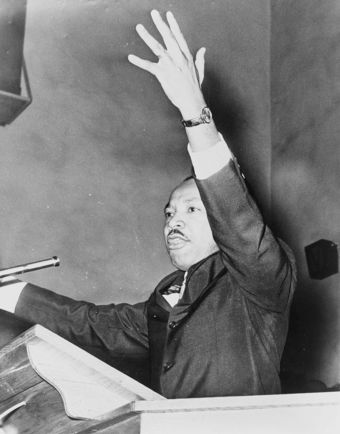
Engage the Audience
To be successful, a speaker should connect with the audience, not just recite words.
Overall, if you have the attitude that you are communicating with an audience rather than reciting words, you are likely to succeed.
12.1.5: Impromptu Speeches
An impromptu speech is given with little or no preparation, usually about a topic that the speaker knows well.
Learning Objective
List ways to quickly prepare when called upon to give an impromptu speech
Key Points
- Remember that you are generally in control of the content, so you can decide what you are going to talk about and include topics you want to talk about.
- Your delivery will naturally be more conversational and spontaneous.
- Since you are not well-prepared, you may overlook some significant information, but audience questions can often help fill in the gaps.
- Become familiar with common organizational patterns so you can apply them in any situation using the three part speech outline of an Introduction, Body, and Conclusion.
Key Term
- impromptu
-
Improvised; without prior preparation.
Impromptu Speech
An impromptu speech is given with little or no preparation, yet almost always with some advance knowledge on the topic. When called to speak “off the cuff” on the “spur of the moment,” is is usually because the speaker is quite knowledgeable about the subject. For example, if called on to speak in class, a student might give a short impromptu speech about a topic that was in the assigned readings. Business meetings also use a “check in” to tell everyone else about a current project. In small informal meetings, the audience will interrupt an impromptu speech and ask questions, which helps guide the speech and the information that is presented. When campaigning, politicians sometimes respond to reporters or voters almost anywhere and at any time.

Impromptu Speech
Mohamed el-Beltagy, running for the lower house of Parliament, stops to give an impromptu speech.
Advantages
Remember that you are generally in control of the content you are presenting, so you can include topics that you want to talk about. Additionally, you can use personal examples from experience to support what you are saying. Since you are an authority on the topic, you want to speak with conviction like you really mean it. Your delivery will naturally be more conversational and spontaneous. Since you are not prepared with pages of notes, you are more likely to speak directly to the audience just like if you were speaking to another person in a conversation.
Disadvantages
Since you are not well-prepared, you may have difficulty thinking of what to say or formulating the ideas once you get up to speak. Although you are familiar with the topic, your speech may lack details and supporting information. If the audience is passive and does not ask questions to guide you, you may overlook some significant content. Hopefully, someone in the audience will ask questions so you can fill in gaps. Additionally, impromptu speaking is rarely appropriate for occasions which require more reasoned discourse with supporting ideas or more formal events.
Tips for the Speaker (Impromptu Preparation)
What do you do if you are asked to speak at the last minute? It is best to become familiar with common organization patterns so you can apply them in any situation and then also consider what you have been asked to speak about. Are you presenting your opinion? State your opinion, the reasons why you support that opinion, and conclude. Is it something that happened? Retell the event from beginning to end (first, next, then, etc.). Is it a demonstration? Explain each step in the process from first to last.
- Make sure to plan an introduction and a conclusion. If possible, take a few moments to think about what you want to say to introduce the topic and have some way of concluding.
- Make a few notes for yourself on a card, phone, or iPad. Or, text yourself a few single words to remind yourself of the important ideas.
- Consider the simple three part outline of an Introduction, Body, and Conclusion, and fit your ideas into that pattern.
- Do not try to remember a detailed outline for your entire speech; just remember the order of important points.
- Be sure to stop when you have made your points.
- If you do not know what to say next, you can summarize and paraphrase what you have just said, and then will probably be ready to move on to the next topic.
- Remember that, in most situations, you will know more about the subject than the audience. Usually you will not be called up to speak impromptu about something you know nothing about, so you have probably spoken about the general topic before or you probably have knowledge to share with others.
- Talk like you mean it. In other words speak with conviction. You are explaining your ideas or knowledge and you are an authority.
- Relax!
12.1.6: Extemporaneous Speeches
Extemporaneous, the most natural method of delivery, involves glancing at notes while maintaining crucial eye contact with the audience.
Learning Objective
Give examples of note-taking strategies for extemporaneous speeches
Key Points
- There are two popular methods for organizing ideas to create a graphical representation for speaker notes–outlining and mind or concept mapping.
- An outline is a list of items with each item divided into additional sub-items. Each level in an outline has at least two subcategories. There are three basic types of hierarchical outlines–sentence, topic and phrase.
- Topic and phrase are the most useful for speaker notes since they allow the speaker to quickly glance at the notes while maintaining eye contact with the audience.
- Mind mapping and concept mapping are visual representation of ideas and concepts. Both mind maps and concept maps can be used to graphically show the relationship between ideas for a speech and as speaker notes for delivery.
- A mind map diagram starts with a single word as a central branch node and lesser categories as sub-branches going off from the central node. A concept maps can have multiple hubs or nodes with clusters of concepts labeled to show the kind of relationship.
- While extemporaneous speaking may be free of the constraints of memorization and manuscript speaking, it is not careless talk; the speaker prepares notes in advance in order to deliver an organized speech.
Key Terms
- mind map
-
A diagram used to represent words, ideas, tasks or other items linked to and arranged radially around a central key word or idea.
- concept map
-
A diagram showing the relationships among concepts, with the concepts drawn in rectangular boxes, which are connected with labelled arrows that denote the relationships between concepts, such as “is a,” “gives rise to,” “results in,” “is required by,” or “contributes to.”
- extemporaneous
-
A type of speech delivery which involves preparation of speaker notes prior to delivery, associated with conversational style of delivery.
Extemporaneous Speech
Extemporaneous speaking is one of the most natural methods for delivering a prepared speech. You can use an extemporaneous speech to achieve a more natural tone, flow and style with the audience.
First, think about your topics and anticipate the audience’s reception to your speech. You can develop speech notes based on this preparation and use them to aid you during the presentation.
Preparing Speech Notes
There are two popular methods for creating a graphical representation for notes: outlining, and mind or concept mapping.
An outline is a list of items with each item divided into additional sub-items. Each level in an outline has at least two subcategories. There are three basic types of outlines:
- Sentence outline – Each complete sentence includes a heading or single sentence about the subject of the outline.
- Topic outline – Each topic is listed and functions as a subtopic of the outline’s subject.
- Phrase outline – Each short phrase entry is a subtopic of the aforementioned main entry.
Speaking notes, topic outlines, and phrase outlines have an advantage over sentence outlines. For example, you can easily look at your notes for reference and as a personal reminder of which topics to discuss as you’re speaking.
Outlines commonly take two forms: alphanumeric and decimal.
An alphanumeric outline includes a capitalized number or letter at the beginning of each topic. Look at the sample:
Thesis statement: E-mail and internet monitoring is an invasion of employees’ rights
I. The situation: Over 80% of today’s companies monitor their employees.
….A. To prevent fraudulent activities, theft, and other workplace related violations.
….B. To more efficiently monitor employee productivity.
II. What are employees’ privacy rights when it comes to electronic monitoring and surveillance?
….A. American employees have basically no legal protection from mean and snooping bosses.
……..1. There are no federal or State laws protecting employees.
……..2. Employees may assert privacy protection for their own personal effects.
….B. Most managers believe that there is no right to privacy in the workplace.
……..1. Workplace communications should be about work; anything else is a misuse of company equipment and company time.
……..2. Employers have a right to prevent misuse by monitoring employee communication.
Decimal outline
The decimal outline shows how each item at every level relates to the whole sample.
Thesis statement:
1.0 Introduction
….1.1 Brief history of Liz Claiborne
….1.2 Corporate environment
2.0 Career opportunities
….2.1 Operations management
……..2.1.1 Traffic
……..2.1.2 International trade and corporate customs
……..2.1.3 Distribution
….2.2 Product development
The outline could be printed or handwritten as in this expert from Richard Nixon’s Checkers speech.

Speech Notes
Notes from Richard Nixon’s Checkers speech.
Mind Mapping and Concept Mapping
Mind mapping and concept mapping are visual representations of ideas and concepts. A mind map is a diagram which starts with a single word and then branches out from the central node, with lesser categories as sub-branches of the larger branches. Concept maps are more free-form, since multiple hubs and clusters can be created. Unlike mind maps, concept maps do not fix on a single conceptual center.
For example, in the mind map for student learning , you can view the main component idea and related ideas which connect to its branch nodes. You can also use a mind map as speaking notes.

Mind Map
A mind map is a diagram that starts with one word and expands into additional categories.
Practice and Rehearsal Guidelines
The following guidelines are best practices on how to practice and rehearse an extemporaneous speech:
- Speak in a conversational style by pretending you are with your audience.
- Rehearse with your graphics and coordinate them with your talk.
- Display your graphics only when you are talking about them.
- Rehearse in front of others and solicit feedback.
- Record and listen to your timed practice speech.
- Prepare for interruptions and questions at the end.
Although extemporaneous speaking may not require memorization and manuscript speaking, organize and prepare your content and notes ahead of time to deliver a speech that will be well received by your audience .

Free Speech
“Free speech doesn’t mean careless talk!” produced by the Office for Emergency Management.
12.1.7: Key Differences Between Prepared and Impromptu Speeches
The key difference between a prepared and impromptu speech is the amount of time given to the speaker to rehearse and prepare.
Learning Objective
Differentiate between prepared and impromptu speeches
Key Points
- An impromptu speech is one where the speaker is given no preparation time at all.
- A prepared speech is one where the speaker is given the topic well in advance and the speaker is given time to research it and rehearse the speech.
- The different type of prepared speeches include extemporaneous, memorized, and manuscript.
Key Term
- impromptu
-
Improvised; without prior preparation.
Differences Between Prepared and Impromptu Speeches
There are several different types of speeches that one can deliver. They range from perfectly memorized, to completely off the cuff with no preparation at all.
Prepared Speech
The most common type of speech is a prepared speech. For a prepared speech, the speaker was been given the topic in advance, had time to do background research on it, and has practiced delivering the speech.
This type of speech may be used when giving a presentation or speaking in a business meeting.

Using PowerPoint Slides
PowerPoint slides can be used in a prepared speech.
However, preparation does not necessarily mean memorizing every word. A prepared speech can be an extemporaneous, manuscript, or memorized speech, or a combination of these techniques. An extemporaneous speech is often delivered with the aid of note cards to help the speaker remember key points and content order. A memorized speech is one that is recited from memory without the aid of scripts or cue cards. A manuscript speech is one that has the entire speech written out for reference.
When preparing for a speech one should:
- Rehearse the speech as it will be presented (that is, with visual aids, standing or sitting as will be appropriate for the real speech, etc.)
- Time the rehearsal
- Rehearse in front of others
- If possible, rehearse in the location where the speech will be delivered to become more comfortable in the space, see how the audience will view the speech, and see how much space is available for movement
- Create a visual and audio recording of the speech, and look for areas where body language or vocal performance should be improved
Impromptu Speech
Another type of speech that is less commonly seen in society (but nonetheless very useful to understand) is the impromptu speech. Impromptu speaking occurs when the speaker is given no time to prepare for the speech; he or she is given a topic and must immediately begin speaking on it. This speaking style involves thinking on one’s feet and being able to plan the flow of the speech as the speaker is giving it.
While this seems like a difficult style in which to give a speech, most speech in a person’s daily life is impromptu. People do not background research on every conversation or prepare for hours before speaking to friends. However, having to give this kind of a speech to an audience or on a topic one is not so familiar with can definitely be a challenge.
The most common example of a real world impromptu speech is the elevator pitch. When in an unanticipated situation where one is speaking to someone who has the ability to advance one’s career or provide an opportunity in a new field, it is crucial to be able to deliver an excellent impromptu speech.
12.1.8: Additional Notes on Preparing and Delivering Impromptu Speeches
An impromptu speech is given with little or no preparation, but the presenter is usually very knowledgeable about the subject matter.
Learning Objective
Describe methods to successfully deliver an impromptu speech
Key Points
- Anticipate common questions; if you are asked about your line of work at a social event, you can have a response prepared. Having an elevator pitch ready is one way to prepare.
- If you think you will be called on to speak, it is a good idea to take a few minutes and make notes on important points.Select a familiar organizational pattern and then add an introduction and summary conclusion statement to the main ideas.
- You want to maintain eye contact, speak directly to the other person(s,) and minimize noise which will interfere with your delivery at an informal event.
- In a formal, stand-up event you want to put comments in context of the occasion, maintain eye contact while glancing at notes, and use internal summaries and transitions to show progress as you move to the conclusion.
- In a Q&A session, you want to listen attentively and repeat the question that you are answering. If you do not know the answer, say so and make arrangement for a follow-up electronic response.
Key Term
- impromptu
-
Improvised; without prior preparation.
Additional Notes on Preparing and Delivering Impromptu Speeches
An impromptu speech is given with little or no preparation. However, you will generally be called up to speak about a topic in which you are familiar or considered an expert. Impromptu speeches can take many different forms and occur in different situations. There are ways to prepare and deliver impromptu speeches by anticipating the more common impromptu contexts.
Preparation—Think before you Speak!
Anticipate Common Questions
In certain situations you can anticipate the types of questions or requests which will require a seemingly impromptu response. For example, you might be asked about your line of work at a social event. Since you know your occupation, you can have a response prepared. You might have a special project or interest that you want to pitch to others.
Elevator pitch
An elevator pitch is a short summary used to quickly identify what you do or what project is important to you in about 30 seconds, or the length of an elevator ride. So, when someone asks you what you do for a living, you can quickly and seemingly without preparation give an impromptu pitch or description.
Stand-up Speaking Event
If you think you will be called on to speak, it is a good idea to take a few minutes and make notes on the important points before you speak:
- Apply a three part plan for speech. You have learned about the three part speech structure, which are Introduction, Body and Conclusion. Apply the structure and think about your main points and thesis. List two or three main ideas for the body, develop the introduction by creating an opener, and present your conclusion with a summary and a reference to the opening statement from the introduction.
- Use a common organizational pattern. Think about the common patterns of organization with which you are already familiar: topical, spatial, chronological, and problem/solution—choose the one that fits the ideas you have just jotted down.
- Use phrases and single line notes. Make sure to make your notes as one line phrases in outline form. You can put your notes on paper or any device that allows you to quickly glance at a line and back up at the audience (like your smartphone).
Often, you will be presenting content that you have already covered with other audiences. On those occasions, you can use the same content but you will need to modify the introduction to reference the current occasion or audience.
Delivery
Informal Context
Many situations can be informal social occasions, meetings, or one-on-one talks where you could be standing or sitting.
- Maintain eye contact—it is important in Western cultural settings to look directly at the person you are speaking to so that you have each other’s attention.
- Eliminate noise—you want to make sure that you can actually hear each other easily in a noisy room. If you are experiencing noise, you might suggest stepping aside to a less noisy corner to delivery your short message.
Informal Meetings and Q&A
Impromptu speeches are usually used in short informal meetings where the audience can interrupt and ask questions to help guide the speech and retrieve the information they need from the speaker. It is important in this situation to stay focused by repeating the question and answering it without going off on a tangent.
Stand-up Speaking Context
There are situations where you will be asked to share a few words with a large audience.You will want to apply your knowledge of public speaking to deliver a short, organized speech.
- Put comments in context—you may want to start by putting your comments in context as a way of introducing your message. For example, you may refer to the occasion or the previous speaker.
- Maintain eye contact—hopefully, you had a few minutes to prepare so that you can glance at your one line notes and then back up to the audience.
- Use summaries and transitions—make sure to summarize and show connections between ideas; at the end, bring the message to closure with a summary statement.
Formal Speech with Q&A Session
Following a speech you will often participate in a Q & A session. Members of the audience will ask questions and you will respond without time to prepare:
- Listen attentively to the question, repeat it, and provide a short focused answer .
- If you do not know the answer, say so and make arrangements to respond later electronically.
You are the expert; you will know more about the topic than your listeners. Remember that the listeners want to hear what you have to say, even if it is slightly disorganized.
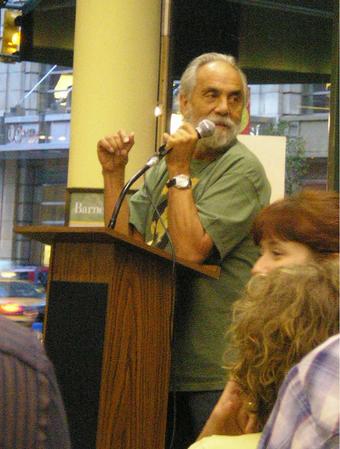
Q&A Sessions
Tommy Chong listens attentively during a Q&A session.
12.2: Speaking in the Real World
12.2.1: Practical Tips for Speaking in Non-Academic Settings
Non-academic speeches still require understanding your audience, adequate preparation, structure and a mindfulness of the occasion.
Learning Objective
Give examples of non-academic speeches and how to prepare them
Key Points
- Two types of speeches given in non-academic settings are entertainment speeches and persuasive speeches.
- To be successful in an entertainment speech, you must adapt to your audience and be mindful of the time.
- Essential tips for persuasive speaking include understanding your audience, focusing on the speech’s end result, using words with heavy emotional appeal, and identifying why your topic is important.
Key Term
- persuasion
-
is the influence of beliefs, attitudes, intentions, motivations, or behaviors.
Two types of speeches given in non-academic settings are entertainment speeches and persuasive speeches. Entertainment speeches may be given at a wedding or other social event. Persuasive speeches may be given as part of a political campaign or at a charity event.
Some examples of places where someone might be invited to give a non-academic speech:
- Rotary club
- Wedding
- Political campaign or event
- Charity event or benefit
- Acceptance speech of an award
- Reception or banquet
- Conference dinners or lunches
- Grievance Speech at a funeral
- Informative speech (keynote speaker)
- Interviews

Wedding Toast
A wedding toast is an example of an entertainment speech.
Practical Tips for Entertainment Speeches
People often make the mistake of thinking they can improvise, or “wing,” an entertainment speech by telling a few jokes or funny stories. In many cases, instead of being entertaining, the speech falls flat. Therefore, it is very important to prepare your entertainment speech. Some questions you should consider before giving an entertainment speech include:
- Is the content appropriate for the occasion?
- What do you know about your audience? Will they respond well to the content of your speech?
- Is the speech too short or too long? (Toasts, for example, are typically no longer than a few minutes.)
Practical Tips for Persuasive Speeches
In a political setting or money-raising campaign, a persuasive speech may be used to get audience members to change their attitudes or beliefs about a certain topic. In the case of fundraising, the speech is meant to convince people that the cause is worthy of a donation. To be as persuasive as possible, a speaker needs to understand some basic information about persuasion:
- Focus on the end result of your speech when preparing – all parts of your speech should focus on the end goal of your persuasive topic.
- Relate to and understand your audience – Start your speech by finding common ground with your audience, using humor or other similarities you might have. People tend to like people who are similar to them in some way.
- Chose your words wisely – focus on terms that have heavy emotional appeal like “freedom,” “right,” “wrong” and “liberty. “
- Identify why your persuasive topic is relevant to your audience- this will heighten interest and make your speech more immediately important. This is particularly important for persuasive speeches requiring a quick action by the audience.
Some additional resources on practical public speaking tips:
These additional resources provide tips on public speaking and include both videos and lists of tips to make your non-academic speech as engaging as possible.
- http://www.toastmasters.org/tips.asp – A public speaking society with tips on giving speeches.
- http://www.presentationskills.ca/Practical-Speaking-Tips.html – Speaking tips for professionals
- http://www.mindtools.com/CommSkll/PublicSpeaking.htm – Article on public speaking tips and improving confidence.
- http://www.youtube.com/watch?v=AykYRO5d_lI – Public speaking tips from Toastmasters (a public speaking society).
12.3: Effective Vocal Delivery
12.3.1: Volume
Speakers control the production of sound either using their own voice or a microphone so that amplified sound is loud enough to be heard.
Learning Objective
List methods of using volume to effectively deliver your speech
Key Points
- Volume is the perceived loudness of the speaker. Loudness is what the audience actually perceives and it correlates with the physical strength (amplitude).
- When speaking naturally without any amplification, you need to keep in mind the distance to be covered by your voice and adjust sound production accordingly.
- In large rooms or when using videoconferencing equipment, you use a microphone to convert sound into electrical signals for amplification.
- Lavalier mics, commonly used by speakers, are usually attached to collars or ties with small clips. The cord may be hidden by clothes and either run to a radio frequency transmitter or into a mixer.
Key Terms
- loudness
-
The characteristic of a sound that is primarily a psychological correlate of physical strength (amplitude). More formally, it is defined as “that attribute of auditory sensation in terms of which sounds can be ordered on a scale extending from quiet to loud. “
- amplifier
-
This is a particular type of speaker used to amplify voices and musical instruments at live performances.
- Lavalier Mic
-
A lavalier microphone or lavalier (or lav or lapel mic) is a small electret (electric, magnet) or dynamic microphone used for television, theater, and public speaking applications, in order to allow hands-free operation.
Volume
Volume is the loudness of the speaker. It is the psychological characteristic of physical strength (amplitude). It is perceived as auditory sensation by the listener which can be ordered on a scale from quiet to loud. Loudness is then a subjective measure of the listener, which is often confused with objective measures of sound strength such as sound pressure level (in decibels), sound intensity, or sound power. Amplitude is the strength or power of the wave signal. Higher amplitudes on the wave graph are interpreted as a higher volume, hence the name “amplifier” for a device that increases amplitude.

Determining the Volume
Higher amplitude will be perceived as louder sound.
Using the “Naked” Speaking Voice
When speaking naturally without any amplification you need to keep in mind the distance to be covered by your voice. You might compare speaking with the act of throwing a ball. Consider how much more muscular effort is needed to throw the ball a long distance than is required to throw it a short one. As you speak, think of your words as balls and mentally watch them covering the space between you and your audience. Notice how you unconsciously lengthen the voice. If speaking in a face-to-face group without a microphone ask yourself if you are loud enough to be heard by audience members in the last row. Speaking to a large group will require more energy to breathe and control your sound production.
To become a better speaker with your “naked” speaking voice, try the following techniques:
- Practice speaking in a large room with a friend who moves farther and farther away from you until the friend reaches the rear of the room and can still hear you.
- Make sure that you are standing straight and not cramped so you have the maximum capacity for breathing and forcing air out of the lungs for sound production.
- Practice speaking by thinking of people at different distances to you such as at your elbow, across the room, or in the back of a large hall.
Using a microphone
In large rooms or when using videoconferencing equipment, you will use a microphone to convert sound into electrical signals for amplification. The signal may then be sent to an amplifier. The electronic amplifier increases the power of a signal. It does this by taking energy from a power supply and controlling the output to match the input signal shape but with a larger amplitude. A loudspeaker or headset receives the input to produce the amplified sound.

Microphone
Microphones are used by a speaker for large audiences, during recording, or when videoconferencing.
There are several different types of microphones that the speaker might commonly use in different situations, such as:
- Hand-held mics – High quality mics usually attempt to isolate the diaphragm from vibrations using foam padding, suspension, or some other method. Low quality mics tend to transfer vibrations from the casing right into the diaphragm, resulting in a terrible noise.
- Lavalier mics – These are attached by a small clip to the clothing of the speaker, usually to collars or ties. The cord may be hidden by clothes and either run to a radio frequency transmitter or a digital audio recorder kept in a pocket or clipped to a belt (for mobile work), or directly to the mixer. These usually do not have protection from handling noise.
- Stationary mics – These are permanently attached to a podium. With an attached microphone, you are limited to the space immediately in front of the podium. Some stationary mics are in a holder on the podium, which can be removed to allow you to move around at least the length of the connecting cable.
Microphones can be placed in several different arrangements in the room for recording or videoconferencing, such as:
- In close – The microphone is placed relatively close, within three to twelve inches, which reduces extraneous noise.
- In distant or ambient miking – The microphone is placed at some distance from the speaker. The goal is to get a broader, natural mix of the sound source, along with ambient sound, including reverberation from the room or hall.
- In room miking – This is used together with a close microphone, sometimes during the speaker Q&A.
To make the most out of a microphone, a speaker should consider these techniques:
- Hold the microphone about six to eight inches from your mouth and speak over the microphone.
- Make sure you have the right microphone for speaking. Don’t just use whatever mic is at hand.
- Note that lavalier mics do not usually have protection from handling noise. It is therefore important to make sure they will not be moved or bumped.
- Conduct a sound check with any microphone. Make sure to test with the speakers in the actual room.
12.3.2: Rate
Rate is the speed of speaking in words per minute from slow to fast, with normal rate averaging about 125 words per minute.
Learning Objective
Use variance in the rate at which you speak to convey different emotions or emphasize important parts of your message
Key Points
- You can vary the rate depending of the emotions you are feeling or the type of message you are communicating. If you are experiencing joy, you will speak at a fast rate compared to a speaker who is expressing surprise who will speak at a much faster rate.
- When speaking you want to speak at a varied rate so that you can emphasize important parts of your message.
- Do you speak fast because you are in a hurry to finish or are nervous? Caution, slow down!
Key Terms
- rate
-
speed of speaking, measured in words per minute
- paralanguage
-
The non-verbal elements of speech used to modify meaning and convey emotion, such as pitch, volume, and intonation.
Rate is Speed of Speaking Measured in Words Per Minute
Rate is how fast or slow a person speaks. Rate is part of the paralanguage of speech along with loudness and pitch. It is not language but it accompanies all of your spoken use of language and can convey attitude and emotion. You can vary the rate depending on the emotions you are feeling or the type of message you are communicating. For example, if you are experiencing joy, you will speak at a fast rate compared to a speaker who is expressing surprise who will speak at a much faster rate. Normally, you speak about 125 words per minute. But you may speak much slower at about 100 wpm if you are giving a slide presentation.
You will find that the rate of speaking in audiobooks is about 150-160 words per minute whereas auctioneers can speak at about 250 wpm. According to the Guinness World Record, the current fastest speaker is Steve Woodmore, who was clocked at a rate of 637 wpm. Caution–slow down a minute to consider what you might do with your speech rate to be more effective.

Warning Sign
Just like a traffic sign warns about certain upcoming speed limits, a speaker needs to monitor their rate during a speech.
Tips for Speakers
- When speaking you want to speak at a varied rate so that you can emphasize important parts of your message.
- You also want to change the rate for the mood or emotion of the message and the occasion. If you want to show excitement at a pep rally you will naturally speak at a faster rate than if you were speaking at a funeral where you would speak slower because you are sad or contemplative.
- You might also speak slower if you are making choices and thinking carefully about what you are saying; a slower pace may conveys your thoughtfulness to the audience.
- Use a recorder to record your speech so you can clock your actual speaking rate.
Finally, ask yourself if you are speaking too fast because you are nervous!
12.3.3: Pitch
Changing the pitch while speaking can convey shades of meaning such as emphasis or surprise, or distinguish a statement from a question.
Learning Objective
Define pitch and describe how pitch changes can change the meaning of sentences
Key Points
- Pitch is the auditory attribute of sound ordered on a scale from low to high. You can think about the notes on a musical score with pitch getting higher as you move up the scale.
- For men and women the size difference of the vocal folds, reflecting male-female differences in larynx size, will influence pitch range so that adult male voices are usually lower-pitched with larger folds than female voices.
- Consciously or unconsciously the speaker will use different patterns of pitch to convey different meanings to the listener.
- In public speaking you can apply changes in pitch not only to a single word such as an exclamation, “Oh! ” but to any group of syllables, words, and even sentences to convey different meanings.
- Avoid monotony, speaking with one pitch tone or little variety in pitch. Make sure to vary the speech as you speak to show emphasis and change in meaning.
Key Terms
- intonation
-
The rise and fall of the voice in speaking. Some texts use “inflection” instead of intonation to indicate change in pitch.
- pitch
-
The perceived frequency of a sound or note. Higher frequency notes are higher pitch and lower frequency notes are lower pitch.
Pitch Is Ordered on a Scale from Low to High
Pitch is the auditory attribute of sound ordered on a scale from low to high. You can think about the notes on a musical score with pitch getting higher as you move up the scale. Pitch is closely related to frequency of sound waves; it is almost entirely determined by how quickly the sound wave is making the air vibrate and has almost nothing to do with the intensity, or amplitude, of the wave, which relates to loudness. That is, “high” pitch means very rapid oscillation, and “low” pitch corresponds to slower oscillation.

Measuring the Pitch
The higher pitch sounds move up the treble clef and the lower pitch sounds move down the bass clef.
Pitch for Male and Female Speakers
As a speaker you want to find a pitch that is suitable for speaking. Generally, you want to use a pitch range that would normally be comfortable for your natural conversation. For men and women the size difference of the vocal folds, reflecting male-female differences in larynx size, will influence available pitch range. Adult male voices are usually lower-pitched and have larger folds. The male vocal folds are between 17mm and 25mm in length. The female vocal folds are between 12.5mm and 17.5mm in length.
Uses of Pitch for Communicating Different Meanings
The pitch or pitch contour in which a syllable is pronounced conveys shades of meaning such as emphasis or surprise, or distinguishes a statement from a question. All languages use pitch pragmatically as intonation (or inflection as is used in some texts) to communicate different meanings—for emphasis, to convey surprise or irony, or to pose a question. Generally speaking, there are four types of pitch changes you can make, as follows:
- Rising intonation means the pitch of the voice rises over time [↗];
- Falling intonation means that the pitch falls with time [↘];
- Dipping intonation falls and then rises [↘];
- Peaking intonation rises and then falls [↗].
Consciously or unconsciously the speaker will use the different patterns of pitch to convey different meanings to the listener. Consider the uses of pitch change and the associated meanings in the different categories as follows:
- Informational: for example, “I saw a ↘man in the garden” answers “Whom did you see? ” or “What happened? “, while “I ↘saw a man in the garden” answers “Did you hear a man in the garden? “
- Grammatical: for example, a rising pitch turns a statement into a yes-no question, as in “He’s going ↗home? “
- Illocution: the intentional meaning is signaled by the pitch pattern, for example, “Why ↘don’t you move to California? ” (a question) versus “Why don’t you ↗move to California? ” (a suggestion).
- Attitudinal: high declining pitch signals more excitement than does low declining pitch, as in “Good ↗morn↘ing” versus “Good morn↘ing. “
- Textual: information not in the sentence is signaled by the absence of a statement-ending decline in pitch, as in “The lecture was canceled” (high pitch on both syllables of “cancelled”, indicating continuation); versus “The lecture was can↘celed. ” (high pitch on first syllable of “canceled”, but declining pitch on the second syllable, indicating the end of the first thought).
In public speaking you can apply changes in pitch not only to a single word such as an exclamation, “Oh! ” but to any group of syllables, words, and even sentences to convey different meanings. You can change pitch of successive syllables in a word, word groups, or successive sentences. You want to make sure that you use pitch to convey the intended meaning so that you do not drop the pitch, for example, until you have completed an idea.
Additionally, in natural conversation pitch changes make some words stand out more than others, you can do the same in your public speaking for emphasis. You can use pitch to draw the listeners’ attention to words or phrases that are more important than others. When speaking you will naturally use a range of pitches to convey different meanings.
Speaker Tips
- Avoid monotony, speaking with one pitch tone or little variety in pitch. Make sure to vary the speech as you speak to show emphasis and change in meaning.
- Practice saying sentences with different intonation patterns to change the meaning. For example, if you make a statement with falling intonation at the end, you can turn it into a question by raising the intonation at the end. Try for example, “See what I mean,” and “See what I mean? “
12.3.4: Pauses
A speaker may use pauses to enhance the message delivery; a speaker may also user filler words and pauses that distract from the message.
Learning Objective
Classify pauses as effective or ineffective
Key Points
- You may use a pause to emphasize that the information coming next is important, or to give the audience time to process what you have just said.
- Repetitive, unnecessary pauses like speech disfluencies, filler pauses, false starts—particularly filler words such as like, you know, and so—can distract from the message.
- Record a conversation and count the use of unnecessary pauses and filler words in relation to the other words in the speech. See if you can reduce the ratio over time.
Key Terms
- filler
-
A sound or word that is spoken in conversation by one participant to signal to others that he/she has paused to think but is not yet finished speaking.
- Pause
-
Pause may refer to a rest, hesitation, or temporary stop.
- disfluencies
-
Speech disfluencies are breaks, irregularities, or non-lexical vocables that occur within the flow of otherwise fluent speech. These include false starts, fillers, and repaired utterances (correcting slips of the tongue or mispronunciations).
Pauses
Pauses can enhance delivery or be filled needlessly and distract the audience.
A pause may refer to a rest, hesitation, or temporary stop. It is an interval of silence and may vary in length. The speaker may use pauses to enhance the message delivery or fill the pauses needlessly and distract the audience from the message.
Efficient and Effective Pauses
You may use a pause to emphasize that the information coming next is important, or to give the audience time to process what you have just said . Consider some of the ways that you might use pauses effectively in your delivery.

Using Pauses
Jimmy Wales pauses for dramatic effect in response to Amanda Cogdon at the 2006 Time 100 gala.
- Pause enables the speaker to gather thoughts before delivering the final appeal: pause just before the utterance, think about what you want to say, and then deliver your final appeal with renewed strength.
- Pause prepares the listener to receive your message: pause and give the attention powers of your audience a rest. The thought that follows a pause is much more dynamic than if no pause had occurred.
- Pause creates effective suspense: suspense can create interest. The audience will want to find out the conclusion or what happened if you pause before the punch line or conclusion.
- Pause after an important idea: pausing gives the audience time to process what you have just said before you continue with your delivery.
- Pause at the end of a unit: you may pause to signal the close of a unit of thought, such as a sentence or main point.
Ineffective Pauses
Different types of pauses that could present problems for the speaker:
Speech Disfluencies
Speech disfluencies are breaks, irregularities, or non-lexical vocables that occur within the flow of otherwise fluent speech, including false starts (words and sentences that are cut off in the middle), phrases that are restarted and repeated, grunts, or fillers like uh, erm, and well.
Filled Pauses
Filled pauses are repetitions of syllables and words; reformulations; or false starts, where the speaker rephrases to fit the representation of grammatical repairs, partial repeats, or searching for words to carry the meaning.
Filler Words
Filler words are spoken in conversation by one participant to signal to others that he or she has paused to think, but is not yet finished speaking. Different languages have different characteristic filler sounds. The most common filler sounds in English are: uh /ə/, er /ɚ/, and um /əm/.
Today’s youth uses other fillers. The following are among the more prevalent:
- y’know,
- so,
- actually,
- literally,
- basically,
- right,
- I’m tellin’ ya,
- you know what I mean.
Placeholder
Names
Placeholder names are filler words like thingamajig, which refer to objects or people whose names are temporarily forgotten, irrelevant, or unknown.
Tips for speaker
Record a conversation and count the use of unnecessary pauses and filler words in relation to the other words in the speech. See if you can reduce the ratio over time.
Remember that as you become more confident and familiar with speaking it will be easier to reduce the frequency of many of the unnecessary filler words and pauses.
12.3.5: Articulation and Pronunciation
Articulation focuses on making individual sounds and pronunciation focuses on stress, rhythm, and intonation of the syllables in the word.
Learning Objective
Define articulation and pronunciation
Key Points
- In articulation you change the sounds coming from your vocal folds by moving the teeth, tongue, and lips in recognizable patterns.
- After practice, if you can not physically produce the sound, then you may want to consult with a professional speech therapist to help you with articulation.
- In pronunciation you change the sounds of words by using stress. rhythm, and tone change on different syllables of the word.
- The syllable is the phonological “building block” of words. It is a unit of organization for a sequence of speech sounds. For example, the word water is composed of two syllables: wa and ter.
- Practice to make sure you are not substituting or omitting sounds when you say a word, and pay particular attention to common sound substitutions such as ‘tin for thin and d for th so that you do not say ‘den for then or goin’ for going.
- Install an online dictionary with audio pronunciation guides on your cellphone or laptop so you can listen to words that are troublesome to you when you are practicing.
Key Terms
- pronunciation
-
The way in which the words of a language are made to sound when speaking.
- articulation
-
Use of tongue, lips, jaw, and other speech organs to make a sound. Often the concept is only used for the production of consonants,
- intonation
-
The rise and fall of the voice in speaking. Some texts use “inflection” instead of intonation to indicate change in pitch.
Articulation, the last step in speech production
We as humans are unique in our use of tongue, lips, and other movable parts of the speech mechanism. The first act of speech is breathing, in which you get air into a storage chamber; second is phonation, the process by which you force air into vibration by the action of the vocal folds; third, resonation, in which your mouth,nose and throat cavities amplify the sound so you can hear it; and finally there is articulation, in which you modify the sound by movement of the teeth, tongue, and lips into recognizable patterns. There are only forty-four sounds to master, and as young child you started making them by mastering simple sounds which you later articulated into repetitive sound combinations and then words.

How Humans Speak
The human pharynx is situated immediately below the mouth and nasal cavity, and above the esophagus and larynx.
Here you are concerned with intelligibility. Can the audience comprehend what you are saying? If you produce the basic sounds of the language in a manner which is different from the language users in the audience, at the most basic level your speech will not be understood. You might substitute one sound for another at the beginning of a word such as ‘dis for this and “w” for “r” so you would say “wabbit” rather than “rabbit. ” Or you might leave a sound off the end of a word, such as in goin’ for going, in casual speech. But, the real challenge is whether or not you can produce the “correct” sound when it is required. If you can not physically produce the sound, then you may want to consult with a professional speech therapist to help you with articulation.
Tips for Speaker
- Practice to make sure you are not substituting or omitting sounds when you say a word, or adding sounds such as needcessity for necessity.
- Pay particular attention to common sound substitutions such as t for th so that you don’t say ‘tin for thin and d for th so that you dont say ‘den for then.
- Practice reading and recording passages with the problem sounds. Listen to the practice recording with a learning partner or tutor.
Pronunciation in spoken language
Pronunciation refers to the ability to use the correct stress, rhythm, and intonation of a word in a spoken language. A word may be spoken in different ways by various individuals or groups, depending on many factors. These factors include the area in which you grew up, the area in which you now live, whether you have a speech or voice disorder, your ethnic group, your socio-economic class, or your education.
When we talk about pronunciation, we focus on the word rather than the individual sound, as with articulation. The syllable is a unit of organization for a sequence of speech sounds. For example, the word water is composed of two syllables: wa and ter. A syllable is typically made up of a syllable nucleus (most often a vowel) with consonants around it at the beginning and end. Syllables are often considered the phonological “building blocks” of words. A word that consists of a single syllable (like English dog) is called a monosyllable, and is said to be monosyllabic. Similar terms include disyllable and disyllabic, for a word of two syllables; trisyllable and trisyllabic for a word of three syllables; and polysyllable and polysyllabic, which may refer either to a word of more than three syllables or to any word of more than one syllable. Your job in pronunciation involves recognizing the different syllables that make up a word, applying the stress to the right syllable and using the right up and down pitch pattern for intonation.
Intonation is also used in English to add function to words such as to to differentiate between wh-questions, yes-no questions, declarative statements, commands, requests, etc. You can change the meaning by varying the intonation pattern.
Tips for Speaker
- Listen to recordings of different people you admire, to check the pronunciation.
- You can connect to one of the online dictionaries which has an audio of the preferred pronunciations if you are unsure.
- You can download an app for your cellphone or tablet so you have it readily available to check pronunciation and meaning of words.
- If you are using a non-English word, you can also use Google’s translate function with audio pronunciation guide with the translation.
- If you spell a word differently than other language users, you may also pronounce the word differently. Check to determine if the word is pronounced as it is spelled. There are fourty-four sounds in English, but over five hundred spellings for the different sounds.
- You may want to practice reading a story or article aloud with a learning partner or tutor to check your pronunciation.
12.3.6: Dialect and Vocal Variety
Speakers may use many different English dialects to change the pitch, rate, volume, and use of pauses to achieve vocal variety.
Learning Objective
Employ vocal variety to emphasize key points in your speech and use dialect to relate to your audience
Key Points
- A dialect is a variety of a language that is a characteristic of a particular group of the language’s speakers and is distinguished by shared vocabulary, grammar, and pronunciation.
- The major native dialects of English are often divided by linguists into three general categories: British, North American, and Australasian; over two-thirds of English speakers live in the United States.
- Though the U.S. federal government has no official language, English is the common language used by the federal government and is considered the de facto language of the United States.
- All dialects have communicative value within the particular dialect community. When a person moves out of their home dialect community, they may encounter negative evaluations by those in powerful positions who speak a different dialect and have set a standard for others.
- You achieve vocal variety by using any or all of the features of paralanguage—rate, pitch, volume, and pauses to change the way you deliver your message.
- Consider that emphasis allows you to compare and contrast different parts of your speech.
- Vocal variety combats monotony, which results from having an unvarying tone in your speech.
Key Terms
- tone
-
The manner in which speech or writing is expressed.
- monotony
-
Tedium as a result of repetition or a lack of variety. The quality of having an unvarying tone or pitch.
- dialect
-
A variety of a language (specifically, often a spoken variety) that is characteristic of a particular area, community or group, often with relatively minor differences in vocabulary, style, spelling and pronunciation.
- paralanguage
-
The non-verbal elements of speech used to modify meaning and convey emotion, such as pitch, volume, and intonation.
Dialect and Vocal Variety
A Dialect is a Variety of a Language
A dialect is a variety of a language that is a characteristic of a particular group of the language speakers. A dialect is distinguished by its vocabulary, grammar, and pronunciation (phonology, including prosody). Where a distinction can be made only in terms of pronunciation, the term accent is appropriate—not dialect.
The term dialect is applied most often to regional speech patterns. The major native dialects of English are often divided by linguists into three general categories: British, North American, and Australasian . American English is a set of dialects used mostly in the United States. Approximately two-thirds of the world’s native speakers of English live in the United States and it is the most common language there. Although the U.S. federal government has no official language, English is the common language used by the federal government and is considered the de facto language of the United States because of its widespread use. English has been given official status by 28 of the 50 state governments.

English Language
English is not just one language. There are three major dialects in the English language
— North American, British, and Australasia.
There are several dialects associated with the speech communities in different regions. You may have meet people from different parts of the country who speak a different dialect. Some of the more common dialects are as follows:
- New England includes Boston and Vermont English;
- Inland North American includes western and central upstate New York;
- Mid-Atlantic includes Baltimore, New York, and New Jersey;
- Inland North American includes Michigan, Northern Ohio, and Indiana;
- North Central includes primarily Minnesota and Wisconsin;
- Midland American covers Nebraska to Ohio;
- Southern English across the Southeast;
- Western English includes California and Hawaiian Pidgin.
What dialect do you speak? Are you currently living in your native dialect area? What differences of words or pronunciation do you hear from others in different parts of the United States?
Since there are so many dialects of English, it is difficult to say that one dialect is better than another. Some dialects may be spoken by persons holding powerful positions in an area, so those dialects are the ones that become a standard for others. People of one dialect may view speakers with dialects from different regions, social or cultural backgrounds negatively and treat them accordingly. All dialects have communicative value within the particular dialect community; it is when the person moves out of their home dialect community that they may encounter negative evaluation.
Tips for the Speaker
- It is important to consider whether the majority of the audience shares the same dialect as the speaker to make sure that the words and pronunciation match those of the audience.
- If you are speaking to a national audience, you will want to make sure that your word choice and pronunciation is more widely used than that of your home dialect community.
Vocal Variety
Vocalics, or paralangue, refers to the non-verbal elements of speech used to modify meaning and convey emotion. You achieve vocal variety by using any or all of the features of vocalics: the rate, pitch, volume, and pauses you use to change the way you deliver your message. Here are methods to help you create variety in your delivery:
- Speak faster or slower at different times;
- Speak at a slightly higher or lower pitch;
- Use more force to speak louder or softer;
- Pause at different points in your speech.
Consider that emphasis allows you to compare and contrast. You might say one phrase at a faster rate in comparison to another phrase that you speak at a slower rate. You might speak louder at the end of your speech to create a contrast with the softer delivery in the preceding part of your speech. All of these vocal changes in paralanguage help you emphasize what is more important compared to another part that is less important.
The goal here is to avoid monotony, or an unvarying tone, that could bore your audience and fails to communicate your message clearly.
Tips for the Speaker
- Every speech has key points that you want to emphasize. Identify those points by changing the delivery so they stand out or contrast with the rest of the speech.
- Change the rate meaningfully; do not speak faster to finish the speech or to avoid talking about a main point.
- Change in rate is natural in conversation. Notice how you change the rate in your conversation and apply the natural changes while speaking in public.
12.4: Effective Visual Delivery
12.4.1: Appearance: Dress and Posture
First impressions count: dressing appropriately for the occasion and using an open posture can improve the visual delivery of a speech.
Learning Objective
Explain the value of dressing appropriately and using an open posture when delivering your speech
Key Points
- The audience may judge the person on their appearance and not really listen to what is being said.
- Clothing can demonstrate your culture, mood, level of confidence, interests, age, authority, values and sexual identity.
- Different societies and cultures have different dress norms and understanding the norms of culture helps with public speaking, though Western business styles are now commonly accepted in many countries.
- Crossed arms, clasped hands and crossed legs signal closed posture, giving the impression of detachment, disinterest and hostility.
- Open and relaxed hands, a wide stance and looking up demonstrate an open posture and communicate a friendly and positive attitude.
- Considering what dress is appropriate for the occasion and culture of the audience helps to send a visual message.
Key Terms
- posture
-
The way someone holds and positions their body.
- Dress code
-
Dress codes are written and, more often, unwritten rules with regard to clothing. Like other aspects of human physical appearance, clothing has a social significance, with different rules and expectations being valid depending on circumstance and occasion.
First Impressions
First impressions of a speaker are important. The audience may judge the person on their appearance and not really listen to what is being said. Considering the effect that dress and posture have on the response to a speech is important for public speaking.

Dress Style Suffragettes in 1916
The messages sent by clothing have changed since suffragettes marched and spoke up for voting rights.
Dress
Dress is considered an aspect of non-verbal communication and has social significance for the audience. Dress also includes the things that people wear such as jewelry, ties, handbags, hats and glasses. Clothing conveys nonverbal clues about a speaker’s personality, background and financial status. Your clothing style can demonstrate your culture, mood, level of confidence, interests, age, authority, values and sexual identity.
Consider how clothing style might send a negative message. A sloppy appearance, messy hair and wrinkled clothes sends the message, “I don’t care,” while appropriate attire demonstrates the importance of the occasion . A tight dress with a low-cut neckline might appear attractive but not convey the right message for a serious public speaking event. Appropriate dress changes based on the occasion and has changed over history. For example, the “liberated” attire of the suffragette campaigning for voting rights in the early 1900s seems formal and “unliberated” today, but was a daring statement at the time.

Dress Code
Dress codes and styles vary depending on the occasion.
Dress codes have built-in rules about the message sent by what a person wears and how they wear it. By showing positive aspects of yourself through dress, attire and grooming, you can inspire confidence in your abilities. As a general rule, attire should be chosen according to the type of audience, the event and the purpose. Audience should be considered before choosing attire. Dress should be comfortable without looking overdressed. Additionally, making a fashion statement is not always helpful for a public speaker because it can detract from the substance of the speech.
Tips for the Speaker
- Dress for the occasion. Consider what dress is appropriate for the event and the culture of the audience.
- Different societies and cultures have different dress norms and understanding the norms of culture helps with public speaking, though Western business styles are commonly accepted in many countries today.
Posture
If you are speaking to an audience in person, the audience will respond to your posture. Posture is one means of communication. Body movements convey information about interpersonal relations and personality traits such as confidence, submissiveness and openness. The speaker may display an open or closed body position. Those two positions communicate different messages to the audience and can be desirable or undesirable based on the type of visual delivery that is desired.
Closed Posture
Closed posture often gives the impression of detachment, disinterest and hostility. Behaviors that represent closed posture include arms crossed on the chest or abdomen, hands clasped in front of the body and crossed legs. Clothing may also signal closed posture, such as a buttoned suit or a handbag or briefcase held in front of the person. Showing the back of hands or clenched fists can represent a closed posture. Hands clasped behind the back may also signal closed posture even though the front is exposed because it can give the impression of hiding something or resisting closer contact.
Open Posture
Open posture communicates a friendly and positive attitude. The feet are spread wide and the head is straight and raised, looking at the audience. An important element of open posture of the body are the hands. Showing the palms of the hands can be a signal of open posture, especially if the hand is relaxed.
Tips for the Speaker
- In an in-person, co-located speaking situation where the audience can see your body, the audience responds and it is important to maintain an open body posture.
- The physical attitude to be taken before the audience really depends, not on mechanical rules, but on the spirit of the speech and the occasion. A person in a hot political argument never has to stop to think about what gesture to use to emphasize a point.
12.4.2: Eye Contact and Facial Expression
Eye contact and facial expressions provide important social and emotional information to the audience.
Learning Objective
Employ eye contact and smile when giving your speech
Key Points
- Eyes can indicate interest, attention, and involvement with audience members, while failure to make eye contact may be interpreted as disinterested, inattentive, or rude.
- Different cultures have different rules for eye contact.
- The face as a whole communicates emotional states, such as happiness or sadness. The seven universally recognized emotions shown through facial expressions are fear, anger, surprise, contempt, disgust, happiness, and sadness.
- Human faces are capable of more than 10,000 different expressions.
Key Term
- oculesics
-
a subcategory of kinesics, the study of eye movement, eye behavior, gaze, and eye-related nonverbal communication. Often used interchangeably with eye contact.
Eye contact, also known as oculesics, and facial expression are important aspects of communicating with an audience, providing important social and emotional information.

Making Eye Contact
Direct and attentive eye contact between the speaker and the receiver is important in one-on-one situations.
Eye Contact
The eyes can indicate interest, attention, and involvement with audience members, while failure to make eye contact can be interpreted as disinterest.

Form of Communication
For Western audiences, making eye contact is an important form of direct communication.
Gaze includes looking while talking and listening. The length of a gaze, the frequency of glances, patterns of fixation, pupil dilation, and blink rate are all important cues in nonverbal communication. Unless looking at others is a cultural no-no, lookers gain more credibility than non-lookers.
Lack of eye contact is usually perceived to be rude or inattentive in Western cultures. But different cultures have different rules for eye contact. Certain Asian cultures can perceive direct eye contact as a way to signal competitiveness, which in many situations may prove to be inappropriate. Others lower their eyes to signal respect; eye contact is avoided in Nigeria, and between men and women of Islam. However, in Western cultures, lowered eyes and avoiding eye contact could be misinterpreted as lacking self-confidence.
Tips for the Speaker
- Make eye contact with your audience members, and make sure not to stare at your notes the whole time.
- If you have a large audience, make sure to alternate talking to the audience members to the right, left, and in front of you.
- When you begin your speech do not look at your notes, look at your audience! You know your topic and who you are so introduce yourself and your topic as you would introduce yourself when you meet a new person.
- Practice looking at the audience while rehearsing.
- Avoid skimming over faces in your audience.
Facial Expression
The face as a whole indicates much about human moods. Specific emotional states, such as happiness or sadness, are expressed through a smile or a frown, respectively. There are seven universally recognized emotions shown through facial expressions:

Facial Expressions Betray Emotions
How many of the emotions can you identify in the pictures?
- fear
- anger
- surprise
- contempt
- disgust
- happiness
- sadness
Regardless of culture, these expressions are the same. However, the same emotion from a specific facial expression may be recognized by a culture, but the same intensity of emotion may not be perceived.
Facial expressions, more than anything, serve as a practical means of communication. Using all the various muscles that precisely control mouth, lips, eyes, nose, forehead,and jaw, the human face is estimated to be capable of more than 10,000 different expressions. This versatility makes non-verbal facial expressions extremely efficient and honest (unless deliberately manipulated).
Tips for the speaker
People smile when they are happy. Smile before you begin speaking to show the audience that you are happy to be there, and they will smile back. Smiling is contagious.
12.4.3: Movement and Gesture
Natural body movements and gestures can strengthen and enhance the message but repetitive, unnecessary movements can distract from delivery.
Learning Objective
Use natural body movements and gestures to strengthen your message, while avoiding distracting, unnatural movements
Key Points
- You can use your body to communicate positively with the audience by following Hamlet’s advice to suit the action to the word and the word to the action through natural, not mechanical body movements.
- Repetitive, unnecessary movements such as pacing, swaying back and forth, or bobbing your head up and down can distract the audience from your message.
- The gesture is subordinate to the message. The gesture is the physical, outward effect which is connected to a thought or emotional impulse.
- Make sure that the audience can see your hands above the lectern. Hold you hands at least waist-high and make sure to put your notes or other objects on the lectern or podium so your hands are free to move.
Key Terms
- gesture
-
A gesture is a form of non-verbal communication in which visible bodily actions communicate particular messages, either in place of speech or together and in parallel with words.
- Kinesics
-
Kinesics is the interpretation of body language such as facial expressions and gestures — or, more formally, non-verbal behavior related to movement, either of any part of the body or the body as a whole.
- Lectern
-
A lectern is a desk with a slanted top, usually placed on a stand or affixed to some other form of support, on which documents or books are placed as support for reading or speaking aloud. Lecterns are generally used while standing.
Kinesics
Kinesics is the study of body movement and expression such as waving, pointing, touching, and slouching. The movement of the body conveys many specific meanings to an audience but can be misinterpreted in an intercultural setting.
Body Movement can Support the Message
You can use your body to communicate positively with the audience. Hamlet’s advice to the players in Shakespeare’s Hamlet in 1601 has merit today: Suit the action to the word, the word to the action, with this special observance, that you o’erstep not the modesty of nature.
Consider some examples of how you might naturally support your delivery.
- Upper body toward the audience – You might want to lean into the audience to bridge the space of separation.
- Feet and legs – You may move purposefully from one side to the other to show a transition from one point to another.
- Arms and chest- If you cross your arms in front of you, what does this mean to the audience? It could be construed as confrontational or that are you in deep thought about a question from an audience member.
- Stand still without movement – If you are listening to a question, you can stand still without movement to show your interest.
Body Movements can Distract from the Message
Just as natural body movements can strengthen the message, unnecessary movements can distract from delivery. Here are some examples of movements which distract:
- Swaying back and forth – If you sway back and forth at the lectern or podium in a pattern without purpose, the audience may follow the movement rather than the message.
- Pacing from one side to other – If you pace from one side of the front of the room to the other meaninglessly, the audience will follow the movement.
- Moving a hand repetitively – If you use your hand to move your hair out of your eyes constantly while speaking, the audience will focus on the movement rather than what you are saying.
Tips for the Speaker
- Have a friend observe or record you while you speak. Review the recording for distracting, repetitive movements.
- Remember to strive for natural movements of the body. Body movements that are planned and mechanical will call undue attention to you and distract.
- If you are having difficulty focusing while speaking you might consider mind-body exercises which combine body movement with mental focus and controlled breathing.
Gestures
A gesture is a form of non-verbal communication in which visible bodily actions communicate particular messages such as the open gesture of Desmond Tutu . Gestures may be made with almost any movable part of the body. Our focus will be speech related gestures, primarily of the hand and arm. Gestures can be categorized as either speech independent or speech related.

Using Gestures
Desmond Tutu gestures with his hands wide apart in an open body position during a speech at One Young World.
- Speech-independent gestures depend upon culturally accepted interpretation and have a direct verbal translation. A wave or a V for a peace sign are examples of speech-independent gestures.
- Speech-related gestures are used in parallel with verbal speech. This form of nonverbal communication is used to emphasize the message. Speech-related gestures are intended to provide supplemental information to a verbal message such as pointing to an object of discussion.
Gestures can Support the Message
A speech-related gesture is an outward expression of an inward condition. It is merely the effect of a mental or an emotional impulse expressed physically. You may rarely know in advance what gestures you will use to make a point. You may use one gesture to support your message one day and another on a different day. The gesture is subordinate to the message. You might count off the points on your finger, you may point with your full arm extended to some object or direction, you may outline sizes and shapes, or you might use a gesture to show emphasis.
Unnatural Gestures can Distract from the Message
You may develop a repertoire of gestures for different purposes, but remember the most natural gesture is one that is motivated by the content of your message. It does not call attention to itself, but flows naturally with the message. If you are troubled by your gestures, or a lack of gestures, attend to the cause, not the effect. It will not help matters to tack a few mechanical movements onto your delivery.
Tips for the Speaker
- Make sure that the audience can see your hands above the lectern. Hold you hands at least waist-high and make sure to put your notes or other objects on the lectern so your hands are free to move.
- Hold your hands at least waist-high throughout your entire presentation; this will increase the likelihood that you’ll gesture spontaneously at least once in a while.
12.4.4: Adapting to Handouts and Visuals
Visual aids can play a large role in how the audience understands and processes the information that is presented.
Learning Objective
Employ visual aids effectively
Key Points
- There are many different types of visual aids, such as handouts and projections of PowerPoint slides.
- Make sure your visual aid uses readable text and graphics. People identify items more quickly when using graphics in addition to text alone.
- A handout can help the audience remember what was said long after the presentation, but passing them out can be extremely distracting. Once a handout is given out, it might be difficult to bring back the attention of your audience. Distribute the handout right before you reference it.
- Only show the audience what you are presenting at the moment and move on.
Key Term
- Visual Aid
-
Visual aids are often used to help audiences of informative and persuasive speeches understand the topic being presented. There are many different types of visual aids that range from handouts to Power Point slide presentation.
Adapting to Handouts and Visuals
Visual aids are used to help audiences understand and process the information being presented. There are many different types of visual aids from handouts to projections of PowerPoint slides .

Visuals
PowerPoint slides are commonly used to provide visual support to longer presentations.
Planning ahead is important when using visual aids. It is necessary to choose a visual aid that is appropriate for the material and audience. Thus, it is important for speakers to understand how to use handouts and other speech components correctly so that visuals help, and not distract or confuse listeners. Handouts in particular can be passed out before, during, or after the speaker’s presentation. This allows the presenter to provide audience members with supporting facts, data, or tips that may otherwise be overlooked while being displayed on an overhead projector or screen.
Types of Visual Aids
You can bring an actual object to exhibit during the speech. Objects are often necessary when demonstrating how to do something such as tying knots. As a drawback, some objects are unavailable or too large.
Models can represent how an object or system works, such as the solar system. Models can serve as substitutes that provide better examples of the real thing to the audience. However, models may take away from the reality of what is being spoken. For instance, a model may make it more difficult to comprehend how vast the solar system actually is.
Graphs are used to visualize the relationships between different quantities. There are many useful types including bar graphs, line graphs, and pie graphs. Graphs can help the audience visualize statistics, resulting in a greater impact. However, graphs can easily become cluttered with too much detail.
Mapsshow geographic areas or the location of something. As with graphs, too much detail on a map can cause the audience to lose focus.
Tables use columns and rows to organize words, symbols, or data. Tables make it easy to understand the comparison of facts, but they may not be interesting or pleasing to the eye. They can also overwhelm audience members with too much information.
Photographs can be prepared quickly with inexpensive digital cameras. Photographs are good tools to make or emphasize a point or to explain a topic when the real object can not be physically or legally presented. However, enlarging photographs can be expensive if not using a projector.
Drawings or diagrams can be created to show specific focus, especially when a photograph is too detailed or does not show important parts. However, drawings or diagrams can look sloppy and unprofessional.
The Format Of Visual Aids
You can deliver your visual aid in different media or formats depending on your budget and the availability of supplies and equipment. Some examples include:
- Chalkboards or whiteboards are very useful, particularly when more advanced types of media are unavailable. They are cheap and also allow for much flexibility.
- Poster boardscan display charts, graphs, pictures, or illustrations. It is relatively light weight; nonetheless, make sure to attach the poster so it does not fall over during the speech.
- Handouts can also display charts, graphs, pictures, or illustrations. A handout can be taken away to remember after the presentation. Passing out handouts can be extremely distracting. Distribute the handout right before you reference it since it might be difficult to bring back the attention of your audience if given out too far in advance.
- Video can be a great attention grabber. Make sure to transition smoothly into the video and to only show short clips.
- Overhead projectors are still used but require you to develop a transparency of what is to be projected. You can connect a computer to a projection system in a large room for PowerPoint presentations or to project files or images from the Internet.
Tips for the Speaker
Speakers should heed to the following tips:
- Only show the audience what you are presenting at the moment and move on. If using a chalkboard or whiteboard, create your drawing and then cover it until its ready for use.
- Incorporate handouts into the presentation and only distribute them when they are going to be used.
- Make sure the text and graphics are easy to read.
12.4.5: Proxemics
Social distance between people is reliably correlated with physical distance: intimate, personal, social and public.
Learning Objective
Apply knowledge of space and distance zones to the physicality of your speech
Key Points
- Intimate distance is for touching and whispering, less than 6 inches to 18 inches; personal distance is for talking to good friends or family, 1.5 to 4 feet; social distance for interactions among acquaintances, 4 to 12 feet; and public distance for public speaking, 12-25 feet.
- Generally, public speaking will occur in the far phase of the social distance from 7-12 feet for small group lecture, and primarily in the public distance from 12-25 feet.
- Public speaking events are likely to occur in a secondary territory, such as a regular meeting place for a group, or a public territory, which is reserved for the event and used by many different groups who do not have claim to the space.
- At the most basic level, the speaker who is using public space needs to make sure that the voice is loud enough to be heard and that all members of the audience can see the speaker, gestures, and any supporting visual materials.
Key Terms
- proxemics
-
The study of the effects of the physical distance between people in different cultures and societies.
- territoriality
-
associated with nonverbal communication that refers to how people use space to communicate ownership/occupancy of areas and possessions.
Use of Space and Distance Zones
Proxemics is the study of how people use and perceive the physical space around them. The space between the sender and the receiver of a message influences the way the message is interpreted. In addition, the perception and use of space varies significantly across cultures and different settings within cultures.
Body spacing and posture, according to Edward T. Hall, are unintentional reactions to sensory fluctuations or shifts, such as subtle changes in the sound and pitch of a person’s voice. Social distance between people is reliably correlated with physical distance, as are intimate and personal distance, according to the delineations below. Hall did not mean for these measurements to be strict guidelines that translate precisely to human behavior, but rather a system for gauging the effect of distance on communication and how the effect varies between cultures and other environmental factors.
According to Hall in his book, The Hidden Dimension, space in nonverbal communication may be divided into four main categories: intimate, social, personal, and public space.

Distance Zones
It is important for individuals recognize the various distances regarding space.
Intimate distance for embracing, touching, or whispering.
- Close phase – less than 6 inches (15 cm)
- Far phase – 6 to 18 inches (15 to 46 cm)
Personal distance for interactions among good friends or family members.
- Close phase – 1.5 to 2.5 feet (46 to 76 cm)
- Far phase – 2.5 to 4 feet (76 to 120 cm)
Social distance for interactions among acquaintances.
- Close phase – 4 to 7 feet (1.2 to 2.1 m)
- Far phase – 7 to 12 feet (2.1 to 3.7 m)
Public distance used for public speaking.
- Close phase – 12 to 25 feet (3.7 to 7.6 m)
- Far phase – 25 feet (7.6 m) or more.
Territoriality: Claiming Your Space
The concept of terrritoriality parallels proxemics and helps to explain how you lay claim to the space around you. There are four territories associated with different distance:
- Primary territory: This refers to an area that is associated with someone who has exclusive use of it. An example is a house that others cannot enter without the owner’s permission.
- Secondary territory: Unlike primary territory, there is no “right” to occupancy of secondary territory, but people may still feel some degree of ownership of such space as they develop the custom of occupying it. For example, someone may sit in the same seat in church every week and feel irritated if someone else sits there.
- Public territory: this refers to an area that is available to all, but only for a set period, such as a parking space or a seat in a library. Although people have only a limited claim over that space, they often extend that claim. For example, it was found that people take longer to leave a parking space when someone is waiting to take that space.
- Interaction territory: this is space held by others when they are interacting. For example, when a group is talking to each other on a footpath, others will walk around the group rather than disturb their interaction territory.
Generally, public speaking will occur in the far phase of the social distance and primarily in the public distance. The audience may be in a secondary space which they normally occupy or in a public territory which is set aside for the particular event.
Tips for Speaker
- At the most basic level, the speaker who is using public space needs to make sure that the voice is loud enough to be heard and that all members of the audience can see the speaker, gestures, and any supporting visual materials.
- But, going beyond the basic considerations, the speaker may want to consider strategies for making the public space more social and personal to achieve conversational goals. If appropriate, the speaker may move off the platform and into the very front of the audience or move among the audience while speaking.
- The speaker should determine if the seating is fixed in one direction or movable in order to plan any activity within the audience such as informal or small group activities.
Remember, in the public territory of the speaking event, the speaker only has the space for a limited period of time and needs to use that time efficiently.
12.5: Interaction in Public Speaking
12.5.1: Interaction in Public Speaking
Interaction in public speaking is vital to keeping your audience engaged and involved with your content and with you as speaker.
Learning Objective
Use verbal and non-verbal audience interaction to keep your audience engaged and involved with your speech
Key Points
- Public speaking is not just a one-way communication of ideas from speaker to audience; an effective public speaker is one who engages and interacts with his or her audience.
- Asking questions of your audience, referencing and calling out members of the audience when appropriate, and even just acknowledging and thanking them for their time are all effective ways of verbally interacting with your audience.
- Your non-verbal body-language cues such as facial expression, gesture, posture, and eye contact all add layers of interaction with your audience. Pay close attention to your non-verbal cues as you speak to ensure that your mannerisms match your message.
Key Terms
- interaction
-
A conversation or exchange between people.
- body language
-
Body language is a form of mental and physical ability of human non-verbal communication. It consists of body posture, gestures, facial expressions, and eye movements. Humans send and interpret such signals almost entirely subconsciously.
Example
- During the annual State of the Union address, the President of the United States will often incorporate anecdotes of “everyday” Americans into his or her address. Often, these citizens will be seated in the audience. By incorporating these compelling stories into the State of the Union address, the President makes it a more interactive experience for the everyday American watching from home.
Why is Interaction Important?
Often, when you think of a speech, you think of a one-way message from public speaker to audience. However, the most compelling speeches are those in which the speaker engages and interacts with his or her audience .

Interaction in Public Speaking
The speaker should engage the audience by interacting with them instead of just speaking to them.
Interaction is important in public speaking because it involves your audience being more directly with both you as speaker and your content. An involved and engaged audience is more likely to pay attention to you and connect with your words.
Verbal Interaction
While you may not necessarily engage in a two-way dialogue with your audience, there are plenty of ways to interact with them verbally. At a spirited campaign rally, for example, you may respond to people who call out from the audience.
If you’re in a more subdued environment, you may directly ask questions of your audience. You want to make sure that these questions relate to the subject matter of your speech and then incorporate those answers into the rest of your speech. You might agree with what an audience member says, or you can use the opportunity to refute or rebut their response. This further involves your audience with your message.
You may also choose to call out select members of the audience by name, if appropriate — for example, when sharing an anecdote. Another great way of engaging with your audience is both acknowledging them at the beginning of your speech and then thanking them for their time and attention at the conclusion of your speech.
Non-Verbal Interaction
Your non-verbal interaction with your audience consists largely of body-language cues. Whether it’s eye contact with individual members of the audience or specific gestures and face expressions as you speak, your actions are just as important as your words when you’re in front of an audience. Your audience will use your non-verbal cues to more fully comprehend your message and will often connect with or disengage from your message based on those cues.
Just remember that all body language and non-verbal communication requires appropriate context. Even an unintentional gesture — crossed arms, a slouch, a frown — can connote a very different meaning to your audience than the words you’re actually saying. Practice your speech in front of a mirror or record yourself so you can take note of any unintentional non-verbal signals you may be sending to your audience.
12.6: Rehearsing the Speech
12.6.1: The Importance of Rehearsing
Rehearsal provides opportunities to apply knowledge to practice different parts, see what works, and then put it together for a total speech.
Learning Objective
Explain the value of rehearsal and what methods can be used to rehearse
Key Points
- Rehearsal is important because you can apply your knowledge of public speaking to test out what works for you and learn from the experience in a safe environment.
- Rehearsal is important because it allows you to practice different parts before you actually deliver the total speech to an audience.
- Rehearsal is important because you can put the effective parts back together to create a total speech and practice before delivering it in front of the actual audience.
- Plan a feedback strategy by recording for self-analysis or by receiving feedback from a friend or a coach.
Key Terms
- analysis
-
A process of dismantling or separating into constituent elements in order to study the nature, function, or meaning.
- synthesis
-
The formation of something complex or coherent by combining simpler things.
- Praxis
-
The act of engaging, applying, exercising, realizing, or practicing ideas.
Importance Of Rehearsing
Rehearsal involves praxis, which usually refers to the process of putting theoretical knowledge into practice, through a constant cycle of conceptualizing the meaning of what can be learned from experience. Praxis is the process by which a theory, lesson, or skill is enacted, practiced, embodied, or realized. Praxis may also refer to the act of engaging, applying, exercising, realizing, or practicing ideas.
You have been studying public speaking and learning about delivery, gathering information, organizing speeches, and selecting a method of delivery. Through rehearsal, you have the opportunity to separate what works from what does not work.
Rehearsal Through Analysis and Synthesis
During this period, it is important to break down the rehearsal into different chunks or skills for analysis, work with the smaller areas, and then strive for synthesis. You may learn by practicing different ways of actually expressing ideas, through which you can determine the best one. Alternatively, you can practice different styles of delivery such as speaking faster or slower. To learn from practice, you can record your work to view it later, or you can have a trusted friend or coach provide feedback.
You may have heard the phrase “practice makes perfect,” but before attempting to reach perfection, you must experiment to determine what it is you exactly want.
Rehearsal As Simulated Experience
Just like the contestants in the Miss Universe Pageant, you have an opportunity to practice on stage before the actual event. The learning that can occur in rehearsal is situated in a simulated experience. While rehearsing, you simulate the real speaking experience so you know what to expect. You can rehearse with the equipment or visual aids you will use, you can make sure that you are in control of the time, and you can rehearse answering questions for a Q&A session. You will know what to expect and ultimately feel more secure with your ability to perform in the actual speaking situation.

Miss Universe Contest Rehearsal
Contestants practice before the actual pageant so that they know where to stand and what to say.
To rehearse effectively, the speaker should:
- Start early to allow yourself enough time to experiment, revise, and try again during rehearsal.
- Plan a feedback strategy by recording for self-analysis or by receiving feedback from a friend or a coach.
- Remember practice does not make perfect if you continue to practice ineffective strategies. Therefore, you must experiment and learn from the experience to improve the total speech.
12.6.2: Successful Rehearsing Habits: Mimic Timing and Context
Get in the habit of rehearsing all parts of the speech before delivery and revising as necessary.
Learning Objective
List elements to consider when rehearsing a speech
Key Points
- Rehearsal is a time to experiment, to play, and to mold your speech. Once you are satisfied that you have crafted the speech into the message you want, then you can practice with all the parts in place to develop your own style and approach to delivery.
- You are not attempting to mimic an actor who is giving a performance. Rather, you are developing your own conversation with your audience. However, if you are going to mimic, observe and mimic natural conversation.
- Consider the amount of time that it takes to deliver the speech, how to time your use of visual aids such as Power Point slides for presentations, and your rate of delivery.
- Consider the physical environment, the technological and the situational context, as well as the larger world of the cultural and linguistic backgrounds of the audience and speaker.
- Speak in a conversational style. Do not talk at your audience; pretend you are talking with your audience.
- Rehearse just as you plan to present. If possible, rehearse in the same location that you will deliver your speech.
Key Terms
- Thespis
-
The first person ever to appear on stage as an actor playing a character in a play instead of speaking as him or herself.
- mimic
-
To imitate, to mock, or to pretend.
Practice with all the Parts in Place
Rehearsal is a time to experiment, to play, and to mold your speech. Once you are satisfied that you have crafted the speech into the message you want, then you can practice with all the parts in place to develop your own style and approach to delivery.

Rehearsal
Rafi Niv, a performer and director, rehearses before going on stage.
Avoiding Mimicry
As a speaker you start with nothing but your idea or thesis to create and deliver your own message, whereas a mime recreates the character and dialogue that someone else invented. You should not be a mime who takes on a mask. If you mimic the behaviors of other speakers, you run the risk of not having a delivery that is natural for you. You are not attempting to mimic an actor who is giving a performance, you are developing your own conversation with your audience.

Marcel Marceau
Marcel Marceau, a mime, dressed up as Bip the Clown.
However, if you are going to mimic, observe and mimic natural conversation. You are yourself, not an actor on a stage like Thespis; you want to focus on bringing out your own natural conversational style.
Timing
You should consider the basics of timing—the amount of time it takes to deliver the speech, how to time your use of visual aids such as Power Point slides for presentations, and your rate of delivery.
Timing Basics
Generally, you will have a set amount of time to speak including Q & A. When rehearsing, you want to make sure to include all of the parts of the speech including quotes, examples, video clips, and visual aids. If you don’t include all aspects of the speech, you may run out of time and have to cut short important content during delivery.
When working with PowerPoint, you can control when each slide is projected for the audience by pre-programming it to advance each slide while you speak. The timing from one slide to the next will occur as you have programmed it without you having to be near the computer to control the slides. However, you must speak about each slide for the rehearsed amount of time or your slides will not synchronize with the speech.
Timing is not only about knowing how long you are going to speak, but also about how fast to speak, when to pause, and how long to pause to achieve the desired effect. You can vary the rate of speaking and the use of pausing to achieve different vocal effects as you practice.
Context
Context includes not only the physical environment, but also the technological and situational context. Ultimately, context includes the entire world, and the cultural and linguistic background of the audience and speaker.
Physical or environmental context: Ideally you want to rehearse in the same space using the same equipment you will use for your presentation. If you rehearse in the same space, you will learn to appreciate the special features of the room and the layout.
Technological Context: It is important to include equipment use when you rehearse. What equipment is in place? Will you be speaking directly to an audience or will you be using amplification? Will the audience be co-located with you face to face or will you be using teleconferencing equipment?
Situational context: It is important to note any special background about the room, place, or occasion. Consider and acknowledge any special significance the place may have for you or your audience. For example, did someone else recently speak in the same location that will influence how the audience will respond to your speech?
Tips for Speaker
- Speak in a conversational style. Do not talk at your audience; pretend you are talking with your audience.
- Rehearse just as you plan to present and, if possible, in the same location that you will deliver your speech.
- Prepare for interruptions and questions. Make sure to leave room for a Q&A session at the end of your speech.
- Rehearse with your graphics and coordinate them to your talk. Display them only when you are talking about them.
- Time the individual parts and the total speech with a stopwatch and make sure to have a clock that you can see while speaking.
- Make sure you record and listen to your speech after rehearsal and get feedback from friends or a coach.
- During your final rehearsal, make brief notes for yourself so you know how long each point in the speech takes. Then mark your outline accordingly so you know if you are spending too much time on any given point during delivery.
12.7: Managing Q&A
12.7.1: Preparing for a Q&A Session
Spend time anticipating potential questions and preparing responses to them ahead of time; work with colleagues or friends to practice.
Learning Objective
Practice answering questions from your audience prior to delivering your speech
Key Points
- If you are speaking directly to a live audience, you can allocate time at the end of the presentation answer questions.
- You can solicit questions before, during, or after the event via Twitter or SMS, or create a a “backchannel” display during or following the presentation.
- You can anticipate questions that will be asked and prepare responses ahead of time.
- You can set up a Twitter hashtag for the audience to tweet questions during the presentation.
- You can provide a number or address for SMS texting during the speech so you can respond to questiosn during or after the presentation.
- You can create a “backchannel” for projecting tweets or text messages during or after the presentation to create a truly global interactive experience.
Key Terms
- hashtag
-
A tag embedded in a message posted on the Twitter microblogging service, consisting of a word within the message prefixed with a hash sign.
- Backchannel
-
the practice of using networked computers to maintain a real-time online conversation alongside live spoken remarks.
- tweet
-
(noun) An entry posted on the microblogging service, Twitter; can be a post or status update; (verb) to post an update to Twitter.
Q & A with in-person and remote audiences
Questions and Answers (Q&A) is a part of many speaking events. During Q&A the audience can ask questions and the speaker(s) will answer the questions. Although questions could occur at any time during the event, traditionally Q&A occurs at the end of the speech.
If you are speaking directly to a live audience, you can allocate time at the end of the presentation to answer questions. You may have audience members stand or move to a microphone to ask a question. Or, if you have a large audience or remote audience, you can solicit questions before, during or after the speech via Twitter or SMS, or create a “backchannel” to display questions at any time during or following the presentation.
Rehearsing for Q&A
You can never anticipate all the questions of audience members may have. But you can anticipate some questions and prepare a response ahead of time. Audience members are likely to ask the following types of questions:

Preparing for a Q&A
It’s important for a speaker to rehearse for a Q&A session. Try to anticipate questions and prepare responses beforehand.
- To find out information from an expert: You are perceived to be the expert on your topic and the audience may ask a question to find out additional information.
- For clarification: You may have presented an explanation but an audience member may need additional clarification to fully understand the idea.
- Interested and want more: You may have piqued the interest of an audience member with something you said and the audience member will ask a question to find out more, or for a follow-up resource.
- Agree or disagree with opinion: You may have stated an opinion and the audience member either wants you to agree or disagree with related opinions or a course of action.
- How to do something: You may have convinced the audience that your opinion is right. Now the audience wants to know what course of action to take as follow-up.
Prepare possible answers to these types of questions and rehearse with a colleague or coach before the speech.
Receiving questions prior to the speech or by using backchannels
- Email: You can solicit questions prior to or during the speech by creating a unique email address such as Myspeech1212@gmail.com. You can include answers during the speech or collect them for a Q&A period at the end.
- Twitter: You can create a unique hashtag on Twitter for the event, such as #myspeech1212. You can use the hashtag as a backchannel during the presentation, or to collect questions to be answered at the end. When audience members add the hashtag to their tweets, the speaker or attendees can search Twitter to review all the tweets related to that event. A colleague can collect the questions so that you and the audience are not distracted.
- Tweets are publicly visible by default; however, you can restrict message delivery to just your followers. Your audience can tweet via the Twitter website, by compatible external applications, or by Short Message Service (SMS). You can also display all the questions with your event hashtag using TweetDeck. TweetDeck will allow you to receive and display tweets, is compatible with most operating systems, and can be installed as a smart phone app.
Using any or all of these methods to solicit and answer questions allows you to create a direct interactive experience with your global audience.
12.7.2: Conducting a Q&A Session
Q&A occurs at the end of an in-person speech or at any point in time with larger, remote audiences using Twitter, SMS texting, or email.
Learning Objective
Give examples of effective ways to conduct live and online Q&A sessions
Key Points
- Often after giving a presentation, you will be called upon to personally conduct a question and answer (Q&A) session in which the audience will ask questions for you to answer.
- Make sure you understand the question. To check for understanding, paraphrase the question and ask for confirmation. If you don’t understand the question, ask for clarification.
- Repeat the questions for those in the audience who may not have heard it and answer it directly and succinctly while looking at the audience or web cam.
- If you have prepared for Twitter questions using your #hashtag, SMS contact, or email, you can create a direct interactive experience with all parts of your global audience prior, during, or at the end of the speech.
- In general, you want to collect the questions for a Q&A session at the end or have a cohort monitor the questions as they are posted to select the ones for you to answer.
- You may project the tweets or texts using a projection system for a large audience and a shared screen for the remote audiences while you conduct the Q&A session.
Key Term
- Q&A
-
A period of time in which questions are asked of a person.
Q&A can occur in person or via internet
Question and answer sessions (Q&A) can take different formats. You might answer questions after your speech or presentation if you have a live co-located audience. Members of the audience may stand to speak or walk to a microphone. If you are speaking to a large audience or a remote audience, you may use various digital methods to solicit questions to answer at the end of your presentation. Let’s look at approaches to conducting a Q&A with live audiences and with large or remote audiences using Twitter, short message service (SMS) text messages, or email.

In-Person Q&A
An audience member uses a microphone and leads a Q&A session.
Q&A with Small Audience Co-located with Speaker
Often after giving a presentation you will be called upon to answer questions from the audience. Q&A sessions can be quite intimidating, but if you have thoroughly researched your topic and have anticipated the types of questions you might receive, you will be better able to handle anything you are asked. Here are some guidelines for handling Q&A sessions:

Q&A with a Small Audience
A student stands among a small audience and asks a question.
- Stop to think about the question before answering.
- Make sure you understand the question. To check for understanding, paraphrase the question and ask for confirmation. “For example: Are you asking why we propose a 2% annual increase or how we estimate that this increase will match increases in the cost of living? “
- If you did not understand the question, ask for clarification. For example: “I don’t understand what you mean by total compensation package. “
- Repeat the questions for those in the audience who may not have heard it. For example: “The question is, ‘What raises do we expect to propose over the next 5 years? ‘”
- Don’t let the questions move you off topic. For example: “I appreciate your concern over profit-sharing with beneficiaries, but today’s focus is on investor relations.”
- Answer directly and succinctly. Tell them what you know, why you believe it, or what you believe. If you don’t have answer, tell them so or volunteer to find out the information and provide the answer at a later time. For example: “I did not hear the President’s comment about eliminating unions. My understanding is that she is committed to union participation. I will check the minutes from that meeting and send you an answer, if you provide your email address.”
- Look at the questioner as you answer the question, but still present the answer to the whole audience.
- If the questioner starts to give a counter speech, politely interrupt and ask for his or her question. For example: “Thank you for your concern, but we only have time for one more question. Do you have a specific question I can answer?”
- After answering, check with the questioner to determine whether you answered the question to his or her satisfaction. For example: “Did I address your concerns?”
Using the Internet for a Q&A
If you have prepared for Twitter questions using your #hashtag, SMS contact, or email, you can create a direct interactive experience with all parts of your global audience.
- In general, you want to collect the questions for a Q&A session at the end rather than displaying the questions as they occur.
- You may have a cohort monitor the questions and select the ones to answer.
- You may also want to display the questions with TweetDeck. TweetDeck’s interface consists of a series of customizable columns, which can be set up to display tweets.
- You may project the tweets using a projection system or a shared screen for the remote audience.
- You may also arrange an “open” question period prior to the speech in order to solicit relevant questions.
- If you are concerned about privacy, you may want to restrict the questions on Twitter to followers. Tweets are publicly visible by default; however, senders can restrict message delivery to just their followers. Users can tweet via the Twitter website, compatible external applications (such as for smartphones), or by SMS text messages.
- Again, make sure to look at the audience or the webcam when answering the question. You may also make sure to display contact information for follow-up questions if you are willing to respond to questions for a period of time.
Finally, as the speaker you will be responsible for time management. How many questions will you answer and how much time will you devote to them? You may want to make arrangements for a follow-up exchange after the formal presentation in a forum, blog, or via email.

Think before Answering
It’s important for the speaker to stop and think about the question before answering.
12.7.3: Q&A Considerations in Non-Academic Environments
The key to a successful Q&A session is effective communication with the audience.
Learning Objective
List tactics for handling a Q&A session in a non-academic context
Key Points
- Prepare for the Q&A session by anticipating likely questions and drafting answers to those questions.
- When leading a Q&A session, repeat each question loudly and clearly to make sure everyone in the audience hears the discussion.
- If someone asks a question based on information that is unfamiliar, do not be afraid to ask for more details about the context of the question.
Key Terms
- layman
-
A person who is untrained or lacks knowledge of a subject.
- neophyte
-
A novice or recent convert.
Example
- For example, during a speech about strategies for increasing voter turnout in the U.S., an audience member might ask about voter turnout in other countries.
Q&A Considerations in Non-Academic Environments
Question and answer sessions are unpredictable and, for many speakers, intimidating. The Q&A leaves the prepared script behind and enters uncharted territory, demanding quick thinking and flexibility. After all of the careful planning that goes into preparing a speech, the loss of control in the Q&A session can be frustrating. However, it is possible to prepare for a variety of Q&A scenarios.
Preparing for the Q&A
A speaker cannot predict every question, but he or she can identify likely questions and prepare responses in advance. As part of the speechwriting process, make a list of potential questions and answers. The following are a few tips for anticipating questions and drafting answers:
- Fortify Key Terms and Concepts: Identify any terms, concepts or acronyms in the speech that might cause confusion or disagreement in the audience. Always define key terms and concepts in the speech, unless the audience is a homogeneous group of specialists. However, even specialists may disagree on basic definitions; if there is any controversy surrounding a foundational term or concept, be prepared to take sides or explain why the controversy does not affect your issue.
- Prepare for Basic Questions: When speaking to an audience with mixed levels of expertise, be prepared for questions about basic principles and concepts. The assumptions and truths that speakers take for granted may not be obvious to beginners. Sometimes, basic questions are actually the hardest questions to answer. Most people are so used to the status quo that explaining why they think the way they do can be difficult.
- Cater to Mixed Audiences: If a specialist asks a complex question in a mixed audience, do not leave the neophytes in the dust. Begin by explaining the question in layman’s terms. Then give an answer on the specialist’s level, followed by a “translation” that extracts something meaningful for less-knowledgeable audience members.
- Investigate Related Issues: Basic research about issues related to the topic may help speakers prepare for unexpected questions. Here are some questions that pinpoint logical expansions of an issue: How does the issue work in other places? How did the issue work in the past? How might it work in the future? Has the definition or common conception of the issue changed over time? How do other issues affect the issue? Is the issue connected to any controversies? Are any of the speech’s positions unconventional or controversial?
- Prepare for Time Constraints: Are there any points that the speech passes over quickly due to time constraints? Be prepared to expand on those points, because they are likely targets for audience questions.
Leading a Successful Q&A
To help the Q&A session run smoothly, communicate effectively with the audience. The following techniques will help the audience stay with you:

Audience
You want the audience to be engaged during your speech. Encourage them to ask questions at the end.
- Announce the Q&A session early on to give the audience time to prepare questions. Say something like, “I look forward to answering your questions after I explain my main points. “
- Repeat each question loudly and clearly before answering. If the audience cannot hear the question, they will not understand the answer.
- To take a moment to think about a question, stall with a phrase like, “That’s an interesting question. ” Be careful with this tactic, though—if the speaker praises one question too much, the other audience members may feel insulted if he or she does not give their questions equal praise.
- If someone asks a yes-or-no question, keep the answer simple. Otherwise, try to say something beyond a curt one-word answer. Do not give the impression of dismissing audience members or discouraging questions.
- There is no such thing as a bad question. This may not actually be true, but public speakers should pretend it is! Do not embarrass anyone asking a question; it could create a negative atmosphere in which others are too uncomfortable to ask questions.
The Unfamiliar Question
Many speakers get flustered when an unfamiliar question comes up. Public speakers should prepare so they do not panic if someone asks this type of question. It is impossible to read every paper or know every name that may come up. Speakers who accept that fact can make unfamiliar questions work in their favor by demonstrating humility and interest in learning new things; do not forget that speakers are allowed to ask questions too! Furthermore, in the case of unfamiliar material, the questioner may be relying on false information or unfounded assumptions, and it would be a mistake to accept the information without understanding the context.
Controversial or Unconventional Questions
If someone asks a question that relies on inappropriate ideas or assumptions, the speaker should find a polite way to distance him- or herself from that perspective before answering the question. Otherwise, the audience may assume the speaker shares the questioner’s offensive opinion.
Chapter 11: Wording the Speech
11.1: Understanding Language
11.1.1: The Importance of Language
Language, from verbal to non-verbal communication, helps your audience understand your speech.
Learning Objective
State the importance of carefully choosing language to use in your speech
Key Points
- Carefully select each word to include in your speech. At the same time, consider the words that don’t make the cut: what are you not saying in your speech?
- How you communicate your words, through phrasing, voice, gesture, and mannerism, is equally important as the words themselves.
- Consider what you want your audience to do, think, or feel at the conclusion of your speech. Use this to guide how you word and deliver your speech.
Key Terms
- inflection
-
A change in pitch or tone of voice.
- meaning
-
The objects or concept that a word or phrase denotes, or that which a sentence says.
- language
-
A form of communication using words either spoken or gestured with the hands and structured with grammar, often with a writing system.
The Importance of Language

Why Language Matters
The words you choose and how you deliver the words are critical to get your message across in a speech.
Language
From the words you speak to the points and topics you articulate, language is the vehicle that helps your audience understand and agree with your statement or argument.
Word Choice
Carefully select each individual word in your speech. Is it the best word you can use to convey your message or meaning? Is your phrasing easy to understand? Are you using descriptive language? Do you connect similar thoughts for your audience? Have you included points of contrast to illustrate broader points?
These are all important questions to consider as you select the words in your speech. Even more important are the words you choose to leave out: consider too, what you aren’t saying.
Delivery
It’s not just a matter of the words you say, but how you deliver them. From gesture, force, and directness, to the pitch, tone and inflection of your voice, it’s important to consider the complete package that you’re delivering to your audience. Speech contains nonverbal elements known as paralanguage, including voice quality, rate, pitch, volume, and speaking style, as well as prosodic features such as rhythm, intonation, and stress. You should craft and practice these elements just as carefully as the words you include in your speech.
Takeaway Message
At the end of the speech, ask yourself: how do you want your audience to walk away feeling? What do you want them to remember? Is there a particular call-to-action you want them to perform? Or, do you want a particular point to resonate with them for some time? Thinking about the end result, or takeaway message, helps you choose how to word and deliver the speech for your audience.
11.1.2: Ways of Thinking About Language
It’s important to consider language from multiple contexts and factors when crafting your speech to be as effective as it can be.
Learning Objective
Identify factors that should be considered when choosing language to be used in your speech
Key Points
- Make sure that every word in your speech has a purpose for being in your speech. Don’t waste any words and commit to writing multiple drafts to refine and hone your speech.
- Always think about your audience and venue: who are they and why are they there? Considering these factors will help inform what language is best to use in your speech.
- What are the overall goals, objectives or purpose you have for speaking? Think about this so that you can work backwards to select the right language to achieve those goals, objectives or purpose.
Key Terms
- Objective
-
not influenced by irrational emotions or prejudices; based on facts or evidence.
- venue
-
A place, especially the one where a given event is to happen.
Ways of Thinking About Language

Thinking about Language
What lasting impression do you want to leave with your audience? What are the goals and objectives of your speech?
Select the Best Wording
When writing your speech, it’s imperative that each and every word is carefully selected for inclusion in your speech. Each word should serve a purpose–to advance your logic and address your speech subject in some way. How you organize your speech, outline your thesis and supporting arguments, as well as the ways you describe those points are all essential to crafting the best speech you can. Devoting yourself to the creation of multiple drafts of your speech ensures that you are honing and refining your speech down to its most effective words and parts.
Consider Your Audience
Who will be listening and watching your speech? Why are they there and what do they want? You’ll want to not only fully understand your audience for who they are, as this may inform you of their experience with your subject, but you’ll also want to understand what has brought them to your speech in the first place. In thinking very specifically about the groups and types of people attending your speech, you can more finely tailor the language of your speech.
Consider Your Venue and Occasion
Understanding your speech venue and the occasion for your speech is just as important as getting to know your audience. Venue and occasion can often dictate both subject matter and formality of your speech. You want to make sure your languages both of those elements.
Your Overall Goals, Objectives and Purpose
Why are you giving a speech? What have you, from all the other people who could speak, been selected? What makes you the subject matter expert? Consider each of these questions as you prepare your speech. Knowing your purpose for speaking must be one of the guiding principles as you craft your thesis, supporting evidence and make your case to your audience. Thinking about what you want to achieve informs how you can establish a plan, that is, select the right language, to achieve that goal.
11.2: Variations in Language
11.2.1: Variations in Directness
Use force and directness to add dynamic contrast and texture to your speech.
Learning Objective
Use force and directness appropriately in your speech
Key Points
- Force and directness are both cause and effect. They are not solely the use of loudness, strong words, or emphatic gestures, but may cause them.
- Use directness and force when you have particularly emphatic points to make.
- Be authentic and genuine. Use ideas, your feelings on your subject, wording, and delivery to convey force, directness, and conviction.
- Avoid being pushy, overbearing, or intimidating.
Key Term
- direct
-
Straight, constant, without interruption.
Example
- Some of the most memorable speeches in history—John F. Kennedy’s “Ich bin ein Berliner,” Martin Luther King Jr.’s “I Have a Dream,” or even Abraham Lincoln’s “Gettysburg Address”—have all used force and directness to create dynamic, engaging speeches.
Variations in Directness
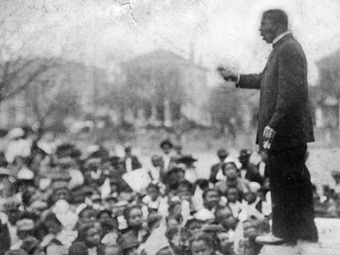
Directness
Knowing when and how to use directness in your speech can strengthen the impact on the audience.
“Omit the thunder of delivery, if you will, but put ‘silent lightning’ into your speech. Make your thoughts breathe and your words burn. ” – J. Berg. Esenwein, The Art of Public Speaking
What is Directness?
Directness is a state of being straight, constant, and without interruption. With regards to public speaking, directness refers not only to how you address your audience in both style and tone, but the force behind that style and tone. A better way to think about force and directness is to consider what they are not.
Force and directness are not:
- Speaking loudly (but force and directness may cause you to raise your voice)
- Using wild, violent gestures (but force and directness may cause you to gesture more emphatically)
As you can see, force and directness can be both cause and effect. Essentially, directness adds emphasis to your words, showing earnest conviction in your beliefs and arguments, thereby making your speech more evocative and persuasive to your audience. From a stylistic perspective, force and directness add moments of dynamic contrast to your speech.
When to Use It
Directness and force are not always appropriate in every speech and should be used with care. You don’t want to come across as overbearing, pushy, or threatening to your audience. That said, if you are giving a speech where you must convey a persuasive argument, directness and force may be appropriate.
Any time you are speaking about your own personal beliefs, values, or principles, you may find that force and directness naturally occur as you speak, since you are already so deeply invested in your own beliefs, values, and principles.
How to Use It
Force and directness can be controlled by four factors: ideas, your feeling about the subject, wording, and delivery.
Ideas
Certain ideas in your speech may lend themselves to force and directness. As you craft your speech, see which ideas rise to the top with regard to force and directness, and adjust your style accordingly.
Your Feelings
What are your gut feelings on your subject? Are you inspired, humbled, enraged? Capitalize on your own emotional response to determine if a section of your speech could be more forceful or direct than others.
Wording
Vivid words, phrases, and imagery are essential in crafting a forceful section of your speech. Use evocative language, powerful imagery, and compelling anecdotes to get your point across.
Delivery
Don’t be shy about using force or directness with your audience. Feel the conviction of your own words. Be authentic, genuine, and consistent.
11.2.2: Variations in Abstraction
While abstract descriptions should usually be avoided, abstraction can be used to your advantage when used correctly.
Learning Objective
Give examples of the uses of abstraction in a speech
Key Points
- Abstract descriptions are vague and not specific.
- Abstraction is a good technique to use if your audience already has a working knowledge of any part of your speech. You can save time and keep your audience engaged by not boring them with material or levels of understanding they already have.
- If you are too abstract, you may confuse your audience.
- To test if your speech is too abstract or over-described, have another person read your speech draft and summarize your main points back to you.
Key Term
- abstract
-
Difficult to understand; abstruse.
Variations in Abstraction
What Does It Mean to Be Abstract?
Abstractions are ideas that are not described in specifics. They cannot be physically sensed (seen, heard, felt, touched, or smelled). Abstraction lacks representational qualities. Abstract descriptions are in contrast to concrete descriptions. Concrete descriptions cut through any vagueness or amorphous interpretation of an idea.
Examples of Abstract Descriptions
- A happy child
- A pretty car
- A beautiful night
- An incredible sight
Examples of Concrete Descriptions
- A three-year old boy
- A white Lamborghini Aventador
- A starlit summer evening
- The wide river-cut rust-colored ravines of the Grand Canyon
While most of the time, you want to avoid abstract descriptions in your speech, there are times when it may be stylistically appropriate.
Mounting the Ladder of Abstraction

Ladder of Abstraction
A good speaker will be able to manoeuvre along the ladder of abstraction.
The Ladder of Abstraction, popularized by S. I. Hayakawa, is based on the idea that people are able to achieve four levels of reasoning.
At the bottom of the ladder is concrete thinking. Children tend to start asking concrete questions about the world around them at the age of eight or nine. “Why is the sky blue? ” “Where did my baby brother come from? ” Once you start hearing questions like these, you know the individual has started to climb the ladder of abstraction.
From that point, humans continue to grow and as they do so, their thinking broadens until they finally reach the top of the ladder: abstraction.
Talented speakers will start at the bottom of the ladder and present a concrete concept to the audience. They will then end on a broader, more abstract note. Thus they will ascende the ladder of abstraction. In doing so, they will generate interest (by use of the concrete point) and then move on to discuss the concept in general.
Advantages of Abstraction
If you audience has a working knowledge of something in your speech, you may not need to get into very finite, concrete detail with them. Using abstraction in this instance saves you time and doesn’t bore your audience with knowledge they may already know.
Disadvantages of Abstraction
The most obvious challenge of using abstraction is assuming that your audience has a certain working knowledge and failing to describe something concretely that may have needed a specific, spelled out description. In this instance, you will confuse your audience if you speak too broadly or vaguely.
Abstraction: Use It or Lose It?
A quick way to test if your speech is too abstract and not specific or concrete enough, share your draft with another person. Ask them to summarize it back to you. If they leave out or gloss over some points, ask them if your speech was clear enough to understand. If they didn’t understand parts, you’ll know which sections to go back to and specify in more concrete detail. Similarly, the person reviewing your speech can let you know if its too detailed.
11.2.3: Variations in Objectivity
Ideally, strive for a balance between subjectivity and objectivity in your speech.
Learning Objective
List the benefits of speaking with a balance of objectivity and subjectivity
Key Points
- Objectivity is the ability to remove your personal experience, bias or preference from your speech.
- Objectivity gives you credibility as an impartial, unbiased speaker and subject matter expert.
- That said, delivering a speech with 100% objectivity can feel robotic. Sprinkle some subjective moments such as personal anecdotes or how you connect to your topic to still remain relatable to your audience.
Key Terms
- objectivity
-
The state of being objective, just, unbiased and not influenced by emotions or personal prejudices
- subjective
-
The state of being formed, as in opinions, based upon a person’s feelings or intuition, not upon observation or reasoning; coming more from within the observer than from observations of the external environment.
Variations in Objectivity

Finding a Balance
You should strive for a balance between subjectivity and objectivity in your speech.
What Does it Mean to Be Objective?
When we are subjective in our speech, we put forth our own experience and bias into the conversation. To be objective, then, is to remove yourself from your own experience and bias. For the most part, when it comes to public speaking, you want to remain as objective as possible. The reason for this is because you don’t want your audience to accuse you of bias or preference as you substantiate your argument.
It’s a fine line to walk between subjectivity and objectivity, one that requires you to pay close attention to your own personal biases. One of the easiest ways to determine objectivity is to take a look at the amount of facts, research and data that you have to substantiate your case. If your speech is largely guided by personal thoughts, opinions and beliefs, then it is more likely that your speech is heading into subjective territory.
Advantages of Objectivity
The advantages far outweigh the disadvantages to remain objective throughout your speech. By writing and speaking objectively–that is, removing yourself from the facts, examples, and scenarios– you lend a more compelling case for your credibility as speaker. By sticking to hard facts and data, your audience can trust your impartiality to the subject matter. When they know that you don’t have anything personally invested in the outcome of or response to your speech, they are more likely to trust you as as subject matter expert.
Subjectivity Has Its Place
That said, you can also use objectivity to a point that can actually hurt your speech. By relying solely on hard data and research, your audience may find your speech impersonal and not connect to your material on a personal level. A speech without any personal anecdotes can feel robotic; on the other end of the spectrum, a speech comprised of nothing but anecdotes can feel untrustworthy. It’s your job as speaker to strike that careful balance to use enough subjectivity to be relatable to your audience but not so much as to erode your credibility and authority.
11.2.4: Variations in Orality
Orality is thought and verbal expression in societies where the technologies of literacy (writing) are unfamiliar to most of the population.
Learning Objective
Differentiate the qualities of an oral society from that of a literate society
Key Points
- Oral societies use narrative and repetition for ease of memory.
- Oral societies use directness and force to express emphasis.
- Oral expression brings words together in pithy phrases that are the product of generations of evolution.
- Gestures should be natural and not distracting.
- If you’re able to answer questions following your speech, always repeat the question before answering so everyone can hear what was asked. If you don’t know an answer, do not lie or make one up; share what relavant information you can.
- Always have a backup plan when using audio/visual technology for amplification of your voice or visual aids in case this equipment fails.
Key Terms
- orality
-
The quality of being spoken or verbally communicated
- primary orality
-
Primary orality’ refers to thought and its verbal expression within cultures “totally untouched by any knowledge of writing or print.”
Example
- The ‘sturdy oak tree’, the ‘beautiful princess’ or ‘clever Odysseus’ — these words are brought together out of habit during general communication.
Introduction

Orality
Modern scholarship has shown that orality is a complex and tenacious social phenomenon.
Orality is thought and verbal expression in societies where the technologies of literacy (especially writing and print) are unfamiliar to most of the population. The study of orality is closely allied to the study of oral tradition. However, it has broader implications.
In his publications Walter J. Ong, a key scholar in this field, distinguishes between two forms of orality: ‘primary orality’ and ‘secondary orality’. In addition, he refers to ‘oral residue’ and ‘residually oral cultures’.
Drawing on hundreds of studies from anthropology, linguistics and the study of oral tradition, Ong summarizes ten key aspects of the ‘psychodynamics of orality’. Ong draws his examples from both primary oral societies, and societies with a very high ‘oral residue’.
Formulaic Styling
Formulaic styling is to package complex ideas memorably for easy retention and recall.
To solve effectively the problem of retaining and retrieving carefully articulated thought, one must think in mnemonic patterns, shaped for ready oral recurrence. Thoughts must come into being in heavily rhythmic, balanced patterns, in repetitions or antithesis, in alliterations or assonances, in epithetic and other formulary expressions.
Anthropologist Marcel Jousse identifies a close linkage between rhythm and breathing patterns, gestures, and the bilateral symmetry of the human body in several ancient verse traditions. This synergy between the body and the construction of oral thought further fuels memory.
Additive Rather Than Subordinative
Oral cultures avoid complex ‘subordinative’ clauses. Ong cites an example from the Douay-Rheims version of Genesis (1609–10), noting that this basic additive pattern (in italics) has been identified in many oral contexts around the world:
In the beginning God created heaven and earth. And the earth was void and empty, and darkness was on the
face
of the deep; and the spirit of God moved over the waters. And God said …
Demonstrating how oral modes of communication tend to evolve into literate ones, Ong additionally cites the New American Bible (1970), which offers a translation that is grammatically far more complex:
In the beginning, when God created the heavens and the earth, the earth was a formless wasteland, and darkness covered the abyss, while a mighty wind swept over the waters. Then God said …
Aggregative Rather Than Analytic
Oral expression brings words together in pithy phrases that are the product of generations of evolution: the ‘sturdy oak tree’, the ‘beautiful princess’, or ‘clever Odysseus’. The words are brought together out of habit during general communication. Analyzing or breaking apart such expressions adds complexity to communications, and questions received wisdom.
Redundant or Copious
Speech that repeats earlier thoughts or thought-pictures, or shines a different light on them somehow, helps to keep both the speaker and the listener focused on the topic, and makes it easier for all to recall the key points later. Oral cultures encourage fluency, fulsomeness, volubility. Rhetoricians were to call this copia.
Conservative or Traditionalist
Because oral societies have no effective access to writing and print technologies, they must invest considerable energy in basic information management. Storage of information, being primarily dependent on individual or collective recall, must be handled with particular thrift. It is possible to approximately measure oral residue from the amount of memorization the culture’s educational procedures require.
This creates incentives to avoid exploring new ideas, and particularly to avoid the burden of having to store them. It does not prevent oral societies from demonstrating dynamism and change, but there is a premium on ensuring that changes cleave to traditional formulas, and are presented as fitting the traditions of the ancestors.
Close to the Human Lifeworld
Oral cultures take a practical approach to information storage. To qualify for storage, information must usually concern matters of immediate practical concern or familiarity to most members of the society.
By contrast, only literary cultures have launched phenomenological analyses, abstract classifications, ordered lists and tables, etc. Nothing analogous exists in oral societies.
Agonistically Toned
Beowulf fights the dragon: the oral world is agonistic.
Agonistic means ‘combative’, but Ong actually advances a deeper thesis with this point. Writing and to an even greater extent print, he argues, disengage humans from direct, interpersonal struggle.
Empathetic and Participatory
In an oral culture the most reliable and trusted technique for learning is to share a “close, empathetic, communal association” with others who know.
Homeostatic
Oral societies conserve their limited capacity to store information, and retain the relevance of their information to the interest of their present members, by shedding memories that have lost their past significance.
Situational Rather Than Abstract
In oral cultures, concepts are used in a way that minimizes abstraction, focusing to the greatest extent possible on objects and situations directly known by the speaker.
11.2.5: Variations in Accuracy
Make sure all sources of information for your speech are accurate, reliable, unbiased, credible, and current.
Learning Objective
Choose reliable sources when researching in order to assure your speech’s accuracy
Key Points
- Use scholarly sources such as journal articles, reviews, biographies, and interviews to ensure accuracy and credibility.
- You can find scholarly sources collected in several online databases.
- Always cite your sources when and how you can so that you’re never accused of lifting, stealing, or borrowing someone else’s words or work.
Key Term
- Accuracy
-
Exact conformity to truth, or to a rule or model; degree of conformity of a measure to a true or standard value.
Variations in Accuracy

Accuracy
Accuracy is vital for a speech to be successful. Make sure your facts are correct!
Why is Accuracy Important?
If you are presenting yourself as a subject matter expert or authority, it’s imperative that you have your facts straight before delivering them to a waiting audience. In the age of fact-checking, it’s especially important to make sure that you have done your homework and fully researched your topic and supporting evidence because chances are, your audience already has. You will only enhance your credibility and authority by making sure your information and sources are solid.
Are Your Sources “Good”?
How do you know if your sources are “good? ” You’ll want to make sure your sources are reliable, unbiased, and current. To do this, seek out information from trustworthy sources. Typically, you’ll turn to scholarly sources such as academic journals, scientific research, or data. You should also understand that scholarly research comes in primary and secondary sources.
A primary source is an original document containing content and data created or collected by the author. Primary sources can include interviews you conduct to gain information and data, collections of letters, lab reports, autobiographical, and literary works. Secondary sources are written about primary sources and include documents such as reviews, critiques, biographies, and other scholarly books or journal articles.
To find academic and scholarly sources, asking your local librarian is one of the best ways to validate whether or not a source you have found is reliable, unbiased, and current. You can also access databases of scholarly sources online, including:
- Academic Search Premier
- Project MUSE
- JSTOR
- Entrez-PubMed
- The MLA International Bibliography
- PsychINFO
- ProQuest
A Word About Plagiarism
Always cite your sources whenever or however you can. You never want to be accused of pulling information or data from an unreliable source, or worse yet, just making it up. You also don’t want to be accused of directly lifting, stealing, or even borrowing someone else’s words. Never take someone else’s words and claim them as your own.
11.3: Using Language Effectively
11.3.1: Choosing Clear Words and Phrasing
Choose clear words and phrasing in your speech by fully understanding your topic through delimiting the question and defining key terms.
Learning Objective
Analyze your speech topic until you fully understand the question and key terms
Key Points
- How well do you know your topic? Make sure you fully understand everything that goes into your topic as you begin to craft the specific wording of your speech.
- Start by delimiting the question, that is, fully parsing out exactly what question you’re answering by giving your speech. Even if you don’t think there is a specific question, your speech topic exists for some purpose. What purpose does your speech fulfill?
- From there, define your key terms of your speech.
Key Terms
- delimit
-
To mark or fix the limits of.
- baseline
-
A datum used as the basis for calculation or for comparison.
- dissect
-
To analyze an idea in detail by separating it into its parts.
Choosing Clear Words and Phrasing

Using Clear Words
It’s important to convey your message to the audience in the clearest way possible.
How Well Do You Fully Understand Your Topic?
You know that you have to write a speech, and you may or may not have been given a specific topic about which to write. Easy as pie, right? Hold on there–take a step back for a moment and ask yourself: how well do you fully understand your topic? It’s important to take that step back and look at your speech from a distanced perspective.
Looking at your speech from a distance allows you to dissect exactly how you can begin to tackle the specific wording of your speech. You want to make sure that your speech is easy to understand and follow, so it’s imperative to choose clear words and phrasing. When you think of your speech in delimiting the question and defining key terms, you have a great starting point for how to begin selecting the clearest words and phrasing.
Delimit the Question
What question does your speech address? You might be thinking, “Wait a minute. My speech isn’t even answering a question. I’m just supposed to talk about a business plan I’ve made for a fake company for an assignment in my entrepreneurship class. “
Here’s the thing: your speech actually is answering a question, that question being, “Why should you invest in my business? ” (however fake that business may be).
The importance of identifying the broader question to which your speech will speak not only helps your audience understand your point, but it pinpoints exactly how you need to tailor your speech to your audience. Essentially, when you take the steps to delimit your question (your speech’s purpose), you help to outline exactly how your audience can follow your line of reasoning.
When you delimit the question, first think about the purpose of your speech. This will usually point you in the direction of the broader question. From there, list step-by-step how you plan to address that question. Set the parameters for your rhetoric for your audience.
Define Key Terms
Even though your speech could be about something that is otherwise common knowledge to your audience, it is helpful to also define key terms for them as you go along in your speech. Even though you may have outlined your plan of attack by delimiting the question, it also helps to explain exactly what you’re talking about to your audience. When you establish your key terms by defining them for your audience, you set a baseline standard of understanding for your audience, thus eliminating any confusion.
When you delimited your question, were there any key words used in that question? Define those terms as necessary. You’ll want to source your definitions appropriately by looking up those key terms from reliable sources. In doing so, you indicate to your audience that not only do you fully understand the ways in which to approach your argument, but that you understand your topic.
Do be careful: you don’t want to “dumb down” your speech by defining every single key term throughout your speech. Make sure you only highlight and define those words that are necessary for establishing a foundation of your speech topic.
11.3.2: Choosing Vivid Words
Don’t lose audience interest by having a boring speech; use descriptive language to build interest and make your points more creatively.
Learning Objective
Use creative, vivid language in your speech to combat monotony
Key Points
- Descriptive language in your speech builds interest and allows you to immerse your audience in a sensory experience.
- Use simile and metaphor as a way to add descriptive language and wording into your speech. Make your points more compelling by painting pictures with words in the minds of your audience members.
- Tell your audience exactly how you want them to digest the information in your speech by using a variety of process words.
Key Terms
- monotony
-
Tedium as a result of repetition or a lack of variety.
- simile
-
A figure of speech in which one thing is compared to another, in the case of English generally using like or as.
- metaphor
-
The use of a word or phrase to refer to something that it isn’t, invoking a direct similarity between the word or phrase used and the thing described, but without the words like or as, which would imply a simile.
Example
- Here is a list of fifty of the most commonly used process words to add interest and vivid depth to your speech: Account, Analyze, Argue, Assess, Calculate, Characterize, Classify, Comment, Compare, Consider, Contrast, Criticize, Deduce, Define, Demonstrate, Describe, Determine, Differentiate, Discuss, Distinguish, Elaborate, Elucidate, Enumerate, Estimate, Evaluate, Examine, Explain, Express, Identify, Illustrate, Indicate, Infer, Interpret, Justify, List, Mention, Name, Outline, Prove, Quantify, Relate, Review, Show, Speculate, State, Substantiate, Suggest, Summarize, Trace, Verify.
Choose Vivid Language and Wording

William Shakespeare
When lacking vivid words, Shakespeare created his own. He invented over 1,700 words and phrases in his body of works.
Conquer Monotony
“The monotonous speaker not only drones along in the same volume and pitch of tone but uses always the same emphasis, the same speed, the same thoughts—or dispenses with thought altogether. Monotony: the cardinal and most common sin of the public speaker. ” – J. Berg Esenwein, The Art of Public Speaking
The quickest way to lose your audience is to be boring. Avoid the “sin of monotony,” as Esenwein puts it, by using vivid language and imagery to build interest in your speech.
Writing Descriptively
Think of your favorite food or meal, or perhaps your favorite place to visit. What does it smell like? Look like? Taste like? What sounds are characteristic of your favorite vacation spot? When you use vivid, descriptive language in your speech, you immerse your audience in a sensory experience that transports them from their seats and into the experience you craft with your words.
Writing descriptively is more than just using “pretty” language to dress up your speech; in fact, you want to be careful that your speech doesn’t come across as poetry. Using descriptive language can actually help get your points across more pointedly to your audience than by simply presenting hard facts and data. Descriptive language engages your audience’s imagination, which holds their attention and adds both interest and complexity to your speech.
There are a variety of ways to add descriptive language to your speech, which are described below.
Similes and Metaphors
Two of the easiest techniques to add descriptive wording to your speech are simile and metaphor. They essentially achieve the same goal: comparing one thing to another in likeness. In a simile, the comparison is made by using the words “like” or “as. ” Metaphors, on the other hand, usually compare things directly by using the verb “to be. ” These comparisons help to paint a picture in the minds of your audience. For speechwriters, metaphor and simile are like the brushstrokes of an artist, the notes of a melody, or the choreography of a dance — they demonstrate an artistry with language.
These comparisons may be alike or dissimilar. The use of opposing ideas and imagery can illustrate bolder points while similar comparisons bolster the strength of an idea or image.
Billy Collins, former U.S. Poet Laureate, is a master of metaphor. Take, for example, his poem, Litany:
You are the bread and the knife, the crystal goblet and the wine. You are the dew on the morning grass and the burning wheel of the sun. You are the white apron of the baker, and the marsh birds suddenly in flight. However, you are not the wind in the orchard, the plums on the counter, or the house of cards. And you are certainly not the pine-scented air. There is just no way that you are the pine-scented air. It is possible that you are the fish under the bridge, maybe even the pigeon on the general’s head, but you are not even close to being the field of cornflowers at dusk. And a quick look in the mirror will show that you are neither the boots in the corner nor the boat asleep in its boathouse. It might interest you to know, speaking of the plentiful imagery of the world, that I am the sound of rain on the roof. I also happen to be the shooting star, the evening paper blowing down an alley and the basket of chestnuts on the kitchen table. I am also the moon in the trees and the blind woman’s tea cup. But don’t worry, I’m not the bread and the knife. You are still the bread and the knife. You will always be the bread and the knife, not to mention the crystal goblet and–somehow–the wine.
Process Words
Process words tell someone how to process a set of information. In a speech, it’s important to vary your vocabulary so that you don’t end up repeating yourself. There are several process words that get at the basic six ways of processing information: comparing, criticizing, describing, discussing, evaluating, and explaining. By using synonyms of these words as you craft your speech, you not only tell your audience how to process the information you’re presenting, you also build interest by using a varied vocabulary.
11.3.3: Choosing Appropriate Words
Consider the style, tone, and sections of your speech to determine the most appropriate words and phrases.
Learning Objective
Choose appropriate words that can be used to section your speech
Key Points
- Section your speech into parts arranged in a logical order, with each section having a specific focus or purpose.
- Transition between sections with phrases and words that connect your ideas.
- Avoid weasel phrases in order to keep your speech credible and authoritative.
Key Term
- weasel phrases
-
Phrases that often precede statements and that lack substantive quality.
Choosing Appropriate Words

Appropriate Words
When choosing the appropriate words for your speech, it helps to fully understand the context of your speech, including the audience and venue.
The Style and Tone of Speaking
Consider for a few minutes exactly where, when, and how you will be giving your speech. Consider the tone and style of your speech. From there, think about how you will structure your speech, given these various contexts. Thinking about these parameters can give you an idea of the most appropriate language to use in the wording of your speech.
Sectioning Your Speech
As you outline your argument, you will want to break your speech into sections. A speech consists, broadly, of an Introduction, Body, and Conclusion. However, as you begin to highlight your thesis and specific supporting points and examples, you will create additional sections to your speech. This is particularly helpful if you have a long speech because sectioning makes the information easier for your audience to process.
Each section of your speech should have a specific purpose or focus. As you move from one section to the next, you will want to make sure you transition smoothly between each section.
Useful Phrases for Transitions and Sectioning Your Ideas
- Generalizing: as a general rule, as a rule, in general, generally, normally, on the whole, usually
- Explaining: in other words, that is, this means that
- Express likelihood: it is certain that, there is no doubt that, I am confident that, certainly, definitely, clearly, undoubtedly, presumably, will, is, should, it is probable that, it is likely that, probably, can, may, it is possible that, could, might, might possibly, possibly, perhaps
- Express doubt: it is doubtful that, maybe, is improbable, is unlikely, it is uncertain, impossible, cannot, can’t, will not, is not
- Draw attention: it is worth noting that, it should be emphasized that, it should be highlighted that, it should be underlined that, in particular, especially, mainly, chiefly, mostly, it should be pointed out that, it should be noted that, it should be remembered that, it is worth stressing that, is vital, is crucial
- Contrasting two points: however, but, in spite of, despite, in spite of the fact that, despite the fact that, nevertheless, nonetheless, instead, conversely, on the contrary, by contrast, whereas, while, whilst, although, even though, on the one hand, on the other hand, in contrast, in comparison with, but, yet, alternatively, the former, the latter, respectively, all the same, there are two possibilities, alternatively, the one, the other, either, or, neither, nor, in addition, no only, but also, worse still, better still, equally, likewise, similarly, correspondingly, in the same way, another possibility, in a similar vein, as well as, furthermore, moreover, also, although, again, what is more, besides, too, as well as
- Giving examples or introducing illustrations: for example, for instance, to name an example, to give an example, is well illustrated by, a case point is, such as, such, one of which, illustrates, is an example of this, is shown by, is exemplified by, is illustrated by, (something) is, means, describes, is defined as, is used, is concerned with, deals with, relates to, involves, signifies, consist of
- Stating consequences: so, therefore, as a consequence, as a result, now, consequently, because of, thus, for this reason, then, this is why, accordingly, hence, given this, with reference to, given, on this basis, is caused by, causes, due to, has the effect, affects, the reason for, because of this, if, then, results in, leads to, produces, owing to, through, as, since, because
- Summarizing: to sum up, in summary, to summarize, in brief, altogether, overall, I conclude, I therefore conclude, reached the conclusion that, it is concluded, therefore, for this reason, then, thus, in conclusion, to bring it all together
- Qualifying frequency: never, rarely, sometimes, usually, often, always, generally, on the whole, frequently, occasionally, hardly ever, seldom
- Qualifying results: under no circumstances, mainly, generally, predominantly, usually, the majority, most of, almost all, a number of, may be, some, a few, a little, fairly, very, quite, rather, almost
- Qualifying change: no, minimal, slight, small, slow, gradual, steady, marked, large, dramatic, complete, steep, sharp, rapid, sudden (rise, increase, fluctuation, decrease, decline, reduction, fall, drop, upward trend, downward trend, peak, plateau, level off)
Avoid Weasel Phrases
Weasel phrases are those that make a lot of promise but do not follow through on the delivery. These trigger phrases often precede statements that lack much substantive quality. These terms are particularly important to avoid so as not to invalidate the credibility of your argument. Here is a list of common weasel phrases:
- allegedly
- arguably
- as opposed to most
- considered by many
- contrary to many
- critics/critics say that
- it could be argued that
- it has been suggested/stated/said/noticed
- it is widely believed/generally claimed
- many people say
- many scientists argue that
- research has shown
- researchers argue that
- serious scholars say that
- social science says/believes that
- some historians argue
- the scientific community
- this is widely considered to be/regarded as
11.3.4: Matching Personal Style
Matching your personal style in your speech by defining your voice will take time and practice.
Learning Objective
Create your own unique voice based on the specific context of your speech
Key Points
- Your voice is ultimately a reflection of who you are as a person and influences how your audience both perceives and receives you as speaker. Adapt your voice to your audience’s needs, goals, and expectations.
- Consider your role in relation to the audience. Why are you there to speak to them? What makes you the subject matter expert?
- Don’t forget to think about the formality and venue of your speech, as well as any relevant cultural contexts that may come into play.
- Your attitude speaks volumes to your audience. Make sure your attitude is appropriate to all the factors of your speech: topic, audience, and venue. Be aware that subconscious non-verbal cues can betray how you really feel.
- Don’t be afraid to get creative and let your speech reflect your unique personality.
Key Term
- pandering
-
The act of expressing one’s views in accordance with the likes of a group to which one is attempting to appeal. The term is most notably associated with politics. In pandering, the views one is verbally expressing are merely for the purpose of drawing support and votes and do not necessarily reflect one’s personal values.
Example
- Steve Jobs, the late CEO of Apple, Inc., famously wore a black turtleneck to Apple’s annual Worldwide Developers Conference each year. Despite this being Apple’s biggest moment in the technology world spotlight, Jobs’ black turtleneck shirt had become his signature trademark, a reflection of his personal style. Even as Apple unveiled some of their most game-changing products for the future of personal computing, Jobs never compromised his personal sense of style. It matched well with his conversational manner and tone. In many ways, Jobs was able to show that the Apple brand was both flexible and approachable and could be as casual or as powerful as needed, for both the home user and the power user.
Matching Personal Style
When writing a speech, it’s important to consider the complete context in which you plan to speak. From audience, formality, topic, and venue, each of these factor in how you deliver your speech. Your words, phrases, lines of reasoning, as well as the gestures and mannerisms you might use, will influence your personal speaking style.

Your Own Style
Your speech is a reflection of who you are. Be sure to add your own personal style.
Define Your Voice
As you craft your speech, you will naturally begin to adopt a tone and style as you write. Your personal style and tone is what’s known as your voice. Your voice is what makes your writing and speeches unique from those of others. Developing your voice, in particular honing what works for you and what you like, is something that develops over time.
That said, there are other factors that shape your voice. Your voice should adapt to your speech as much as your speech is guided by your voice. Here are six factors to which you must consider as you develop your voice in your speech:
Audience
Who will be present at your speech? Who will be listening to what you have to say? As you consider your audience, think of what their needs, goals, and expectations are of your speech. Adapt your tone appropriately to your audience.
Formality
Are you presenting at an academic conference? Or are you giving the first toast speech at your best friend’s wedding? Consider the specific occasion, venue, and formality of your speech to make sure you’re using the most appropriate phrasing, language, and wording. Formality will also dictate how you need to dress and appear before your audience.
Your Role in Relation to Your Audience
Why are you there? What makes you the subject matter expert? As much as you’re analyzing your audience, the audience is doing the same of you. Your audience will have expectations and assumptions about you, so it’s helpful to consider them before you ever step foot on stage so that you can adapt and tailor your style accordingly.
Attitude
It’s not just what you say, but how you say it. Your attitude will speak volumes to your audience, not only informing them about you as a person, but either bolstering or eroding your credibility as speaker. Also, be aware that non-verbal cues, such as hand gestures, body stance, and posture can subconsciously betray your real attitude to your audience members, so always be mindful of your physical presence when speaking. You don’t need to be chipper and cheerful for every speech, but your attitude should reflect the other factors influencing your speech.
Cultural Context
Just as when you were analyzing your audience, consider the cultural context of where and to whom you’re speaking. Use your commonalities with the cultural context of your speech venue and audience to build bridges of understanding with your audience. However, don’t fall victim to pandering where you merely say things that reflect the overall needs and expectations of your audience without actually believing in them. Be authentic.
Your Own Creativity
At its heart, your voice is a reflection of you as a person. Let your creativity and the authenticity of your own words and experiences be the vehicle of your voice, guided by your gut. Over time, you’ll know what sounds good and what works well in your speeches.
Incorporate these best practices into your speeches so that they become second nature. It is also helpful to find volunteer readers for your drafts. Having a second reader or mock audience can help you identify areas that can be improved or emphasized, further honing your skills and personal style as a speech writer.

What’s your personal style?
Don’t be afraid to let your personal style come through in your speech. Steve Jobs does it well here with his signature black turtleneck.
11.4: Deploying Style Effectively
11.4.1: Alliteration
Alliteration is a stylistic device whereby a series of words begin with the same consonant sound, which can help your audience’s listening.
Learning Objective
Explain why public speakers use alliteration in public speaking
Key Points
- Phrases like “busy as a bee,” “drop dead gorgeous,” “friends and family” are all examples of alliteration.
- Alliteration adds a textural complexity to your speech that makes your words more engaging.
- Take a creative writing or poetic mindset to approach adding alliteration to your speech.
Key Term
- alliteration
-
The repetition of consonants at the beginning of two or more words immediately succeeding each other, or at short intervals.

Alliteration
The game of Tic-Tac-Toe is a perfect example of alliteration. Each word in the game’s name begins with the letter “T.”
Alliteration: What Is It?
When you use the same repetitive sound at the beginning of a series of words or phrases, you are using alliteration. Typically, this means a string of words beginning with the same consonant or syllabic sound. While alliteration doesn’t serve much rhetorical purpose, you do make your case more compelling by using a beautiful form of expression and language.
Famous Alliteration in Speech
“I see also the dull, drilled, docile, brutish masses of the Hun soldiery plodding on like a swarm of crawling locusts.” –Winston Churchill on the German invasion of Russia
“To those people in the huts and villages of half the globe struggling to break the bonds of mass misery, we pledge our best efforts to help them help themselves, for whatever period is required–not because the communists may be doing it, not because we seek their votes, but because it is right. ” –John F. Kennedy’s Inaugural Address
“Veni, vidi, vici. ” –Julius Caesar
Why Use It?
As mentioned, it won’t boost the efficacy of your argument but it will make it sound better. Alliteration adds a textural complexity to your speech that makes your words more engaging. When your speech is more engaging, your audience is more apt to pay attention and remain engaged with your words.
How to Use Alliteration
As you craft your speech, try to put on your poet’s cap. Alliteration is a technique often found in poetry, so take the time to get creative with the words and phrasing of your speech. Look for sentences that could use a little “oomph” and try playing around with alliterative words and phrases to make your words sparkle.
11.4.2: Antithesis
Anthesis adds stylistic texture to your speech through the presentation of contrasting ideas and an opposite point of view.
Learning Objective
Give examples of antithesis in public speaking
Key Points
- Contrast helps fully illustrate a concept by giving your audience a 360 degree understanding of your idea, claim, or argument.
- Giving your audience a contrast of the thesis with an opposite point of view aims them in the direction of understanding the concept; you can then use your speech to more fully flesh out that idea.
- If you’re having a hard time figuring out how to use antithesis in your speech, consider the opposing viewpoint of your main argument. From there, consider all the points of contrast that could be made from your main antithetical point.
Key Term
- antithesis
-
A device by which two contrasting ideas are juxtaposed in parallel form.
Antithesis
Antithesis is a counter-proposition that denotes a direct contrast to the original proposition. Antithesis is a way to express contrast through direct opposites. Light is the antithesis of dark, heaven is the antithesis of hell, and some would even say that cats are the antithesis of dogs.

Antithesis
Anthesis is a way of presenting contrast. Black is the antithesis of white and vice-versa.
Antithesis is also a way to describe contrasting ideas or themes: genocide is the antithesis of world peace, for example.
Why it is Used
Contrast is a very important stylistic choice to fully illustrate a concept. By explaining a concept, idea or argument with its opposite, you give your audience a 360 degree understanding of your point. Using something’s opposite helps to bolster the definition about what you’re speaking. By giving your audience a contrast with the opposite point of view, they have a better idea of the concept; if they do not, you can clarify further. Antithesis is a great way to lead into exactly how you want to portray an idea or argument.
How to Use Antithesis
Antithesis makes for a great way to set up your argument or idea by showing your audience the opposite. From there, you can then specifically tailor your argument to fill the void left when describing its opposite. If you are having a hard time trying to decide how to use antithesis effectively, consider the main point you are trying to make with your speech. What would the opposing point be? Use that as a springboard to begin pinning down points of contrast to give your speech stylistic texture.
11.4.3: Hyperbole
Hyperbole is the use of exaggeration or overstatement to get your point across to your audience.
Learning Objective
State how hyperbole can be used as a stylistic tool in speech
Key Points
- When hearing a hyperbole, ask yourself: is this claim really true?
- While you want to avoid generalizations in your speech as much as possible, there are advantages to using hyperbole since it can be used as an effective persuasive device.
- Don’t rely on hyperbole alone to substantiate your claims; instead, use it as a strategic stylistic choice to enliven your words and infuse them with persuasive meaning.
Key Term
- hyperbole
-
Extreme exaggeration or overstatement; especially as a literary or rhetorical device.

Hyberbole
Hyperbole is a form of exaggeration. Do you really think these are THE most touching records EVER made?
Hyperbole: What Is It?
Hyperbole comes from the Greek word meaning exaggeration and that is exactly what it is. Often, you can identify hyperbolic claims by certain trigger words such as “most,” “best,” or “worst. ” But not all hyperbole is that clear cut. The question you must ask upon hearing a hyperbolic statement is whether or not it’s actually a true statement. Hyperbole would have you believe so, and that’s what makes it an effective and strategic stylistic choice.
Why Use It?
While you want to avoid generalizations in your speech as much as possible, there are advantages to using hyperbole. They can be used like any other descriptive form of language to help paint a more vivid picture for your audience. Hyperbole also serves as a form of persuasion, to really make your case to an audience. The use of exaggeration or overstatement can make your speech that much more persuasive.
How to Use Hyperbole
Like any stylistic choice, be strategic. You don’t want your speech to consist solely of hyperbole as your audience will quickly begin to see that your argument has no basis. You can also use it to be more relatable to your audience or to simply communicate your point with a more vivid, engaging style. If you were speaking about a world leader, you might say, “they have the weight of the world on their shoulders” instead of “world leaders have a lot to deal with. ” We know that a world leader does not, in fact carry a weight of 6.6 sextillion tons of the Earth’s physical weight. But using that phrase communicates just how difficult it is to carry the burdens of global leadership.
11.4.4: Onomatopoeia
Onomatopoeia is a stylistic choice to represent sound within words and can be used as an attention-getting device in your speech.
Learning Objective
Indicate when and how onomatopoeia should be used in speech
Key Points
- Words like “meow,” “boom,” “bleep” and “boing” each represent the sound they make. These are each examples of onomatopoeia.
- Onomatopoeia, because of its jarring nature, often acts as a great way to emphasize something.
- Consider using onomatopoeia strategically and sparingly to make a bold or memorable statement.
Key Term
- onomatopoeia
-
A word that sounds like what it represents, such as “gurgle” or “hiss.”

Onomatopoeia
Onomatopoeia is a word that imitates a sound.
Onomatopoeia: What Is It?
Have you ever read an old Batman comic and seen action bubbles with words like “Boff! ” “Pow! ” and “Boom!”? These are all examples of onomatopoeia.
From the Greek, onomatopoeia is a combination of the words “I make” and “sound. ” At its most basic, onomatopoeia are words that represent the sounds they make. Whether it’s the woof of a dog or the wubwubwub of dub step, onomatopoeia captures that sound within a representational word. Many of these words have become a part of everyday language and you may not even realize you’re using onomatopoeia in the first place.
Why Use It?
Onomatopoeia can be a very effective and catchy stylistic choice to use in your speech. Since these words are representations of sound, they can often be jarring. They’re a great way to grab an audience’s attention when used in the right way. Some onomatopoeia are even part of common phrases and quotes, adding to the relatability of your speech:
- Pow! Right in the kisser.
- If it looks like a duck and quacks like a duck, it must be a duck.
- Snap, crackle, pop! (Rice Krispies jingle)
How to Use Onomatopoeia
The key to using onomatopoeia is to use it sparingly. Because onomatopoeia can be jarring, you don’t want your speech to be so punctuated by it that it makes it hard to listen to as an audience member. Consider using onomatopoeia when you need to make a bold or memorable point with your audience, perhaps as even a form of verbal punctuation. Onomatopoeia, like other styles of descriptive language, can help paint a visual – and aural – picture in the minds of your audience.
11.4.5: Personification
Personification can refer to speaking as another person or thing, or assigning human qualities to a non-human animal, object or idea.
Learning Objective
Identify the the different uses of personification in public speaking
Key Points
- Personification adds a colorful way to describe complex ideas to your audience.
- When using prosopopoeia, your audience will project their reaction on that which you’re trying to be and not on you as the speaker.
- Speaking as another person or idea is helpful to deflect negative response to the words you’re saying, but because you’re saying them as someone else, the audience is less likely to blame you for your words.
Key Terms
- prosopopoeia
-
A prosopopoeia (Greek: π) is a rhetorical device in which a speaker or writer communicates to the audience by speaking as another person or object.
- personification
-
A figure of speech, prosopopeia, in which an inanimate object or an abstraction is given human qualities.

Personification
Anthropomorphism is a form of personification. It associates human qualities and characteristics with non-human animals.
Personification: What Is It?
Personification is a rhetorical device where a speaker speaks as another person or object (in a style known as prosopopoeia). It can also refer to the assignment of human characteristics and qualities to non-human animals, inanimate objects or abstract ideas. A simple way to think about personification is to consider the characters of some of your favorite Saturday morning cartoons: Donald Duck, Mickey and Minnie Mouse, or the Teenage Mutant Ninja Turtles. As a form of hyperbole, we know these animals can’t speak English, go on madcap adventures in Disney World or use martial arts to right crime. But their personification makes them more human to us.
Why Use It?
In addition to being an artful form of speaking, personification can be used to more vividly make your point. Personification is a way of using storytelling to craft your speech by personifying complex or abstract ideas or thoughts. Your audience may better understand a complex subject when you give it human qualities and characteristics.
How to Use Personification
There are two ways to approach personification: to speak as another person to make a point or to personify an inanimate object, animal or abstract thought. In the former case, when you speak as someone or something else, your audience will project their reaction on that which you’re trying to be and not on you as the speaker. This is helpful to deflect negative response to the words you’re saying, but because you’re saying them as someone else, the audience is less likely to blame you for your words.
An example of speaking as something else is when President Abraham Lincoln constructs a mock debate between Republicans and the South, emerging as the spokesman for the Republican party:
“You charge that we stir up insurrections among your slaves. We deny it; and what is your proof? Harper’s Ferry! John Brown!! John Brown was no Republican; and you have failed to implicate a single Republican in his Harper’s Ferry enterprise. If any member of our party is guilty in that matter, you know it or you do not know it. If you do know it, you are inexcusable for not designating the man and proving the fact. If you do not know it, you are inexcusable for asserting it, and especially for persisting in the assertion after you have tried and failed to make the proof. You need to be told that persisting in a charge which one does not know to be true, is simply malicious slander. ” – Abraham Lincoln, Cooper Union Address
In the second instance, assigning human qualities to an object or idea also helps deflect negativity while bolstering the strength of your words and ideas. A particularly stark example of this could be seen at the 2012 Republican National Convention, when actor Clint Eastwood physically addressed and spoke to an empty chair representing President Barack Obama as if he were sitting there:
“So I — so I’ve got Mr. Obama sitting here. And he’s — I was going to ask him a couple of questions. So, Mr. President, how do you handle promises that you have made when you were running for election, and how do you handle them? ” – Clint Eastwood, Republican National Convention speech
11.4.6: Repetition and Parallelism
Repetition and parallelism can add clarity and dramatic punch to your speech.
Learning Objective
Distinguish between the use of repetition and parallelism in speech
Key Points
- Repetition should be used sparingly and strategically. Pick your most influential statement and weave its repetition throughout your speech.
- Use parallelism to use similar constructs to approach the same sentence. Add balance and break up repetition by adding parallelism to further emphasize your ideas.
- You may decide to use repetition and parallelism to drive home the most important takeaway messages from your speech.
Key Terms
- Parallelism
-
the juxtaposition of two or more identical or equivalent syntactic constructions, especially those expressing the same sentiment with slight modifications, introduced for rhetorical effect.
- repetition
-
the act or an instance of repeating or being repeated.

Repetition and Parallelism
Repetition and parallelism of ideas and concepts can really emphasize the point of a speech to an audience, while establishing balance in the argument.
Repetition & Parallelism: What Are They?
When you repeat similar ideas or themes in your speech, you are using repetition as a stylistic choice. Similarly, parallelism is a structured use of repetition by using identical or equivalent constructions in corresponding clauses to express the same sentiment.
Why Use Them?
Parallelism is an especially effective technique to provide structure, order, and balance in your speech, in addition to clarifying your argument. Repetition also helps emphasize your point to your directly to your audience. The audience is more likely to remember something that has been repeated. Parallelism works the same way but without rote repetition of words or ideas and instead constructs them from similar examples.
How to Use Repetition and Parallelism
Repetition is fine in small doses, but you don’t want to sound like a broken record. Consider using repetition of the same phrase or words only for those statements that you would like to be the most memorable and influential and weave them throughout your speech. You can also use them in close proximity for an especially dramatic effect. For example:
“Even though large tracts of Europe and many old and famous States have fallen or may fall into the grip of the Gestapo and all the odious apparatus of Nazi rule, we shall not flag or fail. We shall go on to the end,we shall fight in France, we shall fight on the seas and oceans, we shall fight with growing confidence and growing strength in the air, we shall defend our Island, whatever the cost may be, we shall fight on the beaches, we shall fight on the landing grounds, we shall fight in the fields and in the streets, we shall fight in the hills; we shall never surrender. ” – Winston Churchill
Parallelism is a very effective way to break up your use of repetition by laying out many different ways of expressing the same thought or idea. See below how parallelism was used in these two speakers:
“Let every nation know, whether it wishes us well or ill, that we shall pay any price, bear any burden, meet any hardship, support any friend, oppose any foe to assure the survival and the success of liberty. ” – John F. Kennedy
“Today’s students can put dope in their veins or hope in their brains. If they can conceive it and believe it, they can achieve it. They must know it is not their aptitude but their attitude that will determine their altitude. ” – Reverend Jesse Jackson
11.4.7: Simile and Metaphor
Simile and metaphor are creative ways of making comparisons in your speech.
Learning Objective
Differentiate between the use of a simile and metaphor in public speaking
Key Points
- Similes and metaphors are composed of two parts: a tenor and a vehicle. A tenor is the subject that is being compared or described; the vehicle is the comparison used to describe the subject.
- Both similes and metaphors use tenors and vehicles, the only difference being that similes connect the two with the words “like” or “as” while a metaphor simply states a tenor is a vehicle.
- Similes and metaphors are wonderful ways to bring your creativity and style to your speech.
Key Terms
- simile
-
A figure of speech in which one thing is compared to another, in the case of English generally using like or as.
- metaphor
-
The use of a word or phrase to refer to something that it isn’t, invoking a direct similarity between the word or phrase used and the thing described, but without the words like or as, which would imply a simile.

Metaphor
Using descriptive language adds variety and creativity to your speech.
Simile & Metaphor: What Are They?
Similes and metaphors are forms of descriptive language that make comparisons. Similes make their comparisons by using the words “like” or “as” while metaphors directly state what something is.
Why Use Them?
Simile and metaphor are artful ways of speaking to make a comparison. With simile and metaphor, you can paint pictures in the minds of your audience members. They make for more engaging and compelling ways of describing something, which means your audience is more likely to pay attention to what you have to say. Additionally, you have the chance to make bold stylistic choices in your speech through the construction of creative similes and metaphors.
How to Use Simile and Metaphor
Simile and metaphor are constructed of two parts: the tenor and the vehicle. The tenor refers to the subject itself, that which is being described. The vehicle is the comparison or description used to describe the subject. With simile, the tenor and vehicle are linked by the words “like” or “as” whereas metaphor simply states the tenor is the vehicle.
“All the world’s a stage, And all the men and women merely players; They have their exits and their entrances. ” William Shakespeare, As You Like It
In the example above, the tenor of Shakespeare’s line is the world. The vehicle of this metaphor is a stage, with an additional tenor of men and women represented by actors as a vehicle.
As you craft your speech, look for sections that could use vivd imagery; how do you want to make your words stand out in the minds of your audience? What picture do you want to paint with your words?
11.5: Understanding Bias in Language
11.5.1: Gender Bias
Gender bias exists because of the social construction and language of gender itself; recognize it and try to avoid it when speaking.
Learning Objective
Explain how gendered communication creates bias in public speaking
Key Points
- Gender is the social construction and definition of what it means to be man, woman, masculine or feminine.
- Gender expression and expectations of how gender should be expressed vary by culture.
- Men and women have different expectations and perceptions of each other and thus will receive speakers of opposing genders differently. Additionally, gender bias still exists – for both speaker and audience – when speakers who may share the same gender as their audience.
Key Terms
- bias
-
An inclination towards something; predisposition, partiality, prejudice, preference, predilection.
- gender
-
The sociocultural phenomenon of dividing people into the categories of “male” and “female,” with each having associated clothing, roles, stereotypes, etc.
Gender Bias in Public Speaking

Gender Bias
The late Benazir Bhutto, former Prime Minister of Pakistan, faced gender and cultural bias in her two brief terms as a world leader.
Understanding Gender
Before we can start talking about gender bias, it’s first helpful to understand the concept of gender. Gender is not necessarily indicative of the sex organs with which we’re born. When you’re talking about the biological classification of “male” and “female” you’re referring to sex, not gender.
Gender is the social construction of a person’s sex. Gender refers to the social definition and cultural expectations of what it means to be “man” or “woman. ” Additionally, some people may identify with a gender different from their sex, often identifying instead as “transgendered. “
Gender is not something with which you are born; instead it is taught, learned and understood through social interaction and experience.
What is Gendered Communication?
At its heart, gender is learned by, defined and taught to us through language and communication. Gendered communication is often culturally constructed as well, meaning that what is considered masculine or feminine in one culture may not hold true in another. How people express their gender often relies on the cultural constructs of the society in which they live or identify. The same is said of how people expect certain gender roles to be expressed by others.
Recognizing and Avoiding Gender Bias in Public Speaking
Just as you want to be cognizant and aware of the cultural biases that exist between both you and your audience, you’ll want to be equally aware of how gender bias may factor into your speech. Know that when a woman gets up to speak in front of a group of men, she is instantly received differently than her male counterpart. In certain cultural contexts, men may be dismissive of a female speaker. Many times, female speakers have to adapt gendered mannerisms, language and stance of men in order to validate their authority as speaker.
It’s not exactly a cut and dry vice-versa situation, either. Women may be at ease with a female speaker, but they may also be more attentive to a male speaker, given that many cultures teach women to be attentive (subservient in the extreme) to men.
Taking a step back and considering what gender bias you bring to the table, as well as what gender biases your audience might have of you is an important step in eliminating or at least addressing gender bias in your speech.
11.5.2: Culture Bias
We all carry cultural biases, intentional or otherwise; try to find and address cultural bias within your speech.
Learning Objective
Describe how cultural bias can impact the delivery, rhetorical content and reception of a speech
Key Points
- Cultural bias exists when you try to navigate the experiences of others through the framework of your personal compass of cultural experience.
- Both you and your audience bring cultural bias to your speech: how you perceive and communicate with them and how they perceive and receive your words.
- Cultural bias can impact mannerism, speech, and gesture as well as the rhetorical compenents of your speech.
- Try to avoid cultural bias if you can and if you can’t, at least acknowledge it. Read your speech from a distanced perspective while considering the cultural context both you and your audience bring to the speech and how it will be received. This will only make your argument more robust.
Key Terms
- Intercultural Communication
-
Intercultural communication is a form of global communication. It is used to describe the wide range of communication problems that naturally appear within an organization made up of individuals from different religious, social, ethnic, and educational backgrounds. Intercultural communication is sometimes used synonymously with cross-cultural communication. In this sense it seeks to understand how people from different countries and cultures act, communicate, and perceive the world around them.
- bias
-
An inclination towards something; predisposition, partiality, prejudice, preference, predilection.
Example
- In many Western cultures, we associate eye contact with assertiveness, attention, and honesty. However, in many cultures, including Asian, Latino, Native American and Middle Eastern, looking someone in the eye is actually a sign of disrespect. With regard to public speaking, looking at your audience is an integral part of delivering your speech. If your cultural context dictates that such eye contact is disrespectful, you may feel awkward about standing up in front of a crowd. Alternatively, if your audience falls into this context, know that your eye contact could be seen as intimidating or disrespectful.
Cultural Bias in Public Speaking
Understanding Intercultural Communication

Cultural Biases
To be effective speakers, we must recognize, acknowledge, and move beyond cultural biases.
In a world of seven billion people, author David J. Smith reduced the world down to just 100 inhabitants. Of those 100, Smith breaks the world down into the following locales and languages:
- 61 are from Asia
- 13 are from Africa
- 12 are from Europe
- 8 are from South and Central America
- 5 are from the United States and Canada
- 1 is from Oceania
- 22 speak a Chinese dialect (18 speak Mandarin)
- 9 speak English
- 8 speak Hindi
- 7 speak Spanish
- 4 speak Arabic
- 4 speak Bengali
- 3 speak Portuguese
- 3 speak Russian
When reduced to such simple terms, Smith’s “global village” illustrates the wide swath of diversity among the people of our planet. How we communicated with one another in spite of and in support of our diverse backgrounds is at the heart of intercultural communication.
Our unique cultural backgrounds can be the proving ground for commonality. Unfortunately, more often than not our cultural backgrounds serve as reminders of the ways in which we differ from one another and that our bias can serve as barriers to communication.
What is Bias?
Bias is the state at which we all exist; that is, a non-neutral state of inclination, predilection, and prejudice. By the sheer virtue of differences in human experience, we each harbor bias in some way because we’re all bringing something a little different to the table.
What is Cultural Bias?
Cultural bias exists when you try to navigate the experiences of others through the framework of your personal compass of cultural experience. Your cultural experience inherently makes you biased against disimilar cultural experiences to your own. Remember, bias doesn’t necessarily mean exclusion, so bias can mean a preference for one culture over another. This cultural bias may exist in the form of affinity towards one culture or cultural experience over another or complete detachment from one cultural experience over another.
How Cultural Bias Impacts Your Speech
Cultural bias exists in two forms when speaking in public. There’s the cultural bias you bring to the podium. The other exists in the minds of your audience, as they bring cultural biases with them to the auditorium. Both can impact your speech.
This dissonance between these biases can affect the ways your audience receives you as a speaker, in both trustworthiness and reliability as subject matter expert. Additionally, your cultural bias may impact your mannerisms and speaking patterns as you deliver your speech.
From a rhetorical perspective, your cultural bias may impact the strength and comprehensiveness of your argument. If your cultural bias only allows you to see things in a certain cultural context, there may be parts of your argument that aren’t fully developed simply because you don’t have the cultural context to even realize that part of your argument was not fully formed.
To overcome cultural bias, take a step back from your speech. Consider the following questions as you attempt to recognize and address cultural bias in your speech:
- What cultural context does your audience bring to your speech?
- What is the race, ethnicity, nationality, and heritage of your audience?
- What language barriers may exist?
- What cultural context do you bring to the table?
- What cultural biases might your audience have about you as speaker?
- What is the cultural context of both your argument and supporting evidence?
Chapter 10: Organizing and Outlining the Speech
10.1: Principles of Organization
10.1.1: The Importance of Organization
Good organization is the key to effective communication because it helps make your ideas accessible to your audience.
Learning Objective
Explain how information, knowledge, and wisdom work together in a speech
Key Points
- Public speakers can structure the audience’s experience through skillful organization. As you write your speech, decide what you want your audience to feel in the beginning, middle, and end of your speech.
- An effective speech should balance information, knowledge, and wisdom.
- Information is the foundation of knowledge; knowledge is the basis of wisdom.
Key Terms
- wisdom
-
Wisdom refers to insight that is gained from knowledge. This category includes truth, opinion, and perception.
- knowledge
-
Familiarity or understanding of a particular skill, branch of learning, etc.
- information
-
The category of information includes facts, figures, and concepts taken from primary and secondary texts.
Why Does Organization Matter?
William Carlos Williams once said that a poem is a “machine made of words. ” A sad poem is a machine that manufactures melancholy; a funny poem is a machine that produces laughs. Poetry doesn’t have a monopoly on this quality–a well-crafted speech can also be a machine made of words. Skillfully constructed language has a powerful effect on its audience, and speechwriters should strive to harness that power. How should a public speaker go about building a “machine made of words”? It’s all in the organization. Machines only work when their component parts are assembled properly.

Organizing a Speech
A well-organized speech is like a well-oiled machine.
When you are organizing your main points, ask yourself a few questions. What is your ultimate goal? Are you trying to inform the audience, persuade the audience, amuse the audience, or enrage the audience? Think about the experience you want to create for your listeners–how you want them to feel when you begin speaking, and how you want them to feel when you make your final statement. When you have a clear vision in mind, return to the “Ordering Main Points” segment and choose a model that fits your purpose.
For example, let’s say you are preparing a speech to solicit money for political dissidents in Chechnya, and you want to motivate your listeners by shocking them. If shock is the desired effect, it would be ineffective to spend ten minutes pontificating generally about the virtues of free speech without mentioning the specific abuse that the fundraiser addresses. It would be more effective to open with the story of an abused dissident who could benefit from the fundraiser’s efforts–a story that would show the audience how high the stakes are, and how donations could help.
Information, Knowledge, and Wisdom
Where is the Life we have lost in living?
Where is the wisdom we have lost in knowledge?
Where is the knowledge we have lost in information?
-T.S. Eliot
T.S. Eliot makes a good point: it is difficult to maintain a healthy balance of information, knowledge, and wisdom. When we write speeches, we mix material from the three main registers of meaning: information, knowledge, and wisdom. For our purposes, let’s define information as facts, figures, and concepts taken from primary and secondary texts. Knowledge is more general than information: it refers to the ideas that come from processing information, rather than the information itself. Knowledge is the synthesis of many facts. This category includes stories, principles, and contexts. Wisdom, the most general category of all, refers to insight that is gained from knowledge. Wisdom includes truth, opinion, and perception.
To put it in concrete terms, let’s look at the information/knowledge/wisdom breakdown in a speech about performance-enhancing drugs in sports:
Information: statistics about athletes’ steroid use
Knowledge: stories about athletes who take steroids
Wisdom: suggestions about ethics in sports
All three of these elements should work together. If your speech is too heavy on information and light on knowledge and wisdom, your message may get lost in the details. A speech that presents knowledge without information to support it or wisdom to justify it may seem pointless. “Wisdom” offered without information and knowledge to ground it in reality may come across as a vapid collection of clichés.
Good organization can prevent these problems. Balance information, knowledge, and wisdom as though you are building a house: lay a strong foundation of information, build knowledge on top of it, and finish the house with a roof of wisdom.
10.1.2: Critical Thinking
Learning how to think critically is a vital part of the organizational process of crafting an effective speech.
Learning Objective
Use critical thinking to craft an effective speech
Key Points
- Critical thinking consists of intentional, reflective thinking about a given set of information and determining not only what to believe about that information but also how to act on it.
- Critical thinking consists of the following six key processes and actions: clarifying goals, examining assumptions, discerning hidden values, evaluating evidence, accomplishing actions, and assessing conclusions.
- You must utilize the many elements of critical thinking to pinpoint your goals and articulate compelling, relevant, accurate evidence in your speech. Additionally, critical thinking allows you to examine your thesis from opposing viewpoints, giving you further strategies to bolster your argument.
Key Term
- critical thinking
-
he application of logical principles, rigorous standards of evidence, and careful reasoning to the analysis and discussion of claims, beliefs, and issues
Critical thinking consists of intentional, reflective thinking about a given set of information and determining not only what to believe about that information but also how to act on it. When you think of delivering a speech or a public address, you might not think that critical thinking plays a key role in the delivery of that speech. The key to a successful delivery lies in the speech’s logical structure and organization of thought. Critical thinking is an important part of that organizational process.
Speeches typically serve one of four basic purposes: to inform, to persuade, to demonstrate, or to entertain. Constructing your speech with an effective thesis or main point and evidence to support that thesis requires you as the speechwriter to use critical thinking to determine how you’ll make those points. Fully understanding the context of your speech is one of the most important elements of critical thinking in your speechwriting process.
Critical thinking consists of the following six key processes and actions:
- Clarify goals
- Examine assumptions
- Discern hidden values
- Evaluate evidence
- Accomplish actions
- Assess conclusions
In regards to public speaking, each of these is a process to undertake as you craft your speech.

Critical Thinking
Critical thinking is an important step in the process of writing an effective speech.
Clarifying Goals
Before you begin outlining your speech, consider exactly what you’re trying to accomplish. Are you trying to inform or instruct your audience on a particular subject? Do you seek to persuade them to feel a certain way about your topic? By considering your purpose for speaking, you can more clearly articulate your goals for the speech.
Examining Assumptions
As you pinpoint your thesis and main points, you’ll begin to outline exactly how you plan to support your argument. In order to present a clear and well-reasoned argument, you’ll need to make sure you have accurate and specific evidence to support your claims. By examining assumptions that may be made about your particular thesis, you can more clearly hone and refine the evidence you choose to present to bolster your case.
Discerning Hidden Values
Have you considered all the possible ways to present your main thesis and all the possible evidence you could include? Consider your thesis from opposing points of view. Using this critical thinking skill of discerning hidden values gives you a comprehensive way to approach your speech from all possible points of view.
Evaluating Evidence
Now that you know all the possible angles from which others can approach your line of reasoning, now it’s time to select the best evidence to support your thesis. By evaluating evidence with a critical eye, you’ll strengthen your argument by selecting the most compelling evidence to make your point.
Accomplishing Actions
Now that you’ve outlined your purpose, goals, and evidence, how exactly will you set out to accomplish those goals? Considering what actions you hope your speech will provoke will further guide you in the process of carefully selecting every word and sentence that brings you closer to realizing those goals.
Assessing Conclusions
Once you’ve written your speech, will your audience come to the same logical conclusion as you? Assessing the ways in which your audience will come to their own conclusions about your material will influence all the other pathways of critical thinking about your speech. You can then go back and tailor your evidence and content more appropriately so that your audience reaches the same conclusions you set out to present.
In sum, critical thinking is a vital part of the speechwriting and public-speaking process, a skill that you should work to develop in order to craft effective speeches.
10.1.3: Components of a Speech: Main Points, Introduction, Conclusion, and Transitions
A speech should have four components: the main points, introduction, conclusion, and transitions.
Learning Objective
Name the different components of a speech
Key Points
- Composing a speech is different from writing an essay. Write with listeners in mind, not readers.
- The bulk of a speech is different from the body of an essay. An essay is a careful, detailed scaffold that builds points over multiple pages, whereas a speech should stick to a few overarching points or themes.
- Public speakers can emphasize transition points with visual aids, body language, vocal delivery, and transitional words and phrases.
Key Term
- transition
-
The process of change from one form, state, style, or place to another.
Components of a Speech: Main Points, Introduction, Conclusion, and Transitions
A speech is more than simply an essay that is read aloud. Listening to a speaker is inherently different from reading a page, and public speakers should keep that difference in mind as they prepare their work.
A traditional academic essay consists of an introduction, a body with alternating concrete details and commentary, and a conclusion. The role of the introduction and conclusion are similar in speeches and essays, but the “body” is a different matter. Break free of the essay mindset, and try to think of a speech as the sum of four components: the main points, introduction, conclusion, and transitions. What’s the difference? Read on to see what is special about the components of a speech.
Main Points
Thinking of “main points” rather than a “body” can help speakers remember to keep it simple. A restless audience may not have patience for the predictable, orderly progression of concrete details and commentary that is typical in the body of an academic essay. Above all, communicate a few important points!
Introduction
The introduction should get the audience’s attention, describe the topic, state the thesis or purpose, and give an overview of the speech and its main points. Open with a detailed map of your speech–giving good directions in the beginning will save your audience from getting lost along the way.
Conclusion
The conclusion should summarize main points and state a strong thesis. Remember that many people struggle with auditory learning, and consequently have trouble focusing on spoken words. Your listeners may not put everything together on their own, so you should make it easier for them by summarizing your argument and reviewing central ideas in the conclusion.
Transitions
A transition is a change or shift from one topic to another. It may be surprising to see that transitions are one of the four key components of a speech. Academic writers tend to think of transitions as important stylistic elements rather than essential building blocks. However, transitions are crucial for public speakers, since speakers need to compensate for the loss of visual formatting. On a written page, formatting provides a helpful road map: the reader sees topic headings, paragraph breaks, and other visual cues that signal transitions naturally. Speakers can replicate these cues and signal transitions using visual aids and body language, but it will take more conscious effort than simply hitting “enter” to create a paragraph break. Speakers can emphasize transition points with visual aids, body language, vocal delivery, and transitional words and phrases.
Visual Aids for Transitions
Visual aids such as slides and handouts are a great way to guide the audience through your transitions. A slide or handout with topic headings printed on it is a good road map for a speech, preparing the audience for any twists and turns that may come up.

Transitioning Together
Effective transitions will help the audience follow your speech as it moves from topic to topic.
Transition Words and Phrases
These words and phrases signal a change, giving the audience a “heads up” about an upcoming transition:
Connecting:
- additionally
- also
- again
- moreover
- furthermore
- coupled with
- for example
- for instance
- likewise
- similarly
- specifically
- indeed
- in fact
Contrasting:
- however
- although
- but
- nevertheless
- on one hand
- on the other hand
- besides
- yet
- on the contrary
- conversely
- comparatively
Concluding:
- overall
- above all
- therefore
- thus
- accordingly
- consequently
- in conclusion
- finally
- in essence
- in other words
- in short
10.1.4: Patterns of Organization: Informative, Persuasive, and Commemorative
The three main categories of speech are: informative, persuasive, and commemorative.
Learning Objective
Discuss the goals of informative, persuasive, and commemorative speeches
Key Points
- When you begin organizing your speech, determine what your broader purpose is–to inform, persuade, or commemorate.
- Keep the purpose of your speech in mind as you try different structural models.
- Different structures are suited to different purposes, and you may have to experiment with a few models before you find the right one for your speech.
Key Terms
- persuasive speech
-
A persuasive speech makes a convincing case for its position or viewpoint.
- commemorative speech
-
A commemorative speech honors, celebrates, or remembers its subject.
- informative speech
-
An informative speech educates the audience about its topic.
Patterns of Organization:
As you organize your main points, keep your “big picture” goal in mind. Are you trying to inform your listeners about an issue? Or trying to persuade them to share your opinion? Perhaps you are commemorating an event?
Different goals call for different narrative structures and you may need to try a few models before you find one that suits. To aid your trial-and-error process, refer to the list of structural models in the previous chapter for ideas. If you haven’t looked at these recently, it may be helpful to review “Ordering Main Points” before reading on. The following provides examples of some of these in action.
Informative
An informative speech should educate the audience about its topic. These speeches are not argumentative—they describe, announce, or explain their subject without making a case or taking sides.
Catering to the audience’s needs is important in any speech, but it is crucial in an informative speech. This type of speech relies on the value of the information itself, without the added appeal of a conversion experience or an emotional catharsis. Make sure your information will be useful and interesting to your audience!
Here are some sample topic statements that illustrate different approaches to framing an informative speech:
Cause and Effect
- Consumers listed rising gas prices and falling prices for electric vehicles as the main reasons behind their new interest in electric cars.
Compare and Contrast
- Studies have found major demographic differences between consumers who would consider buying electric cars and those who would not, but both groups still share the same concerns.
Categorical
- Market research shows that consumers weigh three main issues when they consider buying an electric car: purchase price, convenience, and long-term cost savings.
Chronological
- The market for electric cars has evolved significantly in the years between its invention in the late nineteenth century and the mass-production of electric cars today.
Biographical
- Belgian inventor, Camille Jenatzy, combined solid engineering skills with a flair for publicity stunts to build a successful electric vehicle company in the 1890s.
Persuasive
A persuasive speech should make a convincing case for its position. While some are intended to win passive agreement from the audience, others encourage immediate action. For example, a speech arguing that drug-resistant bacteria strains are a serious problem seeks only passive agreement. However, if the speech went one step further and urged listeners to reduce their own consumption of antibiotics, it would belong to the second category.
If you want your audience to do something, end your speech with a call to action and explain how your listeners could help the cause.
These thesis statements about antibiotic-resistant bacteria illustrate different structural models for persuasive speaking:
Cause and Effect
- The U.S. industry standard of giving daily antibiotics to healthy livestock promotes the creation of antibiotic-resistant bacteria.
Problem-Cause-Solution
- Dangerous bacteria are adapting to resist antibiotics on under-regulated U.S. farms. The FDA should scrap its useless “voluntary guidelines” for agribusiness and impose legally-binding restrictions on the practice of feeding antibiotics to healthy animals.
Compare and Contrast
- The European Union banned the routine feeding of antibiotics to livestock as part of its quest to fight antibiotic-resistant bacteria. Compared to the strict regulations in other industrialized nations, the U.S. policy of trusting agri-businesses to regulate themselves seems outdated and irresponsible.
Categorical
- The case for legally-binding restrictions on agricultural consumption of antibiotics should be evaluated in terms of its costs, benefits, and practical feasibility.
Chronological
- The European Union banned the practice of routinely feeding antibiotics to healthy livestock in 2004. Since then, calls for similar legislation in the U.S. have become increasingly urgent as new studies warn of public health risks from antibiotic-resistant bacteria.
Biographical
- Dr. Marc Sprenger of the European Centre for Disease Control and Prevention draws on his experience as a doctor and epidemiologist to combat antibiotic-resistant bacteria.
Commemorative
A commemorative speech should honor, celebrate, or remember its subject. These sample statements of purpose memorialize different aspects of the Titanic:

Autographed Postcard
Three survivors of the Titanic, including Eva Hart, signed a postcard commemorating the tragedy.
Cause and Effect
- The sinking of the Titanic inspired a new wave of maritime safety laws. My panel will discuss the life-saving provisions we owe to that tragedy.
Compare and Contrast
- The passenger carrier Lusitania sank only three years after the Titanic and claimed nearly as many lives. However, the legend of the Titanic overshadows the Lusitania’s story. When I compare these two tragedies, I find myself asking—how different are they, really?
Categorical
- Are we justified in our nostalgia for a bygone era of chivalry? Behavioral economists have taken one step toward answering this question, using data from the Titanic and the Lusitania to study social norms in disaster responses. How many men actually gave up lifeboat seats to women and children? I will address these questions by analyzing the effects of age, gender, ticket class, and family structure on an individual’s chance of surviving one of these disasters.
Chronological
- After the Titanic sank in 1912, the White Star Line spent four years in arbitration before reaching a deal to cover 16 million in legal claims with a settlement of 664,000. Let’s give that controversial legal battle a retrial from beginning to end to see if the settlement is actually a fair outcome.
Biographical
- Tonight, we are gathered to celebrate Eva Hart, who was only seven years old when she sat on a lifeboat watching the Titanic sink into the sea with her father on board. The experience left her with terrible nightmares, but she overcame her fears and lived a full life as a singer, politician, and magistrate.
While informative speeches explain, educate and describe; persuasive speeches raise the stakes by using information to influence the audience; commemorative speeches assume a shared emotional connection to the subject.
10.1.5: Building a Speech: Starting with an Outline
The process of creating an outline can help speechwriters organize their main points and evidence.
Learning Objective
Describe the process and methods for creating a speech outline
Key Points
- If you are having trouble writing your outline, try brainstorming first.
- A topic outline, or a general list of topics, evidence, quotes, and other details, is a good way to organize your main points and create a general overview of the speech.
- If you want to make an outline that includes text from the actual speech, write a sentence outline.
Key Terms
- sentence outline
-
A sentence outline expresses the central ideas of a speech in complete sentences.
- topic outline
-
A topic outline is a hierarchical list of a speech’s main points. Topic outlines use keywords and short phrases rather than complete sentences.
- outline
-
A list used to present the main points or topics of a given subject, often used as a rough draft or summary of the content of a document.
Building a Speech: Starting with an Outline
It is always a good idea to make an outline before you begin writing a speech. An outline is a structural plan that lists main points, summarizes claims, and serves as a guide for the writing process. Working from an outline can help you organize your speech and put supporting elements, such as definitions and supporting evidence, in order. Some outlines are minimal, providing a quick sketch of a speech’s main points. Other outlines are very detailed, filling in a skeleton of topic headings with topic sentences, pieces of evidence, and transitions.
Many students are familiar with outlining techniques from academic writing classes. Outlining a speech is similar, but there is one key difference: speechwriters can use the outlining process to create prompts to aid with delivering the speech. Some speakers like to use handwritten notes, others use cue-cards, still others read from a printed script, and some experienced speakers don’t use any prompts at all. Ideally, with practice, you will avoid reading a script word-for-word—burying your face in papers for the entirety of the speech will limit your ability to engage the audience. However, minimal prompts such as cue cards and outline-style notes may help you stay on topic and remember main points. Whether or not you plan to use prompts, creating an outline is a great way to refine your argument—and you can always ignore it once you begin writing.
Brainstorming
Many speakers like to brainstorm before making an outline. Brainstorming, which involves techniques such as creating “idea maps” or flowcharts that connect ideas and evidence, is less formal and structured than outlining. It is a great place to begin if you’re having a hard time settling on a definite plan for your speech.
Topic Outline
A topic outline is a hierarchical list of a speech’s main points. Topic outlines tend to use keywords and short phrases rather than complete sentences. A topic outline is fragmentary—it serves as a prompt, rather than a draft of material to use in the actual speech.
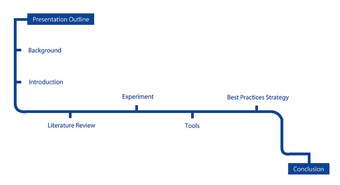
Creating an Outline
This outline provides a general overview of the structure of a science presentation.
Sentence Outline
A sentence outline expresses the central ideas of a speech in complete sentences. Sentence outlines are more detailed than topic outlines, but less detailed than first drafts.
10.2: Main Points
10.2.1: Choosing the Main Points
The needs, interests, and expertise of the audience should be the central consideration in choosing main points.
Learning Objective
Demonstrate a variety of methods to help you choose your main points based on your audience and the purpose of your speech
Key Points
- If you are speaking to a homogeneous audience, research the particular interests of that group and tailor your speech to meet their needs.
- If you are speaking to a heterogeneous audience, try to find points that will interest each segment of your audience, and also a common purpose to unify diverse elements.
- As you choose your main points, ask yourself what is at stake for the audience. Why should that particular group of people care about your topic? How will it affect them?
Key Terms
- Homogeneous
-
Having the same composition throughout; of uniform make-up.
- heterogeneous
-
Diverse in kind or nature; composed of diverse parts.
Choosing Main Points
When you are preparing a speech, it is important to establish a clear focus from the beginning. How should you narrow your focus and choose your main points? Follow the first commandment of public speaking: Know Thy Audience.
Focus on the Audience
According to a Greek philosopher named Epictetus, “We have two ears and one mouth so that we can listen twice as much as we speak. ” Epictetus’s wisdom applies to public speaking: listening to the audience is twice as important as speaking to the audience. Find out what your audience members already know about your topic, what they want to learn, and why it is important to them. If you focus on information that is obvious, irrelevant, or incomprehensible to them, you may find yourself speaking to a room full of yawns, cell phones, and backs walking out of your talk. However, if you research the demographics of your audience, you may avoid some common last-minute dilemmas: “Do I need to define this term? ” “Will this anecdote offend anyone? ” “Will anyone care about what I’m saying? “

Consider the Audience
In order to create an effective speech, the speaker needs to take the specific audience into account.
Of course, some groups are easier to figure out than others. Let’s say you are speaking at a professional development conference for paralegals. In that case, the attendees share a common purpose, which makes it easier to address their specific needs. You could look at sources such as professional journals and conference bulletins from previous years to see what issues are important to ambitious paralegals. If, on the other hand, you are speaking at a high school graduation ceremony, the audience may include a wide range of people with very little in common except the ceremony itself. In that case, your main points could focus on graduation, the one thing that binds everyone together.
Before you choose your main points, answer these questions about the audience:
- What does the audience know about my topic?
- Is the audience homogenous or heterogeneous?
- How does this topic relate to the audience?
- Why is this topic important to the audience?
- What is at stake for the audience?
- What does the audience want to learn about my topic?
- How can I show the audience that my main points are relevant and useful?
Homogeneous and Heterogeneous Audiences
A homogeneous audience is a group of people who share a consistent level of interest and expertise in your topic. A heterogeneous audience includes people with different levels of expertise and interest in your topic. It is important to determine what type of audience you have, and plan your speech accordingly. If you are writing a toast for your best friend’s wedding, you already know what your listeners want: they are gathered to celebrate the happy couple, and your toast should help them do that. On the other hand, if you are presenting scientific research to a mixed audience of academics and wealthy donors, you need to navigate a varied set of interests, agendas, and levels of knowledge as you select your main points. If there are non-experts in the audience, it is important to provide background information and define key terms. For a heterogeneous audience, you should make points that appeal to different segments of the audience, but also try to identify points that will unite your listeners under a common cause.
If you are addressing a homogeneous group, don’t take their interest for granted. It’s not a free pass–a homogeneous audience is not a captive audience. For example, if you are presenting research on business ethics to a group of specialists in your field, make sure to include points that might be applicable to their research.
The Stakes
How does your topic relate to your listeners, why should they care about it, and what is at stake for them? The answers to these questions will be your best guide in choosing main points. If you want to hold your audience’s attention, your speech needs to answer these questions as early as possible.
The Innovation
What are you adding to the existing conversation about your topic? What can your speech offer that the audience won’t find elsewhere? If you want to hold your audience’s attention, make a case for the comparative advantage of your perspective.
The Purpose
Most speeches aim to do one of three things: to inform, to persuade, or to commemorate. Choose main points that will fulfill your speech’s overall purpose:
- For an informative speech, provide a foundation of relevant information and then present knowledge and wisdom that will be useful to your audience.
- A persuasive speech assumes that your audience already has preconceptions about your topic. Address these preconceptions, and then introduce points that prove the value of your position.
- A commemorative speech usually compiles stories and wisdom that will help the audience honor, remember, or celebrate something.
Remember the broad purpose of your speech–to inform, to persuade, or to commemorate–as you choose your main points.
10.2.2: Ordering the Main Points
There are 9 different ways to organize your speech and the type of speech can help you decide which one is best to use.
Learning Objective
List ways to organize the main points of your speech
Key Points
- When ordering main points, the speaker should consider the audience and find a way to make sure the points are arranged to help retention and clarity.
- Try to limit a speech to 3 or 4 main points with supporting sub-points to make sure the audience is not overwhelmed with too much information.
- Each of the main points would require additional support and evidence in a speech and are identified only to aid the conceptualization of the organizational forms.
- Asking someone to listen to the speech can help make sure that the main points flow well and are in a order that will help maximize understanding for the audience.
Key Terms
- sub points
-
A sub point has a direct, specific relation to its major point that you can make clear by the organizational method you choose.
- chronological
-
In order of time from the earliest to the latest
Ordering Main Points
It is important to make sure that a speech flows properly to enhance understanding. When ordering main points, the speaker should consider the audience and find a way to make sure that the points are arranged to help retention and clarity .

Organizing the Main Points
Making sure the main points are ordered correctly helps the speech to flow better.
How Many Main Points?
Try to keep main points down to three or four with supporting sub points. An audience will only be able to grasp so much information at one time and the presenter does not want to bombard the audience with too much information at once. Additionally, make sure that each of your main points are supported by the same number of subpoints or evidence. This adds balance and proportion to your speech.
Ways to Organize the Main Points of Body
The following are the 9 different ways to organize your speech, including examples to help you understand better. Each of the main points, of course, would require additional support and evidence in a speech and are identified only to aid the conceptualization of the organizational forms.
Temporal Organization
This is the chronological approach; it is good choice for when you are telling a story, explaining research, or outlining a future plan.
Cause-effect
Telling why something happened; cause-effect may be used for past, present, or future events and processes. Cause-effect can also be reversed, from effect back to cause.
Example: What causes something to happen, and the result (effect) of the occurrence.
Spatial Patterns
When using spatial patterns, be sure to proceed systematically from one place to the next, following a clear order. A size sequence is a variation on spatial organization, describing different artifacts from smallest to largest (or from largest to smallest). This is useful when describing something, especially a progression through a place/time or a physical object.
Example: First you enter here, then you go through there, and you end up…
Topical
Topical is an appropriate approach when the subject matter has clear categories of division.
Example: My Family: my dad, my mom, my brothers.
Importance Patterns
This can be used to discuss the different reasons for something and then designating their importance.
Example: If you were the President’s advisor, you may come to him/her with 3 problems, organizing each in the order of importance to the country.
Compare/Contrast
The compare/contrast takes two or more entities and draws attention to their differences and/or similarities.
Example: If you were comparing apples and oranges you could use this to better clarify and prove your argument.
Problem-Solution Organization
- Problem-solution organization involves the identification of a problem followed by a possible solution.
Example: (1) Timmy does not have enough skittles (2) Ask Bobby to share.
Stock Issues
Stock issues are designed to organize presentations on issues of policy in a more complicated way than simple problem-solution. There are generally four main components to this organizational scheme:
- a description of the current system (inherency, or the inherent flaws in the current system),
- explanation of the harms that result from the current system (harms),
- a program to address those harms (a plan of action),
- reasons why the plan would be preferable to keeping the current system (solvency or why the plan would help the problem).
Monroe’s Motivated Sequence
This is good organizational tactic for persuasive speaking. It has 5 Components:
- Gain audience attention
- Show need for change
- Provide an alternative
- Benefits of the change
- A call for action
10.2.3: Highlighting the Main Points
If you want your audience to follow your main points, you should highlight them using visual and textual cues.
Learning Objective
Give examples of ways to highlight the main points in your speech
Key Points
- 65% of Americans are primarily visual learners, while 30% work best with auditory learning and 5% thrive with kinesthetic (or hands-on, touch-based) learning. This puts public speakers at a disadvantage, since only 30% of Americans learn best by listening.
- Public speakers should accept the reality of distractible audiences and take responsibility for getting the message across despite this challenge.
- Public speakers can emphasize their main points using visual and textual cues.
Key Terms
- textual cue
-
Textual cues are signals within the language of a speech: key words and phrases, examples, anecdotes, and selections of text that appear on a slide or handout.
- visual cue
-
A visual cues is a signal the audience can see. Examples of visual cues include slides, handouts, charts, and also the speaker’s body language.
Highlighting Main Points
The scenario: your teacher is droning on and on, and your mind wanders…”Mmm, food. What’s in the fridge? Should I buy groceries after class? What could I make for dinner? ” When you snap back into focus, the teacher has just finished explaining a key concept. Nothing else makes sense without that piece of the puzzle, but you can’t just turn back a page or hit rewind, so you’re out of luck! We’ve all been there, right? This is an important lesson for public speakers: no matter what you do, audience members will zone out occasionally. In an ideal world, your listeners would cherish every word that comes out of your mouth, but in the real world, that’s not going to happen. It’s practically a law of nature, so you might as well accept it and plan accordingly: highlight your main points to help your audience catch the most important ideas.
Visual and Textual Cues
Public speakers can highlight important points using visual cues and textual cues. Visual cues are cues the audience can see, including aids such as slides, handouts, and charts, and also the speaker’s body language. Textual cues relate to the content of the speech: signal words and phrases, examples, anecdotes, and selections of text that appear on a slide or handout. Take responsibility for your message and use some of these tried and tested techniques to get your message across.

Highlighting Main Points
Public speakers can use visual aids and textual cues to highlight their main points.
Highlighting with Visual and Textual Cues
Some studies estimate that 65% of Americans are primarily visual learners, while 30% work best with auditory learning and 5% thrive with kinesthetic (or hands-on, touch-based) learning. This puts public speakers at a disadvantage, since only 30% of Americans learn best by listening. Fortunately, speakers can use visual cues to make their words “stick. ” For examples of visual cues, just look at the page you are reading right now. Important points are highlighted with topic headings in large typeface, bold font, italics, bulleted lists, banks of key terms, etcetera: the visual presentation of a printed page functions as a guide for the reader. For a speech, the rules are a little bit different. To highlight key terms and new topic headings, a speaker can create slides or handouts that outline the speech’s main points. To convey the effect of italics or bold print, a speaker has to rely on tone of voice rather than visual cues. To combine visual and kinesthetic learning, speakers can poll the audience and ask them to raise their hands and look around the room to see the results. Here are several techniques for using visual aids such as slides, handouts, or posters to enhance your presentation:
Highlighting with Graphics
Graphics such as charts and pictures can make a presentation more engaging by illustrating the main points. If you support your claims with numbers, visual aids such as charts, graphs, and models would help your audience understand the figures easier and faster. If your speech describes people, places, or objects, pictures of those subjects would make your presentation more vivid and interesting.
Highlighting with Text
Visual aids such as slides, handouts, and posters are excellent ways to highlight key phrases, definitions, quotes, and lists. Spoken words can evaporate as soon as they leave your mouth, but written words stay in place–they’re not going anywhere. Try to put your most important points in concrete form. For example, a slide show that lists important definitions allows the audience to copy the definitions exactly as they appear, refer back to them, and make mental notes of the most important terms. When you make an outline of your speech, keep the question of visual aids in mind. You can save time with an outline that converts easily into visual aids: remember this when you choose subject headings, definitions, quotes, and key phrases.
Highlighting with Signal Words and Phrases
Signal words and phrases are designed to command attention. These verbal road signs have many uses, one of which is to highlight important points. Here are some examples of signal words and phrases that will alert your audience to pay attention: important, noteworthy, crucial, vital, major, principal, primary, central, valuable, defining, distinctive, relevant, above all, in the end
Highlighting with Examples
Precept is instruction written in the sand. The tide flows over it, and the record is lost. Example is graven on the rock, and the lesson is not soon lost.
-William Ellery Channing
Instructions, rules, and descriptions are all great, but if you want to make a concept stick, support it with an example. Different types of examples include facts, figures, data, illustrations, anecdotes, and quotes. As an illustration, compare the following two versions of the same point:
- Many Americans struggle with debt. For this reason, affordable health care is an important priority for our country.
- Anne Smith is one of the forty-six million Americans who live below the poverty line today. Last week, Anne arrived at the emergency room of Lutheran General Hospital unconscious and seriously injured after a drunk driver hit her and left her half dead. Anne survived, thanks to the hard-working EMTs at Lutheran General, but she woke up the next morning with $120,000 in medical bills. A health care system that cripples its patients with debt is not consistent with a healthy economy: Americans like Anne deserve better.
The second version combines facts, figures, and an anecdote to convey the human impact of the situation along with its broader significance. That is the power of example in action.
10.3: Introduction
10.3.1: The Role of the Introduction
The introduction should convince the audience that your speech will be relevant and useful by providing a general overview of what’s to come.
Learning Objective
Use the introduction of your speech to convince your audience that you have something worthwhile to say
Key Points
- The introduction is a sales pitch and a useful outline in one, so it should maintain a good balance of hype and content.
- The introduction has five important responsibilities: get the audience’s attention, introduce the topic, explain its relevance to the audience, state a thesis or purpose, and outline the main points.
- By the end of the introduction, you should provide a road map that outlines your main points.
Key Term
- introduction
-
A means of presenting one person to another.
Role of the Introduction
The introduction is the best opportunity to convince your audience that you have something worthwhile to say. An introduction can accomplish this by fulfilling five important responsibilities: get the audience’s attention, introduce the topic, explain its relevance to the audience, state a thesis or purpose, and outline the main points. By the end of the introduction, the audience should know where you’re headed and what your speech will cover. If you are giving a persuasive speech, state your thesis in the introduction. If you are giving an informative speech, explain what you will be teaching the audience.

Speech Introduction
The introduction grabs the audience’s attention and sets the tone for the entire speech.
As you write your introduction, try to answer these questions:
What is the scope of your presentation–how narrow or broad is your topic? How does it relate to the audience? What is at stake for the audience? Do you have any new insights or special perspectives to add to the existing discussion of your topic? Why should the audience listen to you instead of someone else? Will you be informing the audience, or making an argument?
The Road Map
By the end of the introduction, you should provide a brief overview of your main points. This “road map” will help the audience understand the main points in the context of your larger purpose. Without a good map to follow, the audience is liable to get lost along the way. A good introduction is the best way to make sure your message gets through.
In sum, the introduction should:
- Hook the audience.
- Describe your topic.
- Explain how your topic is relevant to the audience.
- Explain the stakes at hand.
- Establish credibility: What authority do you have to discuss this topic?
- State your innovation: What is new or special about your perspective?
- Lay out a road map of your speech.
- Outline your main points.
- State your thesis or purpose.
Writing the Introduction
If you have an anecdote, quote, question, or some other “hook” that inspires you to start writing the introduction, go for it. Don’t take inspiration for granted! In some cases, the right story will set up a natural sequence for your main points, launching the speech effortlessly. Otherwise, it may be easier to begin the introduction after you write about your main points. Working through the main points will set the destination of the speech, and it doesn’t hurt to have a clear idea of where you’re going before you set out. If you finish writing the body of your speech and come back to the introduction uninspired, refer to the chapter, “Getting Attention and Interest” for more ideas about effective openings.
10.3.2: Getting Attention and Interest
In order to win the audience’s attention and interest, write a dynamite opening and then give a quick overview of your speech.
Learning Objective
Give examples of ways to hook your audience’s attention with the first words of your speech
Key Points
- The opening of a speech is the most important time to get the audience’s attention and generate interest.
- One way to grab the audience’s attention is to begin with something surprising, shocking, or controversial.
- If a subdued approach is more appropriate, try opening with a question. In academic contexts, it may be best to start by situating your talk within the existing conversation.
Key Term
- anecdote
-
An account or story which supports an argument, but which is not supported by scientific or statistical analysis.
Getting Attention and Interest
Public speaking is essentially the art of convincing an audience to listen to you against all odds. How can you pry your listeners away from their day-to-day concerns? What would make you the most interesting person in their lives—at least until you finish your speech? You need to act fast, since first impressions tend to overshadow all other impressions. The opening of your speech will determine the audience’s willingness to listen. Learn how to deliver a dynamite opening, and you can make that fact work in your favor.

Attracting Interest
Getting the audience’s attention is like showing someone a wrapped present. It should peak their interest.
Strategies for the Opening
Here are eight ways to open a speech with panache:
1. Make a provocative or controversial statement. You can back down from an extreme position later, but controversy is an effective way to capture the audience’s attention.
Example: The United States should control its population growth by imposing fines on parents who have more than one child.
2. State a surprising or little-known fact.
Example: Did you know that eating blueberries can actually make you smarter by boosting neurotransmitters in your brain?
3. Open with a quote. If you can’t think of an attention-grabbing sentence yourself, get some outside assistance (with proper attribution, of course).
Example: Oscar Wilde once said, “Always forgive your enemies; nothing annoys them so much.”
4. Open with a brief anecdote.
Example: I was driving home from work on a cold, rainy day when I saw a scrawny cat by the side of the road. Her ribs were sticking out under her filthy, matted fur; she was clearly starving. I made the split-second decision to find a home for this cat, pulled over, lifted her up into the passenger seat, and began a journey that would change my life in ways I never could have imagined.
5. Make a case for your topic’s relevance to the reader.
Example: Genetically modified foods are filling grocery stores all over the country; they are unavoidable at this point. If you’ve eaten something today, you’ve eaten something genetically modified today.
6. Take a stand against something. Don’t attack a “straw man,” or a vague, made-up antagonist—be specific.
Example: The hazing rituals of this university’s fraternities and sororities are getting worse, not better.
7. Stake a position for yourself within an ongoing debate.
Example: Corporate culture is evolving toward workspaces that encourage collaboration, such as open floor plans and inviting communal areas. Our company has resisted that trend. We still have an old-school lineup of offices with closed doors surrounding a honeycomb of high-walled cubicles, and guess what—the employees never mingle! I believe it is time to give the new workplace order a chance.
8. State a question.
Example: When was the last time you donated money to charity?
Repetition
Repetition is boring, right? Who wants to hear the same thing more than once? Actually, experienced public speakers learn that repetition doesn’t have to be redundant—there’s more to it than saying the same thing twice. In this culture of distraction, choosing an anchoring word, phrase, or idea and returning to it periodically throughout your speech can help the audience find the connection between different points. Think about how it feels to listen to a good song: each verse builds the story with new lyrics, and then the chorus comes back to ground the song and bring it back home.
Finding Inspiration
If you get stuck, look to other speakers for inspiration. If you search video hosting sites such as YouTube and Vimeo for speeches, you can watch seasoned public speakers dealing with the very same problems you’re facing. Decide for yourself what works and what falls flat.
10.3.3: Establishing Credibility
To establish credibility, public speakers should earn the audience’s trust and respect by presenting themselves as authorities on the topic.
Learning Objective
Illustrate how to establish credibility and authority with your audience, even if they start out skeptical
Key Points
- Don’t rely on the content of your speech to gain credibility with the audience. Self-presentation is important too, since the audience will start judging you before you begin speaking.
- Establish your authority to speak about your topic by stating the source of your knowledge: experience, training, or research.
- When you speak to a skeptical audiences, begin by finding common ground. Acknowledge the appeal of opposing perspectives before you make a strong case for your own opinion.
Key Term
- credibility
-
The objective and subjective components of the believability of a source or message.
Establishing Credibility
In the realm of public speaking, the message is inseparable from the messenger. If audiences don’t trust you, they won’t listen to you. Unfortunately, their trust is based on superficial, silly, and irrelevant factors in addition to legitimate concerns. First impressions are hard to overcome, and audiences will begin judging you before you even have a chance to introduce yourself. Preparing a good speech is not enough to gain the audience’s trust and respect–you also have to prepare yourself. Establishing credibility may seem like a daunting task. After all, different people are looking for different things. How could you possibly please them all? Fortunately, public speakers can rely on a set of general guidelines to establish credibility in a variety of situations.
Self-Presentation
Self-presentation is a crucial factor in a public speaker’s credibility. The following strategies can help speakers convince their listeners that they deserve trust and respect:
- Dress the part. Find out how formal the occasion is and style yourself accordingly. Keep it simple: loud patterns, bright colors, flashy jewelry, and revealing styles may distract the audience from your message. When in doubt, err on the side of formal professional attire .
- Look at the audience. Speakers who make eye contact with the audience appear more open, trustworthy, and confident. Even if you are reading from a script or consulting cue cards, look up frequently to maintain your connection with the audience.
- Speak loudly, clearly, and confidently. Confidence is contagious–if you have confidence, the audience will catch it easily.
- State your credentials. Trust is contagious too–audiences will trust you more readily if you can prove that other people value your expertise. Credentials include relevant degrees, certifications, testimonials, recommendations, work experience, volunteering experience, and informally, other types of personal experience.
- Reveal a personal connection to your topic. What is at stake for you? How has the subject affected your life? If it is appropriate, share a personal anecdote that illustrates your relationship to the topic.
- Establish common ground with your audience. What problems do you have in common? What goals do you have in common?

Professional Attire
A speaker can establish credibility by dressing professionally and making eye contact with the audience.
Establishing Authority
Why should the audience listen to anything you have to say? The burden of proof is on you, so you need to make a case for the value of your experience, training, or research. Tell the audience how you became an authority on your topic. Don’t expect anyone to simply take your word for it, though: bring in outside sources to boost your credibility. Demonstrate that you are familiar with the conversations that surround your topic. Mention or quote other authorities on your topic to show that you are familiar with their contributions. Also, show your audience that you understand how your topic fits into a larger context. Look at the history of your issue and its treatment in other contexts or cultures. Winston Churchill’s maxim, “The farther backward you can look, the farther forward you are likely to see,” is a great case for the relationship between context and wisdom.
- State the source of your authority: experience, training, or research
- Refer to outside authorities
- Put your perspective in context
Gaining Credibility with a Skeptical Audience
If you are speaking to a skeptical or hostile audience, begin by finding common ground. Appeal to shared beliefs and values, and identify a goal that you can all agree on. Refer to this shared goal throughout your speech to remind your audience that, ultimately, you want the same thing. Show skeptics that you are motivated by a sincere desire to find the best answer and that, as a result, you have carefully considered their perspective. You will lose credibility if you dismiss opposing views offhand. If you can demonstrate that you understand why opposing views are attractive, you will have more credibility when you make a case for your own position. If you fail to address common points of contention, your audience will have a perfect excuse to resist your argument. In sum:
- Find common ground
- Appeal to shared beliefs and values
- Identify a shared goal
- Return to this shared goal throughout the speech
- Demonstrate that you have considered other perspectives on the issue
- Show that you understand the appeal of opposing positions
- Make a case for your position

Speaker at Social Media Art Camp
This woman knows her audience. She would have lost credibility dressed in a suit.
10.3.4: Introducing the Topic, Thesis, and Main Points
Provide an overview of your topic, thesis, and main points early on to show your listeners why they should be interested in your speech.
Learning Objective
Identify your topic, thesis, and main points early in your speech
Key Points
- Describe the scope of your speech when you introduce your topic.
- State your thesis or purpose clearly and with emphasis in one to three sentences.
- Provide an overview of your main points before you launch into the body of the speech.
Key Terms
- topic
-
Subject; theme; a category or general area of interest.
- thesis
-
A concise summary of the argument or main points, usually one to three sentences long.
Introducing the Topic, Thesis, and Main Points
Public speakers should introduce a topic and state a thesis (or purpose) as soon as possible. After the attention-grabbing opening, there is only a small window of time in which to convince the audience that you have something useful to say.

Introducing the Topic and Thesis
Public speakers need to introduce the topic and state the thesis as soon as possible to keep the audience’s attention.
Introducing the Topic
- Name your topic,
- Explain the topic at a level that is appropriate for your audience,
- Define key concepts,
- Explain how the topic relates to your listeners and remind them of their stake in the matter.
Introducing the Thesis
Make your initial thesis statement (or the statement of purpose in an informative speech) short and sweet.
Remember: the thesis statement should summarize your argument in one to three sentences.
Introducing the Main Points
Before your introduction is finished, give the audience an overview of your main points. It may help to refer to your outline, which should provide a concise list of your main points, in order. Translate that list into complete sentences, and voila! You will have a good overview.
Example: Topic, Thesis, and Main Points
Vitamin D deficiency may be the hottest topic in nutrition today. Scientists are flooding academic journals, fashion magazines, and talk shows with arguments about all things D, ranging from sunscreen to supplements.
No one is disputing its importance: vitamin D helps with calcium absorption, promotes bone health, boosts immunity, and reduces inflammation. That is why recent studies estimating that 10 to 75 percent of Americans are deficient in vitamin D are so scary.
Hold on—10 to 75? That range is huge!
In order to discover the extent of the problem, we need to take a closer look at those numbers—and that is exactly what we will do in this presentation. I have prepared a chronological overview and analysis of methodologies for measuring vitamin D levels in the U.S. population, beginning with a study conducted at this university.
Analysis
The opening of this speech names a topic (vitamin D deficiency), explains its importance, explains its relevance to the audience, and then states the purpose of the presentation—to investigate the improbably wide range of deficiency-rate estimates from different studies—and outlines the main points.
10.4: Conclusion
10.4.1: The Role of the Conclusion
The conclusion of a speech functions as a summary of the most important points so that the audience can best remember them.
Learning Objective
Define the role of a conclusion in a speech
Key Points
- The end of your speech is going to be the audience’s lasting impression of everything you’ve said. Use your conclusion as an opportunity to remind them of your main points.
- Reiterating your introduction in your conclusion will bring the audience’s mind back to the overall purpose and message of your speech.
- If you end your speech without some kind of lead-up or indication that you are about to do so, it can feel extremely abrupt and confusing to the audience. Make sure to give the audience closure with your ending.
Key Terms
- reconcile
-
To make things compatible or consistent.
- applicable
-
Suitable for application; relevant.

Summarizing a Speech
It’s important for public speakers to have a strong conclusion.
The role of a conclusion in a speech is to signal to the audience that the speech is coming to a close and help them remember the most important points from the speech.
While this may sound unimportant or superfluous, if you do end your speech without indicating you are about to do so it can feel extremely abrupt and confusing to the audience. Make sure to give the audience closure with your ending.
It is important that you always tie your conclusion back to your introduction. This can most effectively be done by circling back to your “hook,” or attention grabber. The same ‘vehicle’ or theme, for example, an anecdote about Margaret Thatcher, is employed to conclude the speech as was used initially to introduce it. A clever closing line is common place and many strong speakers will simultaneously reference the theme discussed in the introduction and conclusion.
The end of your speech is going to form your audience’s lasting impression of everything you’ve said. This is why your conclusion is the perfect opportunity to secure the key elements of your speech in your audience’s mind. Make sure that you reiterate the thesis statement from your introduction, highlight the most important points from your speech, and then relate the concepts of the speech back to reality so your audience can see how it is applicable to their world.
By reiterating your introduction you bring the audience’s mind back to the overall purpose and message of your speech. By signally the end of your speech your ensure that your audience leaves with an overall positive impression of your speaking and does not feel confused. By highlighting the main points, you ensure they are fresh in your audience’s memory.
Think of your conclusion as an opportunity to summarize. While your speech is undoubtedly well organized, concise, and poignant it is still possible for listeners’ attentions to wander or for them to not fully understand a certain section of your speech. Your conclusion is the perfect place to reconcile any miscommunication with your audience.
10.4.2: Summarizing Ideas
Summaries succinctly communicate lengthy ideas; your conclusion is the perfect place to summarize the main points of your speech.
Learning Objective
List the best practices for summarizing ideas in the conclusion of a speech
Key Points
- Three main areas of your speech should be summarized in your conclusion: your primary message, your main points, and what you want your audience to take away from your speech.
- A summary should concisely revisit what you’ve just been speaking about in a way that is accessible for your audience.
- Summaries should be lean, only including the most crucial information and ideas.
- Your conclusion should be an overview of your speech. There is no need to elaborate or use examples, as this should have been done in the body of your speech.
Key Terms
- concise
-
brief, yet including all important information
- elaborate
-
(used with on when used with an object) To give further detail or explanation (about).
Summarizing Ideas
Your conclusion is the perfect place to summarize the main points of your speech. That way, when your audience leaves, the most important information from your speech will be fresh in their minds.
Summarizing means to succinctly communicate a complex or lengthy idea. In the context of your speech, it means concisely revisiting what you’ve just been speaking about in a way that is accessible for your audience. Summaries should be lean, only including the most crucial information and ideas.

Summarizing a Speech
Ask yourself one main question: What do you want the audience to remember?
The best way to summarize ideas in your conclusion is to ask yourself the following important questions:
- What is the primary message I want my speech to communicate?
- What are the most important points of my speech that convey this message?
- What do I want my audience to take away from my speech?
By asking yourself these three questions, you will be prepared to write and deliver a conclusion that effectively summarizes the most important ideas from your speech.
Primary Message
It is important to always keep your primary message in mind when preparing for a speech. Throughout the entire speech you must constantly relate your research, examples, analyses, etc. back to the message of your speech. Your conclusion is no exception.
It is important to reiterate the focus of your speech again in your conclusion. By summarizing the primary message of your speech you will refocus your audience’s mind back to the overall purpose of your speech and the reasons why they should care about what you are saying.
Main Points
After you readdress your primary message, it is then crucial to summarize your main points. You have just spent your entire speech speaking in depth about these points, so you’ll want to be sure that you are only summarizing them and not entirely rehashing them all over again. Remember, a summary must be concise and lean. Clearly list your main points and connect them back to the primary message of your speech. There is no need to elaborate on them again or use examples—this should have been done in the body.
Audience Take-Away
Thinking about what you want your audience to take away from your speech is necessary in order to write an effective conclusion. You must decide the intention of your speech: is meant solely for educational purposes, are you trying to convince your audience to take a certain action (such as give money or vote), or perhaps you are attempting to teach them a skill.
Whatever the answer may be, it is imperative that you make your final push toward this goal in your conclusion. You can easily summarize this idea in only a sentence or two. You can even address your audience directly using the 2nd person (“You”) to help implant the message in their memory. Using call to action verbs such as “go”, “do”, “vote”, “sign-up”, etc. can also motivate audiences to engage in action.
Whatever you decide you want your audience to take away from your speech, it is important that you reiterate this in the conclusion and that you focus on simply summarizing it and not stating your entire speech all over again.
10.4.3: Signaling the End of Your Speech and Managing Q&A
Signaling the end of your speech and managing a Q&A session afterwards are crucial steps to leaving your audience satisfied and informed.
Learning Objective
Discuss the best practices for ending speeches and managing Q&A sessions
Key Points
- To signal the end of your speech, you can use concluding phrases and vary the tone of your voice to wind down your conclusion.
- Managing Q&A sessions is an important skill and will help your audience gain more in-depth information that is relevant to them.
- To successfully facilitate a Q&A session, it is important you are as knowledgeable about your topic as possible. If, however, you are asked a question that you cannot answer, it is crucial to stay calm and still answer professionally.
Key Terms
- conclusion
-
The end, finish, close, or last part of something.
- colloquial
-
Denoting a manner of speaking or writing that is characteristic of familiar conversation; informal.
Signaling the End and Managing Q&A
Part of a successful conclusion is easing your audience into the end of your speech. If you end to abruptly, your listeners may leave with a feeling of incomplete knowledge or hurriedness. You want to round out the end of your speech—like slowing down a car. You want your conclusion to lead to the end of your speech slowly and gently; you do not want to slam on the breaks .

Questions
Successfully answering questions at the end of your speech ensures that your audience has been pointed in the right direction.
Signaling the End of Your Speech
There are several ways you can indicate to your audience that you have reached the end of your speech. The easiest way is to directly tell them by using phrases at the beginning of your conclusion, such as, In closing, In conclusion, or Finally. This way, they are clearly aware you are coming to the close of your speech.
Another good way to indicate you are approaching the end is using a change in the tone of your voice. Humans naturally slow their speech and lower the tone of their voices at the end of a sentence or paragraph. By doing this, your audience will intuitively know that you are reaching the end of your conclusion.
Once you have successfully ended your speech, it is often appropriate to offer the audience a question and answer session, colloquially referred to as Q&A. In a Q&A session, you will allow your listeners to ask you specific and in-depth questions about your speech topic and then provide them with the appropriate answer.
Depending on the content of your speech, this could turn into a hostile or confusing exchange, so it is important to know how to manage a Q&A session.
Managing Q&A
The first and most important way to avoid any embarrassing moments during a Q&A session is to be very well versed and knowledgeable about your topic. There is nothing worse than being asked a very poignant question by an audience member and having absolutely not idea how to answer it.
While it is crucial to know as much about your topic as possible, it is impossible to know everything and even if you do your very best to prepare, there is always a chance you will be asked a question you cannot answer. If that ever happens, it is important not to panic. The best strategy is to have a handful of diplomatic phrases in your back pocket to save face. Some good ones include the following:
- “I did not come across that in my research but I can find out and get back to you.”
- “That’s a really good question and I’ve actually been wondering that myself. “
Since these are examples, you will want to word the phrases in your own style and according to your topic.
It is important to maintain control of the Q&A session. As the speaker, you are in charge of facilitating this interaction portion of your presentation. This means you must be aware of things like giving all audience members a chance to ask questions, not spending too much time on any one question, and not engaging in hostile rhetoric with your audience.
Finally, it is important to remember that while the conclusion is your audience’s final impression of your speech, a Q&A session will be the freshest in their minds. You want to do your best to be helpful and informative. Hopefully, audience members are asking questions because they are genuinely interested in the topic. It is your responsibility to engage them and do your best to help them attain the knowledge and answers they seek. The Q&A is still part of your presentation, so continue to present yourself as you did while you were speaking; do not become overly casual or revert to bad habits like breaking eye contact or speaking too quietly.
10.5: Transitions
10.5.1: The Role of Transitions
Transitions allow your audience to follow your presentation; they help maintain the flow of a speech.
Learning Objective
Indicate when transitions should be developed during the speech writing process
Key Points
- Adding transitions may be the last step in building your presentation, but that does not minimize their importance.
- A speech without transitions often seems choppy, and can even seem unorganized.
- You can use transitions to signal that you are stressing a point that you have already made.
Key Terms
- detour
-
A diversion or deviation from one’s original route.
- transition
-
The process of change from one form, state, style, or place to another.
Role of Transitions
Introduction: Building Your Speech
Once you have established your goal and identified your target audience, you should take the following steps to construct your presentation.
- Develop a general premise: constructing a presentation will require that you begin by developing your goal and translating it into a general premise you will state to your audience.
- Generate main points and organize them strategically: after you have established a premise, you will be able to generate main points to support this claim. Be sure to coherently organize these main points so that the audience can easily follow your flow of ideas. A maximum of two to five main points will ensure clarity and timeliness. Keep main points separate (transitions separate ideas) and balance the time spent on each point.
- Create an introduction and conclusion: after you have developed your main points, you will need to complete the introduction and conclusion. Create the introduction first—the conclusion really reiterates much of what was said in the introduction. The introduction opens the speech and is responsible for getting the audience’s attention, relating the topic to the audience, establishing the speaker’s credibility, and previewing the main points of the presentation.
- Fill in transitions: Prior to delivering your presentation, your final step will be to develop transitions that lead your audience between parts of the presentation and between distinct, main ideas.
Take the final step, filling in transitions, seriously. Transitions play an important role in the success of your speech.
The Importance of Transitions
Imagine this scenario. You are driving, trying to get from point A to pont B. At the beginning of your trip, you see a sign telling you that you’re going in the right direction. But then you drive and you drive. The road winds. There are detours and forks in the road, but there are no more signs pointing you towards your destination. Are you going the right way? How did you get to this point anyway? What is happening? Where are the signs telling you that the road has changed and you should go this way instead of that way?
In speeches, transitions serve this purpose. Take the road example from above and apply it to your speech:
Members of your audience will do their best to follow you as you speak. However, your speech may take detours. It is bound to move from one subject to the other. Will your audience make the correct connections or get lost? There is also the chance that members of your audience will drift off and when they tune back in will wonder how you moved from talking about X talking about Y. They do not know how you got there .

Detour
Transitions help the audience follow your presentation even when you take a detour.
Proper transitions will not only eliminate such questions, but will also hopefully eliminate the situation in which members of your audience drift off. Transitions enable the flow of a speech. A speech without transitions often seems choppy, and can even seem unorganized. Using them allows your audience to follow your presentation. The words you use can lead them along, signal that you are moving from one point to another, or signal that you are stressing a point.
10.5.2: Types of Transitions
Various types of transactions include: transitional phrases, internal previews, internal summaries, and signposts.
Learning Objective
Differentiate between and give examples of transitional phrases, internal previews, internal summaries, and signposts
Key Points
- Transitional phrases are words or phrases indicating that a speaker has finished one thought and is moving onto another one.
- Internal previews cue the audience to listen for the key elements within major points of the speech.
- Internal summaries review the key points a speaker just made.
- Signposts are often the numerical indications of the main body points.
Key Term
- transition
-
The process of change from one form, state, style, or place to another.
Example
- Many speakers utilize “first, second, third” type numbering to as a signpost to indicate where they are in their speech.
Introduction
Transitions enable the flow of a speech. A speech without transitions often seems choppy, and can even seem disorganized. Many tools for transitions allow a speaker to reiterate the central ideas they are trying to express.
Types of Transitions
Transitional Phrase: A word or phrase that indicates when a speaker has finished one thought and is moving onto another one.
Options:
- However;
- But;
- Nevertheless;
- On the contrary;
- Because;
- And;
- Lastly;
- Yet;
- On the other hand.
Example
In addition to being hilarious, The Office is also very entertaining. Consequently, there have been many people who try to imitate Dwight, but none can even come close.
Internal Previews
Internal previews are more detailed than simple transitional phrases, but serve a similar function. While the preview in the introduction discloses to the audience the general points to be made in the speech, the internal preview outlines the critical points to be made within the body of the speech.
Internal previews cue the audience to listen for the key elements within major points. Examples of internal previews include statements like “there are a couple of points I would like to make here,””there is both a problem and a solution to propose,” or “there are several items to note in this section. ” Each of these statements might be followed by more detailed, though brief, explanations of what is to come in the speech.
Examples
- I will be focusing on two main points–Why Jim and Pam should get married, and why Michael Scott needs to get married.
- Before I get started I would like to go over the three best episodes of The Office, which are “Diversity Day,” “Beach Day,” and lastly “Casino Night. “
Internal Summaries
Internal summaries, in contrast to internal previews, review the key points a speaker just made. These regular summaries help the audience to remember the key points just articulated by the speaker.
Examples of internal summaries include statements like “I have reviewed…,””Now that I have talked about a couple of the key points,” or “to summarize briefly what was just discussed…. ” Each of these statements would be followed by more specific but still brief summaries. Internal summaries reinforce the key issues in the speech.
Examples
- I hope I have made it clear that The Office is the best show ever, because it is relevant to the audience, it makes fun of so many different people but still gets away with it, and it is just plain funny.
Signposts

Where Are We Going?
Transitions show the audience where you’re taking them.
Signposts are often the numerical indications of the main body points. Many speakers utilize “first, second, third” type numbering to indicate where they are in their speech.
Signposts allow an audience to remember the key points and follow along in the speech. They serve to clearly distinguish main body points from each other and also from the introduction and conclusion. Signposts can also be used as questions.
Examples:
- First I will discuss with you the importance of convincing everyone about the greatness of The Office.
- To begin with, we must talk about how The Office came to be.
- Why do you think The Office is the number one show today?
Transitions are so important to a speech. Without them, your audience may just think that you are rambling.
10.5.3: Using Transitions
When using transitions, pair them with body language to make them even more effective.
Learning Objective
Indicate when and how transitions should be used in public speaking
Key Points
- You can use transitions along with hand movements to emphasize a point.
- You can use transitions to indicate that you are going to talk about the past or the future and then add movement to physically take your audience there.
- Transitions can also be used with facial expressions.
Key Terms
- transition
-
The process of change from one form, state, style, or place to another.
- body language
-
Body language is a form of mental and physical ability of human non-verbal communication. It consists of body posture, gestures, facial expressions, and eye movements. Humans send and interpret such signals almost entirely subconsciously.
Example
- You may be talking about the present and then want to take your audience back to the past. In doing this, you might use the transition phrase, “let me take you back. ” As you say this, move slowly to the right or left to show that you are moving into the past.
Using Transitions
Introduction
Transitions go a long way in improving the quality of your speech. However, there is something that can make the quality of your transitions truly bring your speech alive: combining your transitions with body language. You may be surprised to learn that only 7% of the information you transmit to others is in the language you use. The remainder comes from the following:
- 38% is how you speak—the quality of voice, accent, voice projection, emphasis, expression, pace, volume, pitch, etc.
- 55% Body language—posture, position, eye contact, facial expression, head and body movements, gestures, touch, etc.
Armed with this information, it is easy to understand why body language can make your transitions even more attention-grabbing.
Using Transitions with Body Language
Transitions Paired with Hand and Arm Movements
You can probably think of many good speakers who have used a finger wag or other hand gesture to emphasize a point. President Kennedy did this quite a bit and so did Bill Clinton . Be careful, however. If there is a note of admonishment in your voice, try to avoid finger pointing because it will seem insulting. An open-palmed hand spread wide, as if in appeal, is far less confrontational and is there fore more likely to be seen as positive.

Emphasizing Transitions
President John F. Kennedy used body language to emphasize transitions.
Other hand or arm movements can be useful—even positive—if it is well-chosen and sparse. An animated speaker who punctuates every expression with hand or arm gestures can create a diversion or distraction. Used occasionally, however, movement adds weight and gravity to important points.
How would you use a transition with this movement? Perhaps you are explaining a strategy with similarities to something that was implemented in the past. You want to emphasize that the past errors must be avoided. To emphasize this point, you might say, “However, we must be careful to avoid repeating the mistakes of the past. ” As you say this you may use a hand gesture such as the finger wag or the open palmed gesture.
Transitions Paired with Walking Backwards or Forwards
When Steve Jobs gave a presentation, people listened. The buzz created around his product announcements and the announcements themselves had a lot to do with it, but so did his presentation style. He incorporated movement within his style. He didn’t just stand behind a podium and speak. He knew how to enhance his story using transitions by changing his position on the stage.
You can do the same. You may be talking about the present and then want to take your audience back to the past. In doing this, you may use the transition phrase, “let me take you back. ” As you say this, move slowly to the right or left to show that you are moving into the past. Moving forward in time? Move in the opposite direction. Moving back again? Move the same direction in which you previously moved.
You may have been talking about something positive and now need to talk about something negative. To do this, you might use the transition phrase, “Now I need to take you to a different place. ” As you say this, step backwards. Or try adding even more emphasis by stepping backwards and then diagonally. Both movements signal that you now moving into a negative aspect of your talk.
Have something positive to say? Step toward the front of the stage as you say your transitional phrase.
Transitions Paired with Other Movements
Remember that your head and face are your key expression amplifiers. With appropriate movement and expressions of the face you can add emphasis where needed.
An exaggerated eyebrow lift or the removal of eyeglasses at an appropriate moment can give the appearance of your own realization of the importance of the particular point being made. Expressing a negative point while shaking the head from side to side, or a positive point while nodding are standard devices for amplification. Use these movements along with your transitions.
Finally, remember to alter your tone as you deliver your transitions. Think of what transition delivery methods you can use as you write your transitions into your speech outline.
10.6: Outlining
10.6.1: Reasons to Outline
Outlining is an important first step in speech-making; it allows you to ensure your speech flows smoothly and covers all your main points.
Learning Objective
Justify out the reasons to outline prior to writing a speech or presentation
Key Points
- An outline helps you group ideas into main points and see their logical connections.
- It is important to create an outline before you deliver your speech, as it will act as your guide to effectively sequence your information and ensure you touch on all your main points.
- Outlining allows you to ensure your speech flows smoothly.
- Use an outline as a tool for delivery of extemporaneous speaking.
Key Term
- outline
-
A list used to present the main points or topics of a given subject, often used as a rough draft or summary of the content of a document.
Reasons to Outline
There are many reasons to create an outline; but in general, it may be helpful to create an outline when you want to show the hierarchical relationship or logical ordering of information. Many people find that organizing a speech or presentation in outline form helps them speak more effectively in front of a crowd.
Below are the primary reasons for creating an outline.
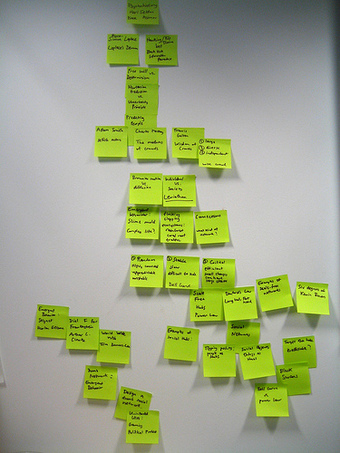
Why Make an Outline?
Creating an outline can help you organize your ideas.
Purpose
An outline helps guide you as you prepare your speech as follows:
- Helps you organize your ideas;
- Presents your material in a logical form;
- Shows the relationships among ideas in your writing;
- Constructs an ordered overview of your speech;
- Groups ideas into main points.
When you clearly outline exactly what points you would like to convey in each section of your speech, it will be much easier to envision. You can ensure you do not skip anything crucial and that your speech follows a logical sequence and order of information.
Organization
Your outline should consist of the three main parts of your speech: the introduction, the body, and the conclusion. Within each of these sections, you’ll need to plan more specifically what you would like to say. You can list your hook in the introduction, identify three or so main points to touch on in the body of your speech, and clearly lay out how you will end your speech and what thoughts you will leave your audience with in your conclusion.
It is important to keep in mind that your outline is only a guide. The purpose of it is to aid you in delivering a clear speech that flows smoothly and effectively, communicating all your ideas. An outline is not a script of your speech with the exact text you want to say, nor is it a rigid structure that you must follow exactly when giving your speech.
Think of your outline as a skeleton — a tool for delivery of extemporaneous speaking. It will serve as the backbone of your speech, providing you with a solid structure on which to build. However, it is your job to then to it flesh out and enrich it. Use your creative flare to make the bare bones more appealing and accessible to your audience.
10.6.2: The Preparation Outline
As its name suggests, a preparation outline helps you lay out the main topics and sub-points of your speech.
Learning Objective
Describe the purpose of a preparation outline, and the different preparation outline styles used by speech writers
Key Points
- The types of preparation outlines for speeches vary, however, it is up to the presenter to choose the format that best fits the content and personal style of the presentation.
- Common outline styles include sentence outlines, topics outlines, chronological outlines, and alphanumeric outlines.
- Similar to any traditional outlines, preparation outlines include a speech title, introduction, body, conclusion, and supporting references or sources.
Key Term
- prepare
-
to make ready for a specific future purpose; to set up; to assemble.
The Preparation Outline
A preparation outline is a precursor to your speech outline. As its name suggests, a preparation outline helps you prepare your speech. Presentations that require significant research, visual aids, or other type of content outside of speech rehearsal usually require organization and preparation in the form of an outline.
An outline is a list of items organized according to a consistent principle. Each item may be divided into additional sub-items or sub-points. A preparation outline consists of three main sections, which includes the introduction, body, and conclusion. It also includes the title of the speech.

Preparation Outline
Some word processing programs have pre-made outline templates that will make outlining your speech even easier.
Outline Approach
The types of preparation outlines for speeches vary. However, it is up to you to evaluate the style most appropriate for the speech, as well as the best form to assist you.
Common outline styles include sentence outlines, topics outlines, chronological outlines, and alphanumeric outlines. While sentence outlines follow a hierarchical structure composed of sentences and headings around the subject of the speech, topics outlines are comprised of topics and subtopics. Alphanumeric outlines include a prefix in the form of a roman numeral at the top level, upper-case letters for the next level, arabic numerals for the third level, and lowercase letter for the final level.
Outline Structure
If, for example, you have separate visual aids for the introduction, main points in the body of your speech, and your conclusion, than using a sentence style for your preparation outline may be more appropriate. Your preparation outline will start with the introduction, along with a list of the points you would like to cover before launching into the body of your speech. This may include a preview of the main topic, an attention-grabbing quote or statistic to support the main argument of your presentation.
The body of your speech will contain the details and descriptors to support the main point, topic, or argument of the speech. Here you will state each of the main points or topics you covered in your introduction, followed by supporting facts and details. Sub-topics should be added underneath each main topic covered in the body of the preparation outline
No matter what type of speech you are giving, every preparation outline should have a conclusion. The conclusion allows you to re-state and emphasize your main topic or argument (mentioned in the introduction) in a summary or list of key points. Moreover, you should identify how you will end your speech for the audience. Additional items you can add to the preparation outline include references or a “works cited” list including sources you have used to prepare your speech.
Remember, an outline is simply your guide. While there are traditional and non-traditional ways of outlining, do not get caught up worrying about “right and wrong” ways to outline. However, a standard preparation outline can serve as a helpful aid for a well-prepared and organized presentation.
10.6.3: The Speaking Outline
Speaking outlines help presenters with the timing, pacing, and overall delivery of the speech.
Learning Objective
Construct a speaking outline that includes an introduction, body, and conclusion
Key Points
- The speaking outline covers the main points and aids the speaker’s memory on certain topics.
- Speaking outlines generally include an introduction, body, conclusion, and transitions.
- To successfully deliver an outlined speech, it helps for presenters to be subject matter experts, or at least sufficiently knowledgeable about the topic.
Key Term
- transition
-
The process of change from one form, state, style, or place to another.
The Speaking Outline
After putting together a rough draft outline (i.e., the “skeleton” of the speech), writers can then progress to the speaking outline. Speaking outlines fill out additional details about the speech, as well as where the speaker plans to mention short phrases, pause, and transition to other topics. This outline may also include where the speaker would like to ask questions or use visual aids such as flip charts and handouts. The speaking outline acts a guide for the speaker on how to time and pace the delivery of the speech .
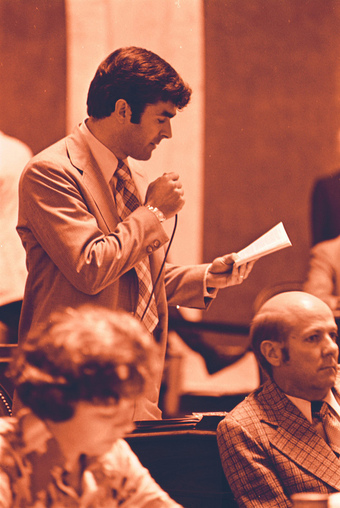
Using a Speaking Outline
Even experienced speakers use speaking outlines to aid them during presentations.
The Role of the Speaking Outline
Unlike the rough draft outline, which includes short notes on structure, the speaking outline covers both the main points and aids the speaker’s memory on certain topics. It offers the speaker more flexibility on tailoring the speech to the audience’s needs and reactions . Speaking outlines can be used to prepare and rehearse speeches, as well as serve as memory aids during the presentation.
Parts of a Speaking Outline
While speaking outlines include an introduction, body, and conclusion, they also note where transitions take place and when vital key points or statistics should be mentioned during the presentation. The structure of the speaking outline will likely vary slightly depending on the subject, timing, and audience. For example, notes may be added on when to introduce visual aids during the presentation. Nevertheless, a basic speaking outline generally includes:
- An introduction – This includes notes on whether the speaker starts with a quote, statistics, personal story, or humorous joke. It leads into the overview of the speech, previews the main topics, and captures the attention of the audience.
- A first transition – The first transition should be as smooth as possible, and be placed after the introduction and before the body of the speech.
- A body – The body lists the main points, sub-points, and supporting evidence. Each sub-point in the outline should have a supporting bullet.
- Second transition – The second transition comes after the body and before the conclusion.
- Conclusion – This includes a bullet on signaling the end of the speech, a bullet on restating the objectives or main argument, and a bullet that reviews the main topics discussed in the body. The speaker may also add a note to say a memorable statement or call-to-action (e.g., thank the audience, etc.).
To successfully deliver an outlined speech, presenters are usually subject matter experts, or at least sufficiently knowledgeable about the topic. But even for experienced speakers and speech writers, a speaking outline organizes thoughts, uncovers transitions, and reminds speakers to elaborate on key ideas.
10.6.4: The Rough Draft Outline
Rough draft outlines serve as a precursor to the speech’s rough draft and help organize the speakers’ ideas into a cohesive topic.
Learning Objective
Describe the role and different components of a rough draft outline
Key Points
- Rough draft outlines help form the skeleton of the speaker’s speech and provide a pattern from which the speaker writes his or her main statement, argument, and supporting points.
- Prior to starting the rough draft outline, some research should be completed.
- Similar to traditional outlines, rough draft outlines should include notes on the introduction, body, and conclusion.
- Rough draft outlines ultimately change as the speechwriter conducts additional research and continues to shape his or her speech topic.
Key Terms
- draft
-
A preliminary sketch; rough outline.
- outline
-
A list used to present the main points or topics of a given subject, often used as a rough draft or summary of the content of a document.
- writer’s block
-
The inability to begin or continue work on a piece of writing; normally temporary.
The Rough Draft Outline
Rough drafts outlines are part of the development process of speeches, crafting the flow and style of speakers’ presentations into a substantive and complete product. Creating rough draft outlines—i.e., an outline that serves as a precursor to the speech’s rough draft—often helps organize and structure speakers’ ideas into a cohesive and definitive topic. Rough draft outlines are not always necessary and may even be viewed as redundant. However, they can help speech writers prepare and organize their ideas during the pre-writing stage .

Rough Draft Outline
Preparing a rough draft outline is just one step to creating an informative and well-prepared speech.
Benefits of Rough Draft Outlines
Outlines help form the skeleton of the speaker’s speech. They provide a pattern from which the speaker writes his or her main statement, argument, and supporting points. The rough draft outline is particularly valuable at the pre-writing stage and provides the writer flexibility for revisions to the structure of the speech. Ultimately, rough outlines help organize the speech writer’s initial thoughts into a comprehensive process that flows into a rough draft and eventually a final speech.
Starting the Rough Draft Outline
One of the most useful techniques for starting a rough draft outline is brainstorming. Similar to freewriting, brainstorming jumpstarts the creative process by letting the speechwriter’s ideas flow and connect together around a specific topic. It also serves as a tool for overcoming writer’s block.
Prior to starting the rough draft outline, some research should be completed. Ideally, the writer has also finalized the main topics he or she will be discussing during the speech.
The Components of a Rough Draft Outline
The parts that comprise a rough draft outline are similar to other types of writing outlines. They include:
- An Introduction: This part of the draft outline should include an intro topic sentence, as well as notes on the argument or point of view of the speech.
- A Body: The body of the speech’s argument should include one or more main points. Each main point is supported by sub-points, which highlight factual evidence relating back to the main argument, or dismiss opposing arguments.
- A Conclusion: The speaker should note how they will restate his or her point of view and summarize the argument.
Your rough draft outline is essentially a technique for organizing and jotting down ideas into a traditional outline format. Because this is the rough draft outline, the outline too will ultimately change as the speechwriter conducts additional research and continues to shape his or her speech topic.
Chapter 9: Supporting Your Ideas
9.1: Deploying Supporting Materials
9.1.1: Types of Supporting Materials
There are many types of supporting materials, some of which are better suited for logical appeals and some for emotional appeals.
Learning Objective
Discuss the advantages and disadvantages of using different types of supporting materials
Key Points
- Scientific evidence includes all factual information. It is necessary and particularly useful for logical appeals.
- Testimonials, personal experience, intuition, and anecdotal evidence are all great for emotional appeals.
- Non-scientific supporting materials may be useful, but are not necessarily reflective of broader truths.
Key Term
- anecdote
-
An account or story which supports an argument, but which is not supported by scientific or statistical analysis.
There are a number of types of supporting materials, each of which has its own advantages and disadvantages. Not every type of supporting material is useful or effective in every situation, but each has its own niche.
Scientific Evidence
Scientific evidence is evidence which serves to either support or counter a scientific theory or hypothesis. Such evidence is expected to be empirical and in accordance with scientific method. Standards for scientific evidence vary according to the field of inquiry, but the strength of scientific evidence is generally based on the results of statistical analysis and the strength of scientific controls.More broadly, scientific evidence can be any statistic or fact that has been proven to be true through rigorous scientific methods. Facts and figures are necessary for logical appeals .

Scientific Evidence
Statistics are a type of scientific evidence that can bolster arguments.
Personal Experience
Personal experience is the retelling of something that actually happened to the speaker. Personal experience is useful for emotional appeals, but is not always good for more scientific arguments.
Anecdotal Evidence
Anecdotal evidence is evidence from anecdotes (stories). Because of the small sample, there is a larger chance that it may be unreliable due to cherry-picked or otherwise non-representative samples of typical cases. Anecdotal evidence is considered dubious support for a claim; it is accepted only in lieu of more solid evidence. However, it is particularly useful for making emotional appeals.
Intuition
Intuition is the ability to acquire knowledge without inference or the use of reason. Intuition provides us with beliefs that we cannot justify in every case. For this reason, intuition is not a particularly strong supporting material.
Testimonial
A testimonial is when someone speaks on behalf of another idea, product, or person. For example, weight loss commercials often utilize testimonials. The power lies in how convincing the person giving the testimonial is.
9.1.2: Using Supporting Materials
Supporting materials bolster arguments and can make them more persuasive to audience members.
Learning Objective
Identify reasons to use supporting materials and which types of materials are appropriate in a given situation
Key Points
- Scientific evidence is used to prove that a set of facts exist in the world.
- Non-scientific evidence is often used to create emotional connections with the audience, which can make them more receptive to the argument.
- Misused supporting materials can ruin your perceived reliability as a speaker and cause the audience to stop taking your argument seriously.
Key Term
- scientific evidence
-
Empirical, true facts or figures.
Supporting materials are necessary to turn an opinion into a persuasive argument. Being able to say something and have others immediately accept it as truth is a privilege afforded few speakers in few settings. In the vast majority of cases, audiences will not just want to hear the view you are asking them to accept, but also why they should accept it.
Supporting materials come in many different forms, from scientific evidence to personal experiences. Each is useful in different situations, but all are used to cause the audience to stop rejecting your idea as foreign and instead internalize it as truth.
Not all supporting evidence, however, is created equally. For example, scientific evidence is absolutely necessary in settings such as an exam. Appealing to the emotions of the professor is unlikely to yield a positive result, while articulating and analyzing the correct facts is. Scientific evidence is used to prove that a set of facts or conditions is present in the world.

Scientific Evidence
In most subjects, exam questions test the individual’s grasp of empirical evidence (scientific evidence).
In other instances, more experiential evidence will help you connect to the audience on a personal level. Personal experiences and anecdotes are great for establishing an emotional connection with the audience. Being able to connect emotionally helps to mitigate some of the boredom that often accompanies appeals that are just facts.
Using non-scientific evidence comes with some dangers, however. Non-scientific information is not often generalizable. That is, just because there is a story (or series of stories) does not mean that they necessarily represent the broader truth. Some audiences are skeptical of non-scientific supporting materials for this very reason. Using an anecdote of a boat sinking, for example, is unlikely to persuade most audiences that all boats sink. Attempting to use this type of evidence can actually weaken the appeal by decreasing your perceived reliability as a source.
9.1.3: Using Supporting Materials Effectively
Supporting materials are effective only if they help persuade the audience.
Learning Objective
Name elements to be considered when deciding what type of supporting materials to deploy
Key Points
- Regardless of the type of supporting material used, they are effective only if they fulfill the speaker’s burden of proof.
- Supporting materials must exist in order to be used; not all types exist for all arguments.
- The supporting evidence used depends on the idea being supported. Some ideas are more effectively supported by certain types of materials.
- Not all types of supporting materials are effective for every appeal. Speakers should select the materials that make their specific appeal most effective.
- The type of supporting material used also depends on the audience. If the audience cannot comprehend the material, it is not effective.
Key Term
- comprehensible
-
Able to be comprehended; understandable.
Using Supporting Materials Effectively
Supporting materials are the difference between an opinion and a convincing argument. Supporting materials are effective only if they help to persuade the audience. The type of supporting materials that should be deployed depend on the following:
- Available supporting material: not all types of supporting materials exist for all arguments. If there is no evidence, it obviously cannot be used.
- The idea being supported: if you are trying to explain that your favorite ice cream is chocolate, then scientific evidence about the molecular composition of chocolate ice cream is not as effective as personal accounts .
- The type of appeal: emotional and logical appeals tend to be supported by different types of materials. All types of supporting material can be used for emotional appeals, but providing data may not be as effective as providing anecdotes for connecting with the audience. For logical appeals, all types can again be used, though the most effective support is scientific evidence, because it is empirical and true.
- The audience: different audiences respond differently to different types of supporting evidence. It is the speaker’s job to determine what supporting materials will be most comprehensible and effective.

Gathering Evidence
An individual must have enough supporting material (evidence) in order to write a convincing speech.
Regardless of the type of supporting material used, they are effective only if they fulfill the speaker’s burden of proof. If the supporting materials are not delivered in a way that advances that goal, they are not deployed effectively.
For example, if you are speaking in front of a large crowd, and use a chart printed out on a sheet of paper, it doesn’t really matter what the chart says. If the audience cannot see the chart, then it will not be understood or effective. The same goes for other types of supporting materials; they are only effective if they can convince the audience.
9.2: Using Examples
9.2.1: Types of Examples: Brief, Extended, and Hypothetical
Brief, extended, and hypothetical examples can be used to help an audience better understand and relate to key points of a presentation.
Learning Objective
List the three types of examples
Key Points
- Examples include specific situations, problems or stories intended to help communicate a more general idea.
- Brief examples are used to further illustrate a point that may not be immediately obvious to all audience members but is not so complex that is requires a more lengthy example.
- Extended examples are used when a presenter is discussing a more complicated topic that they think their audience may be unfamiliar with.
- A hypothetical example is a fictional example that can be used when a speaker is explaining a complicated topic that makes the most sense when it is put into more realistic or relatable terms.
Key Term
- Hypothetical
-
A fictional situation or proposition used to explain a complicated subject.
There are many types of examples that a presenter can use to help an audience better understand a topic and the key points of a presentation. These include specific situations, problems, or stories intended to help communicate a more general idea. There are three main types of examples: brief, extended, and hypothetical.
Brief Examples
Brief examples are used to further illustrate a point that may not be immediately obvious to all audience members but is not so complex that is requires a more lengthy example. Brief examples can be used by the presenter as an aside or on its own. A presenter may use a brief example in a presentation on politics in explaining the Electoral College. Since many people are familiar with how the Electoral College works, the presenter may just mention that the Electoral College is based on population and a brief example of how it is used to determine an election. In this situation it would not be necessary for a presented to go into a lengthy explanation of the process of the Electoral College since many people are familiar with the process.
Extended Examples
Extended examples are used when a presenter is discussing a more complicated topic that they think their audience may be unfamiliar with. In an extended example a speaker may want to use a chart, graph, or other visual aid to help the audience understand the example. An instance in which an extended example could be used includes a presentation in which a speaker is explaining how the “time value of money” principle works in finance . Since this is a concept that people unfamiliar with finance may not immediately understand, a speaker will want to use an equation and other visual aids to further help the audience understand this principle. An extended example will likely take more time to explain than a brief example and will be about a more complex topic.

Extended Example
An equation is an extended example that’s used as a visual aid to help the audience understand a complicated topic.
Hypothetical Examples
A hypothetical example is a fictional example that can be used when a speaker is explaining a complicated topic that makes the most sense when it is put into more realistic or relatable terms. For instance, if a presenter is discussing statistical probability, instead of explaining probability in terms of equations, it may make more sense for the presenter to make up a hypothetical example. This could be a story about a girl, Annie, picking 10 pieces of candy from a bag of 50 pieces of candy in which half are blue and half are red and then determining Annie’s probability of pulling out 10 total pieces of red candy. A hypothetical example helps the audience to better visualize a topic and relate to the point of the presentation more effectively.
9.2.2: Communicating Examples
Examples help the audience understand the key points; they should be to the point and complement the topic.
Learning Objective
Use examples to help your audience understand the message being presented
Key Points
- Examples are essential to a presentation that is backed up with evidence, and they help the audience effectively understand the message being presented. An example is a specific situation, problem, or story intended to help communicate a more general idea.
- One method of effectively communicating examples is by using an example to clarify and complement a main point of a presentation.
- A speaker should be careful to not overuse examples, as too many examples may confuse the audience and distract them from focusing on the key points that the speaker is making.
Key Terms
- phenomenon
-
A fact or event considered very unusual, curious, or astonishing by those who witness it.
- abstract
-
Difficult to understand; abstruse.
Communicating Examples
Examples are essential to a presentation that is backed up with evidence, and they help the audience effectively understand the message being presented. An example is a specific situation, problem, or story intended to help communicate a more general idea. Examples are most effective when they are used as a complement to a key point in the presentation and focus on the important topics of the presentation.

Giving an Example
An example can make an abstract idea clearer.
Using Examples to Complement Key Points
One method of effectively communicating examples is by using an example to clarify and complement a main point of a presentation. If an orator is holding a seminar about how to encourage productivity in the workplace, he or she might use an example that focuses on an employee receiving an incentive (such as a bonus) to work harder, and this improved the employee’s productivity. An example like this would act as a complement and help the audience better understand how to use incentives to improve performance in the workplace.
Using Examples That Are Concise and to the Point
Examples are essential to help an audience better understand a topic. However, a speaker should be careful to not overuse examples, as too many examples may confuse the audience and distract them from focusing on the key points that the speaker is making.
Examples should also be concise and not drawn out so the speaker does not lose the audience’s attention. Concise examples should have a big impact on audience engagement and understanding in a small amount of time.
9.3: Using Statistics
9.3.1: Understanding Statistics
Statistics can be a powerful tool in public speaking if the speaker appropriately explains their use and significance.
Learning Objective
Use appropriate statistics in your speech in a way that is easy for your audience to understand
Key Points
- Understanding statistics requires creating a persuasive narrative that explains the data and an adequate explanation of why a statistic is being used, what it means and its source.
- The persuasive use of statistics is one of the most powerful tools in any rational argument, especially in public presentations.
- There are many ways to interpret statistics, however a public speaker should be mindful that they are presenting a statistic in an accurate way and not misleading the audience through a misrepresentation of a statistic.
Key Term
- statistics
-
A systematic collection of data on measurements or observations, often related to demographic information such as population counts, incomes, population counts at different ages, etc.
Understanding Statistics
Using statistics in public speaking can be a powerful tool. It provides a quantitative, objective, and persuasive platform on which to base an argument, prove a claim, or support an idea. Before a set of statistics can be used, however, it must be made understandable by people who are not familiar with statistics. The key to the persuasive use of statistics is extracting meaning and patterns from raw data in a way that is logical and demonstrable to an audience. There are many ways to interpret statistics and data sets, not all of them valid.
Guidelines for Helping Your Audience Understand Statistics
- Use reputable sources for the statistics you present in your speech such as government websites, academic institutions and reputable research organizations and policy/research think tanks.
- Use a large enough sample size in your statistics to make sure that the statistics you are using are accurate (for example, if a survey only asked four people, then it is likely not representative of the population’s viewpoint).
- Use statistics that are easily understood. Many people understand what an average is but not many people will know more complex ideas such as variation and standard deviation.
- When presenting graphs, make sure that the key points are highlighted and the graphs are not misleading as far as the values presented.
- Statistics is a topic that many people prefer to avoid, so when presenting statistical idea or even using numbers in your speech be sure to thoroughly explain what the numbers mean and use visual aids to help you explain.
Common Uses of Statistics in a Speech
Some common uses of statistics in a speech format may include:
- Results from a survey and discussion of key findings such as the mean, median, and mode of that survey.
- Comparisons of data and benchmarking results—also using averages and comparative statistics.
- Presenting findings from research, including determining which variables are statistically significant and meaningful to the results of the research. This will likely use more complicated statistics.
Common Misunderstandings of Statistics
A common misunderstanding when using statistics is “correlation does not mean causation. ” This means that just because two variables are related, they do not necessarily mean that one variable causes the other variable to occur. For example, consider a data set that indicates that there is a relationship between ice cream purchases over seasons versus drowning deaths over seasons. The incorrect conclusion would be to say that the increase in ice cream consumption leads to more drowning deaths, or vice versa. Therefore, when using statistics in public speaking, a speaker should always be sure that they are presenting accurate information when discussing two variables that may be related. Statistics can be used persuasively in all manners of arguments and public speaking scenarios—the key is understanding and interpreting the given data and molding that interpretation towards a convincing statement.
9.3.2: Communicating Statistics
Visual tools can be an effective way of incorporating statistics in your persuasive speech.
Learning Objective
Illustrate your argument by incorporating accurate statistics via visual tools.
Key Points
- Your audience is much more likely to believe you if you incorporate statistics.
- Consider using visual tools such as tables, graphs, and maps to make statistics more understandable for your audience.
Key Term
- statistics
-
A systematic collection of data on measurements or observations, often related to demographic information such as population counts, incomes, population counts at different ages, etc.
Using Visuals
Statistics is the study of the collection, analysis, interpretation, presentation, and organization of data.
Because data represent facts, incorporating statistics in your persuasive speech can be an effective way of adding both context and credibility to your argument. Your audience is much more likely to believe you if you incorporate statistics.
Statistics can be difficult to understand on their own, though. As a result, consider using visual tools such as tables, graphs, and maps to make statistics more understandable for your audience. These visuals are often easier to understand than raw data.

Using a Map
A map, a type of visual representation, can make data easier for the audience to understand.
9.4: Using Testimony
9.4.1: Expert vs. Peer Testimony
There are two types of testimony: expert testimony and peer testimony.
Learning Objective
Differentiate between expert testimony and peer testimony
Key Points
- A testimony is an assertion made by someone who has experience or knowledge of a particular matter.
- Expert testimony is testimony given by a person who is considered an expert by virtue of education, training, certification, skills, and/or experience in a particular matter.
- Peer testimony is given by a person who does not have expertise in a particular matter.
Key Terms
- Expert testimony
-
Testimony given by a person who is considered an expert by virtue of education, training, certification, skills, and/or experience in a particular matter.
- Peer testimony
-
Testimony given by a person who does not have expertise in a particular matter.
- testimony
-
An assertion made by someone who has knowledge or experience in a particular matter.
Introduction
A testimony is an assertion made by someone who has knowledge or experience in a particular matter.
Testimony is used in various contexts for a wide range of purposes. For example, in the law, testimony is a form of evidence that is obtained from a witness who makes a solemn statement or declaration of fact.
There are two major types of testimony: peer testimony and expert testimony.
Expert Testimony
Expert testimony, as the name suggests, is testimony given by a person who is considered an expert by virtue of education, training, certification, skills, and/or experience in a particular matter. Because experts have knowledge beyond that of a typical person, expert testimony carries considerable weight. Though an expert is an authority in a particular subject, his or her testimony can certainly be called into question by other facts, evidence, or experts.

Providing Testimony
Chairman of the Joint Chiefs of Staff Marine Gen. Joseph F. Dunford Jr. provides testimony to the Senate Armed Services Committee on counter-ISIL operations and Middle East strategy.
Peer Testimony
Peer testimony, unlike expert testimony, is given by a person who does not have expertise in the subject in question. As a result, those who provide peer testimony are sometimes referred to as “anti-authorities.”
A person who provides peer testimony might not have expertise in a particular area, but he or she likely has personal experience with the issue at hand. Though peer testimony can easily be challenged, it can still be a powerful tool in persuading an audience, particularly when delivered or provided by a well-liked celebrity.
Questions to Consider Before Using Testimony
Before incorporating testimony, ask yourself:
- Are you quoting the testimony accurately?
- Is the testimony biased? In what way?
- Is the person providing the testimony competent and/or well respected?
- Is the testimony current?
- How will your audience respond to the testimony?
9.4.2: How to Incorporate Expert Testimony
Expert testimony can be incorporated after introducing a point of your argument.
Learning Objective
State why it is beneficial to incorporate expert testimony into a speech
Key Points
- Expert testimony should be incorporated to support, defend, or explain the main point or subpoint of a speech.
- Limiting your main points, subpoints, and support points to three or four points each improves the ability for your speech to communicate with the audience.
- Noticing how professionals use the testimony of experts can provide creative examples for how to incorporate expert testimony into a speech.
Key Terms
- expert
-
A person with extensive knowledge or ability in a given subject.
- TED
-
Technology Entertainment Design, a series of global conferences.
Introduction
Once you have found experts to support your ideas, you may wonder how to incorporate their testimony into your speech. The following will give you an idea of how to incorporate expert testimony in order to support your argument and improve your speech.
What the Body of Your Speech Should Include
The body of your speech should help you elaborate and develop your main objectives clearly by using main points, subpoints, and support for your sub points. To ensure that your speech clearly communicates with your audience, try to limit both your main points and subpoints to three or four points each;this applies to your supporting points, as well. Expert testimony is considered supporting point; it is used to support the main and subpoints of your speech.
When a claim or point is made during a speech, the audience initially may be reluctant to concede or agree to the validity of the point. Often this is because the audience does not initially accept the speaker as a trustworthy authority. By incorporating expert testimony, the speaker is able to bolster their own authority to speak on the topic.
Therefore, expert testimony is commonly introduced after a claim is made. For example, if a speech makes the claim, “Manufacturing jobs have been in decline since the 1970s,” it should be followed up with expert testimony to support that claim. This testimony could take a variety of forms, such as government employment statistics or a historian who has written on a particular sector of the manufacturing industry. No matter the particular form of expert testimony, it is incorporated following a claim to defend and support that claim, thus bolstering the authority of the speaker.
Example of Incorporating Expert Testimony
Search for and watch a TED talk by Barry Schwartz, Professor of Social Theory and Social Action at Swarthmore College. Notice how Schwartz references expert testimony in the course of his speech to justify his point to the audience.

Barry Schwartz
Incorporating testimony from experts supports and clarifies claims made during a speech.
Schwartz begins by showing the job description of a hospital janitor, noting that the tasks do not require interaction with other people. However, Schwartz introduces the expert testimony of actual hospital janitors as a way to complicate the apparent solo nature of janitorial work. Schwartz personalizes the experts with proper names, “Mike,” “Sharleene,” and “Luke,” and uses their testimony to demonstrate that despite the job description, janitors take social interaction to be an important part of their job.
In this instance, Schwartz incorporates the expert testimony of actual janitors as a both a foil and a support. The testimony shows that in fact janitorial work does include interaction with other people, thus foiling the initial presentation of janitorial work as solitary. In addition, Schwartz uses the testimony of these experts to show that they embody the characteristics of wisdom that Schwartz will describe in the remainder of the speech.
9.5: Using Other Supporting Materials
9.5.1: Analogies
Analogies draw comparisons between ideas or objects that share certain aspects or characteristics, but are dissimilar in other areas.
Learning Objective
Define analogies and how they can be used as a linguistic tool in public speaking
Key Points
- Analogies compare something new and different (the main topic of a speech) to people, places, objects, and ideas familiar to audience members.
- Public speakers often use analogies to strengthen political and philosophical arguments, even when the semantic similarity is weak or non-existent.
- Analogies that begin with phrases including “like”, “so on,” and “as if” rely on an analogical understanding by the receiver of a message that includes such phrases.
- Considering audience demographics, and constructing similar rather than extreme analogies, are tactics public speakers use to create effective analogies.
Key Terms
- homomorphism
-
A similar appearance of two unrelated organisms or structures.
- iconicity
-
The state of being iconic (in all meanings).
- isomorphism
-
A one-to-one correspondence.
Example
- Some examples of analogies: the human eye is like a camera, love is a kind of game, sound waves are like the circular ripples that spread from a stone dropped in water.
Analogies
Analogies draw comparisons between ideas or objects that share certain aspects or characteristics, but are dissimilar in other areas. This cognitive process transfers information or meaning from one particular subject (the analogue or source) to another particular subject (the target) to infer meaning or prove an argument. In public speaking, analogy can be a powerful linguistic tool to help speakers guide and influence the perception and emotions of the audience.

Using Analogies
Analogies often use the structure “A is like B.” For example, the human eye is like a camera.
Analogies in Public Speaking
Linguistically, an analogy can be a spoken or textual comparison between two words (or sets of words) to highlight some form of semantic similarity between them. Thus, public speakers often use analogies to strengthen political and philosophical arguments, even when the semantic similarity is weak or non-existent (if crafted carefully for the audience).
Often presenters speak about topics, concepts, or places that may seem alien or abstract for audiences. To build trust and credibility on stage, speakers repeatedly link their main topic or argument to the values, beliefs, and knowledge of their audience. Demonstrating how the relationship between one set of ideas is comparable or similar to a different set ideas helps bridge this gap in understanding for listeners unable to formulate the relationship on their own. Likewise, analogies are sometimes used to persuade those that cannot detect the flawed or non-existent arguments within the speech.
The Construction and Role of Analogies in Language
Analogies that begin with phrases including “like,” “so on,” and “as if” rely on an analogical understanding by the receiver of a message that includes such phrases. Analogy is important not only in ordinary language and common sense (where proverbs and idioms give many examples of its application ), but also in science, philosophy, and the humanities. Presenters and writers also use analogies to enhance and enliven descriptions, and to express thoughts and ideas more clearly and precisely.
The concepts of association, comparison, correspondence, mathematical and morphological homology, homomorphism, iconicity, isomorphism, metaphor, resemblance, and similarity are closely related to analogy. In cognitive linguistics, the notion of conceptual metaphor may be equivalent to that of analogy.
Tips for Using Analogies
- Think about audience demographics. What are their interests, beliefs, and values? Choose a suitable analogy that the audience will be able to connect with and relate to.
- Keep analogies short and simple. Extreme analogies can weaken rather than strengthen an argument.
- Use analogies as a springboard rather than as the main focus of the presentation.
- Use analogies from personal experiences to create authenticity and credibility with the audience.
9.5.2: Definitions
It is easier to support your ideas when you provide definitions ensuring that you and your audience are working with the same meaning.
Learning Objective
State how defining key terms creates credibility for public speakers
Key Points
- Providing the definition of the key terms also works as a signal to your audience that you know what you’re talking about.
- In order to define the key terms, you first have to bluntly state what they are.
- Very often, you’ll use the work of somebody else to help you define the key terms.
Key Term
- concept
-
An understanding retained in the mind, from experience, reasoning and/or imagination; a generalization (generic, basic form), or abstraction (mental impression), of a particular set of instances or occurrences (specific, though different, recorded manifestations of the concept).
Example
- You can define fruit salad as consisting of bananas, pineapples, and yellow apples (ideally you would have a reason for this, too). Having done so, your audience will not object when you later state that fruit salad lacks the vital bits of red. Your definition of a fruit salad has supported this idea.
Introduction
During the introduction to your speech or presentation, you’ve given your audience a promise. You’ve told them that in exchange for their attention, you are going to deliver some information that answers the question which spawned the presentation in the first place.
Now you are giving the main part of your speech, and your audience expects you to deliver as promised.
There’s just one problem. Even though you’ve already decided what to include in the answer, you realize that there are times when the listeners may lose focus because they aren’t following you.
One way to make sure that your answer is focused is to tell your audience what you are talking about. In other words, define your key terms. In doing this, you do two things: First, you show that you know what you are speaking about. Second, you avoid misunderstandings by settling on a single understanding of the key terms. It might be that your audience understands power in a Marxist way, and you want to approach the presentation from a feminist point of view. By providing a brief definition, there will be no misunderstanding. Your audience may not agree with you, but that is not necessary to get your point across.
A definition makes sure you and your audience are talking about the same things.
For example, you can define fruit salad as consisting of bananas, pineapples, and yellow apples (ideally you would have a reason for this, too). Having done so, your audience will not object when you later state that fruit salad lacks the vital bits of red. Your definition of a fruit salad has supported this idea.

Using a Dictionary
A dictionary is the most obvious place to find definitions, but other sources can be used as well.
Providing Definitions
In order to define the key terms, you first have to bluntly state what they are. Always include the key words included in the question. These have been identified as central concepts for you, and by excluding them, you’ll be very likely answering a different question from the one set.
There are often other key terms you want to include, and it’s usually worth spending some time thinking about which ones are the key concept. The number of definitions you include will depend on the length of your speech. Sometimes it takes a bit of time to think which terms are the central ones. This is time worth spending, because you can later use the concepts without giving any further qualifications or comments. For this reason, you should also define the terms carefully.
Having defined “power” in a particular way, every time you use the term in the presentation, it will have the meaning you desire.
Providing the definition of the key terms also works as a signal to your audience that you know what you’re talking about. By defining “power” in a certain way, you demonstrate that you’re aware of other interpretations. In fact, it will usually not be necessary to state what the other interpretations are, unless the distinction is a key aspect of the argument.
It is easy to support your ideas once you’ve created credibility.
Examples
Very often, you’ll use the work of somebody else to help you define the key terms. The following two paragraphs define the concepts “social disadvantage” and “siblings. ” The definitions are taken from a range of sources, and referenced accordingly. In the context of another speech or presentation, these definitions may be too long or too short.
Social disadvantage, to start with, refers to a range of difficulties a person can be exposed to. According to McLanahan and Sandefur, social disadvantages include a lower expectancy in educational attainment, lower prospects at work, or lower status in society. Steinberg demonstrated that social and economic disadvantages in society often come together, leading some sociologists talking about underclasses. Social disadvantage, however, does not necessarily have to be as extreme as that: it describes a relative difficulty in reaching a similar position in society than people not disadvantaged.
Siblings, finally, in the context of this presentation, refer to brothers and sisters of the same birth family. This
means
that siblings are biologically related, as well as living in the same family.
9.5.3: Visual Demonstrations
Visual aids are often used to help audiences of informative and persuasive speeches understand the topic being presented.
Learning Objective
List the different ways visual aids add impact to a presentation
Key Points
- Visual aids are often used to help audiences of informative and persuasive speeches understand the topic being presented.
- The use of objects as visual aids involves bringing the actual object to demonstrate on during the speech.
- Models are representations of another object that serve to demonstrate that object when use of the real object is ineffective for some reason (e.g., the solar system).
- Maps show geographic areas that are of interest to the speech. They often are used as aids when speaking of differences between geographical areas or showing the location of something.
- Drawings or diagrams can be used when photographs do not show exactly what the speaker wants to show or explain.
Visual aids are often used to help audiences of informative and persuasive speeches understand the topic being presented. Visual aids can play a large role in how the audience understands and takes in information that is presented. There are many different types of visual aids that range from handouts to PowerPoints. The type of visual aid a speaker uses depends on their preference and the information they are trying to present. Each type of visual aid has pros and cons that must be evaluated to ensure it will be beneficial to the overall presentation. Before incorporating visual aids into speeches, the speaker should understand that if used incorrectly, the visual will not be an aid, but a distraction.
Planning ahead is important when using visual aids. It is necessary to choose a visual aid that is appropriate for the material and audience. The purpose of the visual aid is to enhance the presentation.
Objects
The use of objects as visual aids involves bringing the actual object to demonstrate on during the speech. For example, a speech about tying knots would be more effective by bringing in a rope.
- Pro: the use of the actual object is often necessary when demonstrating how to do something so that the audience can fully understand procedure.
- Con: some objects are too large or unavailable for a speaker to bring with them.
Models
Models are representations of another object that serve to demonstrate that object when use of the real object is ineffective for some reason. Examples include human skeletal systems, the solar system, or architecture.
- Pros: models can serve as substitutes that provide a better example of the real thing to the audience when the object being spoken about is of an awkward size or composure for use in the demonstration.
- Cons: sometimes a model may take away from the reality of what is being spoken about. For example, the vast size of the solar system cannot be seen from a model, and the actual composure of a human body cannot be seen from a dummy.
Graphs
Graphs are used to visualize relationships between different quantities. Various types are used as visual aids, including bar graphs, line graphs, pie graphs, and scatter plots.
- Pros: graphs help the audience to visualize statistics so that they make a greater impact than just listing them verbally would.
- Cons: graphs can easily become cluttered during use in a speech by including too much detail, overwhelming the audience and making the graph ineffective.
Maps
Maps show geographic areas that are of interest to the speech. They often are used as aids when speaking of differences between geographical areas or showing the location of something.
- Pros: when maps are simple and clear, they can be used to effectively make points about certain areas. For example, a map showing the building site for a new hospital could show its close location to key neighborhoods, or a map could show the differences in distribution of AIDS victims in North American and African countries.
- Cons: inclusion of too much detail on a map can cause the audience to lose focus on the key point being made. Also, if the map is disproportional or unrealistic, it may prove ineffective for the point being made.
Tables
Tables are columns and rows that organize words, symbols, and/or data.
- Pros: Good tables are easy to understand. They are a good way to compare facts and to gain a better overall understanding of the topic being discussed. For example, a table is a good choice to use when comparing the amount of rainfall in 3 counties each month.
- Cons: Tables are not very interesting or pleasing to the eye. They can be overwhelming if too much information is in a small space or the information is not organized in a convenient way. A table is not a good choice to use if the person viewing it has to take a lot of time to be able to understand it. Tables can be visual distractions if it is hard to read because the font is too small or the writing is too close together. It can also be a visual distraction if the table is not drawn evenly.
Photographs
- Pros: Photographs are good tools to make or emphasize a point or to explain a topic. For example, when explaining the shanty-towns in a third word country it would be beneficial to show a picture of one so the reader can have a better understanding of how those people live. A photograph is also good to use when the actual object cannot be viewed. For example, in a health class learning about cocaine, the teacher cannot bring in cocaine to show the class because that would be illegal, but the teacher could show a picture of cocaine to the class. Using local photos can also help emphasize how your topic is important in the audience’s area.[8]
- Cons: If the photograph is too small it just becomes a distraction. Enlarging photographs can be expensive if not using a power point or other viewing device.
Drawings or diagrams

Using a Diagram
Diagrams are used to convey detailed information.
- Pros: Drawings or diagrams can be used when photographs do not show exactly what the speaker wants to show or explain. It could also be used when a photograph is too detailed. For example, a drawing or diagram of the circulatory system throughout the body is a lot more effective than a picture of a cadaver showing the circulatory system.
- Cons: If not drawn correctly a drawing can look sloppy and be ineffective. This type of drawing will appear unprofessional.
9.6: Using Life Experience (Narrative)
9.6.1: The Importance of Stories
Because human life is narratively rooted, incorporating story telling into public speaking can be a powerful way of reaching your audience.
Learning Objective
State why effective storytelling is a key component of public speaking
Key Points
- Storytelling is the conveying of events in words, sound and/or images, often by improvisation or embellishment.
- Stories are universal in that they can bridge cultural, linguistic and age-related divides.
- Communicating by using storytelling techniques can be a more compelling and effective route of delivering information than that of using only dry facts.
Key Term
- Storytelling
-
The conveying of events in words, sound and/or images, often by improvisation or embellishment.
Storytelling
Storytelling is the conveying of events in words, sound and/or images, often by improvisation or embellishment. Stories or narratives have been shared in every culture as a means of entertainment, education, cultural preservation and instilling moral values.

Telling a Story
A seafarer tells the young Sir Walter Raleigh and his brother the story of what happened out at sea.
The Power of Storytelling
Storytelling is a powerful tool, a means for sharing experiences and knowledge. It’s one of the ways we learn. Peter L. Berger says human life is narratively rooted, humans construct their lives and shape their world into homes in terms of these groundings and memories. Stories are universal in that they can bridge cultural, linguistic and age-related divides.
The Utility of Storytelling in Public Speaking
Because human life is narratively rooted, incorporating story telling into public speaking can be a powerful way of reaching your audience. For example, communicating by using storytelling techniques can be a more compelling and effective route of delivering information than that of using only dry facts.
9.6.2: How and When to Use Narrative
Presenters use narratives to support their points and make their speeches more compelling.
Learning Objective
Explain how to use narrative in speeches
Key Points
- A narrative is relayed in the form of a story.
- The greatest story commandment is to make the audience care.
- Your story should not be forced; the audience should perceive it as natural part of your speech.
Key Term
- narrative
-
The systematic recitation of an event or series of events. (see also storytelling)
How and When to Use Narrative
Whatever the purpose of your speech, you’re going to need a way to support your statements to prove their accuracy, but a good speech also makes its points interesting and memorable.
The most common forms of support are facts, statistics, testimony, narrative, examples, and comparisons. In this unit, we are going to address narrative .

Using a Narrative
Narratives can be used to support a point that has been made or is about to be made.
The Narrative
Narrative takes the form of a story. Presenters use narratives to support a point that was already made or to introduce a point that will soon be made. Narratives can be combined with facts or statistics to make them even more compelling.
How to Use a Narrative
- Storytelling points toward a single goal. Your story should not be forced, but should come across as a natural part of your speech. If your audience thinks you’re telling a story just because you read that it was a good idea to do so, your story won’t work.
- The task of a story is to make the audience care. Your narrative should be something that your audience can easily understand and relate to.
- Keep it short and sweet. Limit your narrative to three or four minutes at the most. Remember, you are using it to support or clarify your point. Once you’ve done that, move on.
- Your story is not there to replace information. It is there to put something you have said into perspective.
- The best stories paint a picture. They allow your audience to visualize what you are saying.
- Make sure your story builds over time and doesn’t get boring. Keep your audience interested until the end.
- Don’t overuse stories.
- Of course, as the old adage says, “use what you know.” Stories are not just about facts—they’re also about communicating what you have experienced and what you personally know, and feel, to be true.
Chapter 8: Topic Research: Gathering Materials and Evidence
8.1: Gathering Evidence: An Overview
8.1.1: The Importance of Gathering Information
Gathering information can help speakers gain credibility and make their speech current and relevant.
Learning Objective
Explain how gathering research can provide additional credibility to a speech
Key Points
- Don’t simply rely on your own expertise to carry you through the speech. Seek out information to support your arguments and gain credibility with the audience.
- Instead of relying on generalizations or common sense, find current information to update your interpretation of the topic.
- Gather specialized information that will make your speech more relevant to your particular audience.
Key Term
- evidence
-
The available body of facts or information indicating whether a belief or proposition is true or valid.
Example
- See which of these two statements is more insightful: 1. Teenagers spend too much time with their electronic gadgets. This obsession takes them away from the real world and leaves them unprepared for adult life. 2. According to a recent study from the Kaiser Family Foundation, teenagers spend over seven and a half hours a day using electronic devices—mainly smartphones, computers, and TVs. This preoccupation leaves little time to give undivided attention to homework, family time, and extracurricular activities, all of which are essential steps toward adult life.
Why Gather Information?
If you are already an expert on your topic, why should you take the time to gather more information? Personal expertise is a great source of anecdotes, illustrations, and insights about important issues and questions related to your topic. However, one person’s opinion holds less weight than an opinion that is shared by other experts, supported by evidence, or validated by testimonials. The process of gathering information provides opportunities to step beyond the limitations of your own experience and enrich your own understanding of your topic. Here are a few of the benefits you can reap from gathering information:
Gain Credibility
If you want the audience to trust your claims, back them up. Don’t expect the audience to take your word for it, no questions asked. Find evidence, illustrations, anecdotes, testimonials, or expert opinions that support your claims. Compare these two statements—the first is a personal opinion, and the second is an argument supported with evidence. Which statement sounds more credible?
- I believe that building a parking garage near the town square would bring more traffic to local businesses and boost the local economy. Everyone knows it’s impossible to find parking on weekends here, and that keeps a lot of people at home on weekends.
- Small businesses in our sister city, Springfield, reported losses comparable to ours after the financial crisis. However, everything changed for them last year: businesses reported that sales were up, and a few new businesses opened in the center of town, creating new jobs. Why didn’t we get the same result? The mayor of Springfield credits the change to a new parking garage near the city center, which eased the parking shortage and brought more people into town on weekends. What can we learn from this story? There are people out there who want to patronize local businesses but are being driven away by the lack of parking. The plan for a new parking garage in our town square could bring us the same success we saw in Springfield.

Gaining Credibility
A parking garage in another city provides “concrete” evidence (pun intended) to support your argument that the structure encourages people to shop downtown.
The first statement relies on a “common sense” idea about parking convenience, which the audience may or may not agree with. By providing an example of a similar situation, the second statement lends credibility to the claim that a new parking garage would help the local economy.
Make It Current
If you want to assure your audience that you are well-informed about your topic, provide current information about it. Instead of relying on generalizations, gather up-to-date information about the particulars of your topic. See which of these two statements is more insightful:
- Teenagers spend too much time with their electronic gadgets. This obsession takes them away from the real world and leaves them unprepared for adult life.
- According to a recent study from the Kaiser Family Foundation, teenagers spend over seven and a half hours a day using electronic devices—mainly smartphones, computers, and TVs. This preoccupation leaves little time to give undivided attention to homework, family time, and extracurricular activities, all of which are essential steps toward adult life.
The first statement relies on unfounded opinions, leaving gaping holes in its argument. Perhaps teenagers do spend too much time with their devices, but how much time do they spend and why is it a problem? It sounds like a curmudgeonly rant about “kids these days.” The second statement backs its claim up with evidence from a recent study and lists specific problems. Recent information makes it possible to define the problem clearly.
Keep It Relevant
Different audiences have different needs. When you conduct an audience analysis, you will gain valuable demographic information—and you should use that information to guide the search for supporting evidence and illustrations. What would resonate with that particular group of people?
Let’s say you are counseling an audience of nursing students in Florida about their job prospects. If you have general knowledge about nursing jobs, you have a good starting point. If you seek out information about the current market for nursing jobs in Florida, you will have information that is even more valuable to your audience. Make sure your speech is relevant to your audience: take the time to build on your area of expertise by gathering specialized information to fit the occasion.
8.1.2: Sources of Information
When you begin the research process, explore a variety of sources to discover the most useful information.
Learning Objective
State the best practices for conducting research
Key Points
- Research librarians can help you get started on the research process. They can also help you refine your research and save time.
- If you’re looking for the most current information about your topic, look for articles. Make sure their sources are trustworthy, though!
- When you are evaluating the credibility of a source, use the ADAM protocol: Age (how old is the information), Depth (how detailed is the information), Author (how qualified and reputable is the author), and Money (how monetary benefits may have produced biased information).
Key Term
- bibliography
-
A list of books or documents relevant to a particular subject or author.
Sources of Information

Library
Libraries provide many different resources for research, including research librarians, specialized databases, scholarly journals, and, of books.
Research Librarians
When it comes to research, do you feel completely lost, with no idea how or where to start looking for information? In these cases, a research librarian can be a real godsend. Research librarians are trained to give helpful advice about structuring the research process and looking in the right places for relevant information. Even if you’re comfortable with research, a research librarian may be able to save a lot of time by helping you refine your search.
Bibliographies
A bibliography is a collection of publication information about books, articles, and other resources that address a particular topic. You may be surprised to discover how many topics have bibliographies dedicated specifically to them, from very specific topics such as the novel David Copperfield to broader topics such as American environmental history. Annotated bibliographies are especially helpful, since they provide a summary of each resource listed.
Books
If you are looking for general information about your topic, encyclopedias and other reference books are a great place to start. If you want something more specific, search for informative books about your topic and anthologies that include essays or articles about relevant issues.
Specialized Search Engines and Databases
Specialized search engines and databases make it easier to target specific information and filter out irrelevant material. If you are affiliated with a university, you probably have free access to research databases such as JSTOR, EBSCO, ProQuest, and LexisNexis Academic. These services provide a variety of search criteria for finding relevant academic articles and news stories. If you are conducting independent research, try Google Scholar, which is free for everyone.
Articles
If you want the most up-to-date sources of information about your topic, look for articles in academic journals and news publications. The Internet is a great resource for finding articles, but you have to be careful—make sure your sources are trustworthy. Books and articles published in academic journals usually go through a lengthy peer review process that verifies the author’s expertise and the material’s accuracy. Online publications and blogs may not have such reliable fact-checking procedures. If you find useful information in an unfamiliar online source, try to verify it elsewhere before incorporating it into your speech.
ADAM
The “ADAM” protocol is a great way to evaluate the credibility of a resource. Consider these criteria:
- Age: Is the source recent? For most topics, current articles are more reliable than old articles, although some topics call for older research.
- Depth: How deep and detailed is the analysis? Are its claims supported by valid evidence?
- Author: What are the author’s qualifications? Do the author’s biography and reputation raise the possibility of potential conflicts of interest or biases? What is the author’s agenda in writing the article?
- Money: Are the authors or publishers affiliated with institutions or corporations that have material benefits at stake in the issue?
News Sources vs. Scholarly Sources
News sources often contain both factual content and opinion content. News reporting from less-established outlets is generally considered less reliable for statements of fact. Editorial commentary, analysis and opinion pieces, whether written by the editors of the publication (editorials) or outside authors (op-eds) are reliable primary sources for statements attributed to that editor or author, but are rarely reliable for statements of fact. When taking information from opinion content, the identity of the author may help determine reliability. The opinions of specialists and recognized experts are more likely to be reliable and to reflect a significant viewpoint.
For information about academic topics, scholarly sources and high-quality non-scholarly sources are generally better than news reports. News reports may be acceptable depending on the context. Articles which deal in depth with specific studies, as a specialized article on science, are apt to be of more value than general articles which only tangentially deal with a topic. Frequently, although not always, such articles are written by specialist writers who may be cited by name.
8.1.3: Research Tips: Start Early, Use a Bibliography, and Evaluate Material Critically
Start the research process early, consult a bibliography to find credible sources, and evaluate those sources critically.
Learning Objective
Explain why starting research early, using a bibliography, and evaluating material critically is crucial to the research process
Key Points
- Even seasoned public speakers start preparing early—follow their lead!
- Bibliographies, which compile many different sources that address a particular topic, are great research tools.
- Make sure you understand the context of your research, especially if you are looking at unfamiliar sources.
Key Terms
- critical thinking
-
he application of logical principles, rigorous standards of evidence, and careful reasoning to the analysis and discussion of claims, beliefs, and issues
- bibliography
-
A list of books or documents relevant to a particular subject or author.
By failing to prepare you are preparing to fail. -Benjamin Franklin
Well begun is half done. -Aristotle
Start Early
Mark Twain once said, “It usually takes me more than three weeks to prepare a good impromptu speech. ” If it took that long for Mark Twain, one of the most eloquent speakers in American history, to write a “good impromptu speech,” students of public speaking should take note and get a nice, early start on the research process. American philosopher Wayne Burgraff estimated that speakers should spend one hour of preparation for every minute of presentation .

The Early Bird
As the saying goes, “the early bird gets the worm. ” When you start the research process early, you have time to find and incorporate the most relevant sources.
Use a Bibliography
Consulting a bibliography will make your research process more efficient. Bibliographies compile publication information about books, articles, and other resources that address a particular topic. Some bibliographies appear as standalone books, while others appear in academic journals or online resources. Annotated bibliographies summarize the main argument of each resource. If a bibliography is recent enough, it can be a one-stop shop for all of your research needs, pointing to many credible sources. However, if the bibliography is old, or if you need the most current information about your topic, you should fill the gap between the end of the bibliography and the present time by looking for articles and books from that time period.
Evaluate Material Critically
90% of everything is garbage! -Theodore Sturgeon
“90% of everything” might be an exaggeration, but, sadly, there is a lot of garbage out there. If you carefully evaluate your sources to make sure they are credible, you stand to save yourself a lot of trouble. Here’s a cautionary tale: Iranian news outlet Fars became a laughingstock after it picked up an American news story claiming that the majority of white Americans in rural areas would rather vote for Iranian President Mahmoud Ahmadinejad than President Barack Obama. That doesn’t sound quite right, does it? Of course, the original story came from The Onion, a satirical newspaper. If the journalists at Fars had checked out their source, they could have avoided an embarrassing mistake. Use your critical thinking skills to make sure you understand the context of your research!
Reliable sources must be strong enough to support the claim. A lightweight source may sometimes be acceptable for a lightweight claim, but never for an extraordinary claim.Questionable sources are those with a poor reputation for checking the facts, or with no editorial oversight. Such sources include websites and publications expressing views that are widely acknowledged as extremist, that are promotional in nature, or which rely heavily on rumors and personal opinions. Questionable sources are generally unsuitable for citing contentious claims about third parties, which includes claims against institutions, persons living or dead, as well as more ill-defined entities. The proper uses of a questionable source are very limited.
Sometimes “non-neutral” sources are the best possible sources for supporting information about the different viewpoints held on a subject. When dealing with a potentially biased source, editors should consider whether the source meets the normal requirements for reliable sources, such as editorial control and a reputation for fact-checking. Editors should also consider whether the bias makes it appropriate to use in-text attribution to the source. Each source must be carefully weighed to judge whether it is reliable for the statement being made and is an appropriate source for that content. In general, the more people engaged in checking facts, analyzing legal issues, and scrutinizing the writing, the more reliable the publication.
8.2: Library Research
8.2.1: Finding Materials in a Library
Physical materials are categorized by a numbering system, and digital materials are easily searchable on library computers.
Learning Objective
Summarize the best practices for finding library materials
Key Points
- All physical materials such as books and DVDs are labeled according to a system, such as the Dewey Decimal Classification. The label corresponds to the material’s location in the library.
- Digital materials, such as databases, are easily searchable from the library’s computers. The homepage will help you determine which source to use and will then direct you to the source.
- Librarians remain one of the best ways to find materials in a library. Their knowledge and expertise can make research must easier.
Key Terms
- database
-
A structured collection of data, typically organized to model relevant aspects of reality (for example, the availability of rooms in hotels), in a way that supports processes requiring this information (for example, finding a hotel with vacancies).
- Dewey Decimal Classification
-
A system that sorts and organizes all of a library’s physical materials. The most common categorization system in American public libraries.
Introduction
Finding the correct information in a library can be a daunting task given the sheer number of resources. To make things easier, libraries have adopted classification systems.
Searching for Materials
There are a number of ways to begin the search for materials.
- You can just jump right in and start searching which is great if you know where to look, but frustrating if you don’t.
- You can go to the library computers which are linked to the library database of material. This allows you to put in the name of the author, the title, or a keyword to find out what materials might contain the information you are looking for.
- You can also simply ask a librarian. Even as more and more information is digitalized, asking a librarian remains one of the most effective ways to find information.
Finding Physical Materials
Physical materials (e.g., books, manuscripts, CDs) are categorized by a series of numbers and letters. The main systems of classification are the Dewey Decimal Classification, the Library of Congress Classification, and the Colon Classification. Though most public libraries use the Dewey Decimal Classification, all of the systems work in essentially the same way.
Each physical piece of material is assigned a number that relates to a hierarchical structure. The first numbers will be the broad subject (e.g., 300 is economics), the following numbers correspond to a subcategory (e.g., .94 is European economy) and so on.

Dewey Decimal Categorization
Library books have a sticker with a categorization number on them. Books are sorted and organized based on the numbers.
Since the materials are placed in order on the shelves, finding the material is a matter of just finding the section with the corresponding codes.
Of course, not all materials are on the shelves at all times. Libraries can reserve a copy or order it from a partner library. They will contact you when the material comes in so you can come pick it up.
Finding Digital Materials
To use the library’s digital materials, such as e-books or subscription-based databases, you need to use one of the library’s computers. In some libraries, it’s enough to just be using the library’s wifi, but either way, the materials are not accessible without being at the library.
The library computers should provide links to different databases with a brief description of what the database is good for. Then, you can go to the database and search the materials just as you would on Google.
8.2.2: Types of Material in a Library
Libraries offer physical, digital, and human resources which can help you research subjects efficiently.
Learning Objective
Discuss how borrowers can take advantage of physical, digital, and people resources in libraries
Key Points
- Librarians can help you determine the best resources to use and introduce you to any technology or software you might need to access them.
- Libraries have physical resources such as books, maps, manuscripts, and periodicals.
- Libraries can provide free access to digital resources such as e-books and databases that are often inaccessible without a subscription.
Key Term
- database
-
A structured collection of data, typically organized to model relevant aspects of reality (for example, the availability of rooms in hotels), in a way that supports processes requiring this information (for example, finding a hotel with vacancies).
Although libraries are normally associated with books, they have numerous other research resources, many of which are beyond the scope of what is easily accessible at home or on the Internet. Moreover, while libraries have a plethora of both physical and digital resources, some of their most valuable assets are their human resources. Librarians are knowledgeable about what information is accessible from each resource and can make your research efforts easier and more efficient.
Physical Resources
Libraries house a number of resources that you can locate, handle, and use immediately . These physical resources include periodicals, magazines, newspapers, maps, and manuscripts, though some may be used only at the library. In addition, many libraries provide media resources such as films, prints, CDs, cassettes, and videos that you can access during your visit. Of course, libraries also have books on a variety of subjects and often have book-sharing arrangements with other libraries, too. If you need a book that is not on the shelves, ask a librarian to order it for you, if possible. Some libraries can also arrange inter-library loans of media resources, too.

Melk Abbey Library
Books are the primary resource in a library, but there are many more resources that can aid in research.
Digital Resources
The advent of digital resources has greatly expanded the walls of libraries. Now, libraries have resources such as e-books and online databases which are not limited to physical locations within the library.
Databases, in particular, are useful for researchers because they allow you to search for information by topic, category, author, date or other useful traits. However, many of the best databases are subscription based, so unless you work for a company that has a subscription or attend a university with one, the only practical (and affordable) place to get access is in the library.
Databases may specialize in a certain field such as medicine, business, or engineering. These databases provide access to not only historical information, but also information that is not easily found through search engines like Google. The in-depth and historical information makes these databases one of the most valuable resources in the library.
Human Resources
Because libraries can house and/or access so much information, you may not discover what you need until you have spent a lot of time exploring what is available. Enlisting the help of a librarian can often save you time because librarians are trained to evaluate all of their libraries’ resources, including the best ways for you to access them and whether they are the appropriate given your specific needs or interests. Librarians can also help you quickly learn to use technology or software, such as microfiche readers or database search programs, which you may need to complete your research.
8.3: Internet Research
8.3.1: Finding Materials on the Internet
Internet search engines are powerful tools for delivering easily accessible sources of information in the research process.
Learning Objective
Identify ways to use search engines to find information on the Internet
Key Points
- If you find yourself with an unfamiliar topic, you can orient yourself by conducting a general, preliminary overview search using Internet search engines.
- Don’t limit yourself to just one search engine; Google, Bing, Yahoo!, Ask, and AOL Search comprise the top five search engines in the U.S. and each do certain types of searches better than others.
- Use Boolean operators like AND, OR, and NOT to refine and specify your search queries for accurate research results.
Key Terms
- search engine
-
an application that searches for, and retrieves, data based on some criteria, especially one that searches the Internet for documents containing specified words
- keyword
-
To tag with keywords, as for example to facilitate searching.
Using the Internet As a Research Source
As you gather research for your speech, you’ll want to have a variety of sources from which to compile supporting evidence and facts. With the advent of digital archiving, social media, and open-source education, it’s easier than ever before to find information on the Internet .

Using the Internet
With such widespread accessibility, the Internet allows you to conduct research from just about anywhere.
Why Use the Internet?
The Internet is pervasive, easily accessible, and continually updated. It only makes sense to capitalize on this ever-evolving technology as a resource for your speech research.
In addition to convenience and accessibility, the Internet allows you to access resources to which you may not have the physical means to get previously. You might not be able to just hop on a plane to Paris and see DaVinci’s La Jaconde (more commonly known as the Mona Lisa), but thanks to the Internet, you can now browse the hundreds of works at Le Louvre right from the convenience of your laptop.
The Internet is also an excellent way to familiarize or orient yourself with an unfamiliar speech topic. While you might not be able to cite every informational source you find, using the Internet in your research process is a fast way to get yourself familiar with the basics of your speech topic, thesis, or key supporting points and arguments.
The Art Of the Search Query
When getting started with most Internet research, the first thing you’ll do is open up your Internet browser and open to a search engine. While Google may dominate the search engine market, recognize that Bing, Yahoo!, Ask, and AOL Search round out the top five most popular search engines in the United States. Other popular search engines include Wolfram Alpha and Instagrok.com. Using different search engines may yield different results, so don’t limit yourself to just one search engine. Additionally, some search engines excel at certain types of information and searches more than others.
Internet information, particularly of a certain quality or standard, can be organized in other ways besides word choice and prominence (as attended by global search engines). Some information may also require further search skills to retrieve. A familiarity with midpoints like directories, “invisible” databases and an attentiveness to further types of organization may reveal the key to finding missing information. A thesaurus, for example, may prove critical to connecting information organized under the business term “staff loyalty” to information addressing the preferred nursing term “personnel loyalty” (MeSH entry for Medline by the [US] National Library of Medicine).
While each search engine may have specific search query shorthand, almost all major search engines function by using Boolean logic and Boolean search operators. Boolean logic symbolically represents relationships between entities and uses three key search operators. These operators help you form your search query:
- AND: The AND operator connects two or more terms to retrieve information that matches all of those terms. If, for example, you were searching for information about the freedom of speech in the United States, you might search for “freedom AND United States. “
- OR: The OR operator searches for information that includes at least one of the keywords included in your query. If you were researching on court cases about freedom of speech, you might search for “freedom of speech OR amendment. “
- NOT: The NOT operator excludes any keywords following the operator and retrieves the appropriate information excluding those terms. If you wanted to find out more about free speech in schools but not anything related to Supreme Court cases, you might search for “freedom of speech NOT Supreme Court. “
8.3.2: Types of Material on the Internet
The Internet can provide you with a wealth and variety of resources for your research process.
Learning Objective
List types of sources that can be found using the Internet
Key Points
- The Internet is a constantly expanding virtual library with over a million terabytes of data and information to be found and millions more gigabytes added daily.
- The Internet can provide you with a variety of sources including: scholarly databases and journals, online encyclopedias, books, and videos.
- Even social media platforms such as Twitter and Facebook can provide you with unique and comprehensive sources of citizen journalism.
Key Terms
- peer review
-
The scholarly process whereby manuscripts intended to be published in an academic journal are reviewed by independent researchers (referees) to evaluate the contribution, i.e. the importance, novelty and accuracy of the manuscript’s contents.
- database
-
A structured collection of data, typically organized to model relevant aspects of reality (for example, the availability of rooms in hotels), in a way that supports processes requiring this information (for example, finding a hotel with vacancies).
- citizen journalism
-
Independent reporting, often by amateurs on the scene of an event, and disseminated via new media.
Types of Material on the Internet

Virtual Library
The Internet is like an endless virtual library where thousands of new sources of information are added every second of the day.
The Internet is like an endless virtual library where thousands of new sources of information are added every second of the day. That being said, there are many different types of information to be found across the vast expanse of the Internet.
Scholarly Journals and Databases
The most common source of reliable, credible information you will find on the Internet is through scholarly journals and databases. These academic, peer reviewed collections provide you with extensive reports, case studies, articles and research studies to help bolster your research process. Most online scholarly journals are categorized by certain subjects, professions, and fields of study and allow you to seek out the most targeted information possible. Many online journals and databases will only let you preview an article abstract or summary, requiring a paid per-article or subscription fee to view the complete article. However, many college and university libraries have arrangements such that you don’t have to pay to view articles. Check with your library to see if they can get you a copy of complete articles that you can’t access online. Popular online scholarly databases include:
- Academic Search Premier
- EBSCO Host
- Entrez-PubMed
- JSTOR
- Lexus Nexus Academic Search
- Project MUSE
- ProQuest
Online Encyclopedias
Several major encyclopedia publishers have online versions of their materials. Some charge an access fee to view full entries. In 2001, Wikipedia sought to change this by creating an open-source encyclopedia edited and curated by the Internet. With over 23 million articles, entries in Wikipedia are collaboratively written by volunteers around the globe. Because of this, the quality of writing may not make it the most reliable or accurate source of information. However, if you’re just looking to get a handle on basic ideas about your speech topic, Wikipedia is a great first source to check out. Also, make sure to click through and investigate a Wikipedia’s article’s references list to find other, more quality and reliable, sources of information on the same subject.
Video
With over 48 hours of content uploaded to YouTube every minute, YouTube has compiled more videos across every two week span (8 years of video per day) than total number of years that motion pictures have existed (117 years in 2012). Video can provide you a rich, visual depth to your Internet research, providing you with first-hand accounts, video tutorials and diaries, and citizen journalism.
Online Books
Online tools such as Project Gutenberg and Google Books now allow you to access full books from the comfort of your Internet browser. Project Gutenberg is an open-source collective of full texts now in the public domain. Google Books offers both full texts and partial previews on millions of books. Because both of these resources index the content of each full text, they are searchable to find the exact content and information you need.
The Impact of Social Media
While many would dismiss the credibility and reliability of information garnered from social media sources, both Twitter and Facebook can provide intrinsic value to your Internet search. Most mainstream journalism outlets can no longer keep up social media’s immediacy of information sharing, making some into a form of citizen journalism that provides real-time, first-person accounts of world events. If you were preparing a speech about the Arab Spring or the 2012 Presidential Election, social media would be invaluable to your research tracking populist sentiment and eyewitness accounts in real-time reporting.
8.3.3: Evaluating Material from the Internet
Given the widespread authorship of the Internet, carefully evaluate all Internet sources for credibility, reliability, bias, and accuracy.
Learning Objective
Evaluate online sources to assure that they are credible, reliable, and accurate
Key Points
- Failure to accurately evaluate your Internet sources leaves you and your speech subject to intense scrutiny and questions of credibility.
- Consider the “age, depth, author and money” of every source you use from the Internet. The ADAM approach can help you determine whether or not you should proceed with using a particular source.
- Looking at a website’s top-level domain can give you clues about its reliability. Generally speaking, it’s safe to trust information from sites with domain names that end in .edu, .gov and .ngo and sometimes .org.
- When using and evaluating social media sources, researchers should be aware of sites that have a poor reputation for checking facts or moderating content.
Key Term
- credibility
-
The objective and subjective components of the believability of a source or message.
Evaluating Internet Material
The biggest advantage of using the Internet as a research tool is the ease with which you can find information. The biggest disadvantage, then, is parsing through the bevy of information to find credible, reliable, accurate information. The burden of filtering truth from fiction in your Internet searches lies solely with you as the researcher.
What is Search Engine Bias?
The first thing to understand about using the Internet as a source of information is that search engines are biased gateways to the information you seek. This bias may be driven by proprietary search algorithms dictated by corporate sponsors, ad revenue, and even politics, thus affecting the type of search results your queries will display. Understand that just because you’re searching for something on a popular search engine, it doesn’t mean you’re getting the full spectrum of available information about your search query.
Essential Questions to Ask When Evaluating Internet Material
When searching for reliable information on the Internet, there are several questions you should ask yourself with each source of information you find. This may seem tedious, but you don’t want your thesis to be undone by someone questioning the credibility of your research, or worse, you as a speaker.
The ADAM Approach
The ADAM approach is an acronym to help you remember the four most important things to consider when evaluating the quality of your materials found via the Internet:
- Age: How recent is the data or information presented in your source? When was the website last updated? Use only the most current information you can find.
- Depth: Does your material go in depth with your subject or merely cover the basics? Are the details from scholarly or academic sources? Look for sources that go in depth rather than provide you with just an overview of your subject.
- Author: Who wrote your source? What are their credentials? What makes them an authoritative expert on this subject? What biases might they have? Try to seek out impartial, authoritative experts when you can.
- Money: Who funds the website? Is the website trying to sell you anything? Who advertises at the website? Where else might this website be advertised? Again, you’ll want to seek out as many impartial sources as you can and you want to make sure that you fully investigate the transparency of any agenda a website might have.
Domain Credibility
Sometimes the clue to a website’s authenticity and credibility is within the actual website address itself. The following top-level domains (TLD) can give you an idea of how reliable and accurate the information may be:
- .com: The most popular TLD worldwide, originally used by commercial entities, now a de facto standard on the Internet. Reliability and credibility not always guaranteed.
- .edu: Only schools, colleges, universities and other educational institutions can use this TLD, often indicating a reliable source of information.
- .gov: Only government organizations may use this TLD. Guaranteed to be both accurate and credible.
- .org: Originally reserved for non-profit organizations (NPO) or non-government organizations (NGO), this TLD can be used by commercial entities. In 2012, a .ngo TLD has been added to the Internet Corporation for Assigned Names and Numbers (ICANN) as a domain extension.
- .net: Primarily used by internet service providers. Depending on what kind of information you’re looking for, sites with a .net TLD may or may not provide you with any useful information.
Social Media and Multimedia Sources
Audio, video, and multimedia materials that have been recorded, then broadcast, distributed, or archived by a reputable party may also meet the necessary criteria to be considered reliable sources. Like text sources, media sources must be produced by a reliable third party and be properly cited. Additionally, an archived copy of the media must exist. It is convenient, but by no means necessary, for the archived copy to be accessible via the Internet.
The rapid growth of social media and its ability to disseminate relevant information to multiple users based on shared interests and relationships has increased its importance in the world of Internet research. Wikipedia, one of the most popular wiki websites in the world, relies on scholarly material and crowdsourcing to provide accurate, targeted, and comprehensive information to the masses.
When using social media sources, researchers should be aware of sites that have a poor reputation for checking facts or for moderating content. Such sources also attract publishers expressing extremist views, promoting products, or posting false and inaccurate information.
For that reason, self-published media—whether e-books, newsletters, open wikis, blogs, social networking pages, Internet forum postings, or tweets—should be used with caution. Self-published material may be acceptable when it has been produced by an established expert on the topic at hand, and whose work in the relevant field has been previously published by reliable third-party publications.
8.4: Interviewing
8.4.1: Interview Preparation
Prepare for your interview by researching your interview subject and coming up with a list of prepared questions.
Learning Objective
Discuss how interviewers should best prepare for an interview
Key Points
- Thoroughly doing your homework on a potential interview subject not only helps you to build rapport with him or her during your interview, it helps to confirm whether or not your interviewee makes an appropriate primary source.
- Whether you write out talking points or specific questions, make sure to pay attention during your interview to look for opportunities to ask follow-up questions.
- Both interviewers and interviewees should keep in mind factors such as timing and pacing to keep the discussion focused.
Key Terms
- talking point
-
A specific topic raised in a conversation or argument which is intended as a basis for further discussion, especially one which represents a point of view.
- interview
-
A formal meeting in person, for the assessment of a candidate or applicant.
Preparing for Your Interview

Preparing for Your Interview
Make sure you’ve done your homework and research before heading to an interview!
An interview is a conversation between two or more people where questions are asked by the interviewer to elicit facts or statements from the interviewee. Interviews are used for purposes that range from evaluating job candidates to collecting market research and creating news stories. Interviews are usually led and completed by the interviewer based on what the interviewee says. They tend to be far more personal than questionnaires and surveys, as the interviewer works directly with the interviewee. The format also ranges depending on the context, purpose, and constraints for both parties.
Question Preparation
Once you’ve figured out everything you need to know about your interview subject or interviewer, it is time to prepare your questions. There are two approaches to this. First, you can make a list of talking points. These aren’t necessarily specific questions, however they serve as a guide for main points you want to make sure you hit over the course of your interview. Alternatively, you can be even more prepared by coming up with a set of questions for your interview subject or interviewer. Make sure you ask enough questions to get the information, or to demonstrate your knowledge of a certain subject or industry. Keep in mind timing and pacing during the interview. It is easy to overwhelm or appear aggressive if you ask too many probing or irrelevant questions.
As an interviewer, you may use open-ended and close-ended questions. Close-ended questions typically have a yes or no answer, or some kind of definitive fact. Open-ended questions are those that are open to interpretation and experience.
Preparation for Interviewers
Even if you are planning to interview the foremost expert in your subject field, you should always do some research into your interview subject no matter how famous they might be. You’ll want to do this for a couple of reasons.
First, you’ll want to establish rapport right away with your interview subject, even from the very first communication you have with the person asking if they’ll consent to being a primary source for your research. Second, you’ll want to evaluate that you have in fact selected the best person with the most credibility and authority to speak to that information for which you seek.
8.4.2: Interview Conduct
Listen to your interviewee, ask questions, respect boundaries, avoid leading questions, and don’t interrupt to ensure a successful interview.
Learning Objective
State the best practices for conducting an interview
Key Points
- An interview, in qualitative research, is a conversation where questions are asked to elicit information, usually pertaining to a product or service, as a means of gaining a better understanding of how a consumer thinks.
- It is important to listen not only to what the participant is actually saying but also to the subtext and flow of the conversation.
- It is essential that while the participant is being interviewed they are being encouraged to explore their experiences in a manner that is sensitive and respectful.
- Ask open-ended questions, not leading ones.
- Participants should feel comfortable and respected throughout the entire interview—thus interviewers should avoid interrupting participants whenever possible.
An interview, in qualitative research, is a conversation where questions are asked to elicit information, usually pertaining to a product or service, as a means of gaining a better understanding of how a consumer thinks. The interviewer is usually a professional or paid researcher, sometimes trained, who poses questions to the interviewee, in an alternating series of usually brief questions and answers.They are a standard part of qualitative research, in contrast to focus groups in which an interviewer questions a group of people at the same time. The qualitative research interview seeks to describe and the meanings of central themes in the life world of the subjects. The main task in interviewing is to understand the meaning of what the interviewees say. Interviewing, when considered as a method for conducting qualitative research, is a technique used to understand the experiences of others.
Approach to Interviewing
When choosing to interview as a method for conducting qualitative research, it is important to be tactful and sensitive in your approach. Interviewer and researcher, Irving Seidman, devotes an entire chapter of his book, Interviewing as Qualitative Research, to the import of proper interviewing technique and interviewer etiquette. Some of the fundamentals of his technique are summarized below.
Listen
According to Seidman, listening is both the hardest as well as the most important skill in interviewing. Furthermore, interviewers must be prepared to listen on three different levels: they must listen to
- what the participant is actually saying,
- the “inner voice” or subtext of what the participant is communicating, and
- the process and flow of the interview, so as to remain aware of how tired or bored the participant is.
The listening skills required in an interview require more focus and attention to detail than what is typical in normal conversation. Therefore, it is often helpful for interviewers to take notes while the participant responds to questions or to tape-record the interviews themselves to as to be able to more accurately transcribe them later.
Ask Questions
While an interviewer generally enters each interview with a predetermined, standardized set of questions, it is important that they also ask follow-up questions throughout the process. Such questions might encourage a participant to elaborate upon something poignant that they’ve shared and are important in acquiring a more comprehensive understanding of the subject matter. Additionally, it is important that an interviewer ask clarifying questions when they are confused.
Respect Boundaries
Seidman explains this tactic as “Explore, don’t probe.” It is essential that while the participant is being interviewed they are being encouraged to explore their experiences in a manner that is sensitive and respectful. They should not be “probed” in such a way that makes them feel uncomfortable or like a specimen in lab. If too much time is spent dwelling on minute details or if too many follow-up questions are asked, it is possible that the participant will become defensive or unwilling to share. Thus, it is the interviewer’s job to strike a balance between ambiguity and specificity in their questions.
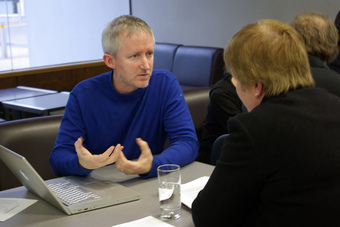
Conducting Your Interview
Be respectful and practice active listening to get the most out of your interview time.
Avoid Leading Questions
Leading questions are questions that suggest or imply a particular answer. While they are often asked innocently, they risk of altering the validity of the responses obtained as they discourage participants from using their own language to express their sentiments. It is instead preferable that interviewers ask open-ended questions. For example, instead of asking “Did the experience make you feel sad?”, it would be better to ask “How did the experience make you feel?” which suggests no particular feeling.
Don’t Interrupt
Participants should feel comfortable and respected throughout the entire interview—thus interviewers should avoid interrupting participants whenever possible. While participants may digress in their responses and while the interviewer may lose interest in what they are saying at one point or another it is critical that they be tactful in their efforts to keep the participant on track and to return to the subject matter in question.
8.4.3: Interview Followup
Content analysis is an essential part of the follow-up, in order to summarize who said what and when.
Learning Objective
Explain how the different interview methods influence content analysis during follow-up
Key Points
- If you have interviewed synchronously one or two experts in person, telephone, or video conference, then you should listen to the recording of the interview and mark points of interest.
- If you have conducted an online synchronous interview using chat, make sure that you have actually activated the archive feature so that you have a recorded transcript of the chat and are able to review each of the questions and responses at a later time.
- If you conducted an online asynchronous interview, you may have a large sample of geographically dispersed respondents. You will need to summarize the content or tabulate the ratings if you used rating scales for the interview questions.
- Once you have completed your content analysis, you will want to consider how to cite or credit the source(s) of the “personal communication” in order to indicate the person, the date, and the type of interview or manner of data collection.
Key Term
- content analysis
-
A methodology in the social sciences for studying the content of communication. Harold Lasswell formulated the core questions of content analysis: “Who says what, to whom, why, to what extent and with what effect? “
Content Analysis is Essential Follow-up
Content analysis is an essential part of the follow-up to any type of interview. You want to summarize or describe the responses and associate them with the source or group of sources, who were the sample of people who responded. You want to summarize who said what, and when. If have engaged in a one-on-one in-person interview, the you will want to use your best informational listening and note-taking skills to capture the content of what was said. If you used an online synchronous or asynchronous interview method, you will already have a transcript or archive of the content, but will need to reliably summarize the responses to your interview questions. The different methods of interviewing will require different methods of follow-up to capture the content and prepare it for use.
In-person Interview
If you have interviewed synchronously one or two experts in person, telephone, or video conference, then you will want to listen to the recording of the interview and mark points of interest . You can either take notes, transcribe relevant answers, or mark with a time stamp the location of important content that relates to your topic for replay or review later.

In-person Interview
Record the interview for playback and analysis.
Online Synchronous Interview
Online synchronous interviews use simple text chat functions that can be recorded or archived for later analysis. If you have conducted an online synchronous interview using chat, make sure you have actually activated the archive feature so that you have a recorded transcript of the chat and are able to review each of the questions and responses at a later time. Since you can chat interview with a number of people about your topic, you may eventually want to summarize and analyze the data for patterns in the responses.
Online Asynchronous Interview
An asynchronous online interview is one where the researcher and the researched do not need to be online at the same time. Typically these interviews will use email, but other technologies might also be employed.
If you conducted an online interview asynchronously, you may have a large sample of geographically dispersed respondents. You will need to summarize the content or tabulate the ratings if you used rating scales for the interview questions.
If you asked closed questions, you can tabulate the frequency of responses in the different categories. However, if you asked more open-ended questions, you will find it useful to code the content of the interviews with some system so that you can group the responses into meaningful categories in order to summarize the results.
Citing the Interview
Once you have completed your content analysis, you will want to consider how to cite or credit the source(s) of the respondents. Since the results of your interview are usually not published, they will be considered “personal communication. ” Generally, you will indicate the person, date, and manner of data collection. Here are some examples:
Personal Interview face to face—Expert , A. (2013, May 2) Personal Interview.
Personal interview by telephone or chat—Expert, A (2013, May 3) Telephone (chat) Interview.
Personal interview by email—Expert, A. ( 2013, May 4) Email Interview.
Chapter 7: Analyzing the Audience
7.1: The Importance of Audience Analysis
7.1.1: The Benefits of Understanding Your Audience
The more you know and understand about the background and needs of your audience, the better you can prepare your speech.
Learning Objective
Explain why it is important to understand your audience prior to delivering a speech
Key Points
- Knowing your audience—their general age, gender, education level, religion, language, culture, and group membership—is the single most important aspect of developing your speech.
- Analyzing your audience will help you discover information that you can use to build common ground between you and the members of your audience.
- A key characteristic in public speaking situations is the unequal distribution of speaking time between the speaker and the audience. This means that the speaker talks more and the audience listens, often without asking questions or responding with any feedback.
Key Terms
- Audience-centered
-
Tailored to an audience. When preparing a message, the speaker analyzes the audience in order to adapt the content and language usage to the level of the listeners.
- audience
-
One or more people within hearing range of some message; for example, a group of people listening to a performance or speech; the crowd attending a stage performance.
- audience analysis
-
A study of the pertinent elements defining the makeup and characteristics of an audience.
Benefits of Understanding Audiences
When you are speaking, you want listeners to understand and respond favorably to what you are saying. An audience is one or more people who come together to listen to the speaker. Audience members may be face to face with the speaker or they may be connected by communication technology such as computers or other media. The audience may be small and private or it may be large and public. A key characteristic of public speaking situations is the unequal distribution of speaking time between speaker and audience. As an example, the speaker usually talks more while the audience listens, often without asking questions or responding with any feedback. In some situations, the audience may ask questions or respond overtly by clapping or making comments.

Understanding the Audience
It’s important to understand the audience and generate a clear message before giving a speech.
Audience-Centered Approach to Speaking
Since there is usually limited communication between the speaker and the audience, there is limited opportunity to go back to explain your meaning either during the speech or afterward. When planning a speech, it is important to know about the audience and to adapt the message to the audience. You want to prepare an audience-centered speech, a speech with a focus on the audience.
In public speaking, you are speaking to and for your audience; thus, understanding the audience is a major part of the speech-making process. In audience-centered speaking, getting to know your target audience is one of the most important tasks that you face. You want to learn about the major demographics of the audience, such as general age, gender, education, religion, and culture, as well as to what groups the audience members belong. Additionally, learning about the values, attitudes, and beliefs of the members of your audience will allow you to anticipate and plan your message.
Finding Common Ground by Taking Perspective
You want to analyze your audience prior to your speech so that during the speech you can create a link between you, the speaker, and the audience. You want to be able to figuratively step inside the minds of audience members to understand the world from their perspectives. Through this process, you can find common ground with your audience, which allows you to align your message with what the audience already knows or believes.
Gathering and Interpreting Information
Audience analysis involves gathering and interpreting information about the recipients of oral, written, or visual communication. There are very simple methods for conducting an audience analysis, such as interviewing a small group about its knowledge or attitudes or using more involved methods of analyzing demographic studies of relevant segments of the population. You may also find it useful to look at sociological studies of different age groups or cultural groups. You might also use a questionnaire or rating scale to collect data about the basic demographic information and opinions of your target audience. These examples do not form an all-inclusive list of methods to analyze your audience, but they can help you obtain a general understanding of how you can learn about your audience. After considering all the known factors, a profile of the intended audience can be created, allowing you to speak in a manner that is understood by the intended audience.
Practical Benefits for the Speaker
Understanding who makes up your target audience will allow you to carefully plan your message and adapt what you say to the level of understanding and background of the listeners. Two practical benefits of conducting an audience analysis are (1) to prevent you from saying the wrong thing, such as telling a joke which offends, and (2) to help you speak to your audience in a language they understand about things that interest them. Your speech will be more successful if you can create a message that informs and engages your audience.
7.1.2: What to Look For
Analyze the audience to find the mix of ages, genders, sexual orientations, educational levels, religions, cultures, ethnicities, and races.
Learning Objective
Examine your audience based on demographics
Key Points
- A speaker should look at his or her own values, beliefs, attitudes, and biases that may influence his or her perception of others.
- Guard against egocentrism. A speaker must not regard his or her own opinions or interests as being the most important or valid.
- Look at others to understand their background, attitudes, and beliefs.
- Focus on audience demographics such as age, gender, sexual orientation, education, religion, and other relevant population characteristics to analyze the audience.
- The depth of the audience analysis depends of the size of the intended audience and the method of delivery.
Key Terms
- egocentrism
-
Preoccupation with one’s own internal world; the belief that one’s own opinions or interests are the most important or valid.
- demographics
-
The characteristics of population such as age, gender, sexual orientation, occupation, education; classification of the characteristics of the people.
Look Inward to Uncover Blinders
A public speaker should turn her mental magnifying glass inward to examine the values, beliefs, attitudes, and biases that may influence her perception of others. The speaker should use this mental picture to look at the audience and view the world from the audience’s perspective. By looking at the audience, the speaker understands their reality.

Magnifying Glass
Speakers should use a metaphorical magnifying glass to examine their values, beliefs, and attitudes.
When the speaker views the audience only through her mental perception, she is likely to engage in egocentrism. Egocentrism is characterized by the preoccupation with one’s own internal world. Egocentrics regard themselves and their own opinions or interests as being the most important or valid. Egocentric people are unable to fully understand or cope with other people’s opinions and a reality that is different from what they are ready to accept.
Understanding Audience Background, Attitudes, and Beliefs
Public speakers must look at who their audience is, their background, attitudes, and beliefs. The speaker should attempt to reach the most accurate and effective analysis of her audience within a reasonable amount of time. For example, speakers can assess the demographics of her audience. Demographics are detailed accounts of human population characteristics and usually rendered as statistical population segments.
For an analysis of audience demographics for a speech, focus on the same characteristics studied in sociology. Audiences and populations comprise groups of people represented by different age groups that:
- Are of the same or mixed genders
- Have experienced the same events
- Have the same or different sexual orientation
- Have different educational attainment
- Participate in different religions
- Represent different cultures, ethnicities, or races
Speakers assess the audience’s attitude – a positive or negative evaluation of people, objects, event, activities, or ideas – toward a specific topic or purpose. The attitudes of the audience may vary from extremely negative to extremely positive, or completely ambivalent. By examining the preexisting beliefs of the audience regarding the speech’s general topic or particular purpose, speakers have the ability to persuade the audience members to buy into the speaker’s argument. This can also help with speech preparation.
Tips for the Speaker
The depth of the audience analysis depends of the size of the intended audience and method of delivery. Speakers use different methods to become familiar with the background, attitudes, and beliefs of audiences in different environments and using various mediums (e.g., videoconferencing, phone, etc). For a small audience, the speaker can simply speak with them in a physical environment. However, the speaker is addressing a larger audience or speaking via teleconferencing or webcasting tools, it may be useful to collect data via surveys or questionnaires.
7.1.3: What to Do with Your Knowledge
Use knowledge about your audience to step into their minds, create an imaginary scenario, and test your ideas.
Learning Objective
Identify with your audience by adopting their perspective
Key Points
- A successful speaker is able to step outside her own perceptual framework to understand the world as it is perceived by members of her audience.
- The speaker engages in a process of first encoding his or her ideas from thoughts into words, then forming a message to be delivered to a group of listeners, or audience. The audience members attempt to decode what the speaker is saying so that they can understand it.
- The better the speaker knows the members of the audience beforehand, the better the speaker can encode a message in a way that the audience can decode successfully.
- One of the most useful strategies for adapting your topic and message to your audience is to use the process of identification to find common ground with them.
- You can use your analysis to create a theoretical, imagined audience of individuals from the diverse backgrounds you have discovered in your audience analysis. Then you can decide whether or not the content will appeal to individuals within that audience.
Key Terms
- Decode
-
to translate the sender’s spoken idea/message into something the receiver understands by using his or her knowledge of language based on personal experience
- encode
-
to turn one’s ideas into spoken language in order to transmit them to listeners
- message
-
the verbal and nonverbal components of language, sent to the receiver by the sender, that convey an idea
Identifying with the listeners
Step in to the minds of your listeners and see if you can identify with them. A successful speaker engages in perspective-taking. While preparing her speech, the speaker steps outside her own perceptual framework to understand the world as it is perceived by members of the audience. When the speaker takes an audience-centered approach to speech preparation, she focuses on the audience and how it will respond to what is being said. In essence, the speaker wants to mentally adopt the perspective of members of the audience in order to see the world as the audience members see it.
Encoding and Decoding
The speaker engages a process of encoding his or her ideas from thoughts into words, and of forming a message which is then delivered to an audience. The audience members then attempt to decode what the speaker is saying so that they can understand it. To better imagine this process, consider the example of encoding and decoding as it applies to the idea of a tree. I know that my audience is in New England and that they are familiar with oak trees. I use the word tree to encode my idea, and because my audience has experienced similar trees, they decode the word tree in the way that I intended. However, I may be thinking about a tree (a palm tree) that is in Hawaii, where I used to live, when I use the word tree to encode my idea. Unfortunately, when my audience decodes my word now, they are still thinking about the oak tree and will not see my palm tree. The audience no longer shares my perspective of the world or my experience with trees.
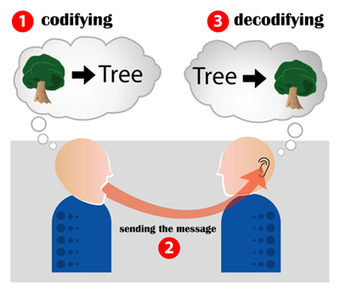
Encoding Communication
One speaker encodes a message and sends the message. The listener hears the message and decodes it.
Finding Common Ground
The more you find out about your audience, the more you can adapt your message to the interests, values, beliefs, and language level of the audience. Once you collect data about your audience, you are ready to summarize your findings and select the language and structure that is best suited to your particular audience. You are on a journey to find common ground in order to identify with your audience. One of the most useful strategies for adapting your topic and message to your audience is to use the process of identification . What do you and your audience have in common? And, conversely, how are you different? What ideas or examples in your speech can your audience identify with?
Creating a Theoretical, Imagined Audience
Create a theoretical, imagined situation to test your view of an audience for practice. You can use your analysis to create what is called a “theoretical, universal audience. ” The universal audience is an imagined audience that serves as a test for the speaker. Imagine in your mind a composite audience that contains individuals from the diverse backgrounds you have discovered in your audience analysis. Next, decide whether or not the content of your speech would appeal to individuals within that audience. What words or examples will the audience understand and what will they not understand? What terms about your subject will you need to define or explain for this audience? How different are the values and opinions you want your audience to accept from the present attitudes and beliefs they may hold?
Tips for the Speaker
In summary, use your knowledge of the audience to adapt your speech accordingly. Adopt the perspective of the audience in order to identify with them, and test out your ideas with an imagined audience composed of people with the background you have discovered through your research.
7.2: Demographic Factors to Consider
7.2.1: Age
Since individuals of the same generation often share similar values, beliefs, and attitudes, age is an important variable to consider.
Learning Objective
Recognize characteristics of different generations
Key Points
- Individuals who grow up at the same time are a generation and often share many of the same experiences as others of the same age group. They exhibit a set of shared values, beliefs, and attitudes that are important to consider when preparing a speech.
- When you speak to an audience with members of different ages, you are likely to experience a generation gap.
- As new generations seek to define themselves as something apart from the old, they adopt new lingo and slang, allowing a generation to create a sense of division from the previous one.
- It is important to become aware of one’s own biases in order to avoid ageism in your speeches.
- The use of handheld communications technology has created a wide gap between older and younger generations.
Key Terms
- Generation
-
Cohorts of people who were born in the same date range and share similar cultural experience.
- ageism
-
Ageism, or age discrimination is stereotyping and discriminating against individuals or groups because of their age. It is a set of beliefs, attitudes, norms, and values used to justify age based prejudice, discrimination, and subordination.
Age is an Important Audience Characteristic
Age is an important variable to consider when analyzing your target audience. Individuals who grow up at the same time are called cultural generations. They often share many of the same experiences as others of the same age group. An outcome of a cultural generation is a set of shared values, beliefs, and attitudes that are important to consider when preparing a speech. All four of the women in the figure are from different generations and will have had different experiences. Of which generation do you think they are a member? To which generation do you belong?

Understanding Different Generations
Each of these four generations has a different set of values, beliefs, and attitudes.
Generations
Consider the generations living today and some of their associated characteristics:
- The Baby Boom generation were born after World War II, from 1946 to 1964. In general, baby boomers are associated with a rejection or redefinition of traditional values. Boomers tended to think of themselves as a special generation, very different from those that had come before them.
- Generation X is the generation defined as those born after the baby boom ended, from 1965 to 1981.Change is more the rule for the people of Generation X than the exception. Unlike their parents, who challenged leaders with an intent to replace them, Gen Xers tend to ignore leaders and work for more long-term institutional and systematic change through economic, media, and consumer actions
- Millennials, also known as Generation Y, describes the generation following Generation X, from 1981 to 1999. One segment of this age group has often been called the “eighties babies” generation. Millennials are generally marked by an increased use and familiarity with communication, media, and digital technologies. In most parts of the world its upbringing was marked by an increase in a neoliberal approach to politics and economics.
- Generation Z, also known as “Digital Natives,” is a term that reflects the pluralistic and fragmented society of those with birth dates between 1997 and 2012. Generation Z is highly connected, as many members of this generation have had lifelong use of communications nd media technologies. No longer limited to the home computer, the Internet is now increasingly carried in their pockets on mobile Internet devices.
- Generation AO, the Always-On Generation (or Gen AO), describes people born between the early 2000s and the 2020s whose lives have been influenced by connectivity and easy access to people and knowledge through the Internet. They are nimble, quick-acting multi-taskers who count on the Internet as their external brain. Experts predict Gen AO will exhibit a thirst for instant gratification and quick fixes, a loss of patience, and a lack of deep-thinking ability.
Generation Gaps and Trends
When you speak to an audience with members of different ages, you are likely to experience a generation gap. Each generation sets its own trends and has its own cultural impact.
- Language Use: Generations can be distinguished by the differences in their language use. The generation gap has created a parallel gap in language that can be difficult to communicate across. As new generations seek to define themselves as something apart from the old, they adopt new lingo and slang, allowing a generation to create a sense of division from the previous one.
- Slang: Slang is an ever-changing set of colloquial words and phrases that speakers use to establish or reinforce social identity or cohesiveness within a group or society at large. As each successive generation of society struggles to establish its own unique identity among its predecessors, generational gaps provide a large influence over the continual change and adaptation of slang.
- Technological Influences: Every generation develops new slang, but with the development of technology, understanding gaps have widened between the older and younger generations. The term “communication skills,” for example, might mean formal writing and speaking abilities to an older worker. But it might mean e-mail and instant messaging to a 20-something. Cell phones, texting, tweeting and the like have encouraged younger users to create their own inventive, quirky, and very private written language. They are more connected than ever, but also far more independent.
7.2.2: Gender
A speaker has an opportunity to address years of masculine and feminine gender role conditioning through the use of inclusive language.
Learning Objective
List the dangers of using gendered language in your speeches
Key Points
- It is important to remember that since birth, we have been conditioned to make the distinction between men and women, masculinity and femininity.
- Advertisers create “gendered environments” in everything from children’s toys to motor vehicles.
- Gender neutral language and gender inclusive language aims to eliminate (or neutralize) reference to gender in terms that describe people.
- One must guard against gender discrimination and stereotyping members of the audience.
Key Terms
- transgender
-
More narrowly, having a gender (identity) which is different from the sex one was assigned at birth, e.g. being assigned male at birth but having a female gender or vice versa; or, pertaining to such people. More broadly, not identifying with culturally conventional gender roles and categories of male or female; having changed gender identity from male to female or female to male, or identifying with elements of both, or having some other gender identity; or, pertaining to such people.
- gender
-
The sociocultural phenomenon of dividing people into the categories of “male” and “female,” with each having associated clothing, roles, stereotypes, etc.
Gender and Genderism
It is important to remember that since birth, we have been conditioned to make the distinction between men and women, masculinity and femininity. Gender is the perceived or projected (self-identified) masculinity or femininity of a person. Societies tend to have binary gender systems in which everyone is categorized as male or female, but this is not universal. Some societies include a third gender role, referred to as transgender, which combined both male and female.
Although there are almost as many males as females in the U.S. population, not all people conform to the their birth sex. Genderism is the cultural belief that gender is binary, or that there are, or should be, only two genders—male and female—and that the aspects of one’s gender are inherently linked to the sex in which they were assigned at birth. It reinforces negative attitudes, bias and discrimination toward people who display expressions of gender variance or nonconformity and/or whose gender identity is incongruent with their birth sex.
Advertisers do,however, create “gendered environments” in everything from children’s toys to motor vehicles . For example, early on children are exposed to toy commercials that are set out to target a specific gender. As a result, western society is conditioned to believe that dolls and houses are for little girls because they represent the idea that females are to be fertile and nurturing. Little boys are conditioned to believe that they can only play with toys that will define their masculinity, such as cars and toy weapons. Much like the masculine ideal, toys for little boys often include cars, action figures , and sporting goods, all which fulfill the idea of a conquest. These items and the advertisements redefine the gender role ideal that men are active, strong, and courageous. On the other hand, little girls are raised to believe that their roles is to care for the family. Typically, little girls toys include baby dolls and play houses. Since the idea of identification carries immense weight in the targeting of specific audiences, advertisers begin promoting the concept of gendered environments early on beginning with children’s toys. However, as people grow older the gender roles are only made more evident and are further perpetuated in advertising that is targeted towards adults.
What can the speaker do?
Use inoffensive language in your speeches.
Cognitive psychologist and linguistics suggest that word choice has significant framing effects on the perceptions, memories, and attitudes of speakers and listeners. When one uses less inclusive or stereotypical language, the following can occur:
- The rights, opportunities, and freedoms of certain people are restricted because they are reduced to stereotypes.
- Stereotyping is mostly implicit, unconscious, and facilitated by the availability of pejorative labels and terms
- Rendering the labels and terms socially unacceptable, people then must consciously think about how they describe someone unlike themselves
- When labeling is a conscious activity, the described person’s individual merits become apparent, rather than their stereotype.
Use Gender Neutral Language in your speeches.
Gender neutral language and gender inclusive language aims to eliminate (or neutralize) reference to gender in terms that describe people. For example, the words fireman, stewardess, and, arguably, chairman, are gender specific; the corresponding gender neutral terms are firefighter, flight attendant and chairperson (or chair). The pronoun “he” may be replaced with “he or she,” “s/he,” or “they” when the gender of the person referred to is unknown. Other gender specific terms, such as actor and actress may be replaced by the originally male term “actor” used for either gender.

Gender-Neutral Language
Gender-neutral language replaces “he” and “she” with “he or she,” “s/he,” or “they.”
Gender-neutral language should not be confused with genderless language, which refers to languages without grammatical gender. It has become common in academic and governmental settings to rely on gender neutral language to convey inclusion of all sexes or genders (gender inclusive language). Various forms of gender neutral language are becoming more common, but the underlying gender roles are still evident in our society. We still have generations of previously defined gender roles and associated language use to conquer.
Tips for the Speaker
One must guard against gender discrimination and stereotyping members of the audience. It is not enough to be politically correct by using inclusive, neutral terminology; one can also explore more fully the gender conditioning that has occurred throughout ones lifetime from childhood to adulthood in order to confront genderism.
7.2.3: Sexual Orientation
The sexual orientation of your audience members should be taken into account when giving a speech.
Learning Objective
Define the three main classifications of sexual orientation: bisexuality, heterosexuality, and homosexuality
Key Points
- There are three main classifications of sexual orientation: bisexuality, heterosexuality and homosexuality, all a part of the heterosexual–homosexual continuum.
- Most sexual orientation specialists follow the general conclusion of Alfred Kinsey regarding the sexual continuum, according to which a minority of humans are exclusively heterosexual or homosexual, and that the majority are bisexual.
- Sexual orientation, in most individuals, is shaped at an early age and is not voluntarily changeable.
- The speaker should become aware of and compensate for the bias of heteronormativity, which holds that people fall into distinct and complementary genders (man and woman) with natural roles in life.
Key Terms
- heteronormativity
-
The view that all human beings are either male or female, both in sex and in gender, and that sexual and romantic thoughts and relations are normal only when between people of different sexes.
- heterosexism
-
A system of attitudes, bias, and discrimination in favor of opposite-sex sexuality and relationships. It can include the presumption that everyone is heterosexual or that opposite-sex attractions and relationships are the only norm and therefore superior.
Sexual Orientation
On a Continuum from Hetrosexual to Homosexual
When taking into account the sexual orientation of your audience it is useful to consider it on a continuum. Your audience could be made up of members anywhere along the continuum. There are three main classifications of sexual orientation: heterosexuality, bisexuality, and homosexuality.
Hetrosexuality
Heterosexuality is romantic or sexual attraction or behavior between persons of the opposite sex. As a sexual orientation, heterosexuality refers to “an enduring pattern of or disposition to experience sexual, affectionate, physical, or romantic attractions to persons of the opposite sex. ” It also refers to “an individual’s sense of personal and social identity based on those attractions, behaviors expressing them, and membership in a community of others who share them. ” The term is usually applied to humans, but is also observed in all mammals.
Homosexuality
The term “gay” in the West is not recognized by all men who have sex with men (MSM) as known in the rest of the world. “Gay” is generally used to describe a sexual orientation, while “MSM” describes a behavior. Also, men in Africa and Latin America engage in sexual relationships with other men while still referring to themselves as heterosexual, which is known as being “on the down-low. ” The same applies to men who engage in homosexual activities in the military, gender segregated schools and universities, or prison, as most of them do not consider themselves as gay but still engage sexually with members of their own sex in order to fulfill their sexual desires.
Correspondingly, “lesbian” as a concept, used to differentiate women with a shared sexual orientation, is a 20th-century construct. Throughout history, women have not had the freedom or independence to pursue homosexual relationships as men have, but neither have they met the harsh punishment in some societies as homosexual men. Instead, lesbian relationships have often been regarded as harmless and incomparable to heterosexual ones unless the participants attempt to assert privileges traditionally enjoyed by men. Women who have sex with women (WSW) is a term used to identify women who engage in sexual activities with other women, whether or not they identify themselves as lesbian or bisexual. The term is often used in medical literature to describe such women as a group for clinical study, without needing to consider the issues of sexual self-identity.
Bisexuality
A third orientation is bisexuality. Bisexuality is a romantic or sexual attraction or behavior toward both males and females. The term is especially used in the context of human sexual attraction to denote romantic or sexual feelings toward men and women. People who have a distinct but not exclusive sexual preference for one sex over the other may identify themselves as bisexual. Bisexuality has been observed in various human societies and elsewhere in the animal kingdom throughout recorded history. The term bisexuality, like the terms hetero- and homosexuality, was coined in the 19th century.
Most sexual orientation specialists follow the general conclusion of Alfred Kinsey regarding the sexual continuum, according to which a minority of humans are exclusively heterosexual or homosexual, and that the majority are bisexual. The consensus of psychologists is that sexual orientation, in most individuals, is shaped at an early age and is not voluntarily changeable.
The rainbow colors and the rainbow flag , once only used by the LGBTQ community in major cities of the West, is now appearing around the world to show solidarity with or acceptance of the LGBTQ community.

Rainbow Flag
A rainbow flag flying above New York.
Become Aware of Bias—Heteronormativity and Heterosexism
Speakers should be aware of the bias in the audience and in Western society in general toward heteronormativity and heterosexism. One common mistake that speakers make is assuming that the audience is just like them with regards to this aspect of identity.
Heteronormativity is the body of lifestyle norms that holds that people fall into distinct and complementary genders (man and woman) with natural roles in life. It also holds that heterosexuality is the normal sexual orientation, and that sexual and marital relations are most (or only) fitting between a man and a woman. A “heteronormative” view is one that involves alignment of biological sex, sexuality, gender identity, and gender roles.
Heterosexism is a system of attitudes, bias, and discrimination in favor of opposite-sex sexuality and relationships. It can include the presumption that everyone is heterosexual or that opposite-sex attractions and relationships are the only norm and therefore superior. Nonetheless, heterosexism as discrimination ranks gay men, lesbians, bisexuals, and other sexual minorities as second-class citizens with regard to various legal and civil rights, economic opportunities, and social equality in the majority of the world’s jurisdictions and societies.
Tips for the Speaker
Consider how to combat heterosexism in your audience analysis and speech making. For example, rather than referring to or asking in an interview if one has a boyfriend or girlfriend, you can ask if the person is seeing someone or has a significant relationship. One can also use the term “partners” rather than the more heteronormative “husband” or “wife. ” And remember that families come in all different kinds of formations, not just biological male and female birth parents with their child.
Finally, there may be many speech topics where the sexual orientation of the audience will not be an important consideration. However, there are some areas which are important to LGBTQ people, such as laws around the world that criminalize homosexual behavior, recognition of relationships, same-sex marriage, LGBTQ adoption, immigration issues, violence and hate crimes, and legal aspects of transsexualism.
7.2.4: Education
Consider both the formal education and the self-directed learning of the members of your audience to adapt your speech content.
Learning Objective
Demonstrate how knowing your audience’s knowledge of your topic can inform your speech
Key Points
- As your prepare your speech, ask yourself what do the members of the audience already know about the topic.
- Do not assume that your audience will know something just because you do.
- Look for audience cues (i.e. the questions they ask) to identify knowledge gaps.
- Remember it is important to consider not only the formal education but the self-directed learning of the members of your audience in order to gear you speech to right level of understanding.
Key Terms
- knowledge
-
Familiarity or understanding of a particular skill, branch of learning, etc.
- education
-
Facts, skills, and ideas that have been learned, either formally or informally.
Introduction
As you prepare your speech, first ask yourself what the members of the audience already know about the topic. What is their level of knowledge and are they able to learn more? Remember, it is important to consider not only the formal education but the self-directed learning of audience members in order to gear you speech to the right level of understanding.
To see the importance, here is an example provided by Lewis.
Lewis’ Story
I enjoy learning new things and I love sharing what I know. Or, more accurately, I love sharing what I think I know. If I can learn something while I’m sharing, that’s a total bonus. A totally uneventful presentation can be relaxing but I kind of like to keep it edgy, learn something from the process. Not so much a projector exploding right before I present but things that make me stretch. Being a good presenter is a personal goal for me. Part of creating a good presentation is knowing your audience and aiming the material right between their eyes.
I was giving a presentation recently. It was a presentation for work. I had given a general purpose “What is a data mart? ” presentation last year and this was Part Two, digging into our financial transactions data mart. I was specifically going over the mart’s facts and dimensions. One of the requests for the presentation was to explain how to efficiently query the data and an overview of why our data mart (specifically this star schema) might be faster than other styles of design.
I started with a refresher: what is a fact, what is a dimension; and then segued into the facts and dimensions specific to our mart. I spoke a little bit about what we had and why we chose those particular entities. I then moved onto the performance benefits. I spent quite a bit of time explaining bitmap indexes and star transformations. I really thought that was where most of my questions would be. The fascinating thing to me is where the discussion ended up. It wasn’t a failure to understand bitmaps (I credit my awesome diagram for that) nor was it anything confusing about star transformations.
On a couple of slides I had mentioned “query rewrite” in relation to tuning (using aggregates) and star transformations. What I learned is that something that has become second nature to me might not be to many other people. The fact that Oracle would rewrite my query at runtime used to really scare me. After seeing the magic (which is what it felt like at first), I got used to it and have come to expect it (in the right situations).
But my audience was sitting there wondering, “What does query rewrite mean? ” Some thought that it meant the developer did not write it correctly the first time so Oracle was recommending that it be rewritten as a star transformation (or to go against a materialized view instead of a base table).
That is such an obvious misconception that I can’t believe I didn’t even anticipate it at all. The questions and comments I got on that drove a nice discussion. One of the questions was, “Would someone be monitoring the rewrites so that it could be done better next time? ” It took me a while to understand the question; I literally was not understanding the disconnect for a few minutes. It’s a good question, based on the audience’s understanding at the time that I gave them more information.
The problem was not with the audience, it was my failure to make sure that my presentation gave a basic explanation of the terms I would be using. I learning that it is important to “know thy audience. ” Data marts were new to most of this group. That’s why I took the time to define a fact, a dimension, bitmap indexes, star schemas, star joins, etc. Query rewrite (basic, advanced) is such a fundamental part of what I was explaining, I totally glossed over it. It’s like explaining why the sidewalk is hard but not giving a definition of concrete.
I finally explained that Oracle was rewriting it based on data (statistics) it had at runtime, on knowledge of the structures in the database, and on algorithms that know how to optimize very certain types of queries to get the best throughput from them.
What Lewis Learned

Education
The audience’s education goes beyond whether or not they have a degree or what that degree might be in.
It reminded me to remember that I need to look at my presentation from the view of someone sitting in the audience, not the view on the
podium
. This is a lesson for you, too. Knowing what your audience knows is key to giving a good presentation.
7.2.5: Religion
Understanding the religions in your audience will help you relate to the members and avoid excluding members of differing religions.
Learning Objective
Identify the world’s religions and speak with sensitivity to religious beliefs
Key Points
- Individuals who practice a religion have belief systems and worldviews that relate humanity to spirituality and moral values.
- Since the First Amendment of the U.S. Constitution allows the existence of religious pluralism in the U.S., you are likely to encounter audience members of different religions.
- There are roughly 4,200 religions in the world. The five largest religious groups by population are Christianity, Islam, Buddhism, Hinduism and Chinese folk religion.
- Understanding the religions in your audience will help you relate to members of the audience more directly and avoid excluding members who may not observe the same practices as you do.
Key Terms
- religion
-
Religion is a collection of belief systems, cultural systems, and worldviews that relate humanity to spirituality and, sometimes, to moral values.
- irreligious
-
Irreligious describes an absence of any religion; where as anti-religion describes an active opposition or aversion toward religions in general.
- religious pluralism
-
The peaceful coexistence of multiple religions in a community
Example
- Symbols representing some world religions, from left to right: row 1: Christianity, Judaism, Hinduism row 2: Islam, Buddhism, Shinto row 3: Sikhism, Bahá’í Faith, Jainism
Religion
Individuals who practice a religion have belief systems and worldviews that relate humanity to spirituality and moral values. According to some estimates, there are roughly 4,200 religions in the world. The members of your audience could be followers of any of those religions.
Religions may involve the worship of a god or gods or a spiritual force. Many religions have days of observance, narratives, symbols, traditions, and sacred histories that are intended to give meaning to life or a preferred lifestyle from their ideas about the cosmos and human nature .
The five largest religious groups by population, estimated to account for between 5 and 7 billion people, are Christianity, Islam, Buddhism, Hinduism, and Chinese folk religion.

Religious Symbols
Religious symbols represent different belief systems.
Five largest religions……………………..Adherents in 2000……………………..% of world population
Christianity………………………………………. 2.0 billion……………………………………….. 33%
Islam………………………………………………. 1.2 billion………………………………………. 19.6%
Hinduism………………………………………… 811 million……………………………………… 13.4%
Chinese Folk religion……………………….. 385 million……………………………………….. 6.4%
Buddhism……………………………………….. 360 million……………………………………….. 5.9%
Additionally, there are may be atheist and agnostics in your audience. The terms “atheist” (lack of belief in any gods) and “agnostic” (belief in the unknowability of the existence of gods), though specifically contrary to theistic (e.g. Christian, Jewish, and Muslim) religious teachings, do not by definition mean the opposite of “religious. ” There are religions (including Buddhism and Taoism) that classify some of their followers as agnostic, atheistic, or nontheistic. The true opposite of “religious” is “irreligious. “
Since the First Amendment to the U.S. Constitution guarantees the separation of church and state, the U.S. has no dominant state religion. People with different beliefs are free to practice their religion in the U.S. or to practice no religion.
Tips for the Speaker
Unless you are speaking to a particular religious group, you are likely to encounter audience members from several of the world’s religions in your audience. Understanding the religions in your audience will help you relate better to members of the audience and avoid excluding members who may not observe the same practices as you do. It is important to avoid subtle religious discrimination when speaking to a general audience. Often it will be necessary for you to put aside your own belief system to understand the religion of the members of the audience. Of course, you not required to accept or embrace other religions but simply to be aware of and sensitive to them.
7.2.6: Culture, Ethnicity, and Race
As society becomes more diverse, the speaker will find it useful to learn more about the cultures, races and ethnic groups in each audience.
Learning Objective
Give examples of ethnocentrism and prejudice
Key Points
- The simplest way to think about culture is to think about the distinction between nature (our biology and genetics) and nurture (our environment and surroundings that also shape our identities).
- In terms of race an individual is usually externally classified (meaning someone else makes the classification) but individual may also self-identify with a particular racial group.
- Unlike race, ethnicity is not usually externally assigned by other individuals. The term ethnicity focuses more upon a group’s connection to a perceived shared past and culture.
- The cultural, racial and ethnic makeup of the United States is becoming more diversified and audiences will reflect that diversity as the population continues to shift.
- In order to adapt the message to the audience it is important to become aware of one’s own ethnocentrism and to avoid prejudice and racism.
Key Terms
- ethnicity
-
characteristics of a group of people thought to have common ancestry who share a distinctive culture
- ethnocentrism
-
judging another culture solely by the values and standards of one’s own culture
- race
-
A large group of people distinguished from others on the basis of common physical characteristics, such as skin color or hair type.
Culture, Race and Ethnicity
In addition to considering the attitudes of the audience toward different cultures, races or ethnic groups, it is also important to consider how a diverse group will respond to certain parts of your message . Before considering the role of culture, race and ethnicity in audience analysis it is useful to distinguish among the terms.
Culture
Culture is the non-biological or social aspects of human life; basically anything that is learned by humans is part of culture.
Let’s look at the two avatars shown in to help illustrate the concept of culture.The avatar wearing nothing but shorts comes close to representing nothing but nature. The avatar wearing the colorful vest and pants stands in stark contrast to the other avatar. This second avatar is reflective of a particular culture. Culture is more than the object or behavior. Culture also includes, norms, values, beliefs, or expressive symbols.

Culture
Culture influences many aspect in a person’s life including values, beliefs, and forms of personal expression.
Race and Ethnicity
A race is a human population that is believed to be distinct in some way from other humans based on real or imagined physical differences. An individual is usually externally classified (meaning someone else makes the classification) but individual may also self-identify with a particular racial group.
Ethnicity, while related to race, refers not to physical characteristics but to social traits that are shared by a human population. Some of the social traits often used for ethnic classification include:
- nationality
- tribe
- religious faith
- shared language
- shared culture
- shared traditions
Tips for Speaker-Becoming Aware of Ethnocentrism and Prejudice
In order to adapt the message to the audience it is important to become aware of your own ethnocentrism and to avoid prejudice and racism. When you judge another culture solely by the values and standards of your own culture you miss significant aspects of the other culture of the members of your audience. Racism or racial discrimination operates in a similar way. Racism can refer to any or all of the following beliefs and behaviors:
- race is the primary determinant of human capacities (prejudice or bias)
- a certain race is inherently superior or inferior to others (prejudice or bias)
- individuals should be treated differently according to their racial classification (prejudice or bias)
- actually treating of individuals differently based on their racial classification (discrimination)
In order for the speaker to collect objective knowledge about other cultures, racial or ethnic groups it is important to avoid prejudice. Prejudice involves coming to a judgment on a subject before learning where the preponderance of evidence actually lies. Alternatively, prejudice can refer to the formation of a judgment without direct or actual experience.
When looking at another culture or ethnic group in order to compensate for ethnocentrism as a speaker, try to look at the other group through the eyes of the members of that particular ethnic or cultural group. As our society becomes more diverse, the speaker will find it desirable to put aside ethnocentrism and prejudice to learn more about the cultures, races and ethnic groups that will be an increasing part of the local and global audience.
7.2.7: Group Membership
Audience members who belong to the same group are likely to share values, beliefs, and attitudes with other members of the group.
Learning Objective
Apply your knowledge of your audience’s group affiliation
Key Points
- Foreknowledge of the audience’s affiliations and the associated values, beliefs, and attitudes will help the speaker prepare the message.
- Group members can classify their membership in two categories: primary (family or fraternal organizations) and secondary (clubs, associations, or colleges).
- Generally speaking the longer and more actively one is involved with a group the more likely the member is to share ideas and profess beliefs shared by other group members.
Key Terms
- primary group
-
A small social group whose members share personal and lasting relationships. The family is the most important primary group.
- Secondary group
-
A large group involving formal and institutional relationships. Secondary relationships involve weak emotional ties and little personal knowledge of one another.
Example
- Family is the most important primary group.
Primary and Secondary Group Membership
The members of your audience may be from different groups or they may all be part of the same group. Group membership describes an association with two or more people.
In general, one can look at two types of groups—primary and secondary.
Primary
Primary group membership shapes the attitudes, values, and beliefs of its members; the members are likely to reflect or express those when listening to a speaker.
Audience members who are part of a primary group that is more long lasting will share experiences with the other group members who shape their beliefs, attitudes, and world views. Also, one may have to agree to a set of norms or values which are shared by all members in order to become a member of a group. Some group memberships involved selection by other group members and initiation into the group.
Secondary
Secondary groups, in contrast to primary groups, are large groups involving formal and institutional relationships. Secondary relationships involve weak emotional ties and little personal knowledge of one another. Most secondary groups are short term, beginning and ending without particular significance. They may last for years or may disband after a short time. The formation of primary groups happens within secondary groups.
Primary groups can be present in secondary settings. For example, when you are attending a university you are part of a secondary group at a student activity; while at the university you may form friendships or relationships that will last a lifetime, which would be a primary group .

Different Groups
A primary group of students is broken down into secondary groups based on the color of their t-shirts.
Generally speaking, the longer and more actively one is involved with a group the more likely the member is to share ideas and profess beliefs shared by other group members. For example, members of a college club may share only an interest in a particular sport or activity, whereas members of a fraternity or sorority may be more involved by living together like a family and professing similar attitudes and beliefs.
Tips for Speaker
Foreknowledge of the audience’s affiliations and the associated values, beliefs, and attitudes will help the speaker prepare the message. You may be speaking to members who are all part of the same group, such as an on-campus sobriety or DeMolay; the members of the two groups will have different shared background experiences and beliefs based on their membership in that group.
7.3: Contextual Factors to Consider
7.3.1: Physical Context
Consider physical contexts—traditional face-to-face with co-located audience versus delivery via videoconference to remote audience(s).
Learning Objective
Identify the types of physical context you may encounter and plan your speech accordingly
Key Points
- Consider three possible contexts—traditional speaker face-to-face audience, and computer mediated—speaker with live audience to remote locations(s) and a speaker with no live audience to different locations by video conferencing technology.
- The physical context for the co-located audience is the setting or room where you speak. Ask whether you are indoors or outdoor, the size and arrangement of the seating, the significance of the location and occasion, the time of day for the speech and what equipment is available.
- Checking out the physical context will allow you to adjust your speech and plan so you are not attempting to borrow or move equipment before getting up to speak.
- Speakers may use a videoconferencing system—with video camera or webcam with microphone for input, output through monitor or TV with speakers or headset, internet or digital telephone connection for data transfer and computer for processing—to speak to remote audiences.
- Non-portable videoconferencing is used in large rooms or dedicated conferencing rooms with all required components packaged into an equipment console and portable systems are used for audiences in meeting rooms and for video seminars with webcam, microphone, computer and internet connection.
- With video conferencing delivery the speaker is challenged to maintain eye contact, become familiar with his own image to address appearance consciousness and avoid rapid gestures in consideration of streaming lag time.
Key Term
- co-located
-
To locate or be located at the same site, for two things or groups at same space.
The physical context is the setting where the speech occurs. You can prepare for three different contexts–face to face with co-located audience , a speaker with live audience to remote audiences and a speaker with no live audience to different remote locations by video conferencing technology .

Co-Located Audience
An audience listens to a speaker in an auditorium at the University of Liège.
Physical Context for the Co-Located Audience
The physical context for the co-located audience is the setting or room where you speak. There are a number of questions to consider about the space. Here is a checklist:
- What is the size of the room or other area?
- If outdoors, where is the location, what is the weather, temperature, and noise?
- Is there any significance to the location such as a historic landmark or memorial?
- Is this a special occasion such as holiday celebration or anniversary of an event at the site?
- What is the anticipated size of the audience and the arrangement of seating?
- Will there be a stage, podium or lectern?
- What equipment is available such as microphone, computer, or projection system?
- Will there be an ethernet or wi-fi connection?
- What time of the day will your speech occur, will the audience be awake, or sleepy after eating?
If you are not the only speaker, you want to confirm the order of speaking with the emcee so you know where and when you can get access to any equipment needed for your presentation. Checking out the physical context will allow you to plan so you are not attempting to borrow or move equipment before getting up to speak.
Physical Context for the Combined Co-Located with One or More Secondary Locations
You may find yourself speaking in one primary location with the audio or video of your speech being streamed live to other secondary locations. You will be aware of your primary location but you will not know what is happening in the other locations. When you have a live audience co-located in front of you it will be easier to relate to and respond to the audience and avoid many of the problems associated with delivery by webcam or web conferencing only technology.
Physical Context when Speaking to Remote Locations by Video Conferencing Technology
With video conferencing you deliver a message to two or more locations by computer mediated communication. You may deliver the speech to another location with no interaction or you may engage in two way interaction with the different locations. In order to video conference you will need access to the basic components:

Remote Audience
Rear Adm. J. Kevin Moran, the commander at the Naval Personnel Development Command (NPDC) in Norfolk, Virginia, speaks by video conference to an audience at the Center for Aviation Technical Training (CNATT).
- Video input: video camera or webcam
- Video output: computer monitor, television or projector for the audience
- Audio input for the speaker: microphones, CD/DVD player, cassette player, or any other source of PreAmp audio outlet
- Audio output for the audience: usually loudspeakers connected with the display monitor or TV
- Data transfer: analog or digital telephone network, LAN or Internet
- Computer: a data processing unit that ties together the other components, does the compressing and decompressing, and initiates and maintains the data linkage via the network.
There are basically two kinds of videoconferencing systems which you may encounter:
- Non-portable are used for large rooms or small dedicated conferencing rooms. They have all required components packaged into a single equipment console.
- Portable systems are available for use with small audiences in small meeting rooms and for video seminars. You can create your own simple system with webcam, microphone, headset or speakers. You can now deliver the message using a broadband internet connection to a small group audience at minimal or no cost.
Since you do not have a live audience in front of you while speaking in this context, there are several issues to address:
- Eye contact: Eye contact plays a large role in large and small group communication. Many video conferencing systems give the impression that the speaker is avoiding eye contact. You may find it necessary to practice with the camera and study how eye contact will be perceived by the remote audience and adjust accordingly.
- Appearance consciousness: A second psychological problem with videoconferencing is being on camera, with the video stream possibly even being recorded. The anxiety may be similar to stage fright but there is a difference since you really do not know how the remote listeners are reacting to you. Check out how you appear by recording a sample of your speech and viewing it to adjust to being “on camera. “
- Signal latency: An increased latency (time lag) larger than about 150–300 ms becomes noticeable and is soon observed as unnatural and distracting. With high bandwidth systems, the latency problem is minimized but you are still well advised to minimize quick moves and rapid gestures while speaking, since some audience members may have slower connections.
7.3.2: Overall Psychology of Your Audience: Values, Beliefs, Attitudes, and Needs
Use psychographics of values, needs, attitudes, and beliefs to develop an audience profile and to tailor the speech’s specific message.
Learning Objective
Examine your audience’s values, needs, attitudes, and beliefs to cater your speech to their particular profile
Key Points
- Look at the psychology of the individual audience members to determine how they might respond as a group to the speech’s ideas.
- The overall psychographic of the audience includes the current state of values, beliefs, attitudes, and needs, and is not concerned with how the person developed them.
- Use knowledge of the values, attitudes, beliefs, and needs of members of your audience to develop and describe a psychographic profile in order to tailor a message specifically to the audience.
Key Term
- psychographics
-
The study of personality, values, attitudes, interests, and lifestyles; not to be confused with demographic variables such as age and gender
Psychographics of a Given Audience
The demographics of the audience gives the speaker one type of picture based on variables such as age, gender, sexual orientation, religion, culture, race, and ethnicity; however, there is another equally important picture based on the overall psychological make-up of the audience, or the psychographics of the audience. Psychographics can be used to describe and develop a profile of the individuals in a given audience. Speakers can also use psychographics to select an audience that meets a certain profile, and then tailor a message specifically to that profile.
Psychology is commonly defined as the science of behavior and mental processes. The speaker can look at the psychology of the individual audience members to determine how they might respond as a group to his or her ideas. The speaker wants to look at the current state of values, beliefs, attitudes, and needs, and not consider how the person developed them.
What is the current disposition of the audience toward the speech’s topic and purpose? If the speaker is attempting to persuade the audience to accept a particular idea or take an action, it is important to understand the starting point. What are the dominant values, beliefs, attitudes, and needs of the audience? The speaker must know how to use that knowledge to tailor the speech to the audience. Consider values, beliefs, attitudes, and needs as factors in the psychological make-up of the audience.
Values
Values can be defined as broad preferences concerning appropriate courses of action or outcomes. As such, values reflect a person’s sense of right and wrong or what “ought” to be. “Equal rights for all”, “Excellence deserves admiration”, and “People should be treated with respect and dignity” are statements of values. Values tend to influence attitudes and behavior. For example, if someone who values equal rights for all goes to work for an organization that treats its managers much better than it does its workers, he or she may form the attitude that the company is an unfair place to work; consequently, this person may not produce well or may perhaps leave the company. It is likely that if the company had a more egalitarian policy, his or her attitude and behaviors would have been more positive.
Something that the speaker perceives as good may not be perceived as very good by members of the audience. Something that the speaker perceives as beautiful may not appear the same to the audience. A course of action that the speaker believes is right may not be endorsed by the audience. It is important to consider what the audience values as part of the overall psychological make up of the audience.
Beliefs
The speaker should consider how close the audience’s beliefs in something or someone or about the world, both physical and spiritual, are to his or her own beliefs. Members of the audience may believe that certain things exist or certain ideas are true. The speaker should attempt to identify and build upon shared beliefs to get the audience to consider or accept a particular belief which may be different from the ones they hold. The speaker can often build upon shared beliefs to establish common ground with the audience before advancing a new idea.
Attitudes
Attitudes can play a very important role in speech preparation. An attitude is a positive or negative evaluation of people, objects, event, activities, ideas, or just about anything in the environment. If the speaker knows the audience’s attitude toward the topic or thesis before the speech, he or she can make sure to address these attitudes during the speech preparation. Some ways to find out the audience’s attitude beforehand include rating scales or direct statements from audience members.
Needs
If members of the audience need certain things either physically or psychologically, the speaker should consider how to satisfy those needs. One classical breakdown of needs is Maslow’s hierarchy of needs. If the speak understands where the members of the audience are on Maslow’s hierarchy, he or she can show how his or her ideas help the audience satisfy those needs.
7.3.3: Audience Opinion of You and Your Topic
Examine favorability in relation to how the audience views both you and the topic for your speech.
Learning Objective
Examine the favorability of your audience toward you and your topic
Key Points
- Your audience is likely to have an opinion about you prior to the speech. What is your favorability rating with your audience?
- To find favorability ratings about national topics, look at opinion polls on the attitudes of large group of people that may represent or include your audience.
- To find favorability ratings about local community topics, conduct a survey with your audience or informally mine online data for negative and positive sentiments among your social media friends and followers,who may be similar to your audience.
Key Term
- favorability
-
The quality or degree of being viewed favorably
The favorability of a speaker can be considered in relation both to the speaker and to the topic.
Favorability of the Speaker
National opinion polls are conducted regularly to report on the favorability of celebrities and politicians. For example, in 2012 regular reports were created based on changes in favorable and unfavorable ratings for Mitt Romney and Barack Obama. Pollsters used surveys to sample the nation to determine how people rated the candidates on a number of different questions, and reported the favorabilty of Mitt Romney and Barack Obama as it changed based on the survey results.
You may not be a prominent speaker or politician who is the focus of opinion polls, but your audience is likely to have an opinion about you prior to the speech. Quintilian, a classical rhetorician, insists that the speaker is “a good man speaking well. ” The speaker should strive to be a morally and ethically good man or woman, and strive to be viewed by other as such.
When preparing your speech, consider how your audience might rate you. Do you need to do “damage” control or repair your reputation before or while you are speaking? What is your favorability rating with your audience? How many thumbs up would you get from your audience?

Facebook Thumbs Up Icon
The thumbs up icon is used on Facebook to indicate that a reader likes the content.
Favorability toward Topic
You will also notice that opinion pollsters report on the attitudes of large group of people about different topics of national interest. For example, consider Congress or particular pieces of legislation such as health care. Does Congress have a high favorability rating? What is the favorability rating for the Health Care Act? The overall favorability rating may be good nationally, and better in some regions than others, but bad particularly among members of the Republican Party in the Congress. If you are speaking about a topic that is currently popular with the media, you are likely to find different opinion polls to assist you.
If your topic is more local and personal, you may want to collect your own data. You can conduct a simple survey with rating scales to find out exactly how your audience views the topic or thesis for your speech. You might also want to informally data mine by checking your followers or friends who may be similar to your audience; how many “likes” are expressed?
7.3.4: Knowledge of the Audience About Your Topic
Consider the knowledegeabilty of your audience, prior to the speech, formative during the speech, and summative after the speech.
Learning Objective
Define the three types of knowledgeability: prior, formative, and summative
Key Points
- Discovering knowledgeability, the state or condition of possessing knowledge, involves careful assessment by the speaker prior to, during and after the speech.
- Assess prior knowledge (what your audience already knows) so that you can adjust your content. Ask yourself: How much does my audience already know about my topic? Where do you start you explanation?
- Assess formative knowledge (knowledge forming in the mind of the audience during the speech) to adjust what you are saying. . If your audience is confused, try again to explain what you were saying in different words or with better supporting examples.
- Assess summative knowledge at the end of or after your presentation to find out what your audience knows or beliefs after your speech.
Key Terms
- summative
-
Of, pertaining to, or produced by summation. The adding up of what has been learned or what knowledge has been acquired at the end of lesson or presentation.
- formative
-
Of or pertaining to the formation and subsequent growth of something. acquired.
- knowledge
-
Familiarity or understanding of a particular skill, branch of learning, etc.
Discovering Three Types of Knowledgeability
Discovering knowledgeability, the state or condition of possessing knowledge, involves careful assessment of the audience by the speaker prior to, during, and after the speech. The speaker wants to think about and contemplate the world of the audience to understand what they know.

Knowledge
A speaker must consider the level of the audience’s knowledge when preparing a speech.
Knowledge is a familiarity with someone or something, which can include facts, information, descriptions, or skills acquired through experience or education. It can refer to the theoretical or practical understanding of a subject. It can be implicit (as with practical skill or expertise) or explicit (as with the theoretical understanding of a subject); it can also be more or less formal or systematic. In this case, knowledgeability is the condition or state of knowing by the members of the audience. The audience may know more about one topic and less about another. The types of knowledge are also different–the audience may know about something but not know how to use the know to actually do something.
There are at least three types of knowledgeability: Prior, formative, and summative. To distinguish the three one might think about a cook. A cook gathers the ingredients (prior), tastes the soup while it is cooking (formative), and lets the diner judge it at the end (summative).
Prior Knowledge
Prior knowledge is the knowledge that the audience already has about your topic. If your idea or concept is unfamiliar to the audience you may assume that they know nothing and start from the very beginning. However, you may want to “pre-assess” your audience to see how much they know so that you can adjust your content to the level of understanding. Where do you start you explanation? How much does your audience already know about about your topic? You don’t want to explain things that everyone already knows about and bore most of the audience, yet at the same time you want to make sure that everyone does understand your ideas. You want the audience to leave with an understanding which was greater than when they walked into the room or turned on their computer to listen to your speech.
Formative Knowledge
Formative knowledge is the knowledge that is forming in the mind of the audience during the speech. It is the what the audience is learning (or not learning) during your speech. You may assess understanding with a simple question and answer session or you may find it useful to use an Audience Response System at different points in the speech to ask the audience short, quick questions to see where they are at that point. If you see confused looks on the faces of audience members or turning to neighbors with questions, you know that you need to try again to explain what you were saying in different words or with better supporting examples.
Summative Knowledge
Summative knowledge is the knowledge that the audience leaves with after your speech. What is the level of understanding at the end of your speech? Do they know more or can they do something which they could not do before the speech? Again you may ask the audience to complete a short questionnaire at the end or use an Audience Response System with automatic result tabulation to see how the audience has changed.
7.4: Adapting to Your Audience
7.4.1: Solicit Information
Use direct observation of small audiences and use interviews, surveys and Likert rating scales to collect data about larger audiences.
Learning Objective
Analyze your audience using direct observation, interviews, surveys, or Likert rating scales
Key Points
- Use direct observation of members of the potential audience to find out about them and collect data through interviews,surveys and rating scales for opinions.
- Direct observation allows you to get to know the members of the audience personally by using your own senses such as hearing, sight and perhaps smell.
- An interview is a conversation between two people (the interviewer and the interviewee) for obtaining information by asking open, closed, mirror and probing questions.
- The basic questionnaire is a survey consisting of a series of questions and other prompts for the purpose of gathering information from respondents in your audience.
- Use a Likert-type rating scale of attitudes to find out how strongly the audience agrees or disagrees with your thesis. For example, Public Speaking is my favorite subject. (Circle one) 1.Strongly disagree 2.Disagree 3.Neither agree nor disagree 4.Agree 5.Strongly agree.
Key Terms
- Computer-assisted web interviewing
-
An Internet surveying technique in which the interviewer follows a script provided in a website. The questionnaires are made in a program for creating web interviews. The program is able to customize the flow of the questionnaire based on the answers provided, as well as information already known about the participant.
- Rating scale
-
A rating scale is a set of categories designed to elicit information about an attribute. In the social sciences, common examples are the Likert scale and 1-10 rating scales in which a person selects the number which is considered to reflect the perceived quality of a product.
- Questionnaire
-
A questionnaire is a type of survey consisting of a series of questions and other prompts for the purpose of gathering information from respondents.
Collecting Information about Your Particular Audience
So how do you go about collecting information about your particular audience? There are several useful methods to consider, including: (1) direct observation of members of the potential audience, and (2) data collection through interviews surveys and rating scales for opinions.
Direct Observation
Direct observation allows you to get to know the members of your audience personally. You are making observations of audience members through your own senses such as hearing, sight and perhaps smell. You can employ this method in a classroom or small group situation through conversations with others and by listening to what they say.
However, you will want to guard against introducing your own egocentric biases into the observation. Our human senses do not function like a video camcorder, impartially recording all observations. Thus two people can view the same audience and come away with entirely different perceptions of it, even disagreeing about simple facts. This is why eyewitness testimony is notoriously unreliable.
Interviews, Surveys and Rating Scales
INTERVIEWING
An interview is a conversation between two people–the interviewer and the interviewee –that involves asking questions to obtain information. Generally, you will be using the four different types of questions which follow:
- Open-ended questions. Questions that ask who, what, where, when, why, and how are generally good open-ended questions. An open-ended question requires the respondent to reply with more information than a “yes” or “no” answer. For example, “Tell me about what kind of music you listen to,” will probably get you a lot more information than “Do you like to listen to death metal? ” This will only require “yes” or “no. “
- Closed questions. When you need a “yes” or “no” answer or when you want the other person to provide you with a specific answer from among a set of choices, use closed questions. Closed means that you only have specific options, and no other choices. “Do you spend more time texting at home, work or school? ” is a closed question with three choices.
- Probe for more information. After a respondent answers a question, you can probe to get clarification or more information. By asking “probing” questions you can tailor the interview, as it is occurring.
- Mirror questionsreflect the previous content back to the interviewee. A mirror question can be used to probe for more information or to provide a summary for the interviewee to agree, correct or expand upon.
Avoid leading questions. A leading question is one that virtually guarantees that the interviewee will reply with a desired answer. For example, “Wouldn’t you prefer X? ” indicates what you want the interviewee to prefer. You do not find out what the interviewee really thinks.

Interview
Lars G Nilsson interviews Thed Björk for Viasat Motor at Anderstorp Raceway in 2012.
For large audiences you could use computer-assisted web interviewing (CAWI).
Questionnaires
The basic questionnaire is a survey consisting of a series of questions and other prompts for the purpose of gathering information from respondents. Questionnaires have advantages over other types of surveys in that they are cheap, do not require as much effort from the questioner as verbal or telephone surveys, and often have standardized answers that make it simple to compile data. For example, you might have a question with easy scorable multiple choice answers such as:
What is your marital status?
- Single
- Married
- Divorced
- Partnered

Likert Scale
An example of a Likert Scale using five Likert items pertaining to Wikipedia.
Likert-Type Testing of Attitudes and Opinions
Do you want to find out if members of the audience share the same attitudes or agree or disagree with your thesis? You can use a Likert-type rating scale of attitudes. A Likert item is simply a statement which the respondent is asked to evaluate according to any kind of subjective or objective criteria; generally the level of agreement or disagreement is measured. Often five ordered response levels are used. Look at the Likert Scale in the example , to see the format of the typical five-level Likert item which is:
- Strongly disagree
- Disagree
- Neither agree nor disagree
- Agree
- Strongly agree.
Tips for Speakers
Finally, when interviewing remember to allow the interviewee time to respond to your question without interrupting. Also, leave a few brief pauses between one question and the next so the interviewee can supply additional information. Or, probe before moving on to the next question. Usually you want to prepare a list of questions in advance and move from more general to specific questions.

Questionnaire
Visitors at the youth fair “YOU” complete a questionnaire on Wikipedia.
When using a questionnaire or using rating scales it is wise to try them out on a small sample of your audience before you administer them to a large group. You can use the small sample to make sure that everyone understands the meaning of the questions and that you are getting useful information. You can collect the data directly or you can use computer-assisted web based surveys or interviewing questionnaires.
7.4.2: Make Adjustments
Apply knowledge about the audience to adjust the message before speaking. Observe and process audience responses to further adjust while speaking.
Learning Objective
Prepare for your audience’s likely reactions before delivering your speech, then evaluate their reactions during your speech and adjust to accommodate their wants and needs
Key Points
- Use the information about the specific audience to adapt the message to the audience while preparing a speech.
- Consider ways to find common ground with the audience in order to adapt analogies, vocabulary, quoted sources of authority, and dialect to the audience, while also avoiding jargon.
- With a face-to-face audience in a small room, observe the non-verbal reactions such as looks of confusion or expressions of agreement or disagreement.
- With a large face-to-face audience or a remote audience, use an audience response system or SMS via cell phone to collect responses and respond to questions.
Key Term
- Diction
-
The writer’s or the speaker’s distinctive vocabulary choices and style of expression in a poem or story.
Making Adjustments
Adapting the Message to the Audience During Preparation
A public speakers can use information about the audience to adapt his or her message to the particular audience while preparing the speech. Demographic information helps the speaker anticipate the audience and imagine how they will respond to different aspects of the message. While structuring the message, the speaker should keep his or her imagined, theoretical audience in mind and anticipate how they might respond to the speech as follows:
- What experiences and events does the speaker share with the audience? In what ways is the speaker similar to the audience? The speaker can then apply this knowledge in his or her message to meet the audience on common ground and identify with them.
- Analogies involve the linking of the unknown to the familiar. What examples or analogies can the speaker use that the audience is likely to find familiar?
- Speakers should use words that the audience will understand. This is sometimes referred to as diction, which is the speaker’s selection of the right words and style of expression.
- Beware of jargon, or specialized language. The language that the speaker is familiar with from sports or work may not be familiar to an audience that does not participate in the same sport or work environment.
- If the speaker comes from a different language culture than the audience or speaks a different dialect, he or she must be careful to select phrases and words that the audience would use to encode the speech’s message.
- The speaker may have to set aside his or her own attitudes, values, and beliefs in order to temporarily adopt the viewpoint of the audience. What sources will the audience accept as authorities that might be different from the authorities that the speaker cites to support his or her arguments, or beliefs?
- If the audience may react negatively to some portion of the message or not understand it, the speaker should change that portion before delivery.
Adapting the Message to the Audience While Delivering the Speech
Speakers are encouraged to plan to adapt during the speech. With a face-to-face audience in a small room , the speaker can observe non-verbal reactions such as looks of confusion or expressions of agreement or disagreement, and adjust the message accordingly.

Adapting to the Audience
When giving a speech in a small room, the speaker can see the audience’s reaction and adapt accordingly.
The speaker can also encourage the audience to ask questions. Traditionally, the speaker asks for questions after the speech is finished; however, this is not always the case. The speaker can guide the audience to ask questions throughout the speech by simply pausing between points, or politely asking the audience to hold all questions until the end. If audience members will not hold all questions until the end, the speaker should be prepared for interruptions and rehearse accordingly.
With a larger face-to-face audience, a speaker may want to use an audience response system (ARS) , also known as a clicker, to determine what the audience understands or what their current opinions are. ARS systems work with the audience’s WI-FI enabled notebooks, laptops, or other hand-held computers. If the speaker’s computer is also Wi-Fi-enabled, then he or she can display the responses on a screen while speaking and adapt the message accordingly. ARS systems can be used for large audiences anywhere in a classroom, lecture hall, or when speaking by teleconference.

Audience Response System
An audience response system helps the speaker adapt during a speech.
Cell phones using SMS response systems are another way for the speaker to collect information and adapt during the speech. Cell phone-enabled response systems, such as SMS Response System, are able to take text inputs from the audience and receive multiple responses to questions per SMS. For facilities that do not have the equipment to analyze the SMS data during the speech, the audience can send tweets to the speaker, using a hashtag that is unique to the occasion or presentation. The tweets can be displayed as part of a back channel from remote audiences or members of large audiences using their smartphones, and the speaker can respond to the tweets or adapt his or her message in real time.
Chapter 6: Choosing a Topic
6.1: Finding and Selecting a Topic
6.1.1: The Importance of Choosing a Good Topic
Choosing a good topic is an essential step towards delivering an effective speech.
Learning Objective
Explain the importance of selecting the right topic
Key Point
- When you tell a story, you want your audience to be engaged, so you choose a topic that will interest your audience. The same goes for speech giving.
Key Term
- topic
-
Subject; theme; a category or general area of interest.
Tips for Choosing a Topic
When you tell a story, you want your audience to be engaged, so you choose a topic that will interest your audience. The same goes for speech giving.When you choose a topic, consider your audience. Ask yourself: What topic, or subject, will engage the audience?
If you are unsure what topic to choose, consider the following:
- current events (newspapers, other media)
- personal experience
- your hobbies– Does your audience have an understanding of the basics of your hobby or the terms used in it?
- your work–Are there things that you have learned through your work that would be useful to people who are not familiar with your profession?
- books you may have read recently
The trick is to be as relevant as you can to the audience who is listening to you.
6.1.2: Your Areas of Expertise
When selecting a topic consider areas in which you have expertise.
Learning Objective
Explain why choosing a topic in an area in which you are an expert is a good option
Key Points
- Considering your expert areas can help you decide what topic you will speak about.
- An expert area is one where you have knowledge that most people do not.
- Choosing an expert area for a topic has an advantage because you already have the knowledge, which makes it easier to explain to an audience.
Key Terms
- expert
-
A person with extensive knowledge or ability in a given subject.
- knowledge
-
Familiarity or understanding of a particular skill, branch of learning, etc.
- expertise
-
great skill or knowledge in a particular field or hobby
Your Expert Areas
Many people have areas in which they are experts.

Expertise
Considering your areas of expertise can be a way to generate a speech topic.
Experts are people who have a thorough knowledge of something that most people do not. Expertise is when someone has a wealth of knowledge in a particular field. Rocket scientists are experts, but so are the analysts who talk about football on the television. When trying to select a topic for your speech consider any areas in which you are an expert. Do not expect to speak fluently on a subject that you know little or nothing about. Your fluency will be in direct ratio to two important conditions: your knowledge of what you are going to say, and your being accustomed to telling what you know to an audience.
Your area of expertise might be a good topic to give a speech about because you already possess a familiarity with it. One benefit of this familiarity is that it reduces the time you will have to spend on researching. Instead, research will mostly be aimed at refining your expertise, enriching it, and ensuring that you are familiar with the conversation around that topic.
When trying to determine what topic you will speak about, picking an area where you have expert knowledge increases the likelihood that your speech will effectively communicate with your audience. For the audience, you are the authority on the topic that you are speaking about, so it might help to already have authoritative knowledge. A speech whose topic is related to your expert area will draw on your extensive knowledge, making it easier for you to explain the specifics of the topic to the audience.
6.1.3: Your Areas of Interest
Consider areas that you are interested in when trying to select a topic for your speech.
Learning Objective
Select your topic from an area in which you have an interest but are not yet an expert
Key Points
- An interest is something that you are aware of but don’t know much about.
- Think about what intrigues you about the area you are interested in.
- Choosing something you are interested in as a topic will likely turn you from a novice to an authority.
Key Term
- Interest
-
A great attention and concern from someone or something; intellectual curiosity.
While most people are experts in certain areas, possessing highly specific knowledge, they also tend to have areas that they might not know much about but have an interest in knowing more. One stamp might lead someone to be interested in stamp collecting. Or maybe you have had a conversation with a friend who introduces you to an idea that interests you but you have not found the time to thoroughly investigate it. When trying to select the right topic for your speech, consider any areas that you are interested in.

A Stamp Collection
Someone who has an interest in stamps might think about that as a speech topic.
There are many advantages to searching in an area of interest for the topic of your speech. As you research your topic, you will move from having an interest to having a good understanding. In this way, your journey will mirror that of the audience who you will be speaking to. Your goal as the speaker is to make the audience interested in the topic of your speech and then inform them about that topic through the course of your speech.
When choosing a topic, think about an area that interests you. Then ask yourself some questions, like “Why do I think this is interesting? ” and “What specifically interests me about this topic? ” Follow through your initial sense of inquisitiveness and consider how you might recreate this sense of interest in the speech, which would draw your audience in in a similar way to how you initially became interested in the topic. Then consider how you might enrich this interest by researching the area and learning more about it. The goal of your speech is be to navigate the audience through the same journey you went through, from ill-informed interest to informative understanding.
6.1.4: Brainstorming
Brainstorming is one method to finding the right topic for a speech.
Learning Objective
Employ brainstorming as a method to help you generate topic ideas
Key Points
- Brainstorming can be a helpful way to find the topic for your speech.
- Brainstorming is a helpful method to generate a large numbers of ideas in a spontaneous manner.
- During a brainstorming session, give yourself a time limit and then let yourself consider any thoughts you have in considering what the topic of your speech will be.
Key Term
- brainstorming
-
A method of problem solving in which individuals or members of a group contribute ideas spontaneously.
You have considered your areas of expertise. You have considered your areas of interest. And you are still trying to choose the right topic for your speech. In addition to these other methods of finding and selecting the right topic, brainstorming is an effective means for generating potential speech topics.
Think of a brainstorming session in terms of what happens during a real storm . Think of the ideas as rain. Good storms have lots of rain, and a good brainstorming session should generate lots of ideas. And hopefully your brainstorming session will have a lightning strike, or an “ah-ha! ” moment, where you identify the perfect topic for your speech.

Speech Topics
Brainstorming allows you to generate topics for your speech.
The goal of a brainstorming session is to let yourself quickly generate a large number of ideas, commonly in relation to a specific purpose. When brainstorming for speech topics, write at the top of a fresh piece of paper: “What topic should my speech be about? ” Then, under the question, let yourself write down what comes to your mind for a pre-established period of time. Let yourself generate as many different answers to the question as come to mind.
Brainstorming is one of many ways to help you find and select the best topic for your speech. Brainstorming should feel less stressful than other methods of generating ideas. Use brainstorming as a creative way to come up with different topic ideas. Use the creative topic ideas that you have generated during brainstorming to help decide what your speech will be about. A well-chosen topic is key to the success of a good speech.

Lightning Strikes
Lightning strikes, or “ah-ha” moments, during brainstorming mean that you are coming up with ideas.
6.1.5: Scoping Your Topic
Once you have generated a variety of ideas, it is time to narrow the topic to ensure it fits the scope of your speech.
Learning Objective
Demonstrate how to narrow your speech topic
Key Points
- Scoping your topic is identifying the subtopics related to the general topic your speech will address.
- The amount of time allowed for the speech will help determine how narrow or broad the scope should be. A broader scope will take more time to explain, while narrowing will allow you to cover the material in less time.
- If your goal is to include more detailed information, narrowing your scope will allow you to analyze your topic more completely.
Key Terms
- narrow
-
To reduce in width or extent; to contract.
- scope
-
The extent of the area or subject matter that something deals with or to which it is relevant.
- topic
-
Subject; theme; a category or general area of interest.
After much deliberation, you have selected a topic. Congratulations! Now comes the fun part: making that topic manageable and developing your speech. Think of your preliminary work as establishing a general target. Now the goal is to narrow your aim and find the bull’s-eye !

Narrow Your Topic
Narrowing your topic is like aiming for the bull’s-eye on an archery target.
Even though it is not an easy decision to come to, deciding on the general topic has only set you out on the path toward developing a speech, not toward leading you to the end. If you decide your topic will be about basketball, for instance, that is quite a broad topic. Will your speech be about the history of basketball? Will it be about specific players? Or specific rules? Scoping your topic is the process of identifying the important subtopics that form the parameters of your speech. As these questions make clear, picking a general topic is only a first step. What you need to do is establish the scope of your engagement with the topic of your speech by breaking it into the important parts.
An important consideration when you begin narrowing in on the specific area of your general topic is how much time you will have to deliver your speech. If you have a shorter amount of time, you will need to narrow the scope of your speech. If you have a little more time, you might be able to cast a wider net when it comes to the topic of the speech. Use time constraints to your benefit, let them guide you to narrow the scope of your speech.
Scoping your topic will not only make the writing of the speech easier, but by narrowing the scope of your speech, you also increase the likelihood that your speech will effectively communicate with the audience. Covering a more narrow scope will allow you to include more detailed information, and cover your topic more fully. When your speech has a focused engagement, it is easier for audiences to follow along and be informed or persuaded, depending on what the purpose of your speech is.
6.2: Establishing a Purpose and a Thesis
6.2.1: General Purpose
Examine the general purpose of why you’re speaking; every idea in your speech should connect to that purpose to reinforce your thesis.
Learning Objective
Explain what a general purpose of a speech is and why it is important
Key Points
- Think of a speech as an inverted pyramid, with the topic being the widest section. From there, refine down into the purpose, followed by thesis, evidence, and arguments.
- Speeches typically serve four general purposes: to inform, persuade, instruct, or entertain.
- By taking a step back to examine the general purpose of the speech, a speaker reinforces his or her thoughts and ideas by making sure that everything presented to argue your case aligns to that general purpose. Anything that takes away from that purpose should be omitted from the speech.
Key Terms
- general
-
Giving or consisting of only the most important aspects of something, ignoring minor details; indefinite.
- purpose
-
A result that is desired; an intention.
Understanding the General Purpose of Your Speech
Think of a speech as an inverted pyramid. The pyramid’s widest point represents the most general purpose for the speech. As the speaker begins to refine the thesis and create supporting arguments, the pyramid gets narrower and narrower as he or she drives the point home. Many times, it is easy to focus on that narrowest point, but it is just as important to take a step back and consider the general purpose of the speech.

Inverted Pyramid
Think of a speech as an inverted pyramid. From the general topic, the speech narrows as the speaker generates the thesis and main ideas.
From a broad standpoint, the speaker should ask, “What do I hope to achieve with speech? Is the aim to inform? Persuade? A little of both, perhaps? Or maybe entertain? ” There are four basic types (and thus, purposes) of speeches: to inform, persuade, instruct, or entertain. Each of these speech types may contain a little bit from the other types, in order to create a compelling package and ultimately, to get the speech to that narrowest point.
For example, imaging a basic topic, such as Facebook. Consider the audience: to whom will the speaker be speaking? What’s their age and knowledge base? A crowd of college students might have a much wider knowledge base than say, a crowd of elderly audience members – but not necessarily! There are plenty of grandmothers who could run circles around a twenty-year-old on Facebook.
If the general purpose is to instruct, the speaker may conduct a demonstration on how to set up privacy settings on Facebook. As he or she further hones the purpose and thesis, the speech might trickle down into instruction about why it is important to specify one’s privacy settings.
Now imagine a speaker who wants to persuade an audience – for example, an elderly crowd – to adopt a technology like Facebook. The speaker may have to do some instruction, but he or she will also want to talk about the social network benefits of Facebook or the cognitive benefits of lifelong learning and technology use. Again, this speech take a topic like Facebook and refines it down to a purpose, like persuasion. From there, the speaker can begin to craft a thesis, such as, “Facebook is a valuable tool for the elderly to remain connected to their loved ones while simultaneously boosting cognition and memory affected by aging. “
Whatever the purpose of the speech, before diving into the specifics of the thesis, the speaker must make sure to take a step back to examine the broad, general purpose of why he or she is speaking. The speaker will want to make sure that every piece of evidence and thought in the speech connects to that general purpose, in order to present a reinforced theme to the audience.
6.2.2: Specific Purpose of a Speech
The specific purpose of a speech fuses the topic and general purpose.
Learning Objective
Explain how a speech communicates a specific purpose based on the inverted pyramid model
Key Points
- Consider the general purpose of the speech: is it instructing, informing, persuading, or entertaining?
- From there, incorporate the topic into the purpose. Is the speech instructing, informing, persuading, or entertaining about X?
- Going from the general to the specific is all about refinement.
- Crafting the speech is a balance of reinforcing the general purpose while being specific enough to make a case.
Key Terms
- purpose
-
A result that is desired; an intention.
- specific
-
Explicit or definite.
Specific Purpose
As previously stated, think of a speech as an inverted pyramid. As the speaker refines his or her purpose, the speech begins to narrow to its ultimate point. The widest part represents the topic, followed by the general purpose (instructing, informing, persuading, or entertaining).
From there, the next most-refined level is the specific purpose, which fuses the topic and general purpose. For example, if the topic is social media and the speaker’s intention is to inform, the specific purpose would be to inform your audience about social media. The speaker might get more specific by focusing on a narrower subject within your topic, such as Twitter. In this case, the more specific purpose might be to inform the audience about the evolution of Twitter as a social media platform.
Going from the general to the specific is all about refinement. If the speech is too broad, the audience is left confused or unclear about what the speaker is saying or trying to achieve with the speech. At the same time, the speaker must temper just how specific to get in relation to the audience. How much do they already know about the subject? How might their demographics such as age, gender, culture, and education levels already inform that knowledge base?
By using the inverted pyramid model to outline exactly how to arrive at the speech’s most specific, narrowest point, the speaker should avoid losing the audience by getting too specific at the wrong time.
But what if the speech has more than one purpose? As previously discussed, not all speeches conform strictly to the four general purposes for speaking. Some persuasive speeches may contain elements of informative or entertainment speeches. If this is the case, first identify the most important purpose of the speech. At the end of the day, what exactly is the speech trying to achieve? From there, subordinate the other, more specific purposes.
For example, when giving a persuasive speech about the rise of Twitter as a dominant form of social media, the speaker’s general purpose is to persuade, and the specific purpose is to persuade about the notion that Twitter is a dominant form of social media. But the speaker may have other purposes, to show the “lighter side” about Twitter by talking about how some fake and parody accounts carry more weight than their official counterparts (such as the BP Oil magnate and the fake @BPGlobalPR account in the wake of the Gulf Oil Spill in 2010).
At the end of the day, the speaker is still trying to achieve the specific purpose to persuade your audience to believe that Twitter is a dominant social media platform. Using entertaining anecdotes as one part of your strategy would fall under that purpose, not alongside or above it.
Just keep picturing the inverted pyramid, getting closer and closer to the most specific points to assist in the refinement process of honing a topic into a specific purpose and a solid thesis with substantive evidence to make a case.

Specific Purpose
A speech should have a specific purpose, just as a corkscrew has the specific purpose of opening a bottle.
6.2.3: Defining the Thesis
Your thesis statement should clearly articulate the purpose and main points of your speech.
Learning Objective
Explain the purpose of a thesis
Key Points
- A thesis statement contains all the main points of your speech, captured in anywhere from one to three sentences.
- A thesis lets your audience know what your speech is going to show, demonstrate or argue.
- Introduce your thesis early in your speech and reiterate it again at the conclusion.
- To craft your thesis statement, think about the take-home message you wish to leave with your audience. From there, refine and hone that message until you have one to five main points to use in order to achieve your speech’s purpose.
Key Term
- thesis
-
A concise summary of the argument or main points, usually one to three sentences long.
Your thesis statement should clearly articulate the purpose and main points of your speech. Think of the thesis as the rocket that will guide the spaceship, that is your speech . It’s there at the beginning and, in some ways, it guides the trajectory of your speech.

Launch Your Speech by Defining Your Thesis
A well-defined thesis will launch and guide the trajectory of your speech like a well-made rocket.
Defining a thesis is essentially constructing the structural outline of your speech. When you have defined a thesis, you have essentially articulated to yourself what your speech is going to say, what position you will take up, as well as what is the speech’s purpose. Use the work that you have done to narrow down the scope of the topic that your speech is about; determine the purpose your speech will serve, and define a thesis to construct the remainder of it.
Crafting Your Thesis
Begin looking very generally at your speech: what are you trying to accomplish with it? What’s the takeaway message you wish to leave with your audience? From there, begin to refine and hone your thesis by getting more and more specific, until you are able to define anywhere from one to five main points that you seek to make with your speech. It is typically only one to three sentences long.
Thesis Placement
The thesis should be introduced near the beginning of your speech, usually at the conclusion of the introductory remarks. Its placement there is a way of introducing the audience to your specific topic. It should be a declarative statement, stating what position you will argue.
It’s also particularly helpful to give a quick outline of just how you plan to achieve those goals in another few sentences, immediately following your thesis statement. At the end of the speech, you should restate your thesis (perhaps in a more concise form) in order to reassert to your audience what you have argued throughout the course of your speech.
Chapter 5: Learning to Listen and Helping Others Do the Same
5.1: Understanding Listening
5.1.1: The Importance of Listening
Listening is an active process by which we make sense of, assess, and respond to what we hear.
Learning Objective
Define active listening and list the five stages of the listening process
Key Points
- The listening process involves five stages: receiving, understanding, evaluating, remembering, and responding.
- Active listening is a particular communication technique that requires the listener to provide feedback on what he or she hears to the speaker.
- Three main degrees of active listening are repeating, paraphrasing, and reflecting.
Key Terms
- Listening
-
The active process by which we make sense of, assess, and respond to what we hear.
- active listening
-
A particular communication technique that requires the listener to provide feedback on what he or she hears to the speaker.
Example
- Fully engaged listening might involve listening to a lecture, taking notes, considering what’s being said, and asking questions.
Listening Is More than Just Hearing

Learning to Listen
Antony Gormley’s statue “Untitled [Listening],” Maygrove Peace Park
Listening is a skill of critical significance in all aspects of our lives–from maintaining our personal relationships, to getting our jobs done, to taking notes in class, to figuring out which bus to take to the airport. Regardless of how we’re engaged with listening, it’s important to understand that listening involves more than just hearing the words that are directed at us. Listening is an active process by which we make sense of, assess, and respond to what we hear.
The listening process involves five stages: receiving, understanding, evaluating, remembering, and responding. These stages will be discussed in more detail in later sections. Basically, an effective listener must hear and identify the speech sounds directed toward them, understand the message of those sounds, critically evaluate or assess that message, remember what’s been said, and respond (either verbally or nonverbally) to information they’ve received.
Effectively engaging with all five stages of the listening process lets us best gather the information we need from the world around us.
Active Listening
Active listening is a particular communication technique that requires the listener to provide feedback on what he or she hears to the speaker, by way of restating or paraphrasing what they have heard in their own words. The goal of this repetition is to confirm what the listener has heard and to confirm the understanding of both parties. The ability to actively listen demonstrates sincerity, and that nothing is being assumed or taken for granted. Active listening is most often used to improve personal relationships, reduce misunderstanding and conflicts, strengthen cooperation, and foster understanding.
When engaging with a particular speaker, a listener can use several degrees of active listening, each resulting in a different quality of communication with the speaker. This active listening chart shows three main degrees of listening: repeating, paraphrasing, and reflecting.
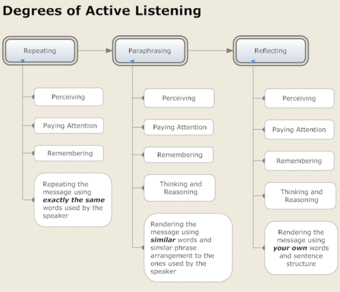
Degrees of Active Listening
There are several degrees of active listening.
Active listening can also involve paying attention to the speaker’s behavior and body language. Having the ability to interpret a person’s body language lets the listener develop a more accurate understanding of the speaker’s message.
5.1.2: Listening and Critical Thinking
Critical thinking skills are essential and connected to the ability to listen effectively and process the information that one hears.
Learning Objective
Illustrate the relationship between critical thinking and listening
Key Points
- Critical thinking is the process by which people qualitatively and quantitatively assess the information they accumulate.
- Critical thinking skills include observation, interpretation, analysis, inference, evaluation, explanation, and metacognition.
- The concepts and principles of critical thinking can be applied to any context or case, including the process of listening.
- Effective listening lets people collect information in a way that promotes critical thinking and successful communication.
Key Terms
- critical thinking
-
The process by which people qualitatively and quantitatively assess the information they have accumulated.
- Metacognition
-
“Cognition about cognition”, or “knowing about knowing. ” It can take many forms, including knowledge about when and how to use particular strategies for learning or for problem solving.
Example
- The first step in thinking critically about the contents of a lecture is to listen to the lecture thoughtfully and without distraction. Using a technique such as active listening, wherein one is able to repeat or paraphrase what has been said, one will better be able to cognitively process the information to draw independent conclusions and think critically.
Critical Thinking

Roosevelt and Churchill in Conversation
Effective listening leads to better critical understanding.
One definition for critical thinking is “the intellectually disciplined process of actively and skillfully conceptualizing, applying, analyzing, synthesizing, and/or evaluating information gathered from, or generated by, observation, experience, reflection, reasoning, or communication, as a guide to belief and action. “
In other words, critical thinking is the process by which people qualitatively and quantitatively assess the information they have accumulated, and how they in turn use that information to solve problems and forge new patterns of understanding. Critical thinking clarifies goals, examines assumptions, discerns hidden values, evaluates evidence, accomplishes actions, and assesses conclusions.
Critical thinking has many practical applications, such as formulating a workable solution to a complex personal problem, deliberating in a group setting about what course of action to take, or analyzing the assumptions and methods used in arriving at a scientific hypothesis. People use critical thinking to solve complex math problems or compare prices at the grocery store. It is a process that informs all aspects of one’s daily life, not just the time spent taking a class or writing an essay.
Critical thinking is imperative to effective communication, and thus, public speaking.
Connection of Critical Thinking to Listening
Critical thinking occurs whenever people figure out what to believe or what to do, and do so in a reasonable, reflective way. The concepts and principles of critical thinking can be applied to any context or case, but only by reflecting upon the nature of that application. Expressed in most general terms, critical thinking is “a way of taking up the problems of life. ” As such, reading, writing, speaking, and listening can all be done critically or uncritically insofar as core critical thinking skills can be applied to all of those activities. Critical thinking skills include observation, interpretation, analysis, inference, evaluation, explanation, and metacognition.
Critical thinkers are those who are able to do the following:
- Recognize problems and find workable solutions to those problems
- Understand the importance of prioritization in the hierarchy of problem solving tasks
- Gather relevant information
- Read between the lines by recognizing what is not said or stated
- Use language clearly, efficiently, and with efficacy
- Interpret data and form conclusions based on that data
- Determine the presence of lack of logical relationships
- Make sound conclusions and/or generalizations based on given data
- Test conclusions and generalizations
- Reconstruct one’s patterns of beliefs on the basis of wider experience
- Render accurate judgments about specific things and qualities in everyday life
Therefore, critical thinkers must engage in highly active listening to further their critical thinking skills. People can use critical thinking skills to understand, interpret, and assess what they hear in order to formulate appropriate reactions or responses. These skills allow people to organize the information that they hear, understand its context or relevance, recognize unstated assumptions, make logical connections between ideas, determine the truth values, and draw conclusions. Conversely, engaging in focused, effective listening also lets people collect information in a way that best promotes critical thinking and, ultimately, successful communication.
5.1.3: Causes of Poor Listening
Listening is negatively affected by low concentration, trying too hard, jumping ahead, and/or focusing on style instead of substance.
Learning Objective
Give examples of the four main barriers to effective listening
Key Points
- Low concentration can be the result of various psychological or physical situations such as visual or auditory distractions, physical discomfort, inadequate volume, lack of interest in the subject material, stress, or personal bias.
- When listeners give equal weight to everything they hear, it makes it difficult to organize and retain the information they need. When the audience is trying too hard to listen, they often cannot take in the most important information they need.
- Jumping ahead can be detrimental to the listening experience; when listening to a speaker’s message, the audience overlooks aspects of the conversation or makes judgments before all of the information is presented.
- Confirmation bias is the tendency to pick out aspects of a conversation that support one’s own preexisting beliefs and values.
- A flashy speech can actually be more detrimental to the overall success and comprehension of the message because a speech that focuses on style offers little in the way of substance.
- Recognizing obstacles ahead of time can go a long way toward overcoming them.
Key Terms
- confirmation bias
-
The tendency to pick out aspects of a conversation that support our one’s own preexisting beliefs and values.
- Vividness effect
-
The phenomenon of how vivid or highly graphic and dramatic events affect an individual’s perception of a situation.
Example
- An audience member who is trying to listen to a lecture when he is tired, there’s construction in the hallway, his pet just died, and he doesn’t like the professor or the tie he’s wearing would find it difficult or impossible to be an effective listener.
Causes of Poor Listening

Causes of Poor Listening
There are many barriers that can impede effective listening.
The act of “listening” may be affected by barriers that impede the flow of information. These barriers include distractions, an inability to prioritize information, a tendency to assume or judge based on little or no information (i.e., “jumping to conclusions), and general confusion about the topic being discussed. Listening barriers may be psychological (e.g., the listener’s emotions) or physical (e.g., noise and visual distraction). However, some of the most common barriers to effective listening include low concentration, lack of prioritization, poor judgement, and focusing on style rather than substance.
Low Concentration
Low concentration, or not paying close attention to speakers, is detrimental to effective listening. It can result from various psychological or physical situations such as visual or auditory distractions, physical discomfort, inadequate volume, lack of interest in the subject material, stress, or personal bias. Regardless of the cause, when a listener is not paying attention to a speaker’s dialogue, effective communication is significantly diminished. Both listeners and speakers should be aware of these kinds of impediments and work to eliminate or mitigate them.
When listening to speech, there is a time delay between the time a speaker utters a sentence to the moment the listener comprehends the speaker’s meaning. Normally, this happens within the span of a few seconds. If this process takes longer, the listener has to catch up to the speaker’s words if he or she continues to speak at a pace faster than the listener can comprehend. Often, it is easier for listeners to stop listening when they do not understand. Therefore, a speaker needs to know which parts of a speech may be more comprehension intensive than others, and adjust his or her speed, vocabulary, and sentence structure accordingly.
Lack of Prioritization
Just as lack of attention to detail in a conversation can lead to ineffective listening, so can focusing too much attention on the least important information. Listeners need to be able to pick up on social cues and prioritize the information they hear to identify the most important points within the context of the conversation.
Often, the information the audience needs to know is delivered along with less pertinent or irrelevant information. When listeners give equal weight to everything they hear, it makes it difficult to organize and retain the information they need. For instance, students who take notes in class must know which information to writing down within the context of an entire lecture. Writing down the lecture word for word is impossible as well as inefficient.
Poor Judgement
When listening to a speaker’s message, it is common to sometimes overlook aspects of the conversation or make judgments before all of the information is presented. Listeners often engage in confirmation bias, which is the tendency to isolate aspects of a conversation to support one’s own preexisting beliefs and values. This psychological process has a detrimental effect on listening for several reasons.
First, confirmation bias tends to cause listeners to enter the conversation before the speaker finishes her message and, thus, form opinions without first obtaining all pertinent information. Second, confirmation bias detracts from a listener’s ability to make accurate critical assessments. For example, a listener may hear something at the beginning of a speech that arouses a specific emotion. Whether anger, frustration, or anything else, this emotion could have a profound impact on the listener’s perception of the rest of the conversation.
Focusing on Style, Not Substance
The vividness effect explains how vivid or highly graphic an individual’s perception of a situation. When observing an event in person, an observer is automatically drawn toward the sensational, vivid or memorable aspects of a conversation or speech.
In the case of listening, distracting or larger-than-life elements in a speech or presentation can deflect attention away from the most important information in the conversation or presentation. These distractions can also influence the listener’s opinion. For example, if a Shakespearean professor delivered an entire lecture in an exaggerated Elizabethan accent, the class would likely not take the professor seriously, regardless of the actual academic merit of the lecture.
Cultural differences (including speakers’ accents, vocabulary, and misunderstandings due to cultural assumptions) can also obstruct the listening process. The same biases apply to the speaker’s physical appearance. To avoid this obstruction, listeners should be aware of these biases and focus on the substance, rather than the style of delivery, or the speaker’s voice and appearance.
5.2: Stages of Listening
5.2.1: The Receiving Stage
The first stage of the listening process is the receiving stage, which involves hearing and attending.
Learning Objective
Define the receiving stage of the listening process
Key Points
- Hearing is the physiological process of registering sound waves as they hit the eardrum.
- Attending is the process of accurately identifying particular sounds we hear as words.
- Attending also involves being able to discern breaks between words, or speech segmentation.
Key Terms
- Attending
-
The process of accurately identifying particular sounds as words.
- Hearing
-
The physiological process of registering sound waves as they hit the eardrum.
- Receiving stage
-
The first stage of the listening process, which involves hearing and attending.
The Receiving Stage
The first stage of the listening process is the receiving stage, which involves hearing and attending.

Use Your Ears!
The first stage of the listening process is receiving.
Hearing is the physiological process of registering sound waves as they hit the eardrum. As obvious as it may seem, in order to effectively gather information through listening, we must first be able to physically hear what we’re listening to. The clearer the sound, the easier the listening process becomes.
Paired with hearing, attending is the other half of the receiving stage in the listening process. Attending is the process of accurately identifying and interpreting particular sounds we hear as words. The sounds we hear have no meaning until we give them their meaning in context. Listening is an active process that constructs meaning from both verbal and nonverbal messages.
The Challenges of Reception
Listeners are often bombarded with a variety of auditory stimuli all at once, so they must differentiate which of those stimuli are speech sounds and which are not. Effective listening involves being able to focus in on speech sounds while disregarding other noise. For instance, a train passenger that hears the captain’s voice over the loudspeaker understands that the captain is speaking, then deciphers what the captain is saying despite other voices in the cabin. Another example is trying to listen to a friend tell a story while walking down a busy street. In order to best listen to what she’s saying, the listener needs to ignore the ambient street sounds.
Attending also involves being able to discern human speech, also known as “speech segmentation. “1 Identifying auditory stimuli as speech but not being able to break those speech sounds down into sentences and words would be a failure of the listening process. Discerning speech segmentation can be a more difficult activity when the listener is faced with an unfamiliar language.
5.2.2: The Understanding Stage
The understanding stage is the stage during which the listener determines the context and meanings of the words that are heard.
Learning Objective
Define the understanding stage of the listening process
Key Points
- The understanding stage is the second stage in the listening process.
- Determining the context and meaning of each word is essential to understanding a sentence.
- Understanding what we hear is essential to gathering information.
- Asking questions can help a listener better understand a speaker’s message or main point.
Key Terms
- comprehension
-
The totality of intentions or attributes, characters, marks, properties, or qualities, that the object possesses; the totality of intentions that are pertinent to the context of a given discussion.
- Understanding stage
-
The stage of listening during which the listener determines the context and meanings of the words that are heard.
Stages of Listening: The Understanding Stage

Puzzled
After receiving information through listening, the next step is understanding what you heard.
The second stage in the listening process is the understanding stage. Understanding or comprehension is “shared meaning between parties in a communication transaction” and constitutes the first step in the listening process. This is the stage during which the listener determines the context and meanings of the words he or she hears. Determining the context and meaning of individual words, as well as assigning meaning in language, is essential to understanding sentences. This, in turn, is essential to understanding a speaker’s message.
Once the listeners understands the speaker’s main point, they can begin to sort out the rest of the information they are hearing and decide where it belongs in their mental outline. For example, a political candidate listens to her opponent’s arguments to understand what policy decisions that opponent supports.
Before getting the big picture of a message, it can be difficult to focus on what the speaker is saying. Think about walking into a lecture class halfway through. You may immediately understand the words and sentences that you are hearing, but not immediately understand what the lecturer is proving or whether what you’re hearing in the moment is a main point, side note, or digression.
Understanding what we hear is a huge part of our everyday lives, particularly in terms of gathering basic information. In the office, people listen to their superiors for instructions about what they are to do. At school, students listen to teachers to learn new ideas. We listen to political candidates give policy speeches in order to determine who will get our vote. But without understanding what we hear, none of this everyday listening would relay any practical information to us.
One tactic for better understanding a speaker’s meaning is to ask questions. Asking questions allows the listener to fill in any holes he or she may have in the mental reconstruction of the speaker’s message.
5.2.3: The Evaluating Stage
The evaluating stage is the listening stage during which the listener critically assesses the information they received from the speaker.
Learning Objective
Define the evaluating stage of the listening process
Key Points
- The listener assesses the information they have gathered from the speaker both qualitatively and quantitatively.
- Evaluating allows the listener to form an opinion of what they heard.
- Evaluating is important for a listener in terms of how what she’s heard will affect her own ideas, decisions, actions, and/or beliefs.
Key Terms
- tangential
-
Merely touching, referring to a tangent, only indirectly related.
- Evaluating stage
-
The stage of the listening process during which the listener critically assesses the information they received from the speaker.
- assess
-
To determine, estimate or judge the value of; to evaluate.
The Evaluating Stage

Focus
Once you understand what you hear, you can focus in on the relevant information.
This stage of the listening process is the one during which the listener assesses the information they received, both qualitatively and quantitatively. Evaluating allows the listener to form an opinion of what they heard and, if necessary, to begin developing a response.
During the evaluating stage, the listener determines whether or not the information they heard and understood from the speaker is well constructed or disorganized, biased or unbiased, true or false, significant or insignificant. They also ascertain how and why the speaker has come up with and conveyed the message that they delivered. This may involve considerations of a speaker’s personal or professional motivations and goals. For example, a listener may determine that a co-worker’s vehement condemnation of another for jamming the copier is factually correct, but may also understand that the co-worker’s child is sick and that may be putting them on edge. A voter who listens to and understands the points made in a political candidate’s stump speech can decide whether or not those points were convincing enough to earn their vote.
The evaluating stage occurs most effectively once the listener fully understands what the speaker is trying to say. While we can, and sometimes do, form opinions of information and ideas that we don’t fully understand—or even that we misunderstand—doing so is not often ideal in the long run. Having a clear understanding of a speaker’s message allows a listener to evaluate that message without getting bogged down in ambiguities or spending unnecessary time and energy addressing points that may be tangential or otherwise nonessential.
This stage of critical analysis is important for a listener in terms of how what they heard will affect their own ideas, decisions, actions, and/or beliefs.
5.2.4: The Responding Stage
The responding stage is when the listener provides verbal and/or nonverbal reactions to what she hears.
Learning Objective
Define the responding stage of the listening process
Key Points
- The speaker looks for responses from the listener to determine if her message is being understood and/or considered.
- When a listener responds verbally to what she hears, the speaker/listener roles are reversed.
- Based on the listener’s responses, the speaker can choose to either adjust or continue with the delivery of her message.
Key Term
- Responding stage
-
The listening stage wherein the listener provides verbal and/or nonverbal reactions to what she hears.
Example
- During a training session, a new employee nods and says “okay” to indicate that she understand what her boss is telling her.
The Responding Stage
The responding stage is the stage of the listening process wherein the listener provides verbal and/or nonverbal reactions based on short- or long-term memory. Following the remembering stage, a listener can respond to what they hear either verbally or non-verbally. Nonverbal signals can include gestures such as nodding, making eye contact, tapping a pen, fidgeting, scratching or cocking their head, smiling, rolling their eyes, grimacing, or any other body language. These kinds of responses can be displayed purposefully or involuntarily. Responding verbally might involve asking a question, requesting additional information, redirecting or changing the focus of a conversation, cutting off a speaker, or repeating what a speaker has said back to her in order to verify that the received message matches the intended message.
Nonverbal responses like nodding or eye contact allow the listener to communicate their level of interest without interrupting the speaker, thereby preserving the speaker/listener roles. When a listener responds verbally to what they hear and remember—for example, with a question or a comment—the speaker/listener roles are reversed, at least momentarily.
Responding adds action to the listening process, which would otherwise be an outwardly passive process. Oftentimes, the speaker looks for verbal and nonverbal responses from the listener to determine if and how their message is being understood and/or considered. Based on the listener’s responses, the speaker can choose to either adjust or continue with the delivery of her message. For example, if a listener’s brow is furrowed and their arms are crossed, the speaker may determine that she needs to lighten their tone to better communicate their point. If a listener is smiling and nodding or asking questions, the speaker may feel that the listener is engaged and her message is being communicated effectively.
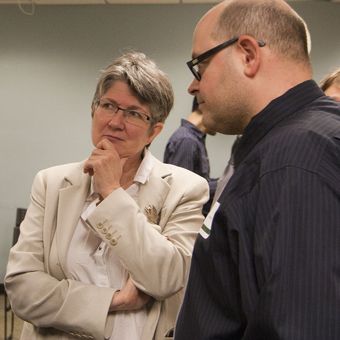
The listener
By holding her hand up to her chin, this woman is giving a nonverbal signal that she is concentrating on what the speaker (not pictured) is saying.
5.2.5: The Remembering Stage
The remembering stage occurs as the listener categorizes and retains the information she’s gathering from the speaker.
Learning Objective
Define the remembering stage of the listening process
Key Points
- Memory is essential throughout the listening process.
- Memory lets the speaker put what she hears in the context of what she’s heard before.
- Using information immediately after receiving it enhances information retention.
- Distracted or mindless listening reduces information retention.
Key Terms
- memory
-
The ability of an organism to record information about things or events with the facility of recalling them later at will.
- recall
-
Memory; the ability to remember.
- Remembering stage
-
The stage of listening wherein the listener categorizes and retains the information she’s gathering from the speaker.
The Remembering Stage

Memory
Remembering what you hear is key to effective listening.
In the listening process, the remembering stage occurs as the listener categorizes and retains the information she’s gathered from the speaker for future access. The result–memory–allows the person to record information about people, objects and events for later recall. This happens both during and after the speaker’s delivery.
Memory is essential throughout the listening process. We depend on our memory to fill in the blanks when we’re listening and to let us place what we’re hearing at the moment in the context of what we’ve heard before. If, for example, you forgot everything that you heard immediately after you heard it, you would not be able to follow along with what a speaker says, and conversations would be impossible. Moreover, a friend who expresses fear about a dog she sees on the sidewalk ahead can help you recall that the friend began the conversation with her childhood memory of being attacked by a dog.
Remembering previous information is critical to moving forward. Similarly, making associations to past remembered information can help a listener understand what she is currently hearing in a wider context. In listening to a lecture about the symptoms of depression, for example, a listener might make a connection to the description of a character in a novel that she read years before.
Using information immediately after receiving it enhances information retention and lessens the forgetting curve, or the rate at which we no longer retain information in our memory. Conversely, retention is lessened when we engage in mindless listening, and little effort is made to understand a speaker’s message.
Because everyone has different memories, the speaker and the listener may attach different meanings to the same statement. In this sense, establishing common ground in terms of context is extremely important, both for listeners and speakers.
5.3: Barriers to Listening
5.3.1: Culture
Cultural differences between listeners and speakers can create barriers to effective communication.
Learning Objective
Identify ways in which an effective communicator will approach communicating with a person from another culture
Key Points
- Cultural differences can include speakers’ accents, vocabulary, and assumptions about shared information or the roles of listeners and speakers in conversation.
- Effective communicators understand that they grow up with cultural biases for and against certain modes of communication.
- Suspending judgments, exercising empathy, and focusing on content rather than style can help overcome cultural barriers to effective communication.
Key Term
- culture
-
The arts, customs, lifestyles, background, and habits that characterize a particular society or nation. The beliefs, values, behavior and material objects that constitute a people’s way of life.
Example
- When listening to a speaker who comes from a different cultural background, work to set aside any preexisting ideas about that culture and focus on best understanding the speaker’s specific message.
Keeping an Open Mind to Cultural Differences

Handshake
Different cultures can have different methods of communication.
What defines culture? Culture certainly includes race, nationality, and ethnicity, but it goes beyond those identity markers as well. When we talk about culture, we are referring to belief systems, values, and behaviors that support a particular ideology or social arrangement. The following are various aspects of our individual identity that we use to create membership in a shared cultural identity: race, ethnicity, nationality, gender, sexual orientation, and class. Culture guides language use, appropriate forms of dress, and views of the world. The concept is broad and encompasses many areas of society such as the role of the family, the role of the individual, educational systems, employment, and gender.
Different cultures have different modes and patterns of communication that can hinder effective listening if the listener is either unfamiliar with the speaker’s patterns or holds a mistaken view about them. These kinds of cultural differences include speakers’ accents and vocabulary, as well as assumptions about shared information and the roles of listeners and speakers in conversation.
In a broad sense, we all grow up immersed in various cultures all at once—family, country, region, sexual orientation, religion, socioeconomic class, etc.—and sometimes the specifics of those cultures seem to be hard-wired into our thinking and the ways in which we communicate. Without meaning to, we may bring assumptions or judgments into a conversation that don’t actually align with the thoughts or beliefs of our conversational partner, and this can create a barrier to effective communication.
Effective communicators understand that they grow up with cultural biases for and against certain modes of communication. Because of this, an open-minded listener will work hard to focus on what the speaker is actually saying regardless of how they’re saying it. Cultural filters and frameworks may be useful later in an analysis of what someone said, but the starting point of effective listening should be to understand the perspective of the speaker as fully as possible.
Maintaining this kind of cultural sensitivity requires some basics of open-minded listening: suspending judgment and employing empathy whenever possible. By meeting the speaker on his or her own grounds and taking care to focus on the content rather than the style of the communication, we can best assure more effective understanding.
5.3.2: Gender
All of us can and do speak the language of multiple gender cultures, and we can use this knowledge to communicate effectively.
Learning Objective
Distinguish between communicating in a feminine style with communicating in a masculine style
Key Points
- As a social construct, gender is learned, symbolic, and dynamic.
- Starting in childhood, girls and boys are generally socialized to belong to distinct cultures and thus, speak in ways particular to their own gender’s rules and norms.
- For those socialized in a feminine community, the purpose of communication is to create and foster relational connections with other people.
- The goal for typically masculine communication is to establish individuality.
Key Term
- gender
-
The socio-cultural phenomenon of the division of people into various categories, such as “male” and “female,” with each having associated clothing, roles, stereotypes, etc.
Example
- When addressing an audience composed primarily of women versus one composed mostly of men, a political candidate may alter her communicative style to be more or less direct or responsive while still communicating the same information.
Gender and Culture

Invisible Couple
Differences in gender communication styles can sometimes lead to less effective communication.
In our society, we often use the gendered terms “women” and “men” instead of “male” and “female. ” What’s the difference between these two sets of terms? One pair refers to the biological categories of male and female. The other pair, men and women, refers to what are now generally regarded as socially constructed concepts that convey the contextually fluid cultural ideals or values of masculinity and femininity. Gender exists on a continuum because feminine males and masculine females are not only possible but common, and the varying degrees of masculinity and femininity we see (and embody ourselves) are often separate from sexual orientation or preference. In other words, as a social construct, gender is learned, symbolic, and dynamic.
Gender and Speech
Starting in childhood, girls and boys are generally socialized to belong to distinct cultures and thus, speak in ways particular to their own gender’s rules and norms (Johnson, 2000; Tannen 1986, 1990, 1995). This pattern of gendered socialization continues throughout our lives. As we’ve previously discussed, culturally diverse ways of speaking can cause miscommunication between members of each culture or speech community. As such, men and women often interpret the same conversation differently.
“Masculine” and “Feminine” Communication Styles
For those socialized in a feminine community, the purpose of communication is to create and foster relational connections with other people (Johnson, 2000; Wood, 2005). On the other hand, the goal for typically masculine communication is to establish individuality. This is done in a number of ways, such as indicating independence, showing control, and entertaining or performing for others.
When the goal is connection, members of a speech community are likely to engage in the following six strategies–equity, support, conversational “maintenance work,” responsiveness, a personal style, and tentativeness. When the goal is independence, on the other hand, members of this speech community are likely to communicate in ways that exhibit knowledge, refrain from personal disclosure, are abstract, are focused on instrumentality, demonstrate conversational command, are direct and assertive, and are less responsive.
All of us are capable of speaking, and do speak, the language of multiple gender cultures. Again, this is one of the reasons it is important to make a distinction between gender and sex. Both men and women may make conscious choices to speak more directly and abstractly at work, but more personal at home. Such strategic choices indicate that we can use our knowledge about various communication styles or options to make us successful in many different contexts.
As with other cultural differences, when listening to a speaker who is communicating in a particularly gendered style, try to focus on the content of the message while suspending judgment and exercising empathy.
5.3.3: Technology
Technology can assist the audience with listening, but can also be a distraction at the same time.
Learning Objective
Identify methods for avoiding technological distractions
Key Points
- Technology can help the audience listen to the speech’s message by making them physically able to hear the speaker’s words, such as through electronic amplification.
- However, malfunctioning technological equipment can disrupt the listening process.
- Personal electronics like laptops and cell phones can distract listeners from a speaker, particularly when used by audience members during the presentation.
- Do not be afraid to do a test run of any and all technology that will be used during the presentation to ensure it works smoothly when the time comes.
- Before the beginning of the speech, both the speaker and the audience should silence their cell phones or other noise-making devices.
Key Term
- technology
-
A device, material, or sequence of mathematical coded electronic instructions created by a person’s mind that is built, assembled, or produced and which is not part of the natural world.
Example
- To most effectively listen to a lecture, try turning off your cell phone and Internet connection to avoid potential distractions.
Technological Distractions

Lasers
If a speaker uses technology, they must get their message across without distracting the audience.
Everyone has experienced the benefits technology can provide to the listening experience. Hearing aid technology can help those who are hard of hearing more easily engage in a conversation or listen to a lecture. Electronic presentations can incorporate photographs, sounds, charts, guided outlines, and other features to help maintain audience attention and clarify or demonstrate complicated ideas. An engaged audience member is more likely to pay attention to the material and therefore listen more actively to a presentation.
When not used properly, however, technology can become a barrier to effective listening. Poor or outdated equipment can malfunction, causing disruptions to the listening process. If a conversation is taking place via an electronic medium, problems with technology (like a buzzing phone line or slow Internet connection) can likewise limit communication. In a non-virtual setting, excessive or unnecessary audio/visual components to a technological presentation can become distracting, particularly if they are directly related to the message being communicated by the person making the presentation.
Beyond technology being utilized by the presented, technology used by the listener can also hinder effective listening. Taking lecture notes on a laptop is convenient, but it is also convenient to check Facebook or the latest sports scores. Cell phones and tablets can provide similar distractions. If someone in the audience is talking or texting during the speech, technology becomes a major distraction for everyone involved.
Ultimately, the onus lies with both the speaker and the listener to anticipate potential technological problems or distractions to the listening process, and to do what they can to eliminate or mitigate their effects. Technology should simplify communication, not make it more complicated.
Speakers can avoid distractions caused by technology by doing the following:
- Before the presentation, the speaker should silence his or her cell phone or any other device that might make noise and provide an interruption.
- The audience should to do the same. The speaker has the right to request that the audience comply with his or her desire to have a distraction-free environment.
- If using technology as part of the presentation, the speaker should do a test run to make sure that everything is set up properly to avoid malfunction later during the speech.
- If possible, the speaker should do a sound check. Amplified or not, at the beginning of the speech, the speaker should ask, “Can you hear me in the back? ” or something to that effect.
- The speech should not include too many sources of visual stimulation such as visual aids, PowerPoints, charts, laser pointers, etc. This can actually cause a message overload for the audience as they try to divide their attention between what they hear and what they see.
5.4: Enhancing Your Listening
5.4.1: Be a Serious Listener: Resist Distractions and Listen Actively
Resisting distractions and listening actively are two ways to become a more effective listener.
Learning Objective
Explain how resisting distractions and listening actively can make you a more effective listener
Key Points
- Distractions can be internal or external. External distractions include auditory, visual, or physical noise. Internal distractions may be psychological or emotional.
- In order to best focus in on a speaker’s message, try to eliminate as many distractions as possible.
- Active listening is a communication technique that requires the listener to feed back what they hear to the speaker.
- Active listening also involves observing and assessing the speaker’s behavior and body language.
Key Term
- active listening
-
A particular communication technique that requires the listener to provide feedback on what he or she hears to the speaker.
Example
- To best listen to Troy, Penelope turned off the television and her cell phone, let him speak his mind while noticing his crossed arms and frown, then verified what she’d heard him say by re-stating it and also mentioning that he seemed a little unhappy about the situation.
Resisting Distraction

Distractions Are Everywhere
Learning how to tune out distractions enables people to be better listeners.
Distractions can come in all shapes and sizes. To be serious, effective listeners, people must learn how to resist the distractions that cross their path so they can better focus in on what they are trying to hear. Distractions and noise come in two broad types: internal and external.
External distractions often come in the form of physical noise in the physical environment. Auditory and visual distractions are often the most easily identifiable types of external distractions. Loud or extraneous noises can inhibit effective listening, as can unnecessary or excessive images. Think about trying to have a meaningful conversation with a friend while someone else is watching an action movie in the same room. Pretty impossible, right?
Internal distractions often refer to psychological and emotional noise. Distractions can also originate internally or can be physical responses to the environment. Feeling hungry, upset, or physically uncomfortable can be just as detrimental to effective listening as extraneous things in the physical environment. If a speaker is nervous about presenting a speech, he or she may have a litany of negative thoughts in his or her inner monologue, or the “little voice in your head. ” Internal distractions also occur when someone is thinking about plans for after your speech, or thinking about topics and things completely unrelated to the speech at hand. These are all examples of internal distractions.
In order to best focus in on a speaker’s message, try to eliminate as many possible distractions as possible. Turn off all mobile devices, relocate to a quiet space, and close unnecessary windows on the computer.
Active Listening
Active listening is a communication technique that requires the listener to feed back what they hear to the speaker. Most often, listeners will do this by re-stating or paraphrasing what they have heard in their own words. This activity confirms what the listener heard and, moreover, confirms that both parties understand each other. It is important to note, however, that by paraphrasing the speaker’s message, the listener is not necessarily agreeing with the speaker. Paraphrasing also helps the listener better retain that information for future access.
If someone is actively listening, then he or she is typically not distracted. Speakers can also cultivate the habit of avoiding distractions (for example, by addressing questions after the presentation, not during).
In addition to internalizing what a speaker says, active listening also involves observing and assessing the speaker’s behavior and body language, and relaying that information back to the speaker as well. Having the ability to interpret a speaker’s body language lets the listener develop a more accurate understanding of the speaker’s message. When the listener does not respond to the speaker’s nonverbal language, he or she engages in a content-only response that ignores the emotions that guide the message; this can limit understanding.
The ability to listen actively demonstrates sincerity on the part of the listener and helps to make sure that no information is being assumed or taken for granted. Active listening is most often used to improve personal relationships, reduce misunderstanding and conflicts, strengthen cooperation, and foster understanding.
5.4.2: Be an Open-Minded Listener: Suspend Judgment and Exercise Empathy
Open-minded listening requires empathy and a suspension of judgment on the part of the listener.
Learning Objective
Explain how to listen with an open mind
Key Points
- Listening with an open mind means being receptive to being influenced by what one hears.
- Suspend judgment by becoming aware of pre-conceived notions; listening to the entire speech before jumping to conclusions; and listening to what the speaker has to say for understanding, not just to determine whether the speaker is right or wrong.
- Listening with empathy lets the listener better understand where the speaker is coming from, emotionally and conceptually.
- To be an effective open-minded listener, learn to leave ego at the door, and instead strive to find common ground with your speaker.
Key Terms
- empathy
-
The capacity to understand another person’s point of view or the result of such understanding.
- Judgment
-
The evaluation of evidence in the making of a decision.
Example
- Though Kate was annoyed that Jackson had left the car windows open in the rain, after listening to his explanation with an open mind, she understood that he’d been under a lot of stress at work lately and that he was sorry for the mishap.
Suspending Judgment
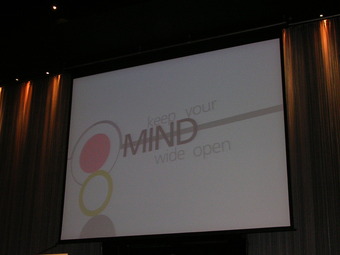
Be an Open-Minded Listener
Open mindedness is essential to effective listening.
Someone who listens with an open mind is willing to be influenced by what he or she hears. It does not mean that the listener should not have strong views of his or her own, but it does require the listener to be willing to consider the merit of what other people say. This can be difficult when listening to something one does not want to hear or something about which one has pre-conceived notions.
All people have their own opinions on just about everything, so when people listen, they are tempted to immediately judge what someone else is saying from their own perspectives. However, this kind of pre-judging can lead to misunderstanding. People who listen with an open mind avoid anticipating what they think their conversational partners are going to say. They do not jump to conclusions, but rather hear the speaker out entirely and make an effort to understand his or her lines of argument.
Judgmental listening also occurs when the listener is only listening to the speaker in order to determine whether he or she is right or wrong, rather than listening to understand the speaker’s ideas and where they come from. This kind of judgmental listening prevents the listener from fully engaging with the speaker on his or her own terms, and therefore limits the scope of the conversation.
Carrying pre-conceived notions about the speaker or the content of a speech into a conversation further limits effective listening. Listeners may have overwhelmingly positive or negative associations with particular people or ideas, and those associations can affect how listeners interpret. To listen effectively, one must work to temporarily suspend those associations in order to understand the speaker on his or her own terms.
Exercising Empathy
Exercising empathy while listening to a speaker is related to suspending judgment in that it requires the listener to work to understand what the speaker says from his or her point of view. This does not mean that the listener must automatically agree with the speaker; rather, the listener should simply put him- or herself in the speaker’s shoes and try to see the presented arguments from that perspective. One of the primary jobs of an effective listener is to get in touch with the speaker’s perspective and not to color it with his or her own.
Empathetic listening helps promote effective listening because it allows the listener to take into account where the speaker is coming from, both emotionally and in terms of the content of his or her speech. This lets the listener assess what the speaker says and how it is presented more accurately, which ultimately leads to better understanding.
Tips for Being an Open-Minded Listener
- Leave ego at the door. Come to the presentation with a mind like a blank slate.
- When disagreeing with the speaker, write down the objections rather than tuning out the presenter.
- Be open to new ideas or new ways of thinking.
- Look for opportunities to share common ground with the speaker, such as beliefs, ideologies, or experiences.
5.5: Helping Your Audience Listen More
5.5.1: Read Feedback Cues
Feedback is the verbal and non-verbal responses from an audience which help the speaker modify and regulate what s/he is saying.
Learning Objective
Apply your observations of feedback from your audience to modify your speech
Key Points
- Verbal feedback–during the speech you may solicit feedback from the audience by asking a simple question to get feedback from the audience.
- Non-verbal feedback–When you are in front of the audience, non-verbal behavior can be an important cue to what the audience understands, the level of attentiveness, excitement or agreement, or confusion or disagreement.
- Audience Response System– capture feedback from a large or remote audience by using an audience response system to ask questions and then display the answers. Audience members can respond using a wireless keypad such as a clicker, SMS, or text using a smartphone.
- You can use the responses as personal feedback to modify your message or you can share them with the audience by displaying the tabulated responses on a web page or projected as part of a PowerPoint presentation.
Key Term
- feedback
-
The receivers’ verbal and nonverbal responses to a message, such as a nod for understanding (nonverbal), a raised eyebrow for being confused (nonverbal), or asking a question to clarify the message (verbal).
Read Feedback Cues
Feedback is the response from the listeners
Feedback is the response that listeners provide to the sender of the message. Feedback is a cue to the speaker to modify or regulate what is being said. Feedback can take the form of verbal or non-verbal responses to an in-person speech, or verbal responses which are electronically captured for large or remote audiences .
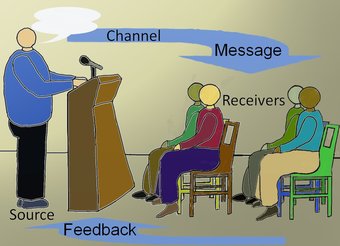
Receiving Feedback
It is important for the speaker to receive feedback from the audience.
In-Person Verbal and Non-Verbal Feedback
Verbal Feedback
During the speech you may solicit feedback from the audience by asking a simple question. Audience members may respond verbally or they may nod or raise their hands. Additionally, audience members may ask a question or let you know if they do not understand. You may also receive direct positive or negative feedback from members of the audience who agree or disagree with what you are saying. Listen for the verbal feedback and acknowledge it.
Non-Verbal Feedback
When you are in front of the audience, non-verbal behavior can be an important cue to what the audience understands, the level of attentiveness, excitement or agreement, or confusion or disagreement. The non-verbal feedback may be intentional vocalizations, such as groans or encouragement (such as clapping). However, much of the non-verbal feedback may be unconscious physical body language, which can provide feedback for you. Here are some examples of body language that you may notice displayed consciously or subconsciously by members of the audience:
- Boredom: boredom is indicated by the head tilting to one side, or by the eyes looking straight at the speaker but becoming slightly unfocused.
- Disbelief: this is often indicated by averted gaze or by touching the ear or scratching the chin. When a person is not being convinced by what someone is saying, the attention invariably wanders and the eyes will stare away for an extended period.
- Attentive eye contact: Are audience members looking directly at you attentively or are they looking around? Consistent eye contact can indicate that a person is interested and thinking positively about the speaker’s subject. However, if a person is fiddling with something, even while directly looking at you, it could indicate that the attention is elsewhere.
- Body position and posture: Audience members will generally face the speaker while listening intently; if the audience members are not interested they may shift the body position to the side rather than toward the speaker.
If you maintain eye contact with your audience while speaking, you can observe the cues and adapt your message. What is your audience telling you? All the non-verbal feedback needs to be processed with knowledge of the cultural context of the speaker and the audience. Remember that people from different cultures do interpret body language in different ways. For example, eye contact can be misleading because cultural norms about it vary widely. Direct eye contact may show attentiveness to the North American speaker but be considered a confrontation in another culture. And, certain hand gestures that are perfectly acceptable to one group may be disrespectful to another audience.
Feedback Electronically Captured from Large or Remote Audiences
You can also capture the responses from the audience by using an audience response system that you can view privately as you speak or display to the audience. You can solicit feedback directly by asking multiple choice, true-false, or numerical questions from audience members who respond using a wireless keypad such as a clicker, SMS, or text using a smartphone. The feedback from the audience is then sent back to your computer and processed by the audience response software. For a large or remote audience, you can plan to include different questions or polls to capture feedback from your audience and adapt your message accordingly. It is necessary to structure the questions to get the feedback you want. For example, if a large percentage of your audience answers a question with a certain wrong answer, you will know that you need to explain that concept differently. Conversely, if a large percentage of the audience agrees with an opinion, you can use that feedback to adapt your message.
Timing of Feedback
Assessment, or the tactics speakers and audience members use to facilitate learning, is often divided into initial, formative, and summative categories.
- Initial assessment, also referred to as pre-assessment or diagnostic assessment, is conducted prior to instruction or intervention to establish a baseline from which an individual’s growth can be measured.
- Formative assessment is generally carried out throughout a course or project. Formative assessment, also referred to as “educative assessment,” is used to aid learning. For example, in an educational setting, formative assessment might be a teacher (or peer) or the learner, providing feedback on a student’s work and would not necessarily be used for grading purposes. Formative assessments can take the form of diagnostic, standardized tests.
- Summative assessment is generally carried out at the end of a course, project or speech. In an educational setting, summative assessments are typically used to assign students a course grade. Whereas following a speech or presentation, summative assessment can be provided in the form of positive feedback, applause or a standing ovation.
5.5.2: Hold the Audience’s Attention
To hold the audience’s attention, consider their readiness to perceive, the selection of stimuli, and how to maintain current awareness.
Learning Objective
Employ strategies for maintaining audience focus
Key Points
- If the speaker can establish readiness by getting the audience’s attention during the first 25-30 seconds of the speech, he or she can then direct and focus that attention to the important parts of the message.
- The speaker can direct the attention of the audience to what is important by using changes in rate and volume, body movement, and gesture to emphasize what is important.
- It is important to read the non-verbal clues of the audience to understand if they have shifted their attention somewhere else.
- If the audience’s attention is shifting from the speech, challenge the audience with an inquiry to stimulating thinking.
- There are many strategies to employ to hold the attention of the audience, but the most important is the ability to establish and maintain a genuine connection with the people in the audience.
Key Terms
- awareness
-
The state or ability to perceive, to feel, or to be conscious of events, objects, or sensory patterns. In this level of consciousness, sense data can be confirmed by an observer without necessarily implying understanding.
- Perception
-
Conscious understanding of something; acuity.
To hold the attention of the audience, a public speaker should consider three important aspects of the process of perception: readiness to perceive, selection of certain stimuli for focus of attention, and state of current awareness.
Readiness to Perceive
The speaker is responsible for setting the stage. The speaker does this with the opening introduction in the the first 25 to 30 sections. If the speaker can secure the attention of the audience at the very beginning of the speech, he or she can then direct and focus that attention to the important parts of the message, as follows:
- Make sure that the room is free of noise and other distractions, to ensure that the audience is focused on the speech, rather than what is happening in the room.
- Speakers are often introduced by a host. This brief introduction is important because it helps to establish the speaker’s credentials and prepares the audience members so their attention is properly directed.
- Remember that the first important function of the introduction is to “capture the attention of the audience” and them immediately direct attention to the speech’s main message.
Selection of Certain Stimuli for Focus
While delivering the speech, the speaker wants the audience to concentrate on his or her message, and directs their attention to what is important through the use of voice, body, and gesture. This is done by emphasizing the important points by changing the rate, volume, or pitch of the voice. Using vocal variety purposely helps the audience know what is important and directs their attention to those elements. In addition, the speaker’s body and gestures can direct attention to important aspects of the message (for example, by pointing to, walking to, or touching a visual aid or diagram). Additional examples include the following:
- To understand where he or she wants the audience to direct their attention, the speaker can consider a quick internal summary of an idea.
- Use signposts, such as “Now get this…” or “Here is the important point, which I want you to remember. “
- When using a visual aid, use additional audio cues or color changes to highlight specific areas.
State of Current Awareness
Speakers must read the non-verbal clues of the audience to understand if they have shifted their focus somewhere else. If the audience members are glancing at their watches, texting, or glancing at other people in the audience, the speaker should recognize the current state and redirect the attention back to the speech’s message. To change the current state of the audience’s awareness and re-gain their attention, try the following:
- Challenge the audience with an inquiry to stimulating thinking. Ask for a show of hands to vote or to give answers, use clickers or an audience response system to get a response and then share the result, or ask a relevant question to stimulate thought.
- Engage in narrative as a change of pace from message delivery. Create a narrative that is relevant to the topic and is dramatic for the audience, and use a surprise ending to direct the audience attention to the message.
- Provide concrete examples of a concept or main point that is directly relevant and engaging for the audience. Make a comparison to something that has recently happened in the community or nationally.
- Stimulate the audience’s imagination or take them on a fantasy journey that stimulates the different senses. The more the senses are stimulated, the more the current focus is on the speech’s message.
There are many strategies that the speaker can employee to hold the attention of the audience, but the most important is the ability to establish and maintain a genuine connection with the people in your audience. Speakers don’t need to use a choke-hold to keep the audience’s attention.

Choke-hold
Speakers don’t need to use a choke -hold to keep the audience’s attention.
5.5.3: Maximize Understanding
To maximize understanding, use general rhetorical strategies and other approaches that build upon the audience’s prior experiences.
Learning Objective
Give examples of ways to help your audience understand your ideas
Key Points
- We depend on the use of words applied in various rhetorical strategies to exchange understandings.
- You can apply prior knowledge of the audience to choose the right vocabulary, to make comparisons with things familiar to them, to show the origin of things, to group things into categories meaningful to them, and to number the steps or events in the order that they occur.
- To increase understanding during a speech, you can take the perspective of the audience to restate ideas, to ask the audience questions, and to paraphrase what you have just said using different examples and choice of words.
Key Terms
- comparison
-
An evaluation of the similarities and differences of one or more things relative to each other.
- understanding
-
The mental (sometimes emotional) process of comprehension, or the assimilation of knowledge, which is subjective by its nature.
- classification
-
The act of forming into a class or classes; a distribution into groups, as classes, orders, families, etc., according to some common relations or attributes.
The Elements of Understanding
Understanding involves comprehending or knowing about an object, idea, concept, or process. In essence, you want the audience to comprehend and share the same understanding. It would be a very simple process if you could just exchange memory modules for your audience to upload, but we are not there yet. Today, you will use words to explain your thoughts. Here we are concerned with how you might use different rhetorical strategies to maximize what the audience understands.
Applying Prior Knowledge about the Audience
Apply what you already know about the demographics, background, and life experiences of the audience. Ask yourself, “What does my audience already understand or know? ” You can apply the knowledge to maximize understanding.
- Language choice and vocabulary: You’ll want to begin your explanation at the right level; ask yourself, “What vocabulary will my audience understand and what do I need to explain before I can explain other concepts? “
- Compare and contrast based upon shared knowledge: When you are showing how two things are alike, create connections with what the audience already knows. In order to maximize understanding, you’ll want to compare those things that are already familiar against the new and unfamiliar things. Then, you can demonstrate how they are the same or different.
- Visualize transformation by cause and origin: Where did something come from and how did it get to its present state or condition? Help the audience picture the change from one state or condition to another.
- Classification and grouping alike things to form a concept: First, you’ll want to cite examples that are familiar to the audience and put them into the same classification. Then you can put other less familiar objects or ideas into the same class or grouping while using the same label. You can even help the audience generalize to create a classification. For example, let’s say you see a fir, a willow, and a linden. By comparing these objects, you notice that they are different from one another in respect to the trunk, branches, leaves, and the like; a further comparison, however, reveals what they have in common: the trunk, branches, and leaves themselves, which form the abstraction from their size, shape, and so forth. Thus, you gain a concept of a tree .
- Sequence and origin: Here you help the audience understand the process or sequence of events in time. You can clearly list and number the steps or events in the order in which they occur. In addition to using sequencing words, you can also use simple mnemonics, like the knuckle mnemonic, which helps the listeners sequence things such as how many days are in each month .
Applying General Strategies
- Perspective-taking: Practice perspective-taking so you can frame and reframe your examples in a way that the audience members will understand. You’ll want to see how the members of the audience organize the world cognitively in order to reframe your concepts so that the audience understands them. If your initial explanation is not effective with a particular audience, you may reframe and refocus on different aspects of what you are explaining.
- Repetition: Build upon prior understanding of concepts by repeating and using internal summaries. This ensures the audience does not miss an important idea that is critical to understanding the whole message.
- Questioning: Question your audience to see if they understand what you are saying, and adjust your explanation in order to clarify misunderstandings.
- Paraphrase: Paraphrase what you said for the audience and restate the ideas using different examples. Different audience members may not understand one idea but may understand another that relates more directly to their prior knowledge.
Simply put, you’ll want to learn how the audience conceptualizes the world and then use that knowledge to maximize understanding. Use your skills of restating, questioning, perspective-taking, and paraphrasing to help clarify and reinforce understanding as you speak.
5.5.4: Build Credibility
Aristotle established three methods of proof to build credibility: initial, derived, and terminal.
Learning Objective
Give examples of ways to build credibility before, during, and after your speech
Key Points
- Credibility is not a characteristic of the source or speaker but an attitude in the mind of the listener(s). You may have high credibility with one group of listeners and low credibility with another.
- Building initial credibility—your initial credibility is your personal brand. The audience may know you prior to the speech. If not, have someone introduce you or provide relevant background as a self-introduction.
- Building derived credibility—When you speak confidently and assertively you inspire others with your energy and words. To build credibility you want to look at everything you do in the speech such as appearance, delivery, word choice, and in general how you handle yourself.
- Building derived credibility—You establish common ground with the audience by sharing aspects of your background that are similar to the audience, by using supporting examples or experiences that you and the audience have in common, and by creating a bond with the audience.
- Terminal credibility—You can build credibility for your next speech by establishing a rapport with the audience so they walk away with a more positive view of you than when you started.
Key Terms
- ethos
-
A rhetorical appeal to an audience based on the speaker/writer’s credibility.
- Aristotle
-
An ancient Greek philosopher (382–322 BC), student of Plato, and teacher of Alexander the Great.
- credibility
-
The objective and subjective components of the believability of a source or message.
Build Credibility
Building Credibility through Character and Competence
Aristotle, the classical Greek philosopher and rhetorician, established three methods of proof—logos, ethos, and pathos.
Logos is the logical development of the message, pathos is the emotional appeals employed by the speaker, and ethos is the moral character of the speaker as perceived by the audience. Our focus on credibility relates to ethos, the ethical character and competence of the speaker. To build credibility you want to focus on three stages: (1) Initial credibility is what the audience knows and their opinion prior to the speech, (2) Derived (during) credibility is how the audience perceives you while delivering the speech, and (3) Terminal is the lasting impression that the audience has of you as they leave the speech.

Bust of Aristotle
Marble, Roman copy after a Greek bronze original by Lysippos from 330 BC; the alabaster mantle is a modern addition.
Building Initial Credibility
Here we look at who you are as a person; what the audience knows about your expertise and whether the audience thinks you are trustworthy. You may think about initial credibility as your personal branding: who you are and what you audience knows about you. Your reputation may precede you but if it does not, you may rely on an introduction prior to the speech. Often a host or moderator will introduce you and provide relevant information about your background. If there is no moderator to provide an introduction, you may include a brief self-introduction about yourself as it relates to the topic and your motivation for speaking. Building initial credibility helps prepare the audience for what is to come during the speech.
Building Derived Credibility
This is where you want to look at how the audience perceives you during the speech. You derive credibility during the speech by what you do. Your credibility with the audience derives from how the audience responds to what you wear, the words you use, your delivery, and in general the way you handle yourself during the speech. If you use strong supporting evidence and explain it to the audience, you will enhance your perceived competence. If you communicate sincerely and honestly with the audience, you will enhance the perception of your character. If you speak confidently and assertively, while demonstrating a genuine concern for the audience, you will increase your credibility with the audience.
Another important aspect of credibility during the speech is your ability to establish common ground with the audience. You can establish common ground by sharing aspects of your background that are similar to the audience. You may also establish common ground through the selection of examples that you and the audience share in experience.
Establish common ground by creating a bond with the audience that will help the audience identify with you. For example, “I am like you, I share your concerns. ” The audience is more likely to trust a speaker that they feel they know and who knows them.
Terminal Credibility
As a speaker, you want to build a rapport with the audience so they leave with as good or a better impression of you than when you began your speech. Rapport occurs when two or more people feel that they are in sync or on the same wavelength because they feel similarly or relate well to each other. In a sense, what you send out—the audience sends back. For example, they may realize they share similar values, beliefs, knowledge, or behaviors around sports or politics as you deliver your speech and regard you more favorably than before you started your speech. You can build credibility for your next speech by establishing rapport with the audience. If you are honest and ethical with your audience and share your values and beliefs, you establish a rapport that will carry over beyond the speech.
Ask yourself, “Will my audience trust me ?” We are not really talking about a characteristic of the source or speaker, but an attitude in the mind of the listeners. You may have high credibility with one listener or group of listeners and low credibility with another.
5.5.5: Make Messages Easy to Remember
Encoding (or registration), storage, and recollection comprise the three main stages in the formation and retrieval of memory.
Learning Objective
Demonstrate methods for helping your audience remember your message
Key Points
- Creating mental images of objects, people, and things is one of the oldest memory tools presented in classic rhetoric.
- Creating an organizational scheme and positioning ideas, objects, or processes into a specific order makes it easier for audiences to remember and reinforce through the scheme.
- Breaking up long lists or series into smaller and manageable groupings of four to five items helps audiences recall the items.
- Associating your new idea with ideas that are similar and/or familiar to the audience ensures that the associations are meaningful and memorable.
- Repeating important ideas helps the audience remember and include internal summaries.
- Creating a short poem, special word, or link system such as a story helps audiences visualize a connection between previously unconnected objects, ideas, or events.
Key Terms
- singularity
-
A proposed point in the technological future at which artificial intelligences become capable of augmenting and improving themselves, leading to an explosive growth in intelligence.
- mnemonic
-
Anything (especially something in verbal form) used to help remember something.
- memory
-
The ability of an organism to record information about things or events with the facility of recalling them later at will.
Make Messages Easy to Remember
Memory refers to the process by which information is encoded, stored, and retrieved. From an information processing perspective, there are three main stages in the formation and retrieval of memory:
- Encoding or registration : allows information that is from the outside world to reach our senses in the form of chemical or physical stimuli
- Storage: creates a permanent record of the encoded information
- Retrieval, recall or recollection: calls back the stored information in response to some cue for use in a process or activity
If you could simply transfer your memory modules to the brains of your audience, speaking would be obsolete. Cyborg memory transfer is not feasible yet, and we have not reached singularity with the audience, but we can develop our ideas and deliver them in such a way as to facilitate the transfer of information.

Remembering Information
Like electronic memory cards, humans employ storage methods to permanently record thoughts and memories.
Principles for supporting memory
- Visual and Spatial orientation (Method of Loci) – This is one of the oldest memory aids presented in classical rhetoric. It allows items to be remembered through the mnemonic system, which includes mentally associat ing them with specific physical locations. For instance, you can create a mental image of a building or a city for your audience and then associate different ideas or themes with each spatial area. You can then walk the audience through the area as you discuss each theme in the associated location.
- Ordering – You can create an organizational scheme or pattern, and then position ideas, objects, or processes using the scheme for the listeners. If you consistently follow the scheme or pattern throughout the speech, it is easier to remember and reinforces the ordering, whether it is a natural order or one which you created for the speech. For example, think about money. You have a scheme of value for one cent up to one dollar. You can put all the pennies, nickles, dimes, and quarters into their respective place in the order. It then becomes easier to count and remember how many of each you have.
- Limiting sets – You can break up long series into manageable smaller sets. When chunking, you want to group similar items together. Since the newest research suggests that short-term memory capacity is 4-5 items, you want to break up long lists into meaningful and smaller groupings.
- Association- You make associations between new ideas, concepts, or similar ideas. You want to make sure the association you create is actually meaningful to the members of the audience and will fit into their mental framework. For example, it is easier for an English speaker to remember names in English or other European languages, where names are associated with everyday meanings (e.g. “Brown”) and with numerous known people who have that name, than it is for them to remember names in Chinese, where no such associations are known. The same concept applies in reverse for a Chinese speaker. Similarly, it is much easier to remember places, objects, or rooms in a building by name than by number, because names have higher association value than numbers.
- Affect – You can also create a strong emotional connection for the audience by mentally ‘painting’ a vivid picture for the audience. You might describe an image of something that is extremely beautiful or ugly in the minds of your audience. The concept that is salient, bizarre, shocking, or simply unusual will be more easily remembered.
- Repetition – You may repeat important ideas to help the audience remember, and include internal summaries so that you repeat again what you want the audience to remember.
- Mnemonic – Mnemonics are often verbal, such as very short poems or special words used to help with memorization (e.g., lists). For example, if you want the audience to remember the list (dog, envelope, thirteen, yarn, window), you could create a link system, such as a story about a “dog stuck in an envelope, mailed to an unlucky black cat playing with yarn by the window. ” Alternatively, you could use visualization to imagine a dog inside a giant envelope, then visualize an unlucky black cat (or whatever reminds the user of ‘thirteen’) eating a huge envelope.
While we wait for communication technology and artificial intelligence to enable direct memory transfer, we can make good use of these time tested principles to make messages easier to remember.
5.6: Giving and Receiving Criticism
5.6.1: Cultural Differences in Approaching Criticism
When giving criticism, it is important to keep in mind cultural differences such as eye contact, verbal style, and speaker expectations.
Learning Objective
List the five areas where cultural differences play a role in giving and receiving criticism
Key Points
- In low context culture such as the United States people will say what is on their minds directly; they will not “beat around the bush. ” In high context cultures such as in Japan and China, people use indirect speech, hints, and subtle suggestions to convey messages.
- The instrumental style is sender-orientated; the burden is on the speaker to make him or herself understood. The affective style is more receiver-orientated and places more responsibility on the listener.
- Collective orientation places the needs and interests of the group above individual desires or motivations. In contrast, cultures with individualistic orientations view the self as most important.
- “Face” is often thought of as a sense of self-worth that we want others to have of us.
- Rules about maintaining eye contact vary from culture to culture and influence how we approach feedback, questioning, and criticism.
Key Terms
- culture
-
The beliefs, values, behavior and material objects that constitute a people’s way of life; the arts, customs, and habits that characterize a particular society or nation.
- collectivism
-
philosophic, political, religious, economic, or social outlook that stresses the priority of group goals over individual goals and the importance of cohesion within social groups
- Face
-
a sense of self-worth or self-esteem, especially in the eyes of others
Cultural Groups Approach Criticism with Different Styles
A culture is a system of attitudes, beliefs, and behaviors that form distinctive ways of life. Different cultural groups have different ways of communicating both verbally and non-verbally. While globalization and media have moderated many of the traditional differences for younger audiences, it is wise to consider five important areas where cultural differences could play a role when giving and receiving criticism:

Cultural Differences Impact Communication
The attitudes, beliefs, and behaviors of the attendees shape the communication inside and outside the conference.
- Verbal style in low and high context cultures
- Instrumental versus affective message responsibility
- Collectivism and individualism in cultures
- “Face”
- Eye contact
Verbal Style in Low and High Context Cultures
In low context cultures such as in the United States and Germany, there is an expectation that people will say what is on their mind directly; they will not “beat around the bush. ” In high context cultures, such as in Japan and China, people are more likely to use indirect speech, hints, and subtle suggestions to convey meaning.
Responsibility for Effectively Conveying a Message
Is the speaker responsible for conveying a message, or the audience? The instrumental style of speaking is sender-orientated; the burden is on the speaker to make him or herself understood. The affective style is receiver-orientated and places more responsibility on the listener. With this style, the listener must pay attention to verbal, nonverbal, and relationship clues in order to understand the message. Chinese, Japanese, and many Native American cultures are affective cultures, whereas the American culture is more instrumental. Think about sitting in your college classroom listening to a lecturer. If you do not understand the material, where does the responsibility lie? In the United States, students believe that it is up to the professor to communicate the material to the students. However, when posing this question to a group of Chinese students, you may encounter a different sense of responsibility. Listeners who were raised in a more affective environment respond with “no, it’s not you; it is our job to try harder. ” These kinds of students accept responsibility as listeners who work to understand the speaker.
Collectivism and Individualism
Are the speaker and listeners from collectivist or individualistic cultures? When a person or culture has a collective orientation they place the needs and interests of the group above individual desires or motivations. In contrast, cultures with individualistic orientations view the self as most important. Each person is viewed as responsible for his or her own success or failure in life. When you provide feedback or criticism if you are from an individualistic culture, you may speak directly to one individual and that individual will be responsible. However, if you are speaking with someone from a culture which is more collectivist, your feedback may be viewed as shared by all the members of the same group, who may assume responsibility for the actions of each other.
Face
Face is usually thought of as a sense of self-worth, especially in the eyes of others. Research with Chinese university students showed that they view a loss of face as a failure to measure up to one’s sense of self-esteem or what is expected by others. In more individualistic cultures, speakers and listeners are concerned with maintaining their own face and not so much focused on that of others. However, in an intercultural situation involving collectivist cultures, the speaker should not only be concerned with maintaining his or her own face, but also that of the listeners.
Eye Contact
Rules about maintaining eye contact vary from culture to culture and influence how we approach feedback, questioning, and criticism. For example, in many cultures it is a sign of respect to not look someone in the eye directly, the exact opposite of what most North Americans expect. In many traditional Arab cultures it is inappropriate for a woman to maintain eye contact with a man. Additionally, in many African American and Latin American communities, it is considered respectful for a child not to look directly at an adult who is speaking to them. It is important not to construe lack of eye contact as a sign of indifference or disrespect.
5.6.2: Giving Effective Criticism: Be Positive, Specific, Objective, and Constructive
Effective criticism should be positively intended, specific, objective, and constructive in order to achieve results.
Learning Objective
List the qualities of good constructive criticism
Key Points
- Effective criticism is appropriately motivated and positively intended.
- Effective criticism should be objective.
- Effective criticism is specific, relevant, and to the point.
- Effective criticism must be constructive, with the goal of improving a situation.
Key Term
- constructive
-
Carefully considered and meant to be helpful.
Example
- There is an art to truly constructive criticism, since one can have good intentions but poor delivery (“I don’t know why my girlfriend keeps getting mad when I tell her to stop with the fries already; I’m just concerned about her weight”), or egocentric intentions but appropriate delivery (“I’m sick of my subordinate coming in late for work, so I took her aside and we had a long, compassionate talk about her work-life balance. I think she bought it.”).
The most basic “rule-of-thumb” of effective criticism is: “Respect the individual, focus the criticism on the behavior that needs changing – on what people actually do or actually say.” Ideally, effective criticism should be: positively intended, specific, objective, and constructive.

Being a Critic
Anyone can be a critic, but people need to know how to criticize effectively.
Knowing how to effectively criticize is a skill you will use throughout your life. Being able to give good criticism gives you the opportunity to be positively influential both personally and professionally. Effective criticism is useful for the following two reasons: (1) New ideas and perspectives will be discovered, and (2) Argument logic is tested, possibly revealing shortcomings.
Techniques of Constructive Criticism
The goal of constructive criticism is to improve the behavior or the behavioral results of a person, while consciously avoiding personal attacks and blaming. This kind of criticism is carefully framed in language acceptable to the target person, often acknowledging that the critics themselves could be wrong.
Insulting and hostile language is avoided, and phrases used are like “I feel…” and “It’s my understanding that…” and so on. Constructive critics try to stand in the shoes of the person being criticized, and consider what things would look like from their perspective.
Effective criticism should be:
- Positively intended, and appropriately motivated: you are not only sending back messages about how you are receiving the other’s message, but about how you feel about the other person and your relationship with him/her. Keeping this in mind will help you to construct effective critiques.
- Specific: allowing the individual to know exactly what behavior is to be considered.
- Objective, so that the recipient not only gets the message, but is willing to do something about it. If your criticism is objective, it is much harder to resist.
- Constructive, consciously avoiding personal attacks and blaming, insulting language and hostile language are avoided. Avoiding evaluative language—such as “you are wrong” or “that idea was stupid”reduces the need for the receiver to respond defensively.
As the name suggests, the consistent and central notion is that the criticism must have the aim of constructing, scaffolding, or improving a situation, a goal that is usually subverted by the use of hostile language or personal attacks.
Effective criticism can change what people think and do; thus, criticism is the birthplace of change. Effective criticism can also be liberating. It can fight ideas that keep people down with ideas that unlock new opportunities, while consciously avoiding personal attacks and blaming.
5.6.3: Techniques for Accepting Criticism
When receiving criticism try to be: accepting, open-minded, and willing to seek clarity.
Learning Objective
Employ techniques for accepting constructive criticism
Key Points
- Accepting that you are not perfect will help you learn from your mistakes.
- Be open-minded to the fact that others may see something that you do not; allow for the fact that others may be right, and use that possibility to look within yourself.
- When in doubt, seek clarity by taking notes and asking questions.
Key Term
- clarity
-
The state, or measure of being clear, either in appearance, thought or style; lucidity.
Accepting any criticism at all, even effective and potentially helpful criticism, can be difficult. Ideally, effective criticism is positive, specific, objective, and constructive. There is an art to being truly effective with criticism; a critic can have good intentions but poor delivery, for example, “I don’t know why my girlfriend keeps getting mad when I tell her to stop eating so many french fries; I’m just concerned about her weight! ” For criticism to be truly effective, it must have the goal of improving a situation, without using hostile language or involving personal attacks.
Receiving criticism is a listening skill that is valuable in many situations throughout life: at school, at home, and in the workplace. Since it is not always easy to do, here are three things that will help to receive effective criticism gracefully:
- Accept that you are not perfect. If you begin every task thinking that nothing will ever go wrong, you are fooling yourself. You will make mistakes. The important thing is to learn from mistakes.
- Be open-minded to the fact that others may see something that you do not. Even if you do not agree with the criticism, others may be seeing something that you are not even aware of. If they say that you are negative or overbearing, and you do not feel that you are, well, you might be and are just not able to see it. Allow for the fact that others may be right, and use that possibility to look within yourself.
- Seek clarity about aspects of a critique that you are not sure of. If you do not understand the criticism, you are doomed to repeat the same mistakes. Take notes and ask questions.
Sometimes it is easier said than done, but receiving effective criticism offers opportunities to see things differently, improve performance, and learn from mistakes.
Chapter 4: Building Confidence to Speak
4.1: Understanding Anxiety
4.1.1: Feeling Anxiety Is Normal
Public speaking is one of the most widely held fears, causing nervousness and other unpleasant physical reactions for speakers.
Learning Objective
Give examples of ways to combat speech anxiety
Key Points
- As many as 75% of all people experience some form of anxiety about having to give a speech in front of others.
- Anxiety may be characterized by sudden changes in mood and behavior. You may feel a sense of dread, light-headedness, nausea, or want to run out of the room. This is normal and you can work past these symptoms.
- Anxiety can trigger this fear response even though your speech may be days or weeks away.
Key Terms
- anxiety
-
An unpleasant state of mental uneasiness, nervousness, apprehension and obsession or concern about some uncertain event.
- panic attack
-
A sudden period of intense anxiety, mounting physiological arousal, fear, stomach problems and discomfort that are associated with a variety of somatic and cognitive symptoms.
What is Speech Anxiety?

Anxiety and Public Speaking
Experiencing anxiety during public speaking in normal for many people.
Sometimes referred to as “glossophobia,” speech anxiety is a very real fear held by millions of people around the world. As many as 75% of all people experience some degree of anxiety about having to speak in front of a group of people, so if you’re nervous, you’re not alone. It’s more common than you think.
Common Effects of Anxiety
Anxiety is characterized by an extreme shift in mood and behavior including feelings of dread, worry, doubt, or fear. You may feel faint, have an upset stomach, or want to run out of the room. You might feel like you’re going to throw up or suddenly feel clammy or sweaty. Your heart might race or you may feel short of breath. In very severe instances, these feelings may escalate into a panic attack. Know that these feelings and behaviors are natural and there are ways to both confront and conquer them as you prepare to give your speech.
The most important thing to remember is that it’s perfectly normal to be anxious about presenting in front of a crowd, no matter how big or how small. There is hope and you can get through it.
Fear Versus Anxiety
Both anxiety and fear can trigger the same response in the human brain and body. Fear, however, is a response to an immediate, external threat; anxiety can occur without any kind of immediate threat. Anxiety looms rather than pounces. So in the weeks leading up to your speech, you may feel anxious. Right before you walk out onto the stage, you may feel full-fledged fear.
Conquering Public Speaking Anxiety
Organizations such as Toastmasters International, POWERtalk International, and the Association of Speakers Clubs help nervous speakers reduce their anxiety to manageable levels through practice and support networks. In addition to public speaking training courses, there are many self-help materials that address public speaking anxieties. Tips on how to improve eye contact, posture, and speech delivery, as well as how to reduce anxiety before and during public speaking, are common areas addressed in public speaking books and courses.
By far, the most important aspect of delivering a speech confidently is preparation and practice. It is crucial for both amateur and experienced speakers to rehearse speeches just as they plan to present them. Using aids such as PowerPoint, video, audio, flipcharts, and handouts during practice also helps with smooth transitions between slides and breaks. Other benefits of rehearsal include:
- Accurately setting the pacing of the presentation
- Practicing in front of others and receiving helpful feedback for improving your speech
- Rehearsing in the actual location where you will be delivering your speech, thereby increasing your comfort level
- Helping to detect any audibility issues, either by recording or listening carefully to yourself during rehearsal
With a finely tuned and well-rehearsed speech, presenters can reduce their anxiety and nervousness and deliver a speech with poise and confidence.
4.1.2: Situational Anxiety
Also known as stage fright, situational anxiety is the short-term form of anxiety surrounding public speaking.
Learning Objective
Name the effects of situational anxiety
Key Points
- Stage fright, like trait anxiety, is perfectly normal.
- Even seasoned public speakers experience stage fright.
- You may feel faint, excitable, or jittery when experiencing stage fright. Your heart might race, your mouth might feel dry and you may feel out of breath or suddenly nauseous. These are all normal sensations and reactions that can be overcome.
Key Term
- stage fright
-
A state of nervousness about performing some action in front of a group of people, on or off of a stage; nerves; uncertainty; a lack of self-assurance before an audience.
Situational Anxiety
What is Situational Anxiety?
Stage fright or performance anxiety is the anxiety, fear, or persistent phobia which may be aroused in an individual by the requirement to perform in front of an audience, whether actually or potentially (for example, when performing before a camera). In the context of public speaking, this may precede or accompany participation in any activity involving public self-presentation .

Situational Anxiety
Situational anxiety is a temporary, short-term form of anxiety triggered by certain situations or experiences.
In some cases, stage fright may be a part of a larger pattern of social phobia or social anxiety disorder, but many people experience stage fright without any wider problems. Quite often, stage fright arises in a mere anticipation of a performance, often a long time ahead. It has numerous manifestations:
- fluttering or pounding heart,
- tremor in the hands and legs,
- sweaty hands,
- diarrhea,
- facial nerve tics,
- dry mouth.
People and Situations Affected
Stage fright may be observed in people of all experiences and backgrounds, from those completely new to being in front of an audience to those who have done so for years. It is commonly known among everyday people, which may affect one’s confidence in job interviews. It also affects actors, comedians, musicians, and politicians. Many people with no other problems can experience stage fright (also called performance anxiety), but some people with chronic stage fright also have social anxiety or social phobias which are chronic feelings of high anxiety in any social situation. Stage fright can also be seen in school situations, like stand up projects and class speeches.
Effects of Situational Anxiety
When someone starts to feel the sensation of being scared or nervous they start to experience anxiety. According to a Harvard Mental Health Letter, “Anxiety usually has physical symptoms that may include a racing heart, a dry mouth, a shaky voice, blushing, trembling, sweating, and nausea” (Beyond Shyness). It triggers the body to activate its sympathetic nervous system. This process takes place when the body releases adrenaline into the blood stream causing a chain of reactions to occur. This bodily response is known as the fight or flight syndrome, a naturally occurring process in the body done to protect itself from harm. “…The neck muscles contract, bringing the head down and shoulders up, while the back muscles draw the spine into a concave curve. This, in turn, causes the body to slump into a classic fetal position” (Managing Stage Fright).
In trying to resist this position, the body will begin to shake in places such as the legs and hands. Several other things happen besides this. Muscles in the body contract causing them to be tense and ready to attack. Second, blood vessels in the extremities constrict (Managing Stage Fright). This can leave a person with the feeling of cold fingers, toes, nose, and ears. Constricted blood vessels also gives the body extra blood flow to the vital organs.
In addition, those experiencing stage fright will have an increase in blood pressure, which supplies the body with more nutrients and oxygen in response to the fight or flight instincts. This, in return, causes the body to overheat and sweat. Breathing will increase so that the body can obtain the desired amount of oxygen for the muscles and organs. Pupils will dilate giving the speaker the inability to view any notes that are in close proximity. However, long range vision is improved making the speaker more aware of their audience’s facial expressions and non verbal cues in response to the speaker’s performance. Lastly, the digestive system shuts down to prepare for producing energy for an immediate emergency response. This can leave the body with the effects of dry mouth, nausea, or butterflies (Managing Stage Fright).
4.1.3: Trait Anxiety
Trait anxiety is a form of neurosis; it is a long-term anxiety related to the very idea of public speaking.
Learning Objective
Differentiate trait anxiety from situational anxiety
Key Points
- Trait anxiety tends to build up over time and may be the result of neurosis. Trait anxiety may be conscious or unconscious.
- Those who experience trait anxiety may already be people who are naturally shy and self-conscious.
- Women are more likely to experience trait anxiety than men.
Key Term
- neurosis
-
A mental disorder, less severe than psychosis, marked by anxiety or fear.
What is Trait Anxiety?

Trait Anxiety
Trait anxiety refers to a long-term form of anxiety, often stemming from neuroticism.
When we talk about anxiety as it relates to public speaking, we like to think of it as two different types of anxiety. There’s situational anxiety that is triggered by specific and immediate events. The other is trait anxiety, which refers to a more long-term form of anxiety. Trait anxiety reflects a stable tendency to respond with state anxiety in the anticipation of threatening situations. Trait anxiety tends to build up over time and may be the result of neurosis. Trait anxiety may be conscious or unconscious.
Neuroticism
Individuals who score high on neuroticism are more likely than the average to experience such feelings as anxiety, anger, envy, guilt, and depressed mood. They respond more poorly to environmental stress, and are more likely to interpret ordinary situations as threatening and minor frustrations as hopelessly difficult.
Neuroticism is often marked by shyness and a lack of self-confidence, making tasks like public speaking seem like an insurmountable challenge. Fear not: there is hope. You might be experiencing trait anxiety when the very idea of getting up to speak in front of a crowd – no matter the size – causes an immediate feeling of dread and may affect your mood for several hours, days, or even weeks.
A neurosis around public speaking may have been caused by an event when you were very young, where you received criticism or ridicule in front of a group of people. Or, it may be something that has always stayed with you.
4.2: Managing Anxiety
4.2.1: Tools for Managing Situational Anxiety
Situational anxiety can be managed with deep breathing and by getting your blood flowing before you set foot on stage.
Learning Objective
Use relaxation and warm-up techniques to mitigate the effects of anxiety
Key Points
- Practice your speech early and often so that you are as familiar and comfortable as you can be with your wording.
- Warm up your tongue and face by repeating tongue twisters as quickly, correctly, and articulately as you can.
- Activate your body’s natural relaxation response by practicing some deep breathing to calm your nerves.
Key Term
- relaxation response
-
A collective term referring to how meditation induces a host of biochemical and physical changes in the body that include changes in metabolism, heart rate, respiration, blood pressure, and brain chemistry; coined by Dr. Herbert Benson in 1975.
Tools for Managing Situational Anxiety

Managing Situational Anxiety
Taking a few deep breaths to trigger the relaxation response can help calm your nerves before presenting.
Practice, Practice, Practice
One of the biggest concerns people have about speaking publicly is how they’ll sound to others. The easiest way to overcome this is to practice your speech early and often. The more comfortable you become with the wording, the less you have to worry about in terms of delivery. Practice in front of a mirror or, better yet, record yourself. Think of all this practice as training camp for the big game. You will want to make note of and analyze things that might be distracting or awkward, often the result of situational anxiety.
Warming Up Before You Present
An effective way to shake off the pre-speech jitters is to fight fire with fire. You may already be feeling an increased heart rate and shortness of breath. Even brief physical activity can help you channel that nervous energy into a knockout performance for your speech. Get your endorphins firing by quickly jogging in place or bouncing on your toes or the balls or your feet.
You will also want to make sure your muscles are loose and limber, particularly those of your face and mouth. Try reciting some tongue twisters to loosen up your tongue and test your articulation. Gently massage your cheeks and jaw to relax your facial muscles.
Tap into the Relaxation Response
Dr. Herbert Benson described a series of physical responses you can use to calm the body down as the fear response ratchets the body up. The key to triggering the relaxation response involves activating the following elements:
- Comfortable posture,
- Using a mental device, such as thinking or saying a meaningful word or phrase,
- A quiet environment,
- Deep breathing and passive awareness.
Deep breathing is one of the keys to activating the relaxation response. A simple way to achieve this is to close your eyes and try to quiet your mind. Breathe in slowly and deeply for four heartbeats. Hold for a heartbeat or two and then slowly exhale for four heartbeats. Continue for twenty breaths, or until you feel yourself begin to calm down.
4.2.2: Tools for Managing Trait Anxiety
Trait anxiety can be managed well in advance through positive imagery and guided meditation.
Learning Objective
List ways to combat fear of public speaking
Key Points
- If you’re worried about your speech being successful, try to envision it being a success.
- Consider trying guided meditations on positive imagery well in advance of your speech, to help you build up your confidence early.
- Even the best public speakers can have a bad day. If your nerves do get the best of you, simply do the best you can and accept your performance for what it is. There’s always next time.
Key Terms
- trait anxiety
-
anxiety can be either a short term ‘state’ or a long term “trait. ” Trait anxiety reflects a stable tendency to respond with state anxiety in the anticipation of threatening situations.
- meditation
-
a devotional exercise of, or leading to contemplation
Tools for Managing Trait Anxiety

Managing Trait Anxiety
Using guided meditation can help you work through your long-term fear of public speaking.
Envisioning Success
One of the biggest challenges for those dealing with trait anxiety is that their fear of public speaking may be a lifelong one. In order to confront and combat this long-term anxiety, you may find it necessary to engage in coping techniques well before you are scheduled to speak in front of a group.
One of the keys to managing long-term anxieties about public speaking is to envision success. Instead of constantly worrying about failure or ridicule when you speak, imagine instead that the crowd goes wild. Begin to replace those thoughts of doubt with thoughts of empowerment, success, and victory. Stop and ask yourself: what is it that you’re really afraid of? You might feel that if you have to get up in front of a crowd to speak, you might die. But really think about this: will you really die if you have to give a speech? Chances are, probably not. So rather than get caught up in the anxiety, channel that nervous energy into giving the most powerful delivery of your speech that you can.
Guided Meditation
If this is a particularly deep-seated fear, you might have trouble committing to a vision of success right away. Sometimes it’s helpful to prepare weeks and months in advance with a guided meditation, working you through key elements of envisioning success.
Guided meditation is a form of meditation where an individual is verbally guided into a beneficial state of consciousness, either by a person’s live voice or by a recording of a voice.
This process and practice of meditation requires an individual to follow verbal instructions that teach how to relax the entire body, clear the mind, concentrate on breathing, and focus one’s awareness and attention.
During meditation, one may choose to keep it simple by just sitting quietly every day for five to twenty minutes, or one may decide to fully explore the tremendous subtleties and depth for hours on end. What one chooses to explore when meditating all depends on the individual’s intentions, needs, and level of interest and passion.
When practiced regularly, the sacred state of consciousness that is achieved from meditating has the power to produce a variety of benefits to one’s self: reduced stress, increased energy and sensitivity, better mental and physical health, enhanced creativity and focus, a greater understanding of one’s self, and healing powers.
Meditation even has the power to change perspective by replacing negative thoughts with positive ones. The benefit that is acquired after meditating is dependent on what the individual is specifically seeking guidance for. For example, if an individual were having trouble falling asleep, an effective drug-free solution would be to listen to a guided meditation for deep relaxation and sleep.
In the case of managing anxiety related to giving a speech, meditation might involve concentrating on positive imagery, so that the brain can become conditioned to becoming less and less anxious about the idea of public speaking.
One of the greatest aspects about guided meditation is that it is never without a purpose.
Accepting the Outcome
This can be incredibly hard to do, but sometimes, not every speech goes well. Sometimes your nerves just get the better of you. But like we asked before: did it kill you? Again: probably not. Sometimes you may have to the accept the outcome of your speech no matter how well or how poorly it may have turned out. There’s always next time and consider a less than stellar speech just practice for the next speech, making you stronger and more confident as a public speaker.
